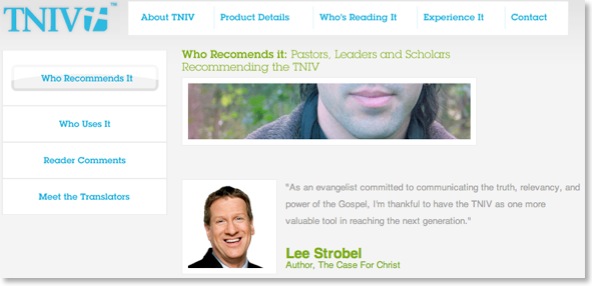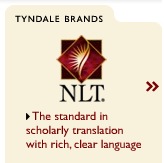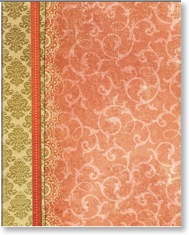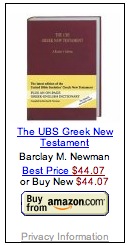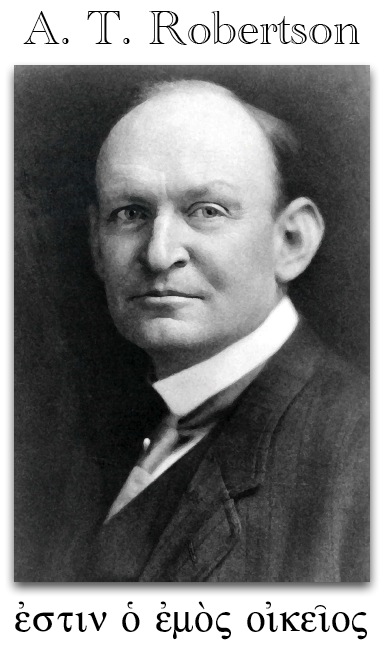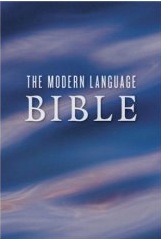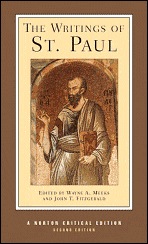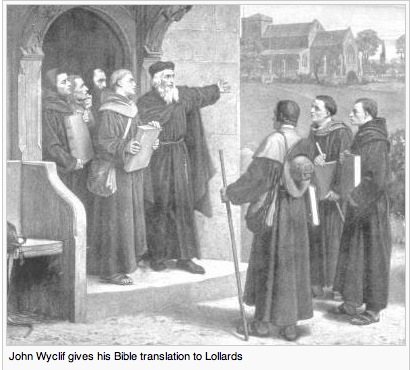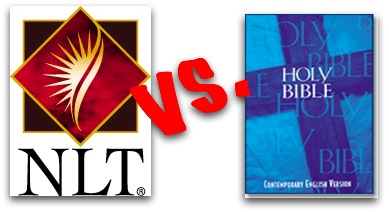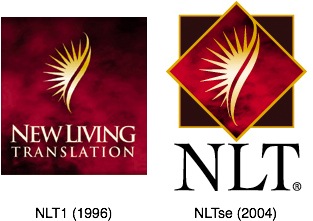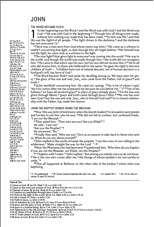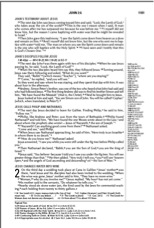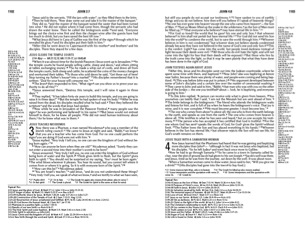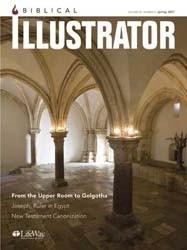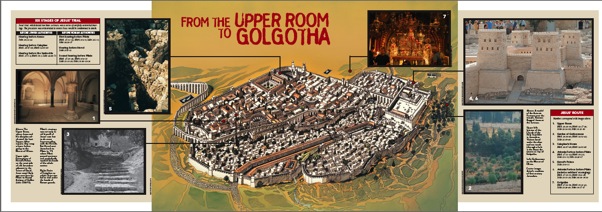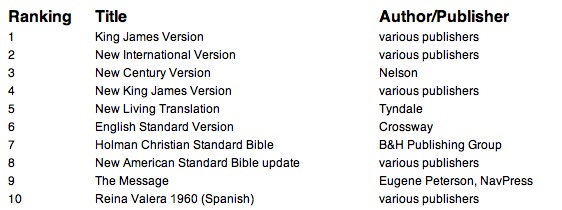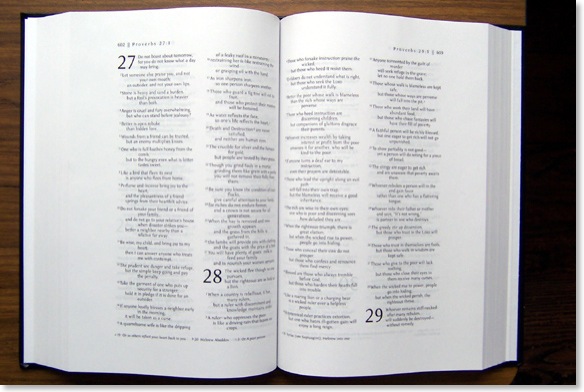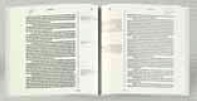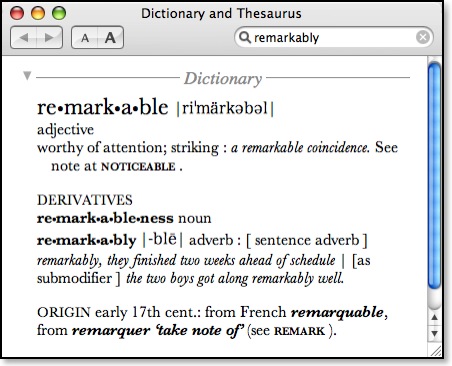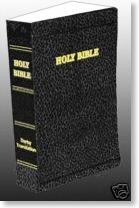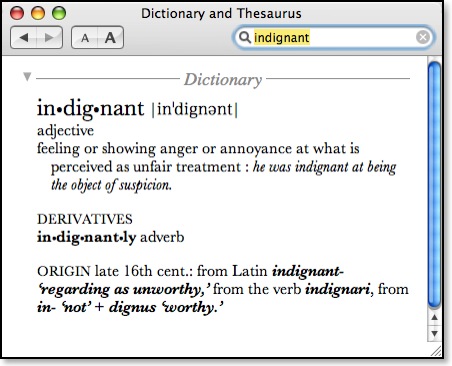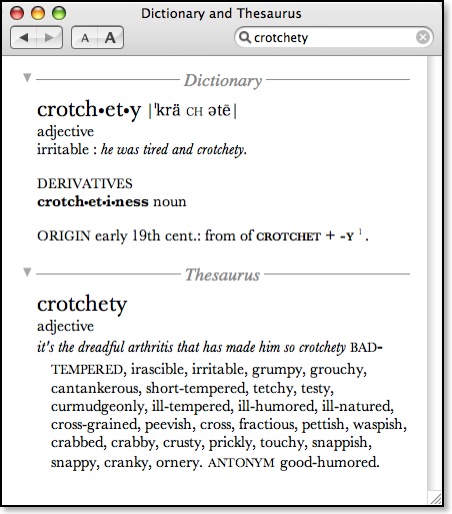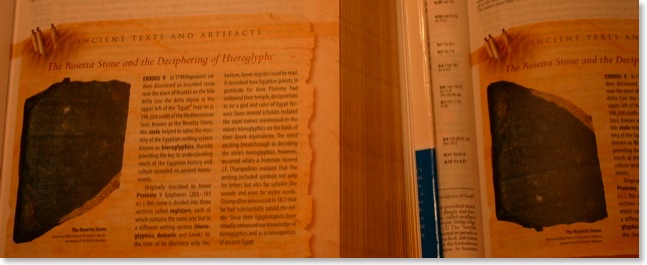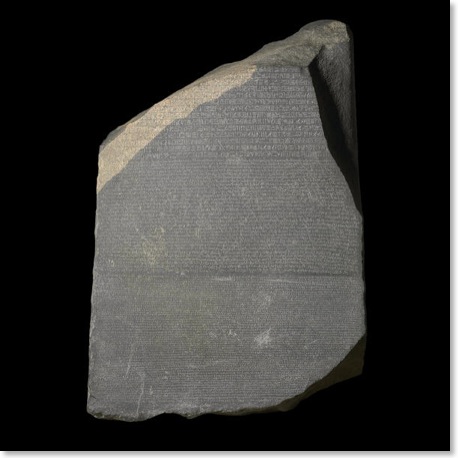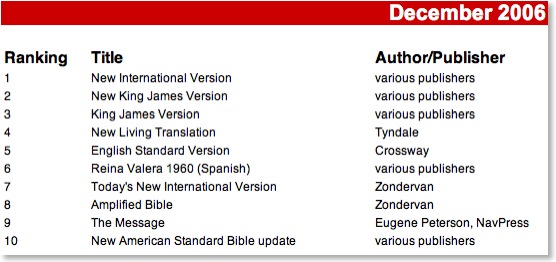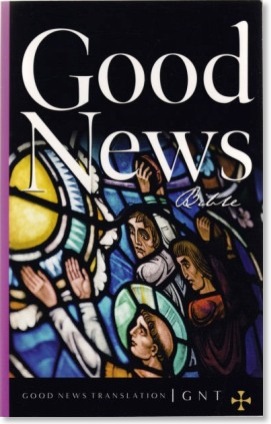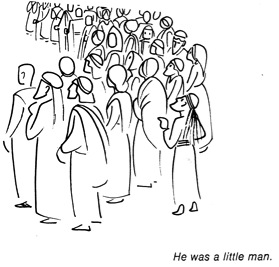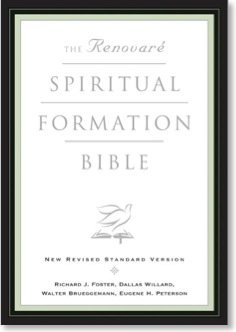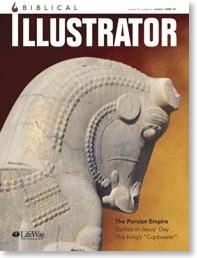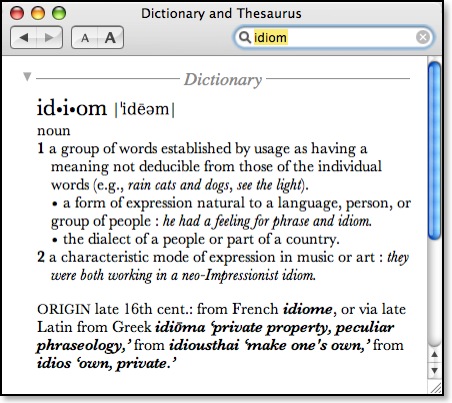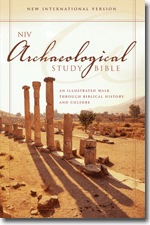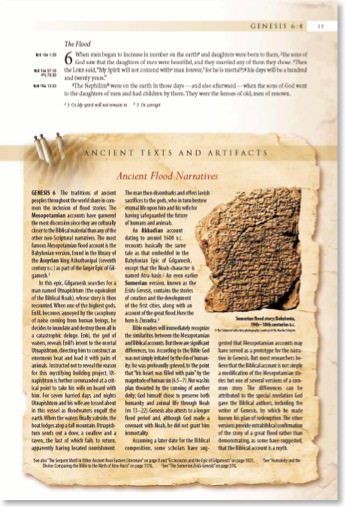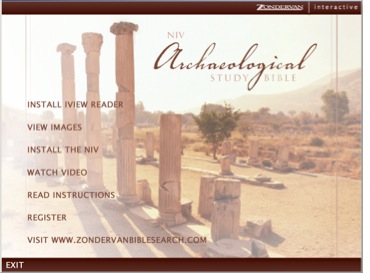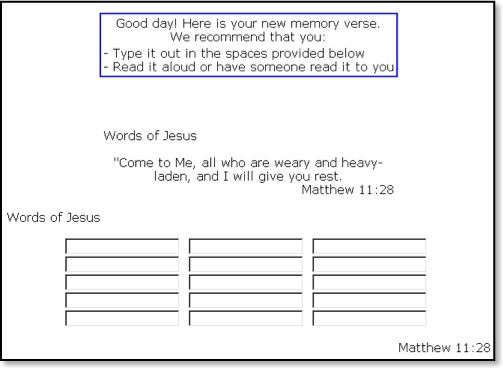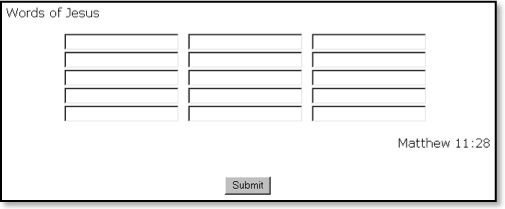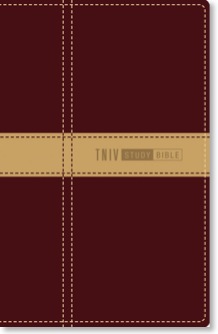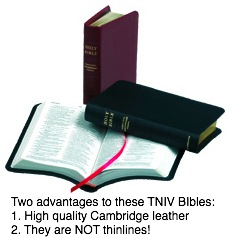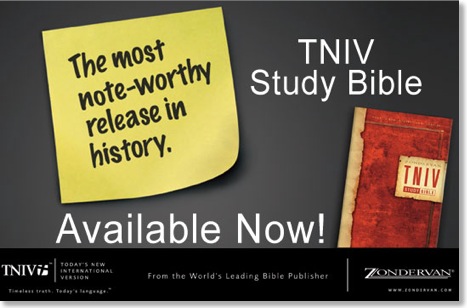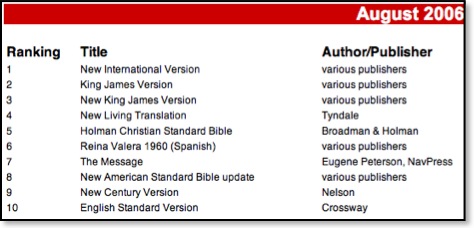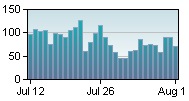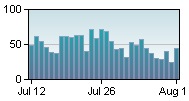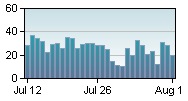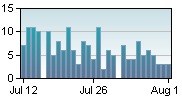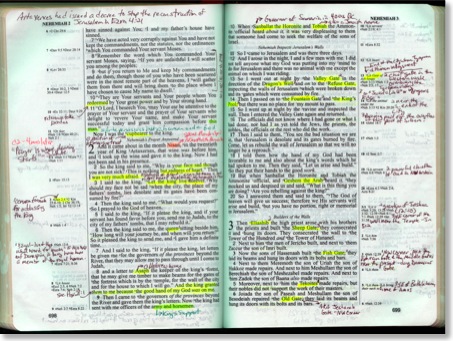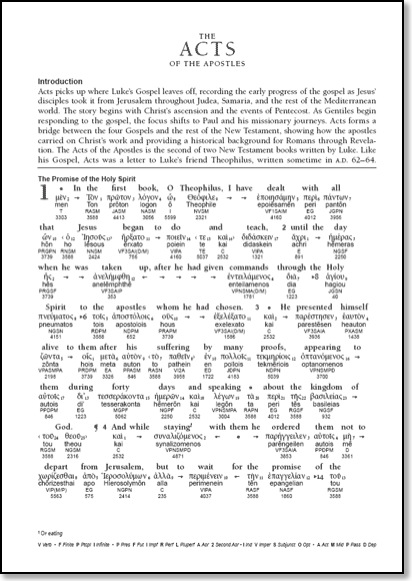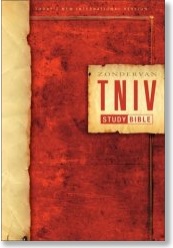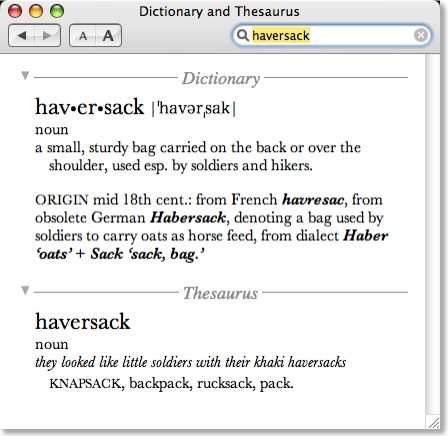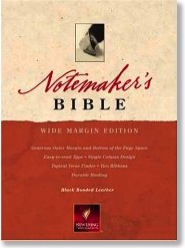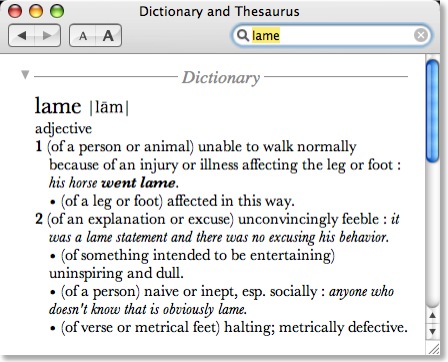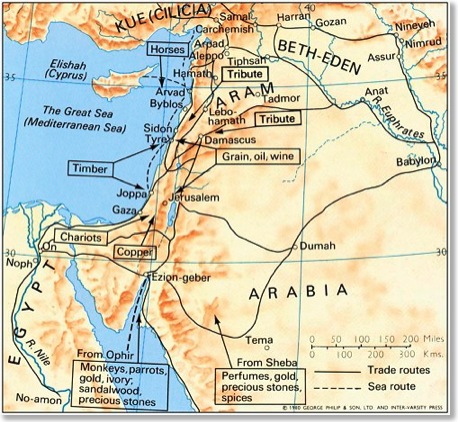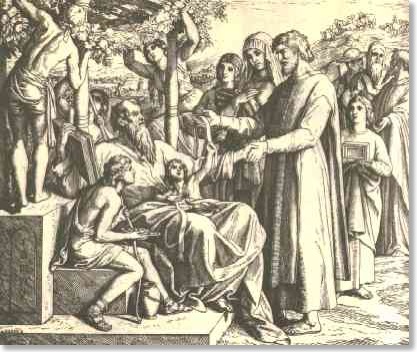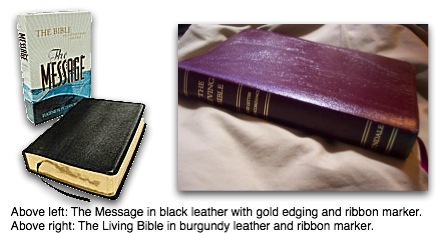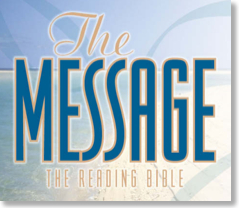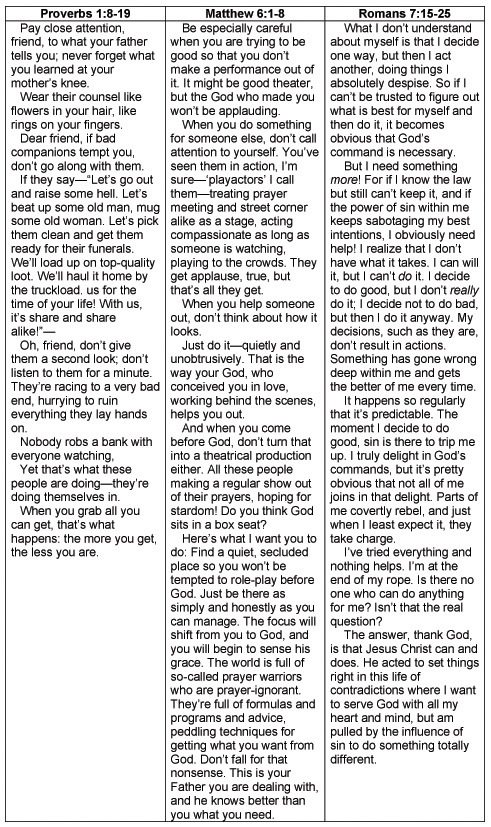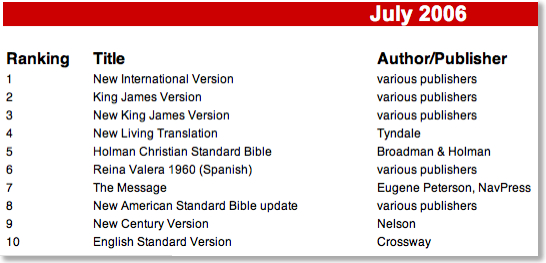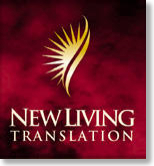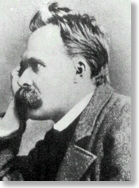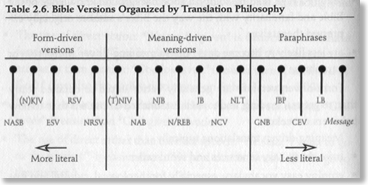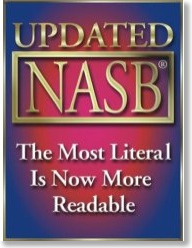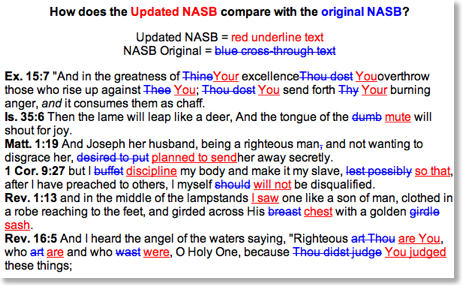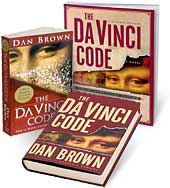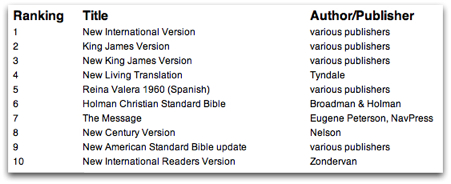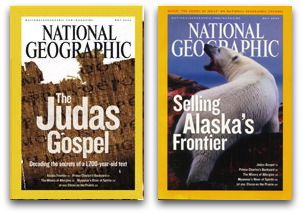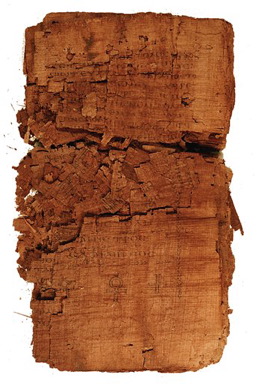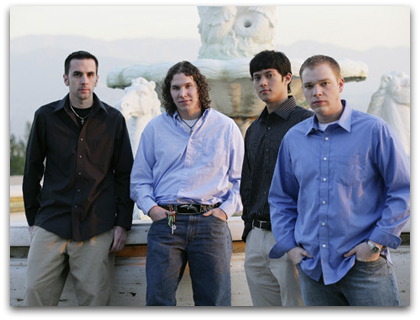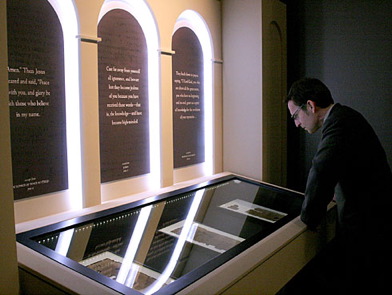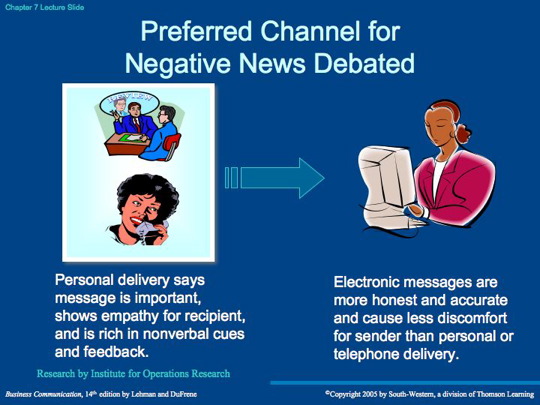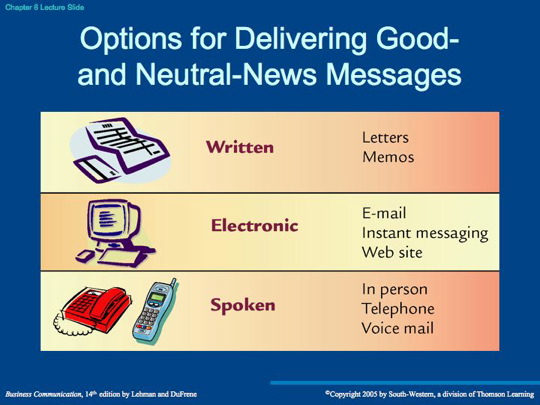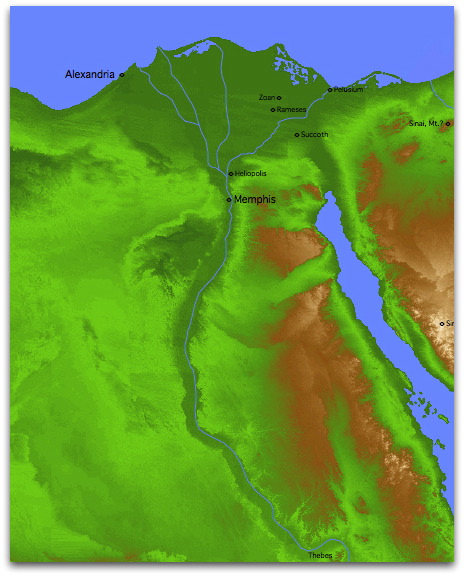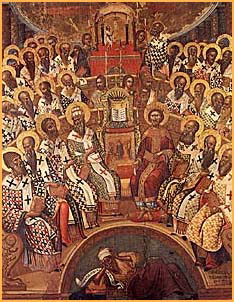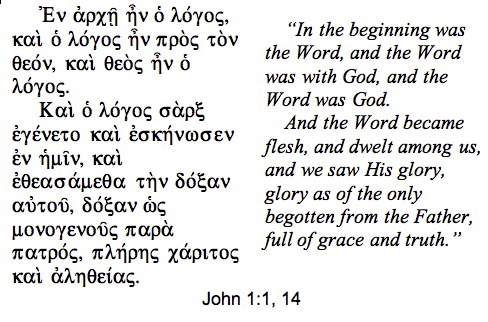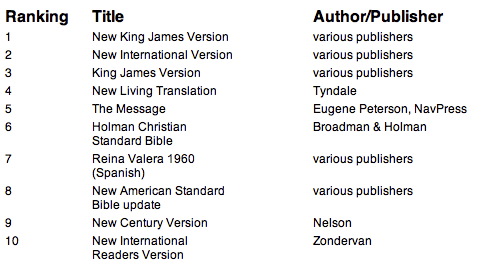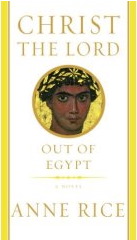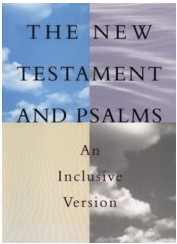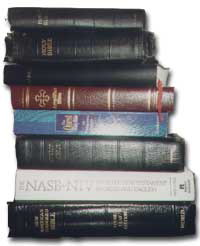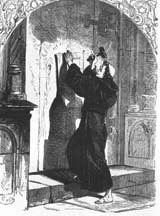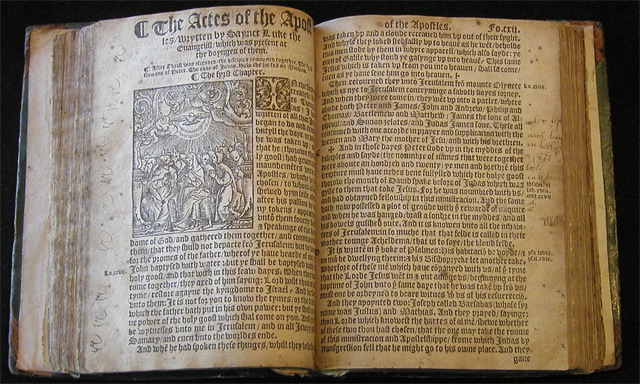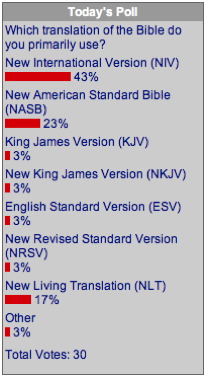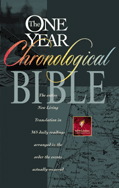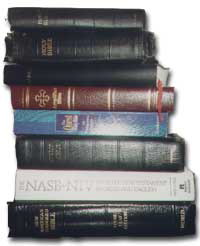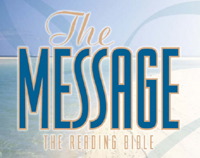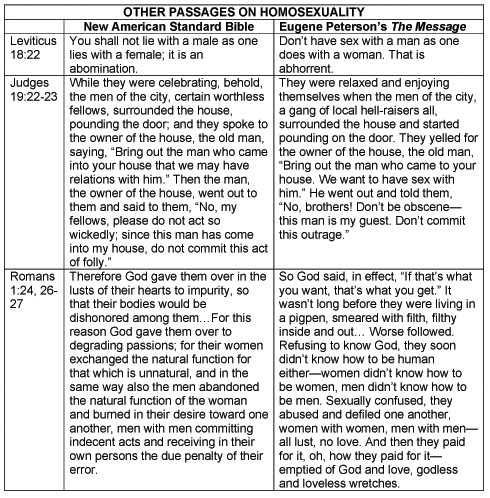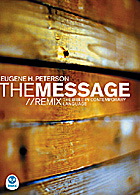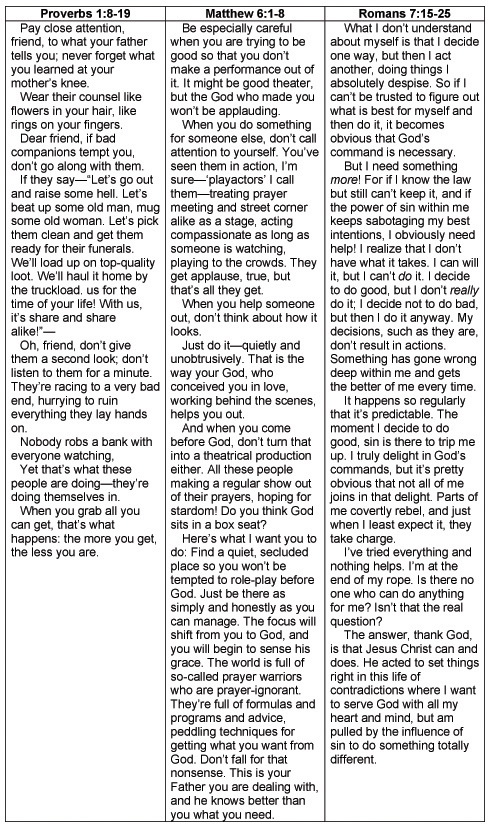Review: The NET Bible
This review has been relocated here:
http://thislamp.com/?p=98
Please continue any further discussion at the new location.
Review: Holy Bible: Mosaic (NLT)
This review has been relocated here:
http://thislamp.com/?p=182
Please continue any further discussion at the new location.
HCSB Minister's Bible to Receive Updated Text in Early 2010
This post has been relocated here:
http://thislamp.com/?p=1315
Please continue any discussion at the new location.
Review: Cambridge NLT Pitt Minion Reference Edition Bible
http://thislamp.com/?p=1435
Please continue any discussion and redirect any known links to the above URL.
"Revised" HCSB Printed Texts Slated for 2010
http://thislamp.com/?p=1548
Please continue any discussion and redirect any known links to the above URL.
Thoughts & Predictions on the 2011 NIV (and a Requiem for the TNIV)
http://thislamp.com/?p=1638
Please continue any discussion and redirect any known links to the above URL.
This Just In: the NIV to be Updated as "NIV 2011"; TNIV to be Discontinued
http://thislamp.com/?p=1645
Please continue any discussion and redirect any known links to the above URL.
Libronix/Mac vs. Accordance, Part 2: Printing
http://thislamp.com/?p=1656
Please continue any discussion and redirect any known links to the above URL.
Libronix/Mac vs. Accordance, Part 1.1: Speed Search Revisited
http://thislamp.com/?p=1661
Please continue any discussion and redirect any known links to the above URL.
Libronix/Mac vs. Accordance, Part 1: "Speed" Search
http://thislamp.com/?p=1667
Please continue any discussion and redirect any known links to the above URL.
MOSAIC--Finally, a Wide[r]-Margin NLTse! (Well...kinda)
http://thislamp.com/?p=1780
Please continue any discussion and redirect any known links to the above URL.
Biblical Illustrator Plus: Summer 2009
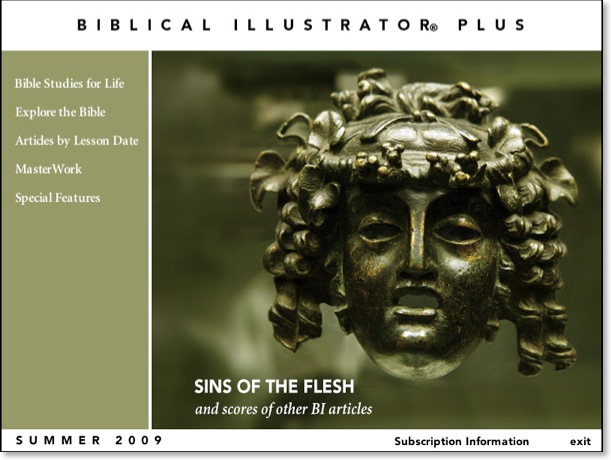
Sunday, I received my new copy of Biblical Illustrator Plus CDROM. I’ve been using Biblical Illustrator for years to help me prepare for the Bible studies I teach on Sunday morning. BI contains background articles that go along with the two main Sunday School curricula used in most Southern Baptist churches. BI is completely separate from the regular teacher’s material, but honestly I value it more. Every quarterly issue contains around 25 articles that offer background information for the biblical texts covered in our studies. The information is usually more detailed than what is offered in the average commentary, but short enough to be digested in one sitting. A working knowledge of biblical languages is not required.
G. B. Howell Jr. is editor of BI. In this newest issue, he is interviewed regarding the role he has played over the past six years. In that interview, he offers a very good description of what BI has to offer:
We continue to offer articles on biblical archaeology, geography, history, people, Greek and Hebrew word studies, and some theology. Every issue has a book review that introduces a new resource to our readers. And we offer a CenterSpread that is art intensive but has an economy of words. ... We have begun offering, though, sidebar boxes with self-contained information (see “St. Catherine’s Monastery,” p. 9). We added a twopage article that addresses some aspect of biblical archaeology, either a find or a site of significance.
The cover of the Summer 2009 issue features a bronze mask of a maenad or female follower of the wine-god Bacchus (Roman, 1st cent. A.D.). In addition to the curricula-related articles, this issue offers a review of Paul Barnett’s book, Paul: Missionary of Jesus. The archaeological article by Joe Cathey focuses on the City of David. The center spread covers the geography of ancient Galatia.
I teach the Explore the Bible curriculum which covers Galatians and James for the months of June - August. Many of the articles that you will see in the table below relate to these books of the Bible. Other articles offer background information for the Bible Studies for Life and MasterWork curricula. Below are the new articles in the current issue of BI:
| Jerry Batson | Anointing in the Early Church | James 5 |
| Joseph Beckler | Abide in John's First Epistle | 1 John 2:3-17 |
| Martha S. Bergen | Jewish Feasts & Festivals | John 7:10-39 |
| Rick Byargeon | Sinai: The Mountain of God | Ex 33:12 - 34:9 |
| Joseph R. Cathey | ARTIfacts: The City of David | |
| Bennie R. Crockett Jr. | Three Social Divisions in the First Century | Gal 3:26-29 |
| Terry Ellis | Sins of the Flesh | Gal 5:16-26 |
| R. D. Fowler | Mirrors | James 1:19-27 |
| John L. Harris | The Book of Jonah in Its Historical Setting | Jonah |
| G. B. Howell Jr. | Paul: Missionary of Jesus by Paul Barnett [book review] | |
| Francis X. Kimmitt | Ancient Culture and Law | Ex 33:12 - 34:9 |
| John Mason | Literacy in the First Century | Galatians, James, 1 Peter, 1 John |
| Allan Moseley | The Tabernacle: Its History and Use | Ex 35:4 - 36:7 |
| Mark Rathel | "Light" in John's Writings | 1 John 1:1 - 2:2 |
| Charles A. Ray Jr. | Genuine Humility | James 4:1-17 |
| C. Mack Roark | James' Ethical Imperatives | James |
| Don H. Stewart | Galatia: Its History | Galatians |
| L. Thomas Strong III | The Social Elite in the First Century | James 2:1-13 |
| J. Mark Terry | Gideon: His Life and Times | Judges 6:11-40 |
| Timothy Trammell | Traveling Through Galatia [center spread] | Galatians |
| Robert A. Weathers | Colossae in the First Century | Col 1:1-29 |
| C. Alan Woodward | The Churches of Galatia | Gal 1 |
The articles above are in both the print issue of BI and the BI Plus CD-ROM. However, the articles below are from previous issues and can be found only on the CD-ROM edition, Biblical Illustrator Plus.
| Scott Andrew | Faith | James 1:3; 2:14; 2 Peter 1:5 |
| Stephen J. Andrews | Sackcloth and Fasting in Jonah | Jonah |
| Stephen J. Andrews | Hazor: A Great City | Josh 10:1 - 12:24 |
| Waylon Bailey | Aaron's Golden Calf | Ex 32:15-19, 30-34; 34:4-6 |
| Bryan E. Beyer | God's Message for Ninevah | Jonah 2:10 - 3:10 |
| James A. Brooks | Gnosticism | 1 John 4:1-3 |
| James A. Brooks | Redemption | 1 Pet 1:18; Eph 1:7 |
| Trent C. Butler | Near Eastern Creation Stories | Genesis |
| James Carter | Old Testament Backgrounds of the Book of James | James |
| Robert O. Coleman | The Fountain | James 3:11 |
| Robert O. Coleman | The Sirocco and the Flower | James 1:11 |
| Bob Dean | The Counselor | John 14-16 |
| David S. Dockery | The Meaning of Deposit | 2 Cor 1:21-22; 5:1-5; Eph 1:11-14 |
| David S. Dockery | To Betray Another | Matt 26:26-56 |
| Charles W. Draper | Law and Faith | Galatians |
| Mark R. Dunn | Counselor: The Meaning | John 14:15-31; 15:26-27; 16:5-15 |
| Mark R. Dunn | Who Were the Samaritans? | John 4:4-26 |
| J. Scott Duvall | Grace | Rom 5:6-17 |
| Kendell H. Easley | The Prison Epistles | Philemon; Colossians |
| Terry W. Eddinger | Ninevah: Assyria's Last Capital | Jonah 4:1-11 |
| Gary Lee Gramling | Paul's Ethical Absolutes | Colossians |
| Sharon H. Gritz | The Betrayer: Judas Iscariot | Matt 26-28 |
| Fred Howard | Prayer: A Word Study | Psalm 28:6-7; Col 4:2-4; 1 Thess 5:16-18; 1 Peter 5:6-7 |
| Paul N. Jackson | A Christian Ethic of Business | James 4:1-17 |
| Robert Earl Jones | Abide: The Meaning | 1 John 2:3-17 |
| Scott Langston | Midian in the Time of the Judges | Judges 4:1 - 9:57 |
| Bill Latta | Gold Rings and Fine Clothing | James 2:2-3 |
| Michael Martin | Fallen from Grace | Gal 5:4 |
| John Mason | Horses: Their First Century Use | James 3:1-5 |
| M. Pierce Matheney Jr. | The Historical Setting for the Book of Jeremiah | Jer 1:4-10; 4:1-4; 6:16-17 |
| David M. May | The Spirit of Restoration | Gal 6:1-10, 14-18 |
| Glenn McCoy | Christ's Second Coming | Heb 9:28; James 5:7 |
| Glenn McCoy | The Royal Law | James 2:1-13 |
| Larry McGraw | Freedom and the Christian | Matt 18:15-17; Gal 5:13-15; 6:1-5 |
| Larry McGraw | The Life Situation of James | James |
| Larry McKinney | The Background of Schoolmaster | Gal 3:1-5, 23 - 4:7 |
| Harold L. McManus | First Century Wars and Their Causes | James 4:1 |
| Warren McWilliams | The Galatian People | Galatians |
| Janice Meier | Gideon: All We Know | Judges 6-8 |
| John Polhill | John's Use of "Witness" | 1 John 5:1-12 |
| John Polhill | The Meaning of "Justified" | Gal 2:11-21 |
| John Polhill | No Respecter of Persons: God's View of Race Relations | Acts 10:34-35 |
| Wayne W. Poplin | Gideon: A Mighty Warrior | Judges 6:11 |
| Gregory T. Pouncey | Libertinism & Legalism | Gal 5:16-26 |
| Michael Priest | Titus and Paul | Titus |
| M. Dean Register | God's Wisdom/Man's Wisdom | 1 Cor 2:1-16 |
| Charles A. Ray Jr. | Antichrist in John's Letters | 1-3 John |
| Charles A. Ray Jr. | Christ and the Kosmos | Phil 2:19-24; James 3:13-16; 1 John 2:15-17 |
| Charles A. Ray Jr. | The Law of Freedom | James 1:22-27; 2:14-18 |
| E. Randy Richards | Stop Lying | Col 3:8-9; James 3:3-12; 1 Pet 3:8-10 |
| C. Mack Roark | Introducing 1 John | 1 John 1:5-10; 2:3-11 |
| Paul E. Robertson | The Churches of Galatia | Galatians |
| David M. Russell | The Colossian Heresies | Col 1:9-23 |
| Billy Simmons | A Religious History of Galatia | Galatians |
| Bob Simmons | The Curse | Gal 3:15 - 4:7 |
| Billy K. Smith | The Meaning of "God's Spirit Moved" | Gen 1:1-5, 31 - 2:1, 15-17 |
| Harold S. Songer | Anointing with Oil: What Does It Mean? | James 5:14 |
| Gerald L. Stevens | "Blaspheme": A Word Study | James 2:1-13 |
| Robert A. Street Jr. | Micah: His Life and Times | |
| Leslie "Thomas" Strong III | Family Life in Ancient Corinth | 1 Cor 7:1-5; 8-16 |
| Roger R. Sullivan | Corinth's Religious Atmosphere | 1 Cor 8:12-13 |
| J. Mark Terry | Jonah's Vine | Jonah 4:1-11 |
| William B. Tolar | A Different Gospel | Gal 1:1-12 |
| William B. Tolar | Paul's Fruit List | Gal 6:16-26 |
| Timothy Trammell | Faith Affirmed | 1 John 5:1-12 |
| Timothy Trammell | The Purpose and Life Situation of John's Letters | 1-3 John |
| Robert A. Weathers | Sexual Purity in the New Testament | Job 31:1-4; Psalm 10:3-4; 2 Cor 10:4-5; 1 Thess 3-5, 7 |
| Elgia "Jay" Wells | Lessons for Race Relations | Acts 10:1-48; 8:26-40 |
| Terry L. Wilder | The Role of a Steward | 1 Peter 4:7-19 |
| Jerry M. Windsor | Grace | Ephesians |
| C. Alan Woodward | Heresies in the Colossian Church | Colossians |
| G. Al Wright Jr. | Testing | James 1:2-4, 9-15, 26-27 |
Now, when I’ve written about BI before, I’ve suggested that it has value even for people who don’t teach from SBC curriculum. Why? Well, the articles provided in each issue are invaluable if one is involved in any aspect of preaching or teaching. Every CD in the “Plus” edition contains almost 100 articles. A couple of years ago, I began copying the articles (all in PDF format) from the CD onto my hard drive. I divide them up by books of the Bible as can be seen below:
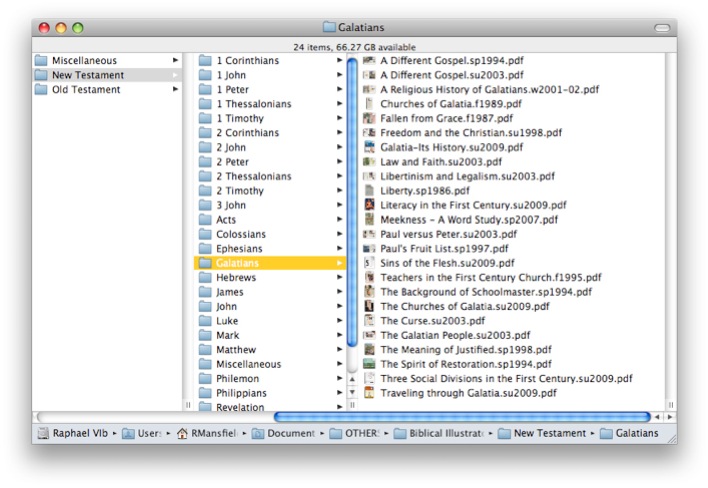
Thus, regardless of whether I’m working on a Sunday School lesson, sermon, college lecture, or some other study of the Bible, I have dozens of background articles at my immediate disposal.
Recently, I’ve started listing articles in my personal notes in Accordance where I do the bulk of my preparation for teaching the Bible. I haven’t completed this project yet, but once I’m finished, I’ll have a running index in biblical order of the articles I have available.
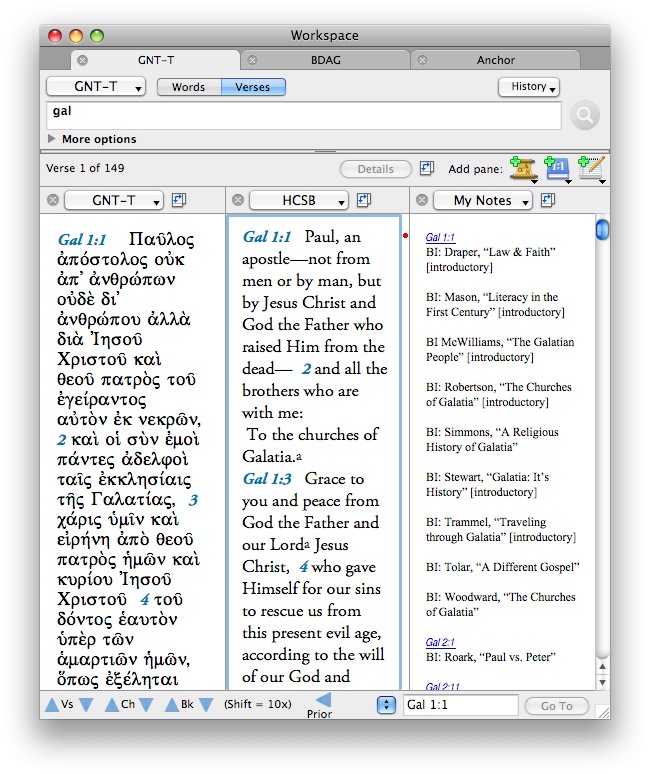
I promise you I receive no commission from Lifeway for promoting BI here on This Lamp! I simply remain very enthusiastic about this resource and highly recommend it to others who are in any kind of teaching or preaching ministry. The print edition is $24.95 a year and the CDROM edition (with all the extra articles from past issues) is $34.95.
Accordance Extends Web Presence

However, I regularly find that some folks--even Mac users--aren’t familiar with Accordance. Therefore, I’m glad to see Oak Tree Software expanding their web presence. Of course they already had a website, a blog and more, but I’m pleased to see them expanding into resources like their new video podcast as well as creating a YouTube presence.
To my knowledge, here is a fairly complete listing of Accordance’s web presence. If I’ve left anything off, let me know and I’ll add it.
Accordance on the Web
- Accordance Main Website: the main resource for finding out about Accordance and ordering software
- Accordance Blog: updated multiple times a week with tips, help and module profiles
- Accordance Forums: an incredible source for finding help from other users and representatives from Oak Tree software. In fact, Oak Tree has the fastest, personal response to questions I’ve ever seen from any company. Users can also offer their own tips and suggestions as well as request new modules.
- Accordance FaceBook Page: A great way to keep up with what’s new in Accordance as well as interact with other Facebook Accordance users.
- Lighting the Lamp Video Podcast: A brand new weekly video podcast hosted by Dr. Timothy Jenney.
- Accordance YouTube Channel: Features many of the videos available on the main website, but may be easier to embed on personal websites and blogs.
- Accordance Twitter Account: keep up with all things new and interesting about Accordance via Twitter.
- Accordance Exchange: At no extra cost, every level of Accordance comes with the ability to create your own user tools, user Bibles, user notes and distribute them to others. The Accordance Exchange is a great resource for accessing these files created by other Accordance users.
- Banners for User Websites: Accordance users can help to promote Accordance on their own websites and blogs. You’ll see one of these in the left sidebar that I’ve had on This Lamp for a while.
- Video Demos and Instructional Tutorials: Note two separate links at this bullet. The video demos show off the most recent version of Accordance. The instructional videos contain the entire training DVD, now available for free online.
YANIVB
“Of making many NIV Bibles there seems to be no end, and a lack of TNIV Bibles wearies my soul.”
(With apologies to Qoheleth and Ecclesiastes 12:12)
I took an online survey from Zondervan tonight for a YANIVB. What’s a YANIVB? Well, YANIVB stands for “Yet Another NIV Bible.” While the TNIV seems to be losing ground everyday, it seems that there’s no end in sight for new NIV Bibles.
The Bible in question here? Well, it’s based upon the work of Lee Strobel and called The Case for Faith Study Bible. It’s so early in development stage that if you run a Google search on this Bible right now--even if you put quotation marks around it--you won’t get any hits. At least if you run your search within a close timeframe for my writing this post.
The main thrust of the survey was to select which cover I liked best:

Incidentally, I liked the top right cover best and the bottom left cover second best.
Of course, as you would guess, I’ve got a HUGE problem with this Bible. No, it’s not the theme. For what it’s worth, I think Lee Strobel is a great guy, and I’ve given away some of his books. My problem with this Bible is that it’s a NEW Bible released with the NIV as its text rather than the TNIV.
I really don’t understand this. The NIV continues to cannibalize sales of the TNIV and lessen the latter’s chance of acceptance. It is clearly shortsighted for Zondervan to keep the NIV as its flagship translation to the neglect of the TNIV, to continue to promote NEW products based around the NIV while new TNIV projects are few and far between. One day the NIV will slip from its spot as bestselling translation, but it won’t be the TNIV to take its place because the TNIV will have died from neglect by that time.
But do you want to know what makes creating Lee Strobel’s Bible around the NIV most egregious?
Well, if you go over to TNIV.com, click on the “Who’s Reading It” tab, and then click on the “Who Recommends It” tab, guess who appears FIRST!
Thats right! There’s Lee Strobel, front and center, stating “I’m thankful to have the TNIV as one more valuable tool in reaching the next generation.”
Well, too bad, Mr. Strobel, we’re going to make you use the Bible of the last generation: the NIV!
I’ve said over and over that Zondervan needs to put strong testimonial power behind the TNIV for people to consider it. Lee Strobel and The Case for Faith Study Bible would be a perfect match for the TNIV. And yet, before it ever even sees print, it becomes another wasted opportunity for Zondervan to move its resources behind the TNIV. YANIVB is what it becomes. When will the tide turn?
Of course, for all of Lee Strobel’s wish for the TNIV to become a valuable tool in reaching the next generation, and for all of Zondervan’s original marketing of the TNIV as a Bible for the 18 to 34 crowd, can anyone tell me why The Student Bible has been revised since the release of the TNIV, and yet still remains an NIV Bible?
Here’s a new slogan: “TNIV: The Best Bible No One Ever Read.”
HT: Jay Davis
![]()
Craig Blomberg Clarifies His Position on the NLT

I relished the chance to work on the NLT (New Living Translation) team to convert the LBP into a truly dynamic-equivalent translation, but I never recommend it to anyone except to supplement the reading of a more literal translation to generate freshness and new insights, unless they are kids or very poor adult readers. My sixteen- and twelve-year old daughters have been weaned on the NLT and have loved it, but both already on their own are now frequently turning to the NIV.
The original source for this statement is actually a review by Blomberg of Leland Ryken’s book, The Word of God in English: Criteria for Excellence in Bible Translation. The review can be found in the July, 2003, issue of the Denver Journal.
The statement quoted above is used by Michael Marlowe in his fairly critical review of the NLT. In fact, Marlowe gives the context for Blomberg’s quote as “responding to criticism of the NLT.” In Marlowe’s review of the NLT, he makes this statement before supplying the quote by Blomberg above:
Finally, we note that Craig L. Blomberg of Denver Seminary, who was the principal translator for the NLT's Gospel according to Matthew, has explicitly stated that this version is not suitable as a regular Bible for adults. Responding to criticism of the NLT, Blomberg explained that the version is for "kids or very poor adult readers," and he suggested that readers of the NLT should move on to a more accurate version when they are able:
But the context that Marlowe gives is completely wrong. Blomberg isn’t responding to criticism of the NLT at all; rather, he’s writing a review of Ryken’s book! And did Blomberg explicitly say that the NLT “is not suitable as a regular Bible for adults”? Well, not precisely. At the very least Marlowe seems to be overreaching a bit, and seems to be looking for support for the fact that he does not like the NLT. Incidentally, both Marlowe’s statement and Blomberg’s quote are repeated verbatim at the Theopedia’s article on the New Living Translation.
Considering that Blomberg’s review dated back to 2003, I was curious to know if he still held the same feelings about the NLT. Does he really only recommend it to kids or adults who are very poor readers? His statement was made a year before the NLT second edition was released, which I believe fixed a lot of problems in the first edition as well as creating a translation which is sometimes more literal and even more traditional in places than the first edition.
Dr. Blomberg and I have now exchanged a handful of emails on this subject and he has given me permission to share the content of those emails on the internet.
In general, Dr. Blomberg told me that does not recommend the NLT as a primary Bible for adults, but he does recommend it as a supplement to reading other Bibles. However, in another email he offered three contexts for choosing the NLT. I have broken up his statement and added numbers to delineate his three options more clearly:
- I very much approve of it for people who want a second (third, fourth, or whatever) take on the text,
- or who want to hear it in a fresh way,
- or who simply for whatever reason want a dynamically equivalent rather than a formally equivalent (or hybrid) translation.
Dr. Blomberg said that the evaluation immediately above is one he held to
I will send Dr. Blomberg a link to this post. If you would like to leave your thoughts in the comments, perhaps he may take the opportunity to respond if he has time.
Also, I highly recommend for your reading Dr. Blomberg’s post last year on the Koinonia Blog: “Demystifying Bible Translation and Where Our Culture Is with Inclusive Language.”
*This paragraph was added after the initial posting of this blog entry.
Loose Loins Sink Kings (Isaiah 45:1)
I’ve read through the book of Isaiah quite a few times, but I’ve discovered over the years that when I prepare to teach a passage, I always find new elements of the text I hadn’t seen before. One of these insights came from a phrase I came across in Isaiah 45:1, which is part of Isaiah’s prophecy to Cyrus.
In the Hebrew, the phrase is simply וּמָתְנֵי מְלָכִים אֲפַתֵּחַ which translates somewhat literally as “and loins of kings I will loosen/open.”
The context revolves around Cyrus of Persia, the king who would allow the Israelites to return to their homeland and rebuild Jerusalem and the Temple as chronicled in 2 Chronicles 36 and Ezra. Cyrus is an interesting individual. He was a pagan king, comparable to Nebuchadnezzar who, in spite of his foreign religion, was called God’s servant (Jer 25:9; 27:6; 43:10). Like Nebuchadnezzar, God chose to work through this non-Israelite as part of his divine purposes, demonstrating his sovereignty even upon those who do not acknowledge him.
There are allusions to David in God’s depiction of Cyrus. He calls him “my shepherd” (רֹעִי) in Isa 44:28 and perhaps more startlingly his “anointed one” (מָשִׁיחַ, /māšiyaḥ). Thus Cyrus is the only individual in the Bible to be called “anointed one” (or messiah) outside of Israelite kings, priests and Jesus Christ. Cyrus had also been raised by a shepherd. Further, there seems to be imagery related to Moses as well as Cyrus becomes the one who leads (by decree) God’s people out of their captivity to the Promised Land.
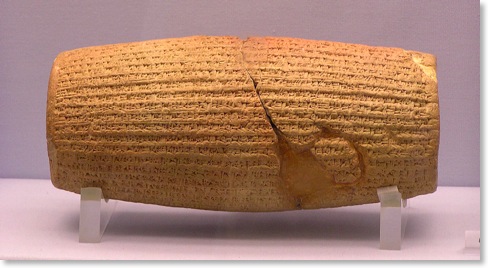
Above: The Cyrus Cylinder which includes detail of the king’s granting expatiates permission to return to their homelands.
Source: Bible Lands Photo Guide, version 3 (Accordance)
I try very hard when I’m preparing a lesson to attempt interpretation by myself first before consulting commentaries. I had to admit (although it seems somewhat obvious now) that I was stumped by this reference to God loosening the loins of Cyrus’ rival kings. I’ve begun teaching from the New Living Translation on Sundays, and I consulted Isa 45:1 in the NLT:
This is what the LORD says to Cyrus, his anointed one,
whose right hand he will empower.
Before him, mighty kings will be paralyzed with fear.
Their fortress gates will be opened,
never to shut again.
Most formal translations simply translate the phrase literally, “loose the loins of kings” or something similar. The NLT certainly gets the end result across. I understood that. None of the kings who went before Cyrus would be able to stand before him. But what did the phrase actually mean? I wondered if it meant that foreign kings would be impotent before Cyrus, or perhaps it meant they would wet themselves. The problem, as I would later discover, was that my focus was too literally loin-centered.
Incidentally, when I taught the lesson Sunday and was relaying Cyrus’ rather colorful history, one person in the class asked whether Cyrus came “before or after ‘that guy’ in 300.” I told him that Cyrus came before Xerxes who was featured (rather outlandishly) in the movie 300. But I pointed out that the incredibly large army depicted in that movie had not been built by Xerxes (for the most part), but rather by Cyrus much earlier before him.
Using Accordance, I tried running searches for the exact phrase and then similar phrases, but to my knowledge (feel free to correct me if I’m wrong), there are no other occurrences of loins being loosened, only tightened up, or more appropriately girded up. And then suddenly it made sense! My problem was that I had not been thinking in terms of Hebrew and ANE culture.
At this point, thinking I’d figured it out, I went ahead and consulted a number of commentaries that confirmed my hunch. In the Bible, to “gird up one’s loins” (see Exod 12:11; 1 Kgs 18:46; 20:32; 2 Kgs 1:8; 4:29; 9:1; Job 12:18; 38:3; 40:7; Jer 1:17, esp. in more formal translations) was to tuck the ends of one’s garments into one’s belt so as to be ready for any kind of action, whether fight or flight. What was being described in Isa 45:1 was just the opposite.
Thus, before Cyrus, God would immobilize any king or king’s army who would oppose him. Their readiness for battle would come to nothing. The TNIV renders the phrase “strip kings of their armor” which nicely captures the military aspects just as the NLT’s rendering above relates the psychological end result. The ESV translates the phrase as “to loose the belts of kings,” but that sounds a bit too much like the aftereffects of a Thanksgiving meal.
Regardless, it’s clear in the passage that the God of the Bible is sovereign, choosing to use whom he will when he will, often despite the objections of those who feel themselves to be part of the “in group” (Isa 45:9-13). To those who first objected, God had this message:
“I will raise up Cyrus to fulfill my righteous purpose,
and I will guide his actions.
He will restore my city and free my captive people—
without seeking a reward!
I, the LORD of Heaven’s Armies, have spoken!”” (Isa 45:13, NLT)
And as history records, that’s exactly what happened.
The NLT and the Language of Atonement
Todd Benkert is a pastor in Indiana and a friend of mine I’ve known for quite a while. Over the years, we’ve had a number of discussions including ones about what what translations are beneficial for teaching and preaching. As I’ve been contemplating making the NLT my primary public use Bible in the church (I’ve already been using it with college classes that I teach), Todd has been thinking about using the NLT from the pulpit. Currently, he uses the ESV, but he recognizes its deficiencies.
In a recent post on Todd’s website Be My Witnesses, we got into a discussion about whether or not the NLT would work in certain public settings. In the comments, Todd wrote the following:
My main qualm, which I can't decide if its a strength or weakness of the NLT, is that is removes justification terminology from the text (see, e.g., Rom 3). On the one hand, it is helpful because the concept is now accessible to the reader. On the other hand, the systematic theologian in me want to retain the word and then explain it. If I can get over that, then I'm all in with the NLT.
Todd gave me permission to reproduce my reply here which I’ve cleaned up a little bit and reproduced below:
Let's take for instance Romans 3:25, which in the ESV reads:
whom God put forward as a propitiation by his blood, to be received by faith. This was to show God’s righteousness, because in his divine forbearance he had passed over former sins.
Now, I chose the above verse because it is from Rom 3, which you referred to as a chapter in the NLT which "removes justification terminology from the text." I also made bold propitiation because it is certainly a prime example of "justification terminology."
Propitiation is one of those heavily loaded theological words which carries a lot of meaning in a very small label. Now, as you know fully well, the underlying Greek word is ἱλαστήριον. When a word like propitiation is used in a verse like this, really it acts more as a placeholder for the larger context. In other words, the average person in the pew--in your pew--is probably not going to walk around with a fully developed theology of propitiation in his or her head. Some will, but realistically, most won't.
What this means is that regardless of what word is used here, whether it is propitiation orhg the phrase "sacrifice of atonement" (NIV, NRSV), it will still require some amount of explanation by you. Incidentally, the word atonement was coined by Tyndale for use in his OT translation because he couldn't find a suitable English word for כָּפַר.
The question remains whether it is better to have that theologically loaded word (really just a label, a placeholder) propitiation in the text or is something else just as suitable or even better?
I've seen people evaluate translations of the Bible (and I think I used to do it myself) based on whether the word propitiation was used or not in the New Testament, specifically in Rom 3:25; Heb 2:17; 1 John 2:2; and 4:10 (although technically, the last two references use ἱλασμός in the Greek).
What's interesting is that although the word propitiation was used in the King James Version, it was not used in William Tyndale's translation upon which the KJV was primarily based.
The Tyndale NT reads this way (with emphasis added) in Rom 3:25
whom God hath made a seate of mercy thorow faith in his bloud to shewe ye rightewesnes which before him is of valoure in yt he forgeveth ye synnes yt are passed which God dyd suffre
So where did the KJV translators get the word propitiation from? Why, straight out of the Latin Vulgate! Here is Rom 3:25 in Latin:
quem proposuit Deus propitiationem per fidem in sanguine ipsius ad ostensionem iustitiae suae propter remissionem praecedentium delictorum
What is inescapable, regardless of how one looks at it, is the KJV translators, rather than trying to actually translate ἱλαστήριον into an English equivalent, instead "cheated" and just grabbed the Latin word (this, of course, is not much different than what was done by simply transliterating βαπτίζω as baptize, rather than correctly translating it as "immerse," but now the real "Baptist" [pun intended] is coming out in me).
So, what does ἱλαστήριον actually mean (I know you know what it means, but bear with me for sake of discussion)? Or what is it that Jesus actually did for us on the cross (the real question)? I'm not going to try to answer the second question just yet, but I will say that when NT writers, especially in the epistles, try to answer that question, their answer at the most basic level is some kind of common analogy for what took place on a spiritual level. This is true, regardless of whether Paul is speaking of ἱλαστήριον in Rom 3:25 or ἀντίλυτρον ("ransom") in 1 Tim 2:6. In the Reformation, emphasis came back upon ἱλαστήριον as a primary image (which I completely affirm), but in the early church, made up of the poor and in many cases, freed slaves, the idea of ἀντίλυτρον was favored. The reality is we need all of the images the NT provides to try to understand what Jesus did for us on the cross.
But back to my original question in regard to what ἱλαστήριον actually means-- When Paul uses this word, he is borrowing it from two arenas. On one hand, it's a pagan word used to describe the appeasement of a foreign god in their sacrificial ceremonies. The word meant this throughout ancient Greek literature, especially in regard to appeasing the wrath of the pagan God through sacrifice. On the other hand, the word ἱλαστήριον had been "co-opted" a couple of centuries earlier by the writers of the Septuagint to refer to the Old Testament mercy seat--the place above the ark of the covenant where sacrificial blood was sprinkled by the high priest to make atonement (thank you, William Tyndale) for Israel's sins; that is, to restore the people of Israel into fellowship with God.
So what did Jesus do on the cross (if I can take a stab at the second question now)? Well, to follow the lead of the NT writers and also Tyndale, he "mercy seated" us with God.
Now, back to that Latin label/placeholder propitiation... This word sees the ἱλαστήριον as the place of atonement. Jesus was the "place" where God's anger was removed. But as you probably remember, C. H. Dodd in The Bible and the Greeks rejected Jesus as the place of atonement. He saw this as too closely tied to paganism. Furthermore, he was uncomfortable with the idea of a "wrathful" God. He said expiation was a better translation because it was God’s appointed means to deal with our situation. On the Day of Atonement, he makes the effects of sin ineffective. Emphasis is on what God does (expiation), rather than what humans do (propitiation).
And of course, C. H. Dodd influenced translations of the Bible such as the RSV and NEB that opted for the word expiation in a verse like Rom 3:25 rather than propitiation.
But then Leon Morris came along, and in New Testament Studies said that wrath was indeed present in both Old and New Testaments (contrary to Dodd). Further, Morris went on to say that ἱλαστήριον is not an either/or in regard to expiation or propitiation, but a both/and: Morris said God expiates and is propitiated. The opposite of love is not wrath; the two are not incompatible. Anger is an appropriate reaction at times to those you love. The opposite of love is hatred—something into which anger can turn. Morris saw wrath as a positive angry love that does many wonderful things in the world.
In the Day of Atonement, God’s anger loomed large. Sin was taken seriously. Paul’s thought was how the Day of Atonement was understood in his time, not necessarily when it was who first proclaimed in Leviticus.
Since Morris, we have seen the rise of Bible translations that opted not to use either word (propitiation or expiation), but rather simply to translate ἱλαστήριον as "sacrifice of atonement" or something similar, leaving it up to the preacher or teacher to explain further if desired.
So back to the NLT...
The 1996 NLT reading of Rom 3:25 may have simply tried to do too much:
For God sent Jesus to take the punishment for our sins and to satisfy God’s anger against us. We are made right with God when we believe that Jesus shed his blood, sacrificing his life for us. God was being entirely fair and just when he did not punish those who sinned in former times.
There's definitely the standard "propitiatory" language in there. In fact, propitiation is defined pretty clearly in that rendering, over and above what the Greek actually says.
The 2004 revision is less overt:
For God presented Jesus as the sacrifice for sin. People are made right with God when they believe that Jesus sacrificed his life, shedding his blood. This sacrifice shows that God was being fair when he held back and did not punish those who sinned in times past
"Jesus as the sacrifice for sin" is probably closer to that non-specific "sacrifice of atonement" in the NRSV & NIV.
And for point of reference, the translators for Romans in the NLT are Gerald Borchert, Douglas Moo and Thom Schreiner -- a pretty good mix of scholarship and viewpoint.
So, finally, back to your original concern, regardless of how it's worded, I believe there's still PLENTY for you as pastor/teacher to explain. I really wouldn't let lack of formal theological language--especially those which are simply Latin loan words--hold you back.
First Look: Zondervan's NoteWorthy Bible
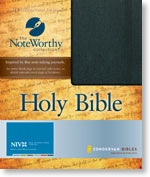
The official Zondervan description reads as follows:
Bible users, take note! With its unique design featuring blank right-hand pages, this Bible offers plenty of room for note taking. An accordion pocket inside provides added storage for loose notes. And an elastic band provides closure so you can keep everything securely in place.
Here are Theophrastus’ comments on the NIV Noteworthy Bible:
(a) Don't use this edition for taking notes. The bleed-through on the paper is so bad I can see down three pages. Since this is not a true interleaved edition (with a double-sided blank page of paper between each double-sided printed page of paper) your ink marks will mar right through the other side.
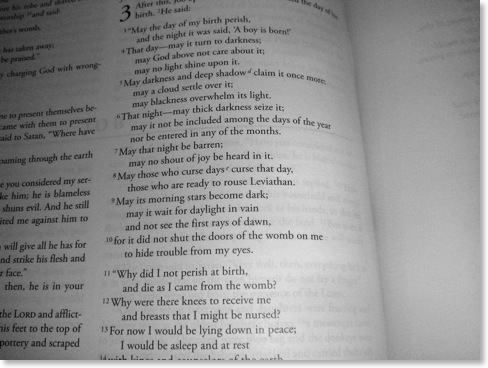

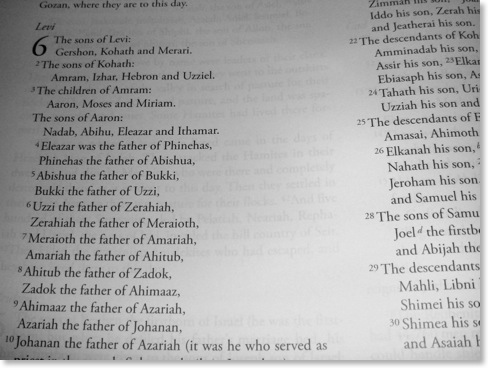
(b) Tiny font. The font size of the Little Oxford Bible is just five point, but the font size of the Noteworthy NIV appears to be slightly smaller than that. Thanks to my near-sightedness, I can read the Little Oxford Bible without magnifying glass, but I can't say the same Noteworthy NIV.

(c) Relatively generous inter-line spacing. Double column. Square size.
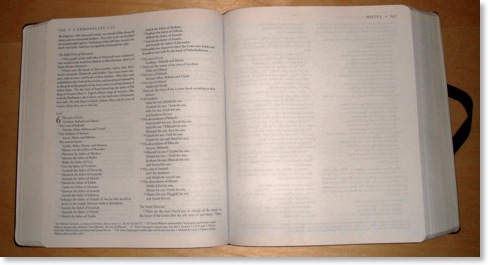
(d) Binding claims to be bonded leather but feels like slightly stiff paperback to me. No one would confuse this with a moleskin notebook.
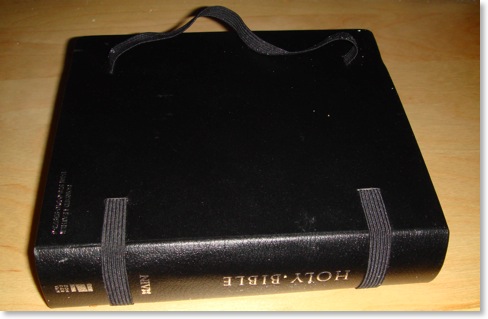
(e) The elastic on the the outside binding makes it look like this binding is designed to fail! It also give the bible a slight fetishistic look -- maybe it is designed for folks who like to wear latex and elastic.
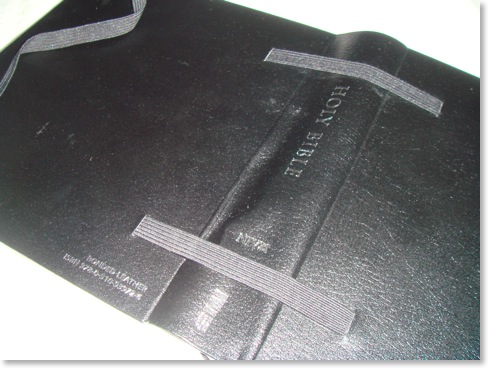

(f) The internal paper pocket on mine is already failing and I haven't put anything in it.

(g) The left top margin has the page number, an ugly 4-fold diamond mark, the book, name and chapter/verse, but the right top margin only says "notes", the diamond mark, and the page number, making it somewhat more difficult to find sections than one might desire. On the other hand, bleed-through on the Bible is so bad that one can simply read the mirror-image of text on the next page.
(h) No bonuses (no maps, no concordance, no cross-references, no book introductions) except for a half-page table of weights and measures.
All-in-all, I can see no use for this volume except as a fashion accessory among the Goth set.
A Horse Bible? Really?
What girl doesn’t love horses? Filled with beautiful features and photographs, horse lovers will be inspired by this NIV Bible
Really?
Note that I’m posting this on April 7, not April 1. Seriously.
The Wild About Horses Bible is aimed at girls ages 9-12. So, let’s get this straight: we have soldiers’ Bibles, nurses’ Bibles, firemen’s Bibles. And now we have little-girls-who-love-horses Bibles.
Really?
And yet, after four years, I still can’t get a wide-margin TNIV!
Is the niche for a horse Bible really greater than the one for a wide margin TNIV Bible? Really?
I mean, I’ve asked for a wide-margin TNIV for a number of times. I know lots of other people who have, too. But we’ve always been told the potential market for such a Bible simply isn’t big enough. So do you mean to tell me that a larger number of girls ages 9-12 have been beating down Zondervan’s doors for a horse Bible? Really?
Maybe there’s warrant for a Bible like this. Technically horses occur 200 times in the NIV. Of course, goats occur 173 times and sheep show up 208 times. When will we get a sheep Bible, too? Seriously?
Thanks to Jay Davis for alerting me to this.
Sometimes You Just Can't Go Back...So Much for the NASB

And such is life.
Kathy sat me down on the couch this morning, and in no uncertain terms told me, “You can’t teach with whatever translation you’ve used the last two Sundays anymore!”
“Why not?” I sheepishly asked. Although I knew better. I had read the word “booty” from that Bible in front of forty people in our Bible study to the snicker of some and to the red face of my wife. Who uses that word anyway--pirates?
She went on to tell me that every time I read anything from my Bible, it was hard to understand and too different from anything anyone else was reading from. She said, “No one could even follow you!”
I reached for the Bible to which she was referring. I opened it up and showed it to her. “But I like this Bible. It has wide margins. I teach better when I use it.”
“Better for you, maybe, but not for anyone else. So you have to decide--are you going to teach in a way that’s easier for you or easier for those listening to you?”
Here’s what happened: two weeks ago, I did the unthinkable--I went back to my NASB for teaching our Sunday morning Bible study. I taught from the NASB for almost two decades, and then in 2005, while teaching a half year study on Romans, I realized I was spending more time explaining the English of the NASB than explaining what Paul actually said in Romans. I have always been an advocate of modern language translation, but I always felt that in a teaching setting, I would be able to use something a bit more formal. I quit doing that in 2005.
Since then I’ve used a variety of translations--going first to the HCSB and then the TNIV as my primary teaching Bible, but also using the NLT quite a bit and even the NET Bible.
...But I was frustrated. Part of my method all those years involved taking notes in a wide margin edition, and then using that edition when I’m teaching. I carried notes on paper, too, but the subset in my margins were little reminders of the most important information to get across.
Two decades ago, my goal had been to study biblical languages to the point that I no longer needed translations at all. I always carry at least my Greek New Testament with me, but I have two problems with totally abandoning English translations: (1) I simply don’t have every word in the NT in my working vocabulary. Yes, I can prepare a passage beforehand to teach from. But the first time I think of another passage to look at, or the first time someone says, “What about this verse?” I look at that and can translate everything except those two words. So it’s never been practical on the fly to try do that exclusively--at least not yet. And (2), I’m hopefully a bit humbler now, but I recognize that my “on the fly” translation, even if I know every word, is not necessarily better than a standard translation produced by a committee made up of people who are surely smarter than me.
So I continue to use both, using a translation as a primary text when I’m in front of others.
After abandoning the NASB, the translation I’d used since I was thirteen-years-old, I assumed I’d be able to get one of these more modern translations in a wide-margin edition. No such luck. So I thought I’d be patient and wait, but now after three and a half years, still no luck.
Sunday before last, I did what I had been tempted to do many times before, I taught from my trusty old Foundation Press wide-margin NASB. It felt good. I felt like I was spending time with an old friend. And even teaching from Isaiah 38-39, I managed to get away with it, partly by letting people in my class read sections that were...what can I say...a bit awkward sounding. But I made it, I felt like I was a better teacher, and I planned to go on and use my trusty NASB for a second week.
Then this past Sunday, we were running short of time as is often the case. With only a couple of minutes to go, I offered to read vv. 11-12 of Isaiah 53. As I begin to read...As a result of the anguish of His soul...I can already see it upcoming in v. 12 in my peripheral vision. My Servant, will justify the many, As He will bear their iniquities... This is what I noted in my preparation that I absolutely must not read publicly...Therefore, I will allot Him a a\portion with the great... I tried to think of all the other translations that I looked at ahead of time. What word did they use for שָׁלָל? Spoil (HCSB, ESV, JPS, NKJV, NRSV, REB), spoils (TNIV, NET)...it was right there swimming about my brain, but I couldn’t remember. And then I read it... aloud:
And He will divide the booty with the strong
I heard chuckles. I could see heads lifting up, including my wife’s. I knew what they were thinking. Did he just say... ? Surely not. No one except for teenagers and pirates say that.
So, the heart-to-heart talk this morning came as no surprise. She had all the conviction of Sarah telling Abraham that Hagar had to go, so who was I to argue with her?
So, I’ll go back to my non-wide-margin Bibles, and wait hopefully that one day, I’ll get a wide margin Bible in a modern translation. But what do I use this Sunday? For the last couple of years, I’ve used TNIV on Sundays mostly, and the NLT during the week. But sadly, I have doubts about the staying power of the TNIV. So maybe this is simply the time to switch.
I use the NLT with my college students midweek because not all of them are believers, and the NLT has the most natural conversational English of any major translation. As I used it tonight with a class, I had to ask myself why I couldn’t use it on Sunday mornings, too? And I don’t have a good answer for that. So maybe this is the crossroads in which I simply need to make the NLT my primary public use Bible. I may have been held back by nothing more than my own traditionalism, but after listening this past week to Eugene Peterson’s Eat This Book, I’m more convicted than ever to present the Scriptures in common, ordinary language, and not the language of heavenly-portals-loud-with-hosannas-ring.
But what do I use? There’s still no wide-margin NLT. I’d certainly want the 2007 edition. So what are my options?
NLT Study Bible Review for BSM Now Online
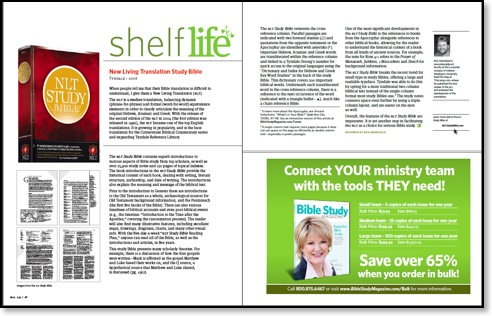
The March/April issue of Bible Study Magazine contains a review by yours truly of the NLT Study Bible. There is now a PDF posted on their website to my review. I’ve been asked to link to their preview page as opposed to directly linking to the PDF which is understandable so that you can see all that Bible Study Magazine has to offer. So when you get to the preview page, scroll down about halfway until you see this section:

Then click on the image or the words “NLT Study Bible” for the full review in PDF format.
If you want to read more about what I’ve written on the NLT and NLT Study Bible, you might want check out the following:
• My original review of the NLT
• My original (and longer) review of the NLT Study BIble
• Rise of the New Living Translation
• Repositioning the NLT as a “Scholarly” Translation
Hebrew Search Comes to Olive Tree iPhone Bible Reader Beta
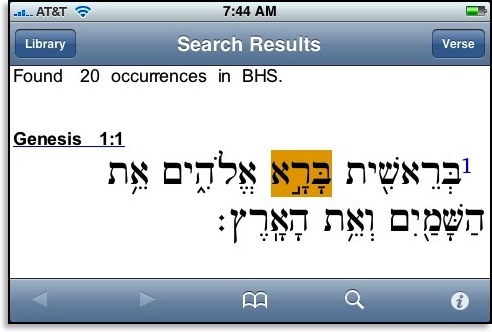
I’ve also found that reading Hebrew on the iPhone works better in landscape mode.
Again, this is still just a beta. Olive Tree has a number English texts already available (go to the iTunes store and search for “Olive Tree” ).
Greek Search Comes to Olive Tree iPhone Bible Reader Beta
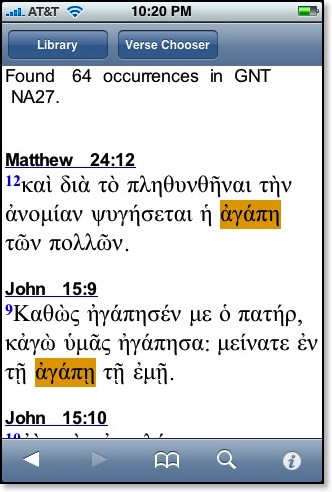
Above is a screenshot from the beta released last Friday. The actual method for entering Greek text is still a bit awkward, but it’s a good beginning. Hebrew search is not yet implemented, but is in the works.
Olive Tree has given me permission to discuss and post images of the beta.
Renaissance TNIV Reference Bibles Are Starting to Arrive
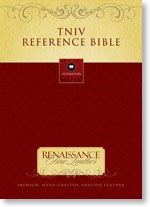
But I held one in my hand at ETS, and they are quite nice!
For folks posting about theirs see these links:
συνεσταύρωμαι: TNIV Reference Bible Has Arrived!
New Leaven: High Marks for Zondervan and TNIV
NRSV Notetaker's Bible
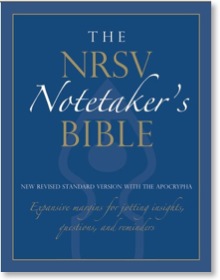
Product Description
Perhaps you're one of those studious, deliberate readers who likes to underline phrases, create outlines, list cross-references, etc. Now you don't have to resort to cramped lettering or words in the gutter. This single-column text, with 2-inch wide-ruled margins, allows you ample room for making all manner of notes. 1632 pages, hardcover. Oxford University.
Publisher's Description
The Notetaker's Bible offers the perfect format for students of the Bible who wish to make their own notes--whether scholarly notations or spiritual insights--rather than rely on the words of others.
Some wide-margin Bibles have only slightly larger margins on both sides of the page. And writing in the gutter is nearly impossible. In The NRSV Notetaker's Bible, we've eliminated those frustrations by giving you an extra-wide, two-inch outside margin. And because the text is a single column, your notes are always right beside the relevant passage. Moreover, we've added rules make it even easier to keep on track. For more expansive thoughts, you can turn to the back of the Bible for additional ruled pages.
In addition, this is the only available wide-margin Bible to feature the highly-regarded New Revised Standard Version translation, the preferred translation in most academic settings, as well as many churches and homes. So whether you're a student or professor, pastor or lay person, The NRSV Notetaker's Bible will fit your Bible study needs. Its open margins are a perfect match for your open mind.
The NRSV Notetaker's Bible is available in hardcover as well as in deluxe cloth and bonded leather, ideal for presentations and gift giving.
Here is a view of a page spread (click image for actual size):
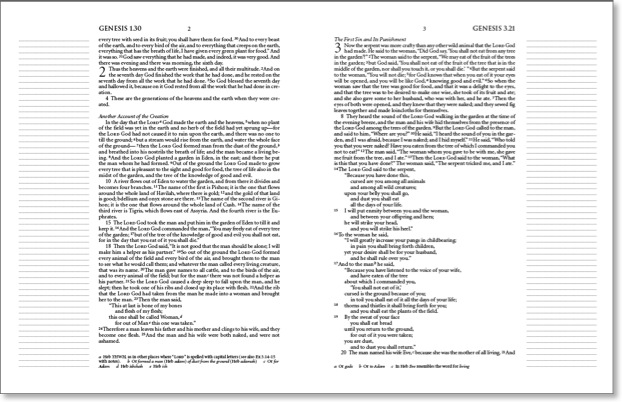
I’d prefer a page without the ruled lines, but maybe that’s just me.
HT: Jay Davis
A Comparison of the HCSB with Other Major Translations [Edwin Blum]
A Comparison of the HCSB with Other Major Translations
Abstract: Dr. Edwin Blum
The Holman Christian Standard Bible is a new modern translation based on the latest Hebrew and Greek texts. It was produced with the Accordance Bible software program and widespread use of the internet. Electronic editions of BDAG, K-B, reference tools, and translations greatly aided the development of the HCSB. Over one hundred scholars participated in the translation. The HCSB uses what we call an optimal equivalence translation philosophy and seeks to be gender accurate. In comparison with existing translations, the HCSB has improvements in accuracy, vocabulary choices, formatting, and style. It is the leanest modern translation with a word count of 718,943. It has more footnotes and textual information than any major translation and has a system of Bullet Notes to aid the reader. Yahweh is used in passages where the name of God is discussed in the OT, and Messiah is used in NT passages for the translation of christos where the subject is the Israelite deliverer. The result is a Bible that is accurate for study and reads well for personal use and corporate worship.
Introduction
To compare the HCSB with other major translations, we must define the term. What is a major translation? If this were a paper read at SBL, the major translations considered would be NRSV, REB, NAB, and NJB. These are highly esteemed but are not widely used by evangelical Bible students. For our purposes, the major translations we are using as comparisons are the NIV, NLT (second edition of 2004), and ESV. William Tyndale’s (1494?-1536) tradition, which includes the KJV, NKJV, NASB, RSV, and NRSV, will be represented by the ESV. Some may not be aware of Tyndale’s legacy to the 1611 KJV. Eighty-three percent of the KJV New Testament can be attributed to him. Of the books that Tyndale completed, the KJV Old Testament represents about 76% of his work. The NIV, NLT, and HCSB represent different translation streams. The TNIV, NET, and The Message are omitted from this comparison as they do not have a large market share at this time.
The HCSB was not “planned and sponsored by the Sunday School Board of the Southern Baptist Convention in 1998” as one website claims. The origin of this translation goes back to Dr. Art Farstad, who was the Executive Editor of the NKJV. On his own, he began working on a modern language edition based on the Majority Text, which he first called Tyndale 21 and later Logos 21. From 1995-1998 this project was funded by a foundation called Absolutely Free. Holman Bible Publishers purchased the rights to Logos 21 and hired Dr. Art Farstad as General Editor in April 1998. However, the translation Art was asked to oversee was not a majority text translation but a new translation based on the critical text. He died in September 1998, and Dr. Edwin Blum was named as his successor. The goals, purposes, and translation philosophy are outlined in the introduction to the HCSB, which can be found in every printed product.
The HCSB was completed in 2004. The NT of the NIV was finished in 1972 and the OT in 1977. This means that the NIV was completed before the days of the personal computer. It was completed before the internet was used to transmit documents between scholars and editors. It also means that the NIV represents the state of scholarship at the time of 1972-77. For example, the standard Hebrew lexicon in use was the Brown, Driver, and Briggs lexicon published in 1906. HCSB was able to use the new 5-volume Koehler, Baumgartner, and Stamm lexicon (HALOT, 1967-1996).
The theological word books such as Jenni-Westermann’s TLOT, the 15-volume TDOT, the Dictionary of Classical Hebrew, NIDNTT, and NIDOTT had not been published when the NIV was produced. Many major commentaries were also published in the interval between 1977 and 2004. For example, many volumes in the Anchor Bible were finished during this period. Milgrom’s three-volume work on Leviticus in the AB, which represents a lifetime of Jewish scholarship on this book, was completed in 2000.
The NIV translation committee changed 7% of the NIV text when they made the TNIV revision. While many of the changes made were gender changes (1.68% according to the TNIV committee), this means the scholars felt that 5.32% of the NIV needed an improvement. This 5.32% included changes that were “textual, programmatic, clarity issues, sentence structure & grammar, and footnotes & headings.” This is according to the TNIV website. So more than 5% of the NIV needed an improvement since 1977. Some of these changes reflect what can be seen in the HCSB.
Translation Philosophy
In practice translations are seldom, if ever, based purely on formal or dynamic/functional equivalence. Rather they are mixed, with a tendency in one direction or the other. Optimal equivalence is our attempt to describe a translation philosophy recognizing that form cannot be neatly separated from meaning and should not be disregarded. It should not be changed unless comprehension demands it. For example, nouns should not be changed to verbs or the third person “they” to second person “you” unless the original sense cannot otherwise be clearly conveyed. The primary goal of translation is to convey the sense of the original with as much clarity as the original text and the target language permit. Optimal equivalence appreciates the goals of formal equivalence but also recognizes its limitations.
Gender Issues
Since 1977 the gender controversy has become a major issue among Bible translators. The goal is to accurately translate Scripture. The ESV and HCSB follow the Evangelical Guidelines of May 27, 1997 for translation of gender-related language in Scripture. The NIV was done before there was a lot of gender sensitivity. One estimate is that there are 800 places in the NT of the NIV that use masculine language where the Greek text would allow a more generic or neutral translation. A classic example is Romans 12:6-8. In this passage, the NIV has inserted nine male pronouns or the word “man” where the Greek text does not require it. The NIV reads, “We have different gifts, according to the grace given us. If a man’s gift is prophesying, let him use it in proportion to his faith . . .” The HCSB is gender accurate and has no male language inserted in this passage. The HCSB reads, “According to the grace given to us, we have different gifts: If prophecy, use it according to the standard of one’s faith . . .” The TNIV has gone overboard to avoid gender insensitivity and is more gender neutral. We would claim that the NIV is gender biased, the TNIV attempts to be gender neutral, and the HCSB is gender accurate.
The NLT shares to a lesser degree the gender neutrality of the TNIV. Comparing 17 English translations in 115 gender-sensitive passages, involving various kinds of grammatical constructions, yields the following percentage of gender inclusive translations:
KJV 8%, RSV 10%, NKJV 13%, NASB 14%, NIV 17%, ESV 24%, HCSB 25%, NLT ’04 67%, TNIV 79%, NRSV 84%, CEV 96%. Clearly we believe a gender inclusive translation is correct 25% of the time—more than the KJV, but much less than the TNIV.
The result of a bias toward gender inclusivity is that many masculine terms are removed, muted, or changed. The Greek NT has anthropos 548 times and aner 216 times. Anthropos has a larger semantic field and should be translated as “human” in many contexts, but aner refers to a male person. Of the 216 times it occurs in the NT, NLT has removed, replaced, or changed it 43 times, eg. Ac 27:25 and Rm 11:4.
In the OT there are five major words for humanity. Adam means a man or human, and it occurs 546 times. Ish means male, man, or husband, and it occurs 2,199 times. (The female form is ishshah and occurs 775 times.) The Hb enosh occurs 42 times, and the Aramaic enash occurs 25 times, making a total of 67 occurrences. Gebher means manly or vigorous, and it occurs 66 times. So the total number of Hebrew words for men, males, or man is 2,878. If we only look at the word ish, which is the clearest term for male, it occurs 2,199 times. Yet the NLT only has the words “man, man’s, men, and men’s” a total of 1,617 times. For example, in Lv 20:2-5 ish occurs five times, but they change it to the plural words “they” or “them” instead of using the word “man.”
In many places, the more gender inclusive translations change “fathers” to “parents.” The book of Proverbs is no longer a father’s instruction to his “son”; instead, it’s written to his “children.” The HCSB and ESV have not followed this trend and have translated the text more accurately than the TNIV or the NLT.
Accuracy or Translations of Certain Problematic Words
The following words are representative of the accuracy of the HCSB.
1. The Greek word doulos occurs 124 times in the Greek NT. Many Bibles have translated it as “servant” or “bondservant.” ESV uses servant in the text, but they attach a footnote that reads, “Greek bondservant.” NIV and NLT alternate between “servant” and “slave.” The translation of doulos as servant is faulty (cf. BDAG, p. 260) and causes people to miss a significant Pauline metaphor. HCSB uses slave. There is a significant difference between a servant and a slave. Paul says, “. . . You are not your own, for you were bought at a price . . . ” (1Co 6:19b-20)
2. The key term torah occurs 223 times in the Hebrew Bible. Most Christian Bibles consistently translate it as law. Most Jewish Bibles normally use instruction or teaching. “The majority of present day exegetes translate tora as instruction, education, teaching” (TDOT, XV: 615). If we compare the translation of torah in Ps 1:2; 19:7, and 37:31 in the major Bibles we note the following:
• ESV – law
• NIV – law
• NLT – law and instruction
• HCSB - instruction
3. God’s personal name, YHWH, occurs 6,828 times in the Hebrew Bible. In English Bibles LORD is commonly used following the LXX tradition of rendering it with kurios. However, LORD is not a name; it is a title. It has been argued that the use of YHWH (or Yahweh) will offend Jewish people. Very orthodox Jews will not even vocalize the word “God,” preferring the use of “G-D.” However, some modern Jewish translations have used YHWH. French Protestants as well as the Moffatt translation have used “The Eternal” as a name. B. Waltke prefers to translate the name as “I AM” (OTT, p. 365.) If we compare the translation of YHWH in major translations we see the following:
• KJV – Jehovah 4 times
• RV (1881) – Jehovah 10 times
• ASV (1901) – Jehovah 6,777 times
• NJB – Yahweh 6,342 times
• NLT – Yahweh 7 times (all in Exodus)
• REB, NASB, NIV, NKJV, TNIV, ESV – all use LORD
• HCSB – Yahweh 75 times (first printing); currently 467 times; the 467 uses are where the name of God is praised or discussed. For example:
“I am Yahweh, that is My name; I will not give My glory to another or My praise to idols.” Is 42:8
“Yahweh is the God of Hosts; Yahweh is His name.” Hs 12:5
“May they know that You alone—whose name is Yahweh—are the Most High over all the earth.” Ps 83:18
4. In the HCSB NT, christos is translated Messiah where there is a Jewish context (cf. BDAG, p. 109). An example is, Mt 16:16, which reads “Simon Peter answered, ‘You are the Messiah, the Son of the living God!’” NLT agrees with HCSB, but ESV and NIV translate this as “the Christ.” (TNIV has changed this to “the Messiah”.)
Vocabulary Choices
The NIV, NLT, and the HCSB use a more modern and American vocabulary. The ESV retains some of its British heritage by including dated or archaic language. Here are some examples:
• ails Ps 114:5
• alms Lk 11:41 (8 total occurrences)
• barley was in the ear Ex 9:31
• bosom Ex 23:8 (12 total)
• chide Ps 103:9
• disdained 1Sm 17:1
• ears of grain Gn 41:5 (4 total)
• fodder Gn 24:25 (7 total)
• he-goat Pr 30:31
• morsel Gn 18:5 (13 total)
• she-bear Pr 17:12
• whoredom 2Ch 21:11 (13 total)
The NIV and TNIV also include some archaic or unusual word choices:
| abound |
spurn | |
| alas | strode | |
| astir | suckling | |
| befuddled | thus | |
| bosom | toil | |
| deluged | to no avail | |
| kindred | unkempt | |
| naught | unmindful | |
| profligate | unsandaled | |
| reckon | unto | |
| rend | unwary | |
| self-abasement | upon | |
| shall | vaunt | |
| slew | vilest |
When we compare six specific words among the major translations, we see the following:
1. Tithe - an old English word for a tenth.
• KJV – 40 times
• ESV – 41 times
• NLT – 22 times
• NIV – 15 times
• HCSB – 0
2. Behold
• KJV – 1,326 times
• ESV – 1,106 times
• NIV – 6 times
• NLT – 0
• HCSB – 0
3. Lepers, leprous, leprosy – should not be used today because of the confusion with Hansen’s Disease. Hansen’s Disease does not grow on clothing, walls, or other objects as mentioned in Lv 13-14.
• ESV – 68 times
• NLT – 34 times
• NIV – 33 times
• HCSB – 0
4. Shall – is fast disappearing in modern American usage (cf. B. Garner in Modern Legal Usage, 2nd ed., pp. 939-941).
• KJV – 9,838 times
• ESV – 6,389 times
• NIV – 467 times (TNIV – 480 times)
• NLT – 8 times
• HSCB – 0
5. O – is an old spelling of the word “Oh” and is considered archaic when used before a name in direct address, e.g. “O King, live forever.”
• KJV – 1,065 times
• ESV – 1,129 times
• NIV – 978 times (TNIV - 64 times!)
• NLT – 743 times
• HCSB – 0
6. Strong drink – is a 14th century term. HCSB uses the correct term beer. The average reader would understand strong drink to be a distilled product rather than a fermented one, but distillation was not discovered until the ninth century AD.
• KJV – 22 times
• ESV – 23 times
Verbose or Lean?
The word count of the Hebrew and Greek text in the standard critical editions is 545,202. Let’s compare this to some major translations.
• Original KJV |
774,746 |
• Current KJV |
790,676 |
• ESV |
757,439 |
• NLT |
747,891 |
• NIV |
726,109 |
• HCSB |
718,943 |
That means the ESV uses 38,496 more words than the HCSB to convey the source text of 545,202 words. As a side note, NASB95 is considered by some to be a fairly literal translation, yet its word count is 775,861. So it uses 56,918 more words than the HCSB.
Reader Helps
1. Bullet Notes - the HCSB has an appendix of 145 words or phrases that average readers might need some help in understanding. These words, e.g. Asherah, Ashtoreth, or atone, are marked with a bullet on their first occurrence in a chapter of the biblical text. When readers see a bullet in the text, they can refer to the appendix if they want to learn more about the term.
2. Footnotes – The HCSB has the following notes:
• 1,586 textual notes
• 5,161 alternate readings
• 843 explanatory notes
• 27,565 cross references
• 237 OT citations in the NT
The NIV and ESV have far fewer notes. For example, the NIV has no textual notes in Gl, Php, 2Tm, and Ti. HCSB has 16. The NLT does have extensive notes, but often a critical term like atone or atonement is left without explanation. In Nm 25:3 there is no help given on Baal of Peor. And in Lv 13:39, ESV uses the term leukoderma with no footnote to help the reader.
3. Formatting – In addition to special formats for poetry, dynamic prose, OT quotes, and using new paragraphs for new speakers, care has been taken in the database of the HCSB to avoid what is called widows and orphans in the typesetting process. Single words wrapping to the next line are avoided so that units of thought are kept together. This produces a Bible page that is more readable and pleasing to the eye.
In summary, the HCSB is more accurate than the NIV, ESV, or NLT. It reads well and has a modern, American vocabulary. Particular attention was devoted to clear and contemporary word order and formatting. The HCSB is more up-to-date in scholarship, and it offers more help and notes to the readers so they can understand what God is saying to them.
The most famous verse in the Bible is Jn 3:16.
NIV translates it as:
“For God so loved the world that he gave his one and only Son, that whoever believes in him shall not perish but have eternal life.”
Similarly, ESV has:
“For God so loved the world, that he gave his only Son, that whoever believes in him should not perish but have eternal life.”
NLT uses:
“For God loved the world so much that he gave his one and only Son, so that everyone who believes in him will not perish but have eternal life.”
However, the HCSB correctly translates the Greek houtos:
“For God loved the world in this way: He gave His One and Only Son, so that everyone who believes in Him will not perish but have eternal life.”
Craig Keener in his commentary The Gospel of John, Vol. 1:556 supports our translation when he says, "Some could understand English translations (God ‘so’ loved the world) as intending, ‘God loved the world so much’; but John's language is qualitative rather than quantitative. Houtos means ‘this is how God loved the world’; the cross is the ultimate expression of his love." His footnote reads, "On the syntax in 3:16 yielding ‘in this way,’ see esp. Gundry and Howell, "Syntax."
ἀλλόφυλος and Psalm 151
PSALM 151 |
||
LXX |
NETS |
NRSV |
1 οὗτος ὁ ψαλμὸς ἰδιόγραφος εἰς Δαυιδ μικρὸς ἤμην ἐν τοῖς ἀδελφοῖς μου 2 αἱ χεῖρές μου ἐποίησαν ὄργανον 3 καὶ τίς ἀναγγελεῖ τῷ κυρίῳ μου 4 αὐτὸς ἐξαπέστειλεν τὸν ἄγγελον αὐτοῦ 5 οἱ ἀδελφοί μου καλοὶ καὶ μεγάλοι 6 ἐξῆλθον εἰς συνάντησιν τῷ ἀλλοφύλῳ 7 ἐγὼ δὲ σπασάμενος τὴν παρ᾿ αὐτοῦ μάχαιραν |
1 This Psalm is autographical. I was small among my brothers 2 My hands made an instrument; 3 And who will report to my lord? 4 It was he who sent his messengerd 5 My brothers were handsome and tall, 6 I went out to meet the allophyle, 7 But I, having drawn the dagger from him, |
1 I was small among my brothers, and the youngest in my father’s house; I tended my father’s sheep. 2 My hands made a harp; 3 And who will tell my Lord? 4 It was he who sent his messenger 5 My brothers were handsome and tall, 6 I went out to meet the Philistine, 7 But I drew his own sword; |
Our Bible study at church last Sunday came from 2 Samuel 5-7. The curriculum we use drew upon a theme, “When Assessing One’s Work.” With that theme in mind, and because the chief figure in 2 Samuel is David, I thought that I might introduce my Bible study class to Psalm 151. As I suspected almost everyone in my class was unfamiliar with this Psalm as it is not accepted by Jews, Protestants or Catholics, but is considered canon by the Orthodox Church. Traces of this Psalm, found in the Septuagint, have been discovered among the Dead Sea Scrolls, so its origin is probably Hebrew after all.
Unfortunately, my bright idea to use Psalm 151 was practically an afterthought to my preparation of the lesson from 2 Samuel. In fact, as I was walking out the door, I grabbed by copy of the New English Translation of the Septuagint (NETS) and added it to the stack of volumes I was already carrying. I had not looked at Psalm 151 recently, but was merely drawing off my memory of its theme and content.
At our church we have our worship service before our time of Bible study. After getting a bit settled, I opened up my copy of the NETS that I had grabbed as I was leaving the house to take a look at its rendering of Psalm 151. The NETS, released only last year, is the most current English translation of the LXX. Everything seemed fine until I got to v. 6:
I went out to meet the allophyle, and he cursed me by his idols.
Allophyle? What’s an allophyle? I had not read Psalm 151 in a while, but I knew I didn’t remember seeing this particular word in other translations. Now, if you look above at my chart containing the Greek text, you’re better off than I was Sunday morning. I didn’t have a copy of the Greek text with me. And I couldn’t figure out what an allophyle was immediately from the context.
I pulled my iPhone from my pocket, and tried looking up the word in the Merriam-Webster Dictionary app. No dice. The word allophyle was not to be found. I nudged Kathy and pointed to the word, asking if she knew what it meant. She asked for the reference, and I told her “Psalm 151:6.” She picked up her Bible, but then rolled her eyes, put her Bible back down and ignored me, realizing that Psalm 151 was not going to be in her copy of the New Living Translation.
I tried to figure out meaning based on the derivation of the word. I assumed it was created from two Greek words, and correctly guessed that allo- came from ἄλλος/allos, meaning “other” or “another.” But I went in the wrong direction with -phyle. I incorrectly guessed that perhaps somehow it came from φίλος/philos, meaning “beloved” or “dear.” We get words like bibliophile (lover of books) from this word.
But this made no sense. David went out to meet his other lover? And then cut off his head? Well, I knew from both memory and context that the individual in question was Goliath, so I knew something was off from my guess. I ran a search on my iPhone for Psalm 151 on the internet and found the NRSV translation of “Philistine.” That didn’t explain my immediate question, but it did give me another way to read the verse during our Bible study.
Once I was home and able to look up the passage in the Greek of the LXX, I realized that in using allophyle, the NETS essentially transliterates ἀλλόφυλος/allophulos, a word often translated Philistine or foreigner based on the context. I freely admit that I was not familiar with the word as it only occurs once in the New Testament:
“And he said to them, “You yourselves know how unlawful it is for a man who is a Jew to associate with a foreigner (ἀλλόφυλος/allophulos) or to visit him; and yet God has shown me that I should not call any man unholy or unclean.” (Acts 10:28, NASB)
How does one get foreigner, Philistine or even Gentile (as some translations render it) from the word? Well, as I said, I was wrong about my guess regarding -phyle. It didn’t mean “beloved” but rather came from the Greek word φυλή/phule (from which we get words like phylum), meaning “race” or “tribe.” So ἀλλόφυλος/allophulos literally means “other race” and thus foreigner.
On p. 246 of the NETS, there is passing reference to peculiar habit of the Old Greek to translate “פלשתים ‘Philistine’ as (ὁ/οἱ) ἀλλόφυλος/-οι ‘allophyle(s),’ first seen in the book of Judges (3.3, 31; for a total of 20x), rather than the transliteration φυλιστιμ (‘Phylistim’ ) found already in Genesis (8x), Exodus (2x), Iesous (Joshua) (1x), Judges (6x) and Sirach (3x).” However, there’s no explanation why the NETS chooses to transliterate the word in question as allophyle. My only guess is that this is done to designate when the the LXX is doing the same, although the word occurs many other times in contexts simply meaning “foreigner” and the NETS does not transliterate it in these instances.
So now there’s only one other question. How common is the English word allophyle? As mentioned earlier, it wasn’t in the Merriam-Webster Dictionary, and even now as I write it on my computer, a red line underscores it. I wondered if perhaps allophyle is used in biblical or historical studies so I ran a search for it in literally thousands of reference books and journals in Accordance. The only hits I received for the word came from the NETS. Even running a Google search, if limited to English hits, results in only 95 websites, and most of these are questionable regarding any solution to my curiosity.
So, help me out. Have you come across the word allophyle anywhere in English besides the NETS? If you have, please list the source in the comments.
Election Day
No, I’m not going to tell you who that candidate is. Such things are strictly between me and my hanging chad.
However, I do want to make two suggestions. First, if you don’t vote today, you are squandering a very real privilege you possess to have a say in who your governing officials are. Most people in our world today still do not have this privilege and almost no one in history did. Not voting doesn’t mean that you have less right to voice your opinion later (that’s the beauty of the system in which we live), but I, for one, will not listen to you as closely.
Second, regardless of whether the candidate you vote for wins or loses today, I would ask that for those of you who consider yourselves Christians commit to regular prayer for the victor. In the sermon on the mount, Jesus said, “If you greet only your friends, what’s so great about that?” (Matt 5:47, CEV). By extension of principle, if you only pray for the president if you voted for him, what is so great about that?”
In the first century, the Apostle Paul encouraged Christians to pray for their rulers so that they might live in peace. This was in a world in which they had no say over their government. We have been given so much more. Should we therefore, not also pray for them even more?
“The first thing I want you to do is pray. Pray every way you know how, for everyone you know. Pray especially for rulers and their governments to rule well so we can be quietly about our business of living simply, in humble contemplation.” (1 Tim 2:1-2, The Message)
First Look: Hebrew & Greek Biblical Texts on the iPhone
The screen shots below are from a beta released yesterday from Olive Tree (I have permission to post these images):
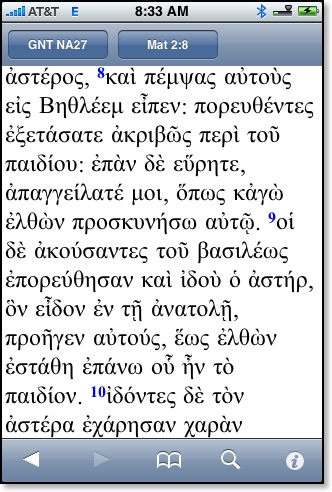

Frequent readers of This Lamp will know that I’ve lamented the loss of original language biblical texts “in my pocket” ever since switching from my Palm Treo to the iPhone last year. After a long wait, Olive Tree comes through with the promise a full replacement, and I have to admit that the texts look much better here than they ever did on my former device.
As you would expect, these texts are fully downloaded to the iPhone and do not require an internet connection for repeated access.
While I’ve got your attention, let me show you a couple of other things Olive Tree is working on for their Bible Reader.
Since my initial review, Olive Tree has incorporated links to textual notes and cross references in their modules.
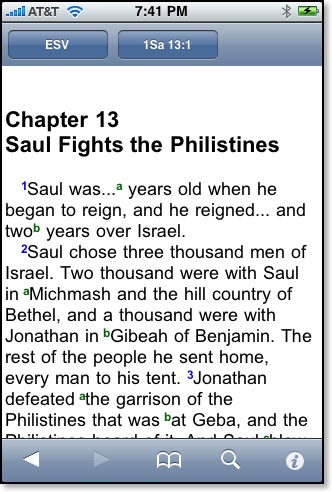
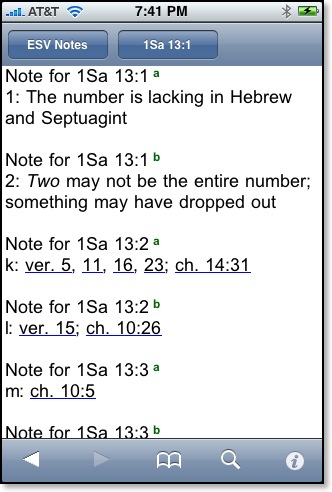
For instance, as demonstrated in the above modules, clicking/touching the superscript letters in the ESV leads to a appropriate section in the ESV notes. This is still not split screen, which I would prefer, but it’s a good start.
Traditionally, Olive Tree has allowed users who purchased texts for one platform to download these on any other platform as well. For instance, after purchasing modules for the Palm years ago, I was also able to download the same texts to a Windows Mobile device while I was testing one out a while back. However, this generous level of cross platform mobility has not been possible so far with the iPhone because Apple tightly controls iPhone apps and requires them to be distributed via the iTunes Store only with the exception of beta releases as seen in some of the images here). And not only do previously purchased modules have to be re-purchased, they have to be purchased separately. Again, this is not a policy from Olive Tree, but rather from Apple.
Right now, for instance, if an iPhone user purchases the NIV Family Pack for Bible Reader and the ESV Study Bundle, two separate installations of the Bible Reader are loaded with each respective set of modules. Other text reader programs in the iTunes App Store have been allowed to include modular purchases, so Olive Tree is trying to work with Apple to make the same kind of access available to users of their Bible Reader.
These screen shots below from a beta release (features not yet approved by Apple) show a “store” from Olive Tree where users could purchase texts directly for download over the internet to their iPhones. Once texts have been purchased and downloaded, they show up on a “My Olive Tree Account” page.
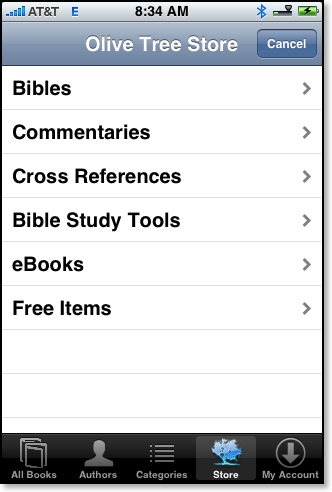

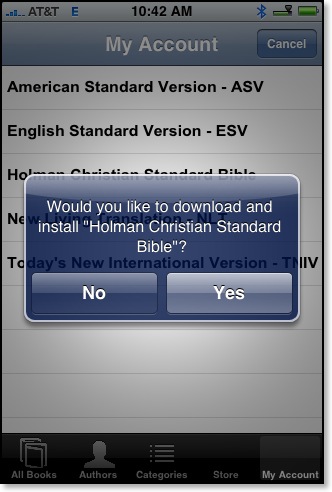


Let’s hope that Apple will approve Olive Tree’s solution because it’s a good and fair answer to the current modular dilemma.
See also:
• Olive Tree’s iPhone page
• To see Olive Tree’s current offerings in iTunes, search for “Olive Tree” in the iTunes Store Search window.
Then in the “Applications” box, select “See All.”
Repositioning the NLT as a "Scholarly Translation" [UPDATED]
Consider this a mild follow up to my post “The Rise of the New Living Translation,” but I’ll keep this one short and to the point.
Notice the graphic which I’ve swiped from the Tyndale website. Here the NLT is described as “The standard in scholarly translation with rich, clear language.” I have no real argument with this description. The NLT’s language is certainly richer and clearer than the NIV/TNIV, ESV, HCSB, and other contemporary translations. I’ve described the NLT as having phrasings closer to natural, conversational language than any other translation.
But is the NLT scholarly? I’d point to the translators involved and the continued fine tuning of the NLT through three revisions in 12 years to say, yes.
Granted this is the real question. We probably haven’t always thought of the NLT as a “scholarly” translation, and perhaps its status as such was more questionable in 1996, but it has continued to improve. As I pointed out in my “Rise” post, the creation of an NLT-dedicated commentary series such as the Cornerstone Biblical Commentary series, the tying of the translation to the original languages through the newly formulated “Tyndale Strong’s Numbering System,” and the publication of an NLT Study Bible at least on par with--if not slightly more academic than--the standard NIV Study Bible, all point to Tyndale’s repositioning of its flagship translation as a translation intended to be taken very seriously.
The link to the Tyndale Strong’s Numbering System in the paragraph above will take you to a post on the NLT blog asking if the NLT, as a dynamic translation, is suitable for word studies. The newest post on the NLT Study Bible Blog asks “The NLT: Good for Study?”
If you haven’t already guessed--YES, Tyndale is serious about this.
Look, I don’t know what it will take for the NLT to become a standard English translation in seminaries one day, but it’s not beyond imagination considering the NIV has held that spot for over two decades.1 But let’s put seminaries aside for the moment.
I currently teach in church and in the college classroom. My desire is for the people that I’m teaching to (1) understand the Bible, (2) take what they understand seriously, and (3) let the Bible transform their perspective on life and the world. However, I’ve often noticed when watching others teach the Bible that eyes glaze over when the Scriptures are being read. Reading from the Bible is often a cue to zone out. Why is this? Is it perhaps because we’re too used to what we’ve heard in Tyndale-family translations,2 and even from the NIV?
Granted, it never hurts to read the Bible with a little expression, and sadly many preachers and teachers don’t have a clue as to how to effectively read from the scriptures; but it may just be that it’s time for a new kind of translation to catch people’s attention. Maybe it’s time to use a translation that is fresh enough and bold enough to capture the spiritual imagination of people again.
As for the scholarly angle, there are a few things that Tyndale will have to do if they want to take things to the next level.
- Beef up Tyndale’s academic catalog. This is where Zondervan, primary US distributor of the NIV, has excelled. Tyndale has a few academic offerings, but there’s much room for improvement.
- Continue to connect the NLT to the original languages. I would suggest that Tyndale should immediately launch a project to publish a NLT/Greek diglot. Include notes that offer explanations behind particular NLT renderings from the Greek. Transliterate nothing. This should be a volume strictly for those who have a background in original languages.
- Publish a series of articles (maybe an ongoing series of books?) by the translators of the NLT regarding translational challenges and decisions behind the translation.
- Publish a series of preaching resources that use the NLT as a basis.
- Offer some serious gatekeeper editions: traditional format preaching editions, wide margin editions for study and teaching.
- Renew attention to the NLT apocrypha/deuterocanonicals. Publish an edition of the NLT with these books that is not labeled a “Catholic edition.”
- Make good use of testimonials from both academics and popular pastors.
- Hold off on any further revisions for at least a decade. Three editions in 12 years is unprecedented. The updates to the NLT have been warranted, but readers need to know that the text has been established/set--at least for a while.
I do believe that Tyndale is smartly doing most things well in their promotion of the NLT and repositioning it as a translation both for serious study and one for scholarly pursuits, but there is still a lot of work to done creating a suitable scholarly context for the NLT before it is completely there. Nevertheless, as I originally pointed out in the “Rise” post, Tyndale is not going to be content to sit back and let the NLT continue to be seen as secondary translation to be read alongside supposedly more scholarly ones. Rather, the message being proclaimed is clear: the NLT can serve these purposes as well.3
1I’m referring primarily to conservative/evangelical schools, but the NIV has also gained acceptance beyond these circles where translations like the RSV and NRSV are considered standards.
2This can quickly become confusing. When I use the designation “Tyndale-family translations,” I’m referring to versions of the Bible that follow in the lineage established by William Tyndale including the KJV, RSV, NASB, NRSV, ESV and others. Obviously, the reader should not confuse this with the fact that the company, Tyndale House Publishers, publishes the NLT.
3As I’ve discussed before, my greatest challenge in using the NLT for teaching would come when discussing poetic passages. Although the second edition of the NLT is an improvement here, I still struggle with wanting to hold on to the beauty of some Hebrew metaphors that often become flattened out a bit in the NLT. However, that is not to say that I couldn’t use an approach such as that in Tom Gledhill’s helpful commentary on the Song of Solomon (The Message of Song of Songs [Bible Speaks Today], IVP) in which he uses both a free translation as well as a literal translation to get the meaning of the Hebrew text across.
TNIV Gate Keeper Profiles, Part 3
Jeremy O'Clair
Church of Christ, College-level Bible Teacher
Tallahassee, Florida
I've been using the TNIV for about three years now. At my (then) seminary, our dean passed out TNIV Bibles to all the seminary students interested in having a copy -- a simple black hardback. Since it was a relatively new release I decided to give it a try and came to like the overall clarity of the translation. I started out reading through the Bible with the TNIV audio online (Genesis, Exodus, etc.), and really liked how clear and understable the translation was for me. Of course, I would check it against the original Hebrew or Greek if there was a passage I wanted to investigate closer through a word study or exegesis.
In summer 2007 I taught a class on Galatians using the TNIV while interning at my parents' church; then after moving to Tallahassee last fall I also taught Galatians, with the TNIV, at the church I attend, teaching the college class. Since then we've worked through 2 Peter and some history of the Bible. I'm now co-teaching through the book of Romans while I use the TNIV and the other teacher uses his NRSV -- so it should be interesting how the class turns out when comparing the two translations!
The gender inclusive language is another reason I use the TNIV. I like the rendering of the generic masculine nouns (such as anthropos, adelphoi, etc.), but how the TNIV, naturally, retains gender specific words such as ἀνήρ/aner and γυνή/gune. I've been trying to enlighten people on this subject, with the TNIV in one hand, and Greek text in the other, looking at this translation preference in many passages (there weren't mere brothers in the congregations but there were brothers AND sisters!).
Basically, the readability of the TNIV really works for me. For the most part the readings have been quite smooth. But if there is a reading that might seem too glossed over, I'll check the original languages and inform my audience of the translator's task when it comes to translating Scripture.
Debbie Fulthorp
Pastor, Grand Canyon Assembly of God
Grand Canyon, Arizona
My husband and I co-pastor the Assembly of God church inside the Grand Canyon National Park (South Rim). We believe that our church is in a strategic location to reach nations for Christ. We feel that we are not only pastoring a church, but the community God called us to. Because of that reason, we prefer to use the TNIV Bible. We minister on a regular basis to people who are unchurched, and may have never heard the story of Jesus, let alone read the Bible. We have found that using the TNIV circumvents questions about various passages and also uses language non-English speakers can understand. For example, through divinely appointed relationships we were able to give one of the Royalty in Thailand a Bible. Another girl who was Muslim, recently dedicated her life to Jesus. The TNIV is perfect for those who have not been in the church because they can understand that ALL PEOPLE can come the the cross regardless of gender, nationality, age, or economic status.
On a more personal note, I love the TNIV because I am a pastor. I experienced the TNIV my first year in seminary, before I fully understood that God could call a woman to be a pastor. Studying the Greek texts and comparing the TNIV side by side at various texts, brought me one step closer in my journey towards following the will of God for my life. I had no idea God could use me as a pastor, but through studying the TNIV and comparing Greek texts (at the time only New Testament was available) gave me the theological underpinnings for the ministry God placed my husband and I in today.
I love the TNIV because it has given us so many doors for ministry, sharing the gospel to men and women unbiasedly where they can understand it.
My husband and I as well as our church are gatekeepers as we minister together in one of the most transitional places of ministry. We might be a small missions church, but we see the Gates of the Grand Canyon National Park as our place of ministry where every nation, tribe and tongue should have a chance to know God through hearing His Word and experiencing Him through personal relationship!
Feel free to interact with Jeremy & Debbie in the comments.
Other posts:
Part 1
Part 2
New Journaling Bibles on the Horizon (HCSB, NRSV)
There are two new editions in the HCSB, called the HCSB Notetaker’s Bible, set for release very soon (October 8). One is referred to as a Men’s edition (ISBN 158640475X) and comes in a decorative brown hardcover. A women’s edition in mauve/olive green is also available (ISBN 1586404768).
There are no page spreads available for viewing yet, but these images of the covers are available at the CBD website (click on each image to see each Bible’s respective page):
Really, B&H should have probably avoided calling these “Men’s” and “Women’s” editions. I’m certain there will be some women who want the brown, and you never know who might want the other edition as well.
The CBD website also includes the following ad copy:
In an age when people can take notes using a variety of electronic media, there has emerged a countertrend whereby people want to journal in their won handwriting. The Notetaker's Bible features wide margins with subtle ruled lines, helpful center-column cross references, a concordance, and best of all, the largest point size among all Bibles of this kind. Handsomly bound for a man's taste. [The women’s edition says “Beautifully bound in with a woman's taste in mind.”]
Features include:
- The largest point size among Bibles of this kind
- Easy-to-navigate center-column references
- An easy-to-use concordance
- Ribbon marker
- Words of Jesus in red
- Translation footnotes, and exclusive HCSB bullet notes
Both Bibles measure 9.38 x 7.25 x 1 and contain 1280 pages. Biblical text will be presented in double columns. Personally, I feel that if a Bible of this sort uses double columns of text, there should be equal amounts of spacing for written notes for each column. We will have to see if B&H Publishing thought of this.
While I was on the CBD website, I also noticed an NRSV Notetaker’s Bible (ISBN 0195289226) to be released from Oxford University Press in 2009. There aren’t a lot of details yet, and no image that I could find even of the cover. But according to the CBD site the Bible will be paperback, contain 1296 pages, and measure 8 x 6.3 inches.
NLT: "Highway to Hell"
Sunday at church, our pastor referenced Matt 7:13 with the NIV text on the overhead screen:
“Enter through the narrow gate. For wide is the gate and broad is the road that leads to destruction, and many enter through it.”
Kathy, who refuses to carry anything other than the New Living Translation, nudged me to show me what her Bible said:
“You can enter God’s Kingdom only through the narrow gate. The highway to hell is broad, and its gate is wide for the many who choose the easy way.“
When the NLT was released in 1996, I spent the next year or so reading it cover to cover. It was unexpected renderings such as this that made me fall fall in love with the dynamic flavor of the NLT. I look at a rendering like “highway to hell” and at first it startles me, but then upon reflection I delight to realize that it absolutely carries the meaning of the phrase, ἡ ὁδὸς ἡ ἀπάγουσα εἰς τὴν ἀπώλειαν, into the contemporary vernacular in a clear and contemporary way.
I also appreciate the verses that employ the word “scum” (Matt 9:11; Mark 2:16; Luke 5:30).
The only problem with the NLT’s rendering of Matt 7:13? Now I have that AC/DC song playing in my head...
Quote for the Day #10 (Jerome)

“Ignorance of scripture is ignorance of Christ”
--Jerome
Referenced in “Singing the Blues with St. Jerome” at ChristianHistory.net.
More on Olive Tree's iPhone Bible Reader
Today, Steve Rogers (Captain America?) left a comment asking the following questions:
Will these bibles work with the iphone 3G? Are there plans to create an NIV and NLT versions for iphone 3G. Those are versions that I read.
Olive Tree’s Bible Reader works with any iPhone that has the 2.x software loaded, obviously including the iPhone 3G.
And yes, there are plans to release the NIV and NLT versions. In fact here are screenshots of these two translations from a beta version I have loaded on my iPhone:
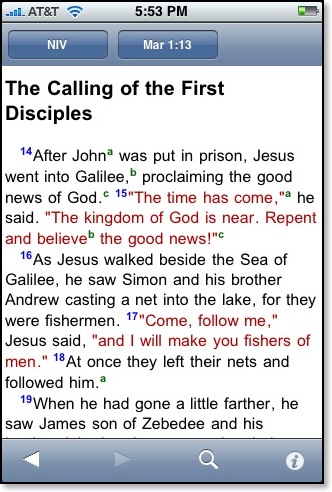
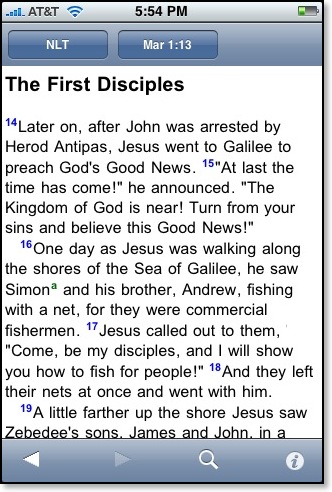
Note: Olive Tree does not require I sign an NDA for use of its beta, and I have been given permission to share any information about the beta including the images above.
TNIV Gate Keeper Profiles, Part 2
Dan Masshardt, Pastor
New Cumberland, Pennsylvania
I had been a fairly consistent NIV user since High School, although I have always utilized other translations. Then two years ago my seminary gave a hardcover copy of the TNIV to students from the publisher. I was quickly hooked and it has been my translation of choice ever since.
I pastor a medium sized church and now use the TNIV for all of my public teaching and preaching as well as my primary Bible for study. I listen to the TNIV in my car and at home on CD as well. There are both practical and intellectual reasons for liking the TNIV so much.
Practically, it is similar enough to the NIV that so many people still using that translation don’t feel lost when I read and teach from the TNIV. Also the “gender accurate” language means that I do not constantly have to explain that “this applies to women too.” The translation is easy to read and understand what is being communicated. The challenge is now in interpretation and understanding the content of the message, not working through wooden or outdated language.
While some may not notice, it is helpful to look into many of the updates made to the NIV translation and see that now we have even more accuracy than before. Enhanced accuracy in a package that is highly readable is tough to beat.
For these reasons and others, I enthusiastically recommend the TNIV to friends and members of our congregation. I love the Reference Bible personally, but will recommend the TNIV Study Bible as well as the audio format for a long time to come. Thanks to the translators and publishers for all their hard work to serve the Church!
Greg Cohoon, Sunday School Teacher
Mount Pisgah United Methodist Church
Greensboro, North Carolina
I have been teaching an adult Sunday School class at my church for the past 4 or 5 years. It's a class that I "inherited" when the previous teacher moved. The class was formed about 15 years ago out of a desire for adults to have a class for in-depth Bible Study and developed along the lines of simply going through the Bible verse by verse, starting in Genesis. We typically cover about a chapter per week. The structure of the class is a hybrid lecture/discussion, where I encourage class participants to share insights they have about the particular passage being studied. In addition to encouraging and guiding discussion, I provide lecture on various aspects related to the passage: historical information, literary form of the passage, simple word studies, etc. The resulting mix is a somewhat scholarly treatment of the material, with discussion of how the truths revealed in each passage are applicable in our daily lives. When I started teaching, the class was near the end of 2 Chronicles. We are currently in the middle of Isaiah. I like to joke that we are working through a 75-year reading plan.
I don't precisely remember how I discovered the TNIV. I suspect that I discovered it as a module in my Accordance Bible Software. I rely on that software heavily to prepare my Sunday School lessons, as it allows me to easily compare different translations as well as have a huge wealth of study tools available for preparing my lessons. I'm a firm believer that all Bible translations are imperfect, so I greatly appreciate the ability to compare a variety of translations when studying and teaching. The most popular translation in my class is the NIV, so using the TNIV when teaching was a natural choice that would sound familiar to my students as well as being different enough to remind us that we are studying from a translation. I currently use several translations in class, with the TNIV and ESV being the two I use most often. It's always exciting and interesting when translation differences help spark a deeper study of the particular passage being examined. I like that by exposing the class to various translations, it gives us an opportunity to discuss translation philosophies and engage in simple word studies on a regular basis. I especially like that by using the TNIV, I am able to present a translation that is very familiar to my class, while introducing a fresh take.
I mentioned my use of Accordance Bible Software in my preparation. While it is very convenient to have a powerful computer program to assist in preparation, I've still found that nothing beats actually holding a book and turning the pages for studying God's word. In class, I always read the text from a Bible, not from a computer. I'm really looking forward to being able to incorporate this nice Bible into my teaching routine.
Feel free to interact with Dan and Greg in the comments.
Other Posts:
Part 1
Part 3
Test Your View of the NT Use of the OT
You can see my results below. Feel free to take the quiz yourself. Post your results in the comments or a link to your blog if you post your results there.
| NT Use of the OT -- Test Your View! |
| Fuller Meaning, Single Goal view You seem to be most closely aligned with the Fuller Meaning, Single Goal view, a view defended by Peter Enns in the book "Three Views on the New Testament Use of the Old Testament" (edited by Kenneth Berding and Jonathan Lunde, Nov. 2008). Since the NT writers held a single-minded conviction that the Scriptures point to and are fulfilled in Christ, this view suggests that the NT writers perceive this meaning in OT texts, even when their OT authors did not have that meaning in mind when they wrote. It should be noted, however, that advocates of this view are careful not to deny the importance of the grammatical-historical study of the OT text so as to understand the OT authors on their own terms. For more info, see the book, or attend a special session devoted to the topic at the ETS Annual Meeting in Providence, RI (Nov. 2008); Walter C. Kaiser Jr., Darrell L. Bock, and Peter Enns will all present their views. |
Fun quizzes, surveys & blog quizzes by  |
Are We Nearing a Full Blown Depression?
“O that my head were a spring of water,
and my eyes a fountain of tears,
so that I might weep day and night
for the slain of my poor people!”
(Jer 9:1 NRSV)
Housing bust, record foreclosures, out of control gas prices, job losses, major financial institutions going under. Really, in my 40 years I’ve never seen anything like it. This was a topic of discussion with my students before our class last night, and I made the statement, “It seems as if we’re nearing a full blown depression.”
Very quickly, one of my students shot back, “Well, you’re the only one to admit it!”
When I asked her what she meant, she said, “All of the politicians on television refuse to even admit that we’re in a recession when everyone knows we are.”
She’s right of course. This election year I’ve been on the email lists of both Barak Obama and John McCain. Obama sent out an email today referring to the situation as “our financial crisis.” Yesterday, McCain referred to “these tough times.” Bush says we’re in the middle of an “economic slow down.” No one wants to use the “R” word and certainly not the “D” word. This is an election year, after all.
The New Oxford American Dictionary defines recession as “a period of temporary economic decline during which trade and industrial activity are reduced, generally identified by a fall in GDP in two successive quarters” (a depression is simply defined as “a long and severe recession in an economy or market” ). So I don’t know if the situation meets this actual criteria but I know times are difficult economically, and I don’t yet see any indication that the immediate future is brighter. I’m generally not a doom-and-gloomer, but I really believe we should be prepared for potentially worse days ahead.
Flipping through the pages of the Renovaré Spiritual Formation Bible, my eyes happened to stop on the note accompanying Jeremiah 9:1. As you read the words below substitute in your mind the word politicians in place of kings.
“Grief is a prophetic activity. Kings put a happy face on everything, tell the people this is the best of all possible worlds and they never had it so good. It takes a truthful prophet to have the guts to grieve societal disaster. Tears are a sign of relinquishment, a letting go of false hopes and false gods, an admission that we are in sad shape and need of deliverance. The community that is faithful to the truth is always the place where we go to grieve, where we are given the space and permission to weep. Grief is not the final prophetic act, but it may be the first--an honest admission that we are a people who need a God who loves and saves. Tears are thus a prelude to openness to the possibility of divine deliverance.”
More on Renovaré

See “A Life Formed in the Spirit” as well as the sidebar “Richard Foster on Leadership.”
On a related note, I’m still investigating the Renovaré movement, and I appreciate all the helpful comments in my earlier post. I pulled Celebration of Discipline off the shelf and plan to go through it again (this time because I want to, not because it’s an assignment). I’ve also obtained Streams of Living Water and The Renovaré Spiritual Formation Bible.
I like what I’ve seen so far because it seems to be an intelligent manifestation of Christianity that does not lapse into the realm of the overly academic. I often read very good books that unfortunately because of their level of content, I couldn’t simply hand over to the average person in my church. The Renovaré materials aren’t necessarily material that one progresses through quickly--to take them seriously they need to be digested at a slower pace than some books. Nevertheless, they are more accessible than some of the materials I work with in my regular pursuits.
Further, while there seems to be quite a few titles if one looks at Renovaré strictly in terms of publications, I don’t get the impression that these are materials that are overly commercialized. In other words, none of this strikes me as “the hot Christian book or Bible study of the moment.” There seems to be enough content involved here that this is more than a box to be checked, and happily none of it strikes me as another NBT (“next big thing” ).
Renovaré also seems to promote an experiential kind of faith that doesn’t bleed over into the sensationalistic.
I’ve been a Christian now for over thirty years. I’ve had a rich experience in which people have invested in me, and I’ve invested in others. But I don’t mind admitting that I feel like something is missing. Don’t misunderstand. I’m not speaking of a lack of faith or anything in that regard. I’ve felt for a while that something in the experiential realm of my faith that is lacking. In reflection about this, I’ve often wondered if those of us who call ourselves Protestant, and even those of us who claim the title of Baptist, haven’t worked so hard to separate ourselves from the rituals associated with the Catholic Church that we threw out the baby with the bath water (my apologies to my current writing class students for resorting to a cliché ).
Traditions do not have to be bad. They give us something tangible, something to hold onto. And so now when I look at the spiritual disciplines again in Foster’s Celebration of Discipline, when I see the six traditions described in Streams of Living Water, when I begin to reorient my thinking about the Kingdom of God as a necessary experiential part of my life as Dallas Willard describes it in The Divine Conspiracy, I have to wonder if I have now begun to find what I’ve been missing?
One minor nitpick... The Renovaré Bible comes in two editions, one with the Deuterocanonicals and one without. Although I do not view these “extra” books as canonical, I do find them to be of value and even inspirational (but not inspired). So when presented with the two editions of the Renovaré Bible, under normal circumstances, I would have preferred to have the one with the extra books. However, while searching for reviews of this Bible on the internet, I came across Zondervan’s webpage for the Bible in which it was advertised that there was an “Italian Duo-Tone Edition” of the Renovaré Bible:

My desire for what sounded like a “leather-like cover” trumped my appreciation of the Deuterocanonicals (I’ve got copies of them in other Bibles anyway, right?), so I found the matching ISBN edition on Amazon and ordered the Bible from there. The Amazon page did not mention Italian Duo-Tone, but since Zondervan is a sister company of HarperCollins, the actual publisher of the Bible, I assumed the Zondervan page was correct.
Not so. To my disappointment the edition I got in the mail--the edition with the same matching ISBN--is decidedly NOT Italian Duo-Tone. It’s merely the same black hardback edition I’ve seen in every edition of the Renovaré Bible I’ve handled in bookstores. If I’d known this was the case, I would have ordered the copy with the extra books, if for no other reason than to have the associated spiritual formation commentary accompanying them.
I don’t know what’s going on with the ad as seen above. It’s a mistake or someone has redefined Italian Duo-Tone as “black hardcover.”
I know I should quit my whining, and I’m sure there’s something about contentment in this Bible, but I haven’t read that section yet...
Tyndale Releases List of Changes to "NLT 2007"

Unlike some publishers [*cough*Crossway*cough*], Tyndale has graciously agreed to make the changes in the 2007 update of the NLTse public. A complete list of changes in the 2007 text can be accessed from a PDF file posted on Tyndale’s website. I’ve not had a chance to look at the changes in depth yet, but a cursory survey demonstrates a continued “fine tuning” of the text for the sake of accuracy. The PDF file released by Tyndale highlights changes to the text in red so that they are easier to spot and examine. Changes made to footnotes are included as well.
My thanks goes out to Mark Taylor and the team at Tyndale House Publishers. In recent weeks they’ve created a team blog and allowed readers to offer feedback via comments. They’ve even been gracious enough to field critical comments, something in the past that few publishers have been brave enough to do in such a public forum. Allowing the changes in the NLT 2007 text to be made public on their website is yet another example of Tyndale’s transparency in recent days, something I believe readers greatly appreciate.
You can view the 2007 changes to the NLT text either at the link I provided above, or go to www.newlivingtranslation.com, click on “Discover the NLT/FAQs,” then pull down the list of FAQs all the way to the bottom. Embedded in the article (“My NLT has copyright dates of 1996, 2004, and 2007 . . .” ) is a “click here,” which takes you to the pdf.
How Not to Advertize Bible Software
I picked up a brochure for [unnamed Windows Bible software] today and couldn’t help but chuckle at the photo inside the brochure that I have scanned and reproduced below:
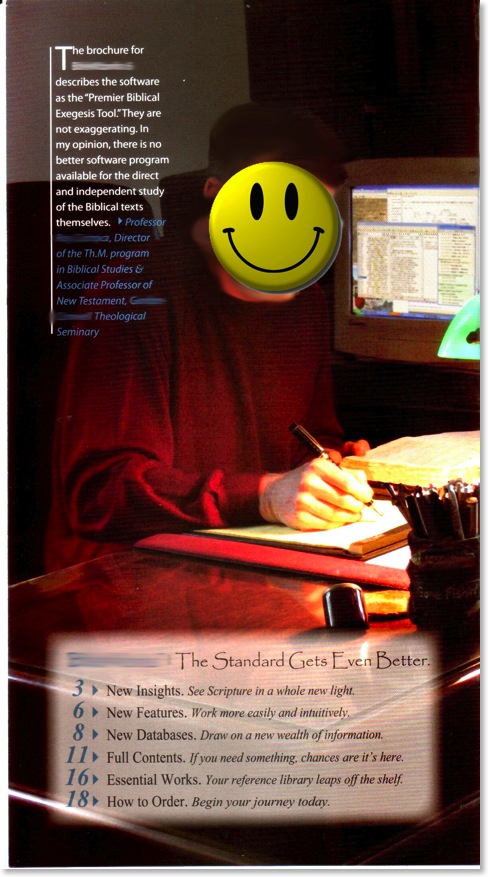
Before you read any further, think to yourself...What’s wrong with this picture (besides the smiley face and my other edits)?
If I were in charge of advertising Bible software, the above photograph is the exact opposite of what I’d want to represent in a brochure. Notice that the professor is concentrating not on [unnamed Windows Bible software], but instead he’s using a physical Bible and he’s taking notes on a legal pad--very old school, very non-Tech. Meanwhile, [unnamed Windows Bible software] is relegated--unfocused and at the moment, unused--to the background.
Now, I’m sure lots of people actually work this way. Sometimes I have a notepad handy when I work for quick notes or outlines, but I generally compose directly on the computer. And it’s not unusual for me to have a physical biblical text in front of me while I’m using Accordance. But that’s different. Why? Because this is an advertisement for software, for the love of Margaret! But the ad doesn’t focus on the software; it focuses on the way we studied before we had software!
Surely whatever Bible the professor in the picture is using would also be found in [unnamed Windows Bible software]. The brochure boasts 115 translations in 35 languages! And ten years ago when I used [unnamed Windows Bible software] before switching to the Mac and Accordance, I distinctly remember that the program had a very handy text editor included, so I’d toss the notepad for sure
I will say, however, that he’s sitting at a very attractive desk; and I certainly like the banker’s lamp...
Do We Still Remember Christian Martyrs?
So you can only imagine my surprise at what I heard in a New Testament Intro class I was teaching last night. As my students were giving group presentations, the student speaking made what was essentially an aside comment in reference to Stephen, the first Christian martyr,
“You might feel it’s odd to think of a Christian martyr. Usually we only hear of Islamic martyrs.”
Such a statement not only reveals a serious lack of knowledge of Christian history, but also a misunderstanding of the word martyr (I’m sorry, but if you take others with you, you’re not a martyr--you’re just a sycophantic coward).
So, I wonder just how widespread this misunderstanding would be in our culture today?
And how did we get to this point?
What of Renovaré?
Since the book has been so good, I thought I might pursue some of his other writings as well as some of his associates in the Renovaré movement. I read Richard Foster’s Celebration of Discipline in 1991 when it was required reading in a Spiritual Formations class, but because it was an assignment, and because there was no follow-up to what we read, it never really had life changing impact upon me. Certainly I’ve looked to that book and some of Foster’s other writings when I occasionally taught on a subject that touched on spiritual disciplines, but I’ve had very little interaction otherwise.
I also just read “A Life Formed in the Spirit,” an interview with Foster in the current (September) issue of Christianity Today. That’s the kind of interview that makes me hungry for more. [And I also hope one day to have a job that allows a cool ponytail like Richard Foster, although Kathy says she won’t allow it.]
So, readers of This Lamp, in all seriousness, what are your thoughts on Renovaré and the attached personalities? Has anyone ever been part of a Renovaré small group, and if so, what is your evaluation? Does anyone have the Renovaré Spiritual Formations Bible? When I look at the Renovaré website, there are so many resources, I wouldn’t even know a good place to jump in. What would you suggest?
I welcome your insights and thoughts.
TNIV Gatekeeper Profiles, Part 1
Note: There are still two winners who haven’t responded to my email that I sent a few days ago. If you haven’t responded please do so soon. If you didn’t receive my email, let me know as well.
Kevin Womack
Pastor, Fletcher Hills Presbyterian Church
El Cajon, California
I first discovered the TNIV right before the first New Testament edition was released. I was just finishing up my Master of Divinity degree at Bethel Seminary's San Diego campus. Dr. Mark Strauss, New Testament professor there, had done some work on the new translation and gave a few presentations about it to anyone who was interested. Since the TNIV's release had been surrounded by a bit of controversy (gender-neutral issues, singular "they" issues, even accusations of the use of "father/mother" God) I was interested in learning more about it from a scholar I knew and trusted.
Mark's presentation was convincing enough for me to start reading the TNIV alongside my long-trusted NIV. At first I would simply reference the TNIV's more accurate and understandable rendering of a passage during my teaching and preaching. But, it didn't take long for me to begin preparing my sermons and classes primarily from the TNIV. In my opinion, it's simply a better translation (how I wish that the translators would have gone with their original plan of releasing this as the revised NIV... think of the controversy that could have been avoided!).
I've found myself incredibly frustrated by the attacks that have been launched against this translation, mainly because the majority of those attacks are waged by folks who haven't even read the TNIV. If they had, they'd know that what they were saying wasn't true. I have been challenged by a few of the honest, academic critiques but still feel that the TNIV is the most accurate and accessible translation currently available.
When I first began to use the TNIV I served as an Associate Pastor at a Presbyterian Church in downtown San Diego. About five years ago I became the Senior Pastor of Fletcher Hills Presbyterian Church in East County San Diego. I preach 40 Sundays a year and teach another 20-30 times each year (not counting the regular smattering of devotions and other informal teaching occasions) and I use the TNIV for all of my teaching and preaching. Of course, I study a number of different translations as I prepare, but I always use the TNIV as the text I read and preach from in the pulpit.
Members and visitors to our church ask on a pretty regular basis which translation I'm using. For many, they're following along in the NIV and wonder if I'm just a poor reader (since I always seem to "miss" words as I read and add others when compared to their NIV texts!). Others are looking to purchase a new Bible and want to know what their pastor recommends. I always recommend the TNIV because I believe it is the most accurate of the more accessible translations currently available. If they're asking about what to buy their children, I recommend the same unless the child is earlier elementary age in which case I recommend the NIrV (another excellent translation).
I'm thankful to Zondervan for publishing this translation. I'm looking forward to seeing more editions of the TNIV that feature paper that's a bit thicker for folks like me who enjoy to highlight in their Bibles and take extensive notes. I'm very grateful for the free TNIV Reference Bible that will be sent to me. It will receive extensive use!
Dan Thompson
Pastor of an Assembly of God Church in Minneapolis, Minnesota.
I have pastored Assemblies of God churches for 20 years. We have used the TNIV as our primary text for about two years. We read from a common text every week and the TNIV is our translation of choice. I actually ran an experiment of sorts when I was deciding on which translation to use. I used the TNIV for a month, then another translation for a month. We have different readers each Sunday.
I noticed the TNIV went much smoother in public reading than the other translation. I have stayed with the TNIV since that time.
I was not a fan of the NIV, but after hearing Gordon Fee give his views of the translation process for the TNIV, I decided to look again. For one, I like the gender inclusive position it carefully takes. For another, the small passages that had needed work in the NIV did get work in the TNIV and the small differences were good to see.
I love the TNIV reference Bible because it is finally a "regular" Bible for "regular" guys like me who just want a basic leather Bible with plenty of room for notes. Okay, it doesn't have plenty of room for notes, but at least it's a decent size without funky colors. Thanks you Zondervan.
The new Bible with an even better cover would be well used for years to come. Thank you for the opportunity to win a free Bible that I guarantee will be well used. As proof, I will be willing to send photos of my new Bible's interior every few months to show how I am getting it marked up!
Feel free to interact with Kevin and Dan in the comments.
Other Posts:
Part 2
Part 3
THIS JUST IN: A Remaining Renaissance Fine Leather TNIV Reference Bible
That means that if you meet the criteria as outlined at the original post, this tenth copy could be yours. You’ll need to respond to THIS post, not the original.
Be quick.
Understanding Matthew 5:28 [updated]
Look up Matthew 5:28 in your own Bible before reading further. There’s a reason I’m not going to quote the verse yet either in my own translation or a Bible version. What I intend to demonstrate below is that some translations get this verse right and some do not--and the results may surprise many readers of This Lamp.

I try not to commit a deliberate sin. I recognize that I'm going to do it anyhow, because I'm human and I'm tempted. And Christ set some almost impossible standards for us. Christ said, “I tell you that anyone who looks on a woman with lust has in his heart already committed adultery.” ... I've looked on a lot of women with lust. I've committed adultery in my heart many times. This is something that God recognizes I will do--and I have done it--and God forgives me for it.
Note that Carter seemingly distinguishes between what he calls “deliberate sin” from this sin of adultery in his heart which he calls an “almost impossible standard.” Why is it an impossible standard? It’s difficult because fleeting thoughts pass through our minds, often without invitation. Whether these uninvited mental visitors are shunned or become welcomed guests is a separate but related matter. But what if I told you that Carter may have unnecessarily struggled with the belief that he was committing “adultery in his heart,” when he may not have been? What if many of us have struggled, confusing the temptation with the actual sin, simply because we were using a Bible with poor translation of this verse?
Understand in what follows, I am not advocating lessening what God calls sin in any degree. Rather, we need to be sure that we understand sin to be what it is and be careful not to add restrictions that the Bible never speaks of. And if we misunderstand sin because of translation of the text, then the translations need to be changed.
This was brought to my attention while reading the book (technically, I’m listening to the 18-hour unabridged audio version) The Divine Conspiracy by Dallas Willard. In part of the book (which I highly recommend in spite of an error I’ll explain in a moment), Willard offers a skillfully written exegesis of the Sermon on the Mount. He spends quite a bit of time on Matt 5:27-28 explaining the exact nature of Jesus’ words. On p. 165, Willard writes:
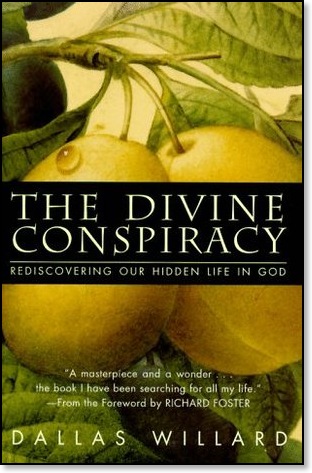
Therefore those translations of Matt 5:28 that say, “Everyone who looks at a woman and desires her,” or “everyone who looks at a woman with desire,” are terribly mistaken. They do much harm, especially to young people. For they totally change the meaning of the text and present “adultery in the heart” as something one cannot avoid, as something that just happens to people with no collusion of their will.
That on this reading to be tempted would be to sin should have been enough, by itself, to show that such translations are mistaken. No translation of scripture can be correct that contradicts the basic principles of biblical teaching as a whole.
The terminology of 5:28 is quite clear if we will but attend to it, and many translations do get it right. The Greek preposition pros and the dative case are used here. The wording refers to looking t a woman with the purpose of desiring her. That is, we desire to desire. We indulge and cultivate desiring because we enjoy fantasizing about sex with the one seen. Desiring sex is the purpose for which we are looking.
What Willard writes above makes sense on both a theological and practical level. However, in looking at the text itself, I had only one problem: I couldn’t find πρός/pros with a dative in Matt 5:28--
ἐγὼ δὲ λέγω ὑμῖν ὅτι πᾶς ὁ βλέπων γυναῖκα πρὸς τὸ ἐπιθυμῆσαι αὐτὴν ἤδη ἐμοίχευσεν αὐτὴν ἐν τῇ καρδίᾳ αὐτοῦ.
The Greek word πρός/pros is a preposition initially defined in the BDAG lexicon as “expressing direction ‘on the side of’, ‘in the direction of’: w. gen. ‘from’, dat. ‘at’, or acc. (the most freq. usage in our lit.) ‘to.’” In Matt 5:28 πρός/pros relates to ἐπιθυμέω/epithumeo (translated as lust or sexual desire or simply desire in English translations). But, contrary to Willard, ἐπιθυμέω/epithumeo is not a dative. In fact, it’s an infinitive in the aorist tense. At the end of the verse, there’s a dative--καρδίᾳ/kardia (heart)--but no amount of creative sentence diagramming is going to relate πρός/pros to καρδίᾳ/kardia.
I emailed two folks about this issue: Wayne Leman, Bible translator extraordinaire and my original Greek teacher from 1992, Darrell Pursiful. I asked them both if I was simply missing something that was staring me in the face. But they confirmed what seems abundantly clear simply by looking at the text: πρός/pros is not with a dative in Matt 5:28. So is Willard simply wrong in regard to his whole argument, especially with what he said in the second paragraph I quoted above?
Well, by the time I emailed Darrell Pursiful, I had already confirmed Willard’s basic thesis in a couple of other sources, and Darrell affirmed what I had found.
My first hunch had simply been to look at commentaries on Matthew. But in the brief survey of five or six volumes, including some fairly technical resources such as the ICC and Word series, none really touched directly upon this issue. Looking in Accordance, I pulled up The New Linguistic and Exegetical Key to the Greek New Testament. Here it was mentioned in reference to this verse that πρός/pros with the infinitive often expresses purpose.
I hit the Greek grammars, but did not find anything specific to this issue in Wallace or even basic grammars like Mounce. However, I did find what I was looking for in A. T. Robertson’s big grammar (once again proving that this grammar has never fully been “replaced” by any newer work). On p. 1003, Robertson writes, “In Mt. 5:28, πρὸς τὸ ἐπιθυμῆσαι, either purpose or result is possible.” And on p. 1075, Robertson writes that the idiom πρὸς τό “was used by the ancients in much the same sense as εἰς τό and ἐπὶ τῷ, ‘looking to,’with a view to.’”
Darrell also pointed me to Robert Guelich’s book on the Sermon on the Mount, which although I had on my shelf, I had failed to look at when searching commentaries. Sure enough, Guelich writes on pp. 193-194:
The phrase τὸ ἐπιθυμῆσαι αὐτὴν means literally “in order to desire having her (sexually).” The same very to desire to have (ἐπιθυμέω ) appears in the tenth commandment for “to covet” (Exo 20:17, LXX, and Deut 5:21, LXX). “To lust” in English connotes accurately the sensual overtones but lacks the accompanying thought of possession inherent in ἐπιθυμῆσαι.
So, what this comes down to is that Willard’s basic point is right even if he messed up his argument from the original languages. I can give him the benefit of the doubt that perhaps he may have simply had a brief mental lapse and it wasn’t caught at time of publication. I have a print copy of the book as well which contains the same error (I reproduced his argument above using it), but I don’t know if more recent printings have corrected the mistake.
What this means on a practical level is that Jesus never said “looking at a woman with lust” was sinful, but rather “looking at a woman TO lust” or “looking at a woman FOR THE PURPOSE of lust” is equivalent to adultery in the heart. That is, the actual sin is found in looking at a woman with express purpose to lust after her or even possess her as Guelich points out. Jimmy Carter, myself, and perhaps even you have stressed over the passing thoughts, the temptations, thinking we had sinned when this was not the case. Certainly entertaining those thoughts, that second and perhaps third glance invited sin, but not the initial look and thought that goes through our minds. We always have the option of quickly looking away (or simply changing our Yahoo profile).
So here’s where it gets interesting: which translations get it right and which ones get it wrong?
I’m not going to even quote the ones that get it wrong. You can look them up for yourself, but here they are: TEV/GNT, REB, NRSV, CEV, NASB (1995 edition), NLT1, and NLTse.
The wording in the RSV, NIV, NJB, Message, and TNIV draws a middle ground (some form of “look lustfully” ), but are still not as explicit in regard to purpose and intent as the translations below which better reflect the meaning of Jesus’ words.
Here are the translations that more accurately render the purposeful intent in Jesus’ words:
“ego autem dico vobis quoniam omnis qui viderit mulierem ad concupiscendum eam iam moechatus est eam in corde suo” (Vulgate)
“But I say unto you, That whosoever looketh on a woman to lust after her hath committed adultery with her already in his heart.” (KJV)
"Pero yo os digo que cualquiera que mira a una mujer para codiciarla, ya adulteró con ella en su corazón." (Reina-Valera)
“but I say to you, that everyone who looks on a woman to lust for her has committed adultery with her already in his heart.” (NASB, 1971 edition)
“But I say to you that whoever looks at a woman to lust for her has already committed adultery with her in his heart.” (NKJV)
“But I say to you that everyone who looks at a woman with lustful intent has already committed adultery with her in his heart.” (ESV)
“But I tell you, everyone who looks at a woman to lust for her has already committed adultery with her in his heart.” (HCSB)
“But I say to you that whoever looks at a woman to desire her has already committed adultery with her in his heart.” (NET)
Sources referenced:
Danker, Fredrick William, William Arndt, Walter Bauer, and F. W. Gingrich. A Greek-English Lexicon of the New Testament and Other Early Christian Literature. Chicago: University Of Chicago Press, 2000. [Accordance edition used]
Guelich, Robert. The Sermon on the Mount: A Foundation for Understanding. Dallas: Word Publishing, 1982.
Robertson, A. T. A Grammar of the Greek New Testament in the Light of Historical Research. Nashville: Broadman Press, 1934. [Accordance edition used]
Rogers Jr., Cleon L., and Cleon L. Rogers III. The New Linguistic and Exegetical Key to the Greek New Testament. Grand Rapids: Zondervan, 1998. [Accordance edition used]
Willard, Dallas. The Divine Conspiracy: Rediscovering Our Hidden Life in God. San Francisco: HarperCollins, 1998.
Feel free to offer your thoughts in the comments (just not your lustful thoughts).
The Return of the Disciple's Study Bible, Now in HCSB
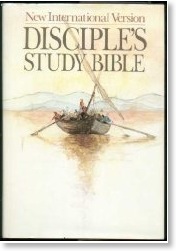
The Disciple’s Study Bible was a project from Holman Bible Publishers two decades ago that took the NIV text and added study notes based around a core set of doctrines. Although there was enough content in the Disciple’s Study Bible to make it a self-contained resource on its own, the real value of it could be found when using it in conjunction with the accompanying workbook and leader’s guide. The workbook itself had 65 individual lessons for use in private or group settings.
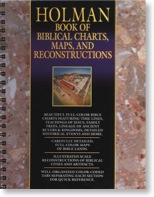
After seeing the Bible on eBay, I looked on Amazon to only confirm that the Disciple’s Study Bible is now out of print. I wasn’t overly surprised to learn this as I had not seen it on store shelves for quite some time. It is still available used on Amazon ranging in asking price from $35 to $250 according to the edition.
I pulled my copy of the Disciple’s Study Bible off the shelf along with the workbook and flipped through both. Honestly, it’s been years since I looked through either, but as I surveyed the content, I thought to myself that it would be very useful in a church discipleship context. And then it struck me that the Disciple’s Study Bible would be a perfect fit for Lifeway’s in-house translation, the Holman Christian Standard Bible. This would mean that B&H could produce the Bible without having to pay licensing fees to another company as had been done when it was based on the NIV.
So I shot off a message to B&H Publishing customer service and suggested that the Disciple’s Study Bible be retooled for the HCSB. Evidently great minds think alike because I got a response back this morning letting me know that there are indeed plans to re-publish the Disciple’s Study Bible in the HCSB, and it is slated to be released late in 2009.
Since there is a revision to the HCSB slated for 2009, I would assume that the new edition of the Disciple’s Study Bible will contain the newest text.
Kathy's Ode to the NLT
Sunday, while we were at church, our pastor was preaching from Amos in the NIV, but the words of Scripture on the screen behind him were in the NLT. Kathy saw this as possibly divine interference because she thinks everyone should read from the NLT. She kept nudging me asking, “Why doesn’t he just use the NLT? It’s much easier to understand!” I mumbled something about “1 Corinthians 14:34,” but she just elbowed me even harder.
Don’t tell our pastor, but inspired by the disjunction between speech and screen, Kathy immediately set to writing a little ditty expressing her feelings about the New Living Translation.
You can read it over at her blog (yes, she has one, too) in the post “Ode to the NLT.”
Lizards & Spiders & Targums, Oh My! [UPDATED]
It’s true-- check it out. Every major translation other than the KJV and NKJV contains lizard instead of spider:
Proverbs 30:28 |
|
| KJV | The spider taketh hold with her hands, and is in kings’ palaces. |
| NKJV | The spider* skillfully grasps with its hands, *Or lizard |
| RV/ASV | The lizard taketh hold with her hands, Yet is she in kings’ palaces. |
| RSV/ESV | the lizard you can take in your hands, yet it is in kings’ palaces. |
| NASB | The lizard you may grasp with the hands, Yet it is in kings’ palaces. |
| NIV/TNIV | a lizard can be caught with the hand, yet it is found in kings’ palaces. |
| JPS | You can catch the lizard in your hand, Yet it is found in royal palaces. |
| NRSV | the lizard* can be grasped in the hand, *Or spider |
| NLT | Lizards—they are easy to catch, but they are found even in kings’ palaces. |
| HCSB | a lizard* can be caught in your hands, *Or spider |
| NET | a lizard you can catch with the hand, but it gets into the palaces of the king. |
| NETS | and the lizard, though dependent on its hands and being easily caught, it lives in the king’s fortresses. |
So, of course I turned to Accordance. I opened up both the NASB and BHS Hebrew Bible modules side by side because I knew that I didn't know the Hebrew word for spider/lizard off the top of my head and the NASB has Hebrew tagging. After determining שׂממית/semamit was the word in question, I triple clicked on it to open the Hebrew and Aramaic Lexicon of the Old Testament (HALOT).

To double-check, I switched over to Brown-Drivers-Briggs Hebrew lexicon. It's still a lizard of some kind. Definitely not a spider.
So where in the world did the King James translators get "spider"?
I've come to the point in the last couple of years that when I want a quick answer to questions like that, I simply turn first to the NET Bible notes. Sure, commentaries are great for more in depth information, but the NET Bible notes have the answer in a nutshell--usually. I mean, normally there's an answer for everything in those 60K+ notes.
Sure enough, the NET Bible seemed to have it covered:
"The KJV, agreeing with Tg. Prov 30:28, translated this term as ‘spider.’ But almost all modern English versions and commentators, following the Greek and the Latin versions, have ‘lizard.’”
Okay, so this made a good bit of sense to me. The KJV Old Testament translators had a reputation for being very familiar with Jewish literature. Perhaps even the meaning of שׂממית was in question, and they turned to the Targums for answers.
For the curious, here is Prov 30:28 in the LXX and Latin as referred to in the NET Bible Note:
| LXX | καὶ καλαβώτης χερσὶν ἐρειδόμενος καὶ εὐάλωτος ὢν κατοικεῖ ἐν ὀχυρώμασιν βασιλέως |
| VULGATE | stilio manibus nititur et moratur in aedibus regis |
As expected, both the LXX and the Vulgate refer to a lizard (or a spotted lizard, or a gecko).
Now, I’ve got the Targums in Accordance as well, but I’ve never really used them much. In fact, I discovered in trying to look up Proverbs 30:28 that I didn’t even have the newest release. After installing the updated set of modules, I was able to look up the passage.
There is indeed a different word here, אקמת/’qmt. I couldn’t find the word in either Hebrew Lexicon, and it does not seem to be similar to the Hebrew word for spider (עכביש/‘akkavish). However, if I understand the nature of the Targums correctly, Proverbs was actually copied from the Syriac Peshitta. So, this really isn’t even Hebrew/Aramaic, but rather Syriac. And thus, this is really outside my language skills. Further, I don’t have an English translation of the Targum for Prov 30:28. However, the English gloss in Accordance for אקמת/’qmt is lizard.
Regardless I would be interested in further information. Perhaps Iyov (if you’re back from your travels) or John Hobbins might offer some insight.
UPDATE: As expected, Iyov provided helpful information in the comments:

I would find it a bit remarkable if the KJV used the Targums -- I do not believe they were expert in Aramaic, and Targum to Proverbs is a bit obscure even today.”
So it seems to me--at this point--that it may indeed be the NET Bible notes that are in error. The source for “spider” in the KJV & NKJV seems to be the medieval commentator Rashi, not the Targum on Prov 30:28, which according to the English gloss in Accordance, also uses a word for lizard, not spider.
Olive Tree Comes to the iPhone: Finally the Promise of a Decent Bible App
Well, wait... there was still my iPod, obtained in 2002. Although I didn’t carry it with me everywhere as I had done with the cell phone and PDA, it was still handy for listening to audio books, the Mars Hill Audio Journal, and occasionally some music. But it was always something else to keep up with.
Then in 2007, my electronic gadget world converged one more time with the iPhone. Now I had a PDA, cell phone and iPod all in one device. But two things were missing on the iPhone that I had used quite extensively on previous Palm PDAs, including my Treo: Pocket Quicken and Bible software from Olive Tree.
Intuit now has an online version of Quicken that works with the iPhone, but I’m not yet sold on the idea of placing all my financial data into “the cloud.” Originally Apple was not going to open the iPhone to 3rd party applications, insisting that all such endeavors were to be handled through Web 2.0 internet apps. Regarding Bible applications, there were initially some halfway decent web apps, but they had two drawbacks: (1) they were all dependent upon internet connectivity to work, and (2) there was no real support for original language texts.
With the advent of iPhone 2.0 software last month, we were finally able to obtain true third party applications on our iPhones. But as I had previously written, I had been enormously underwhelmed by initial offerings because they were either lackluster or required internet connectivity to function.
Yesterday, Olive Tree launched its first offerings for the iPhone: its BibleReader and ESV Study Bundle for Bible Reader.
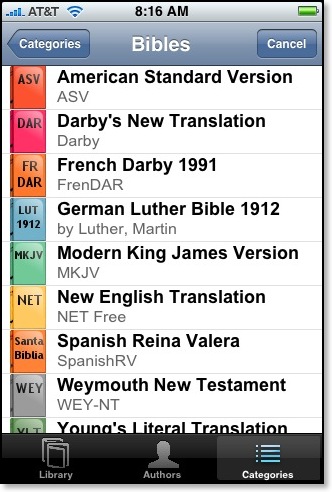
- American Standard Version
- Darby’s New Translation
- French Darby 1991
- German Luther Bible 1912
- Modern King James Version
- New English Translation (without notes)
- Spanish Reina Valera
- Weymouth New Testament
- Young’s Literal Translation
None of the texts in the free edition are formatted yet (image below on left), but as this screenshot taken iTunes (image below on right) shows, the ESV text is formatted:
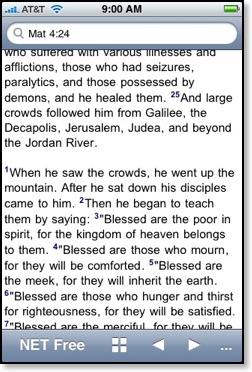
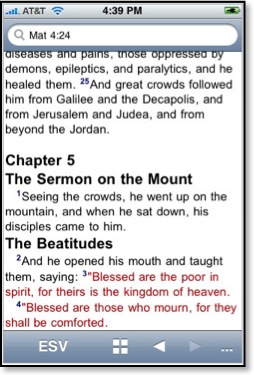
I’m not sure yet if the red lettering can be turned off. The ability to turn off red lettering will come in a later update.
The search dialogue at the top of the screen can be used for either direct reference input or word searches. It also automatically updates as the user scrolls through the biblical text. A search for “righteousness” yields 134 hits in the NET Bible as seen below:

Touching any of the underlined references takes the user to the verse in context of the entire passage. Pressing the icon at the bottom of the screen (is that a window or a plus sign?) brings up a listing of all books available in that particular Bible module:
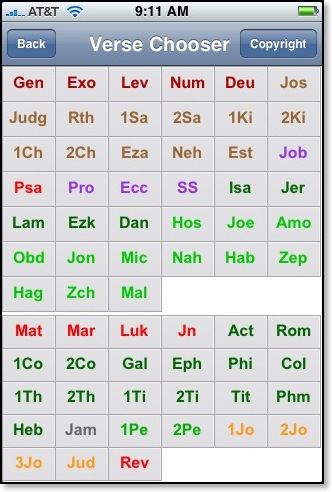
Clicking on any of the biblical books leads to another screen (not pictured) that lists all chapters in the biblical book and then to another screen with all verses. Selecting a particular verse will not display the verse by itself but the entire passage in context which is very helpful.
The most beneficial aspect of Olive Tree’s BibleReader is easily that it does not rely on an internet connection to use any of the biblical modules. All texts are fully loaded onto the iPhone. I especially appreciate that because I still find myself without any signal from AT&T at times when I am deep into the heart of a building--especially older buildings. At this point, I’m not worried about space limitations. iPhones now come in either 8 or 16 GB models, so for most users there should be room to spare. This is in contrast to my old Treo 600, of course, with which I had to use an extra SIM card in order to store all 60,000 notes of the NET Bible.
The interface for Olive Tree’s BibleReader is completely customizable as seen in this settings screenshot:
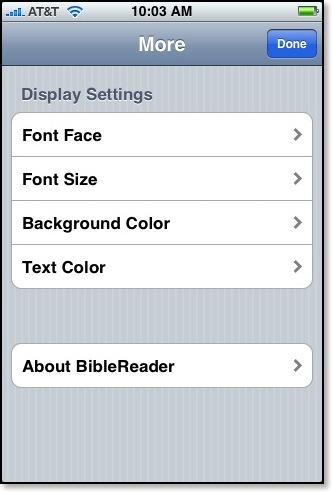
In fact, until I installed BibleReader, I had no idea what fonts were available on my iPhone:
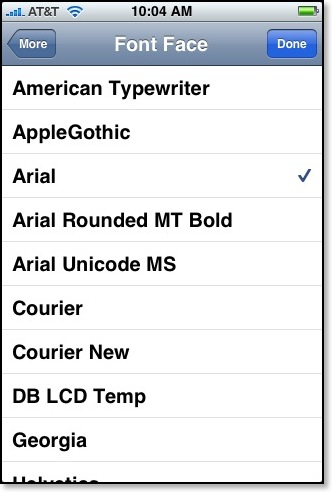
[In addition to the fonts listed in the graphic above, BibleReader also tells me I have the following typefaces installed on my iPhone: Helvetica, Helvetica Neue, Hiragino Kaku Gothic ProN W3, Hiragino Kaku Gothic ProN W6, Marker Felt,
STHeiti J, STHeiti K, STHeiti SC, STHeiti TC, Times New Roman, Trebuchet MS, and Verdana.]
I noted in the title of this blog entry that Olive Tree’s BibleReader was the first third-party iPhone Bible app with real promise. I say that because not all of their extensive language offerings are available yet, including their Greek and Hebrew texts. But I corresponded with Stephen Johnson of Olive Tree yesterday, and he assures me they are in the works along with many of the other modules in Olive Tree’s library.
Certain features that we’ve come to expect from Olive Tree, such as split screens, aren’t available yet, but features will be added to BibleReader over the next few months.
Users such as myself who had already purchased Olive Tree texts may face a bit of a conundrum. In the past if a customer had bought a module for the Palm platform and then switched to the WindowsMobile platform (or vice-versa), it wasn’t necessary to re-purchase the texts. For instance, a few years back I briefly owned a Compaq iPaq and was able to load modules such as the Greek New Testament with Gramcord morphology onto the Compaq device even though I had previously purchased it for the Palm platform. After a few weeks, I decided connecting to a WindowsMobile (I believe it was called WindowsCE back then) device from a Mac was too much hassle and switched back to a Palm PDA. In all of this switching back and forth, I never had to pay anything extra to OliveTree. I’ve always found their cross-platofrm policy to be very generous.
However, with the iPhone, the issue is a bit more complex and the problem doesn’t lie with Olive Tree, but with the iTunes Store. Apple doesn’t allow third-party iPhone developers to sell their applications from their own websites. It has to be done from the iTunes Store. So, for instance, if a user has already purchased the ESV text for a Palm or WindowsMobile device from Olive Tree, there’s no way at present to keep from paying for it again if purchased for the iPhone. Olive Tree is in talks with Apple to determine if there’s a way around this, but for right now if an ESV aficionado already bought it for another platform and now wants to install it on the iPhone, he or she will have to pony up another $24.99.
And there is another problem for Olive Tree and their customers. Olive Tree’s modular model of distributing texts doesn’t work as well with the iTunes Store. In the past on the Palm or WindowsMobile platforms, once the BibleReader software was installed as many text modules could be added as their was room available in the device’s memory. Currently, the iTunes Store doesn’t allow this adding of one text at a time as the previous model allowed--at least not without having many separate apps installed on the iPhone. So, if for instance, Olive Tree releases the TNIV text next week, a user couldn’t simply add it to an already-purchased ESV Study Bundle. Rather, two separate installations of BibleReader would have to be installed with the TNIV in one and the ESV and accompanying resources in the other. And theoretically, even once split screen features are implemented, modules in two separate installations couldn’t be viewed side by side.
This complication is not something that just affects Olive Tree, but rather all developers who offer modular add ons to its software. Again, Olive Tree is in talks with Apple, and hopefully the way iTunes is currently set up can be adjusted for the benefit of the customer in the future.
Regardless of these early snags, Olive Tree’s venture into the iPhone platform looks very promising. I am hopeful I can eventually reproduce the same functionality with Bible texts on my iPhone that I had previously experienced on my Treo. Since useful iPhone Bible functionality is something I am genuinely seeking, expect to see more on This Lamp about the subject as new developments arise.
For further information:
Olive Tree’s iPhone Page
Olive Tree’s Blog
Don't Be a Poser
“Beware of practicing your righteousness before other people in order to be seen by them, for then you will have no reward from your Father who is in heaven.” (Matt 6:1, ESV)
I take the above command from Jesus’ Sermon on the Mount very seriously. There’s a balance, right? --between absolutely hiding one’s faith and on the other hand simply making a show of it.
For the last three years, my friend JT and I have met each other for breakfast and conversation on Thursday mornings. JT’s a sharp guy who as a chemical engineer (he can correct that designation if it’s wrong) rose to an executive status in a national corporation. JT is exactly the kind of guy I want to think is represented all around our nation’s workforce. He’s a Christian who takes his faith seriously, who sees the world from a biblical perspective and makes decisions from an ethical point of view. JT is well-read in literature, loves history and philosophy and has a desire to go beyond Sunday School-level faith.
As I mentioned, JT and I have been meeting almost every week for at least the last three years. Sometimes we merely have conversation. Sometimes we study the Scriptures. We’ve read a few books together and discussed them over breakfast. The first book we ever read together set the stage for our breakfasts, Love Your God with All Your Mind by J. P. Moreland and Dallas Willard. In fact, the review of this book here on This Lamp was written by JT. Although I consider myself more of a “biblical studies” kind of guy, JT wanted to have a better grasp on doctrine, so we spent well over a year reading through a systematic theology. We read through Bonhoeffer’s Cost of Discipleship together. You get the idea.
When we meet, we have our discussions, but we’re not showy about it. We may have our Bibles out, but we don’t go into long and loud prayer sessions like I see some Christians do when they meet in public. We often trade prayer concerns, but we realize that our meeting is not the only opportunity we will have that week to pray.
A while back when the first edition of the NET Bible was released, I gave JT my “2nd Beta edition” which he has now adopted as his primary Bible. Like most of us, he loves the detail of the notes. Yesterday when we met, he had his copy of the NET Bible on the table. My copy of the TNIV Reference Bible and my Greek NT were still in my book bag. We briefly discussed the content of a recent Sunday School lesson. JT and I don’t go to the same church, but our churches use the same curriculum, so we often compare notes from our studies.
As we were talking yesterday at a cafe in Louisville, a fellow--probably in his late twenties or early thirties--sat down at the table next to ours facing us, or really just facing me. Now, I have this Jason Bourne-spy-style habit of watching others in the room out of my peripheral vision. I can’t help it, but if anyone every whips out a submachine gun, I’ll be the first one ducking.
I could tell immediately that the guy at the next table was a poser. He sat with his back to the entrance (proving he wasn’t a super spy like me and Jason Bourne because we’d never sit with our backs to the door), mainly--I believe--so that he could face us, obviously having seen JT’s NET Bible on the table. He pulled from his book bag a Dell laptop, headphones, and an ESV Bible. How do I know it was an ESV Bible? Well, it was one of the hardback editions with the black and white cover that have “ESV” in large letters on the front. He attempted to subtly push the Bible across the table toward us so that from my perspective, I could see the letters facing us and know he had a Bible just as we did.
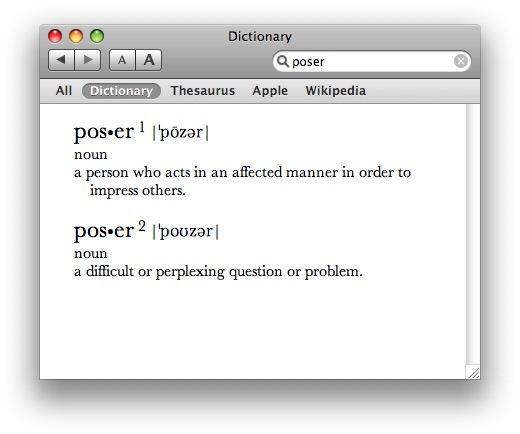
Now, this is a pet peeve of mine. As a Christian, it really bothers me that there’s this cultural perception that someone cannot be studying the Bible outside the walls of the church unless he or she is being forced to (I’ve written about this before, but I don’t feel up to searching through 700 posts to find the link). Whatever happened to Christians being known as “people of the book”? Yes, technically I’m a seminary student because I’ve gone back to school to finish my last degree. But there’s more to my life than that. I don’t identify myself as a student anymore. Plus JT isn’t a seminary student. But you know, I’ve had the same question asked of me before when I wasn’t in school at all simply because I might be out in public and had a Bible on the table.
I know I started this post off by saying we shouldn’t practice our righteousness for the sake of getting noticed by others. But I also said there needed to be balance. When it comes down to it, this is a poor reflection on the church. We’ve gone from not practicing our righteousness to get noticed to simply cloistering ourselves up in the safety of the church where it’s “normal” to study the Bible together.
So anyway, to show off his presumed superiority, the fellow at the next table confidently said, “Yes, I graduated from the seminary four years ago.” Now there was a big part of me that wanted to say, “Yeah, buddy, and I got that same degree you’re so proud of way back in 1994, so there!” --but I refrained. Instead I merely smiled, not wishing to add to the conversation. But our friend was determined to size us up. He asked what church we went to. In this town assumptions about one’s ethics and theology are often determined by the church attended. However, JT and I both live outside Louisville in two separate towns, so this fellow could only be left to his own speculations.
JT and I conversed for another thirty minutes before it was time for us to leave. During that time, seeing that we weren’t going to pick his brain for wisdom about post-seminary life, the fellow at the other table had put on his head phones and given his attention to his Dell laptop. His Bible had never moved from the conspicuous spot where it had first been laid.
But as JT and I were gathering our things, preparing to leave, I spotted this other fellow slowly moving his Bible from the other edge of the table to the spot directly between him and his laptop. He casually opened it somewhere in the middle. Just so happened he had been studying 2 Chronicles, perhaps? Obviously, since we had not been paying attention to him for the last half hour, it was important to him that it appeared as if had been deep in the study of the Scriptures this whole time. I mean, isn’t that what seminary graduates four years out are supposed to do? No one is making him do it anymore, are they?
Now, you may think that I’m being harsh--that perhaps I’m not following the other parts of the Sermon on the Mount, especially those words from Matt 7:1-2.
So, as we passed him, he looked up from his Bible, headphones still on, Dell laptop still open and he smiled at us in acknowledgement. I nodded, but instead of turning right to head to the door, I said to JT, “I’m going to refill my drink,” and I went left. Coming back, unbeknownst to the guy at the table because he’s not Jason Bourne and he now had his back to me, I walked directly behind him and had a full view of his laptop screen.
YouTube. He was watching YouTube videos, hence the earphones.
See, I told you he was a poser.
Look, in that same Sermon on the Mount in which Jesus told us not to practice our righteousness before others so as to be noticed by them, he also said to “let your light shine before others, that they may see your good deeds and glorify your Father in heaven (Matt 5:16, TNIV). Is this a contradiction? Not at all.
Practicing our righteousness in a way that glorifies God goes way beyond having a Bible on the table in public. It’s more than giving thanks before a meal in public and then trying to subtly look around to see who saw you do it (I’ve seen that one a lot). Practicing one’s righteousness is found in how we speak to others, how we view others as not less than ourselves, how we treat others, how we respond when we’ve been wronged, how we... well, read the Sermon on the Mount for yourself.
And don’t be a poser!
NLT Study Bible: Hands-On Review [UPDATED]
“But my child, let me give you some further advice: Be careful, for the publishing of new study Bibles is endless, and carrying more than one in your book bag wears you out”
(modified from Ecclesiastes 12:12, NLT).
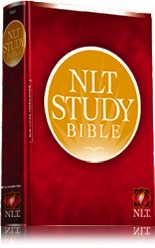
I received the Genesis sampler of the NLT Study Bible (NLTSB from this point forward) a few weeks ago. I literally read every word of it (the same as I had done to the Life Application Bible Gospel of
Mark in the Living Bible way back in the late eighties!) to get a feel for the direction this new study Bible takes. Since last Friday, upon receiving an advance copy of the entire Bible in the mail, I have spent a good bit of time reviewing the full product as well. At this point I can readily suggest that the NLTSB really does bring something new to the already crowded study Bible table.
The NLTSB contains lots of great features that I’m not going to spend a whole lot of time discussing since a number of other reviews are starting to show up on the web that do a fine job covering these. You can “Tour the Features” on the NLTSB website. Also, you can see a list of the contributors at the website as well--a veritable “who’s who” of Evangelical scholarship, but one that represents mainstream thought and offers a variety of perspective within certain boundaries.
IN KEEPING WITH WHAT HAS GONE BEFORE. I have no doubt that study Bibles are big business. And it seems to me that a translation has reached a certain level of acceptance when it begins to show up on shelves in study Bible forms. Study Bibles come with different approaches. There are study Bibles written from the viewpoint of an individual (Scofield, Ryrie, Dakes, MacArthur). Recently there has been a trend for study Bibles to come wrapped around a particular subject (apologetics, archaeology, literary features) or even specific theological perspectives. These two categories are fine if a reader really like the viewpoint of a particular individual or if the reader has interests in a particular subject and wants to discover how that subject relates to Scripture. But for me, I’ve always felt a bit more comfort in study Bibles that offer information of a more general nature and ones that have the perspective of not one particular writer or theological viewpoint, but from from the work of many individuals. In the last two decades, the NIV Study Bible has reigned supreme in this realm as a kind of standard that most study Bibles most often get compared to. The NIV Study Bible has even been adapted to three other translations: the KJV, NASB, and TNIV. Other committee-produced study Bibles in this kind of category include the New Oxford Annotated Study Bible, the Life Application Study Bible (also adapted to numerous translations) and the Jewish Study Bible, to name a few.
2008 sees two new study Bibles in the multiple-contributor category, and that is the NLT Study Bible, the subject of this review as well as the forthcoming ESV Study Bible. And in addition to the kind of standard (at least for Evangelical circles) set by a work like the NIV Study Bible, I would suggest that although it may not be at first apparent, there is another study Bible that is influential upon the NLT Study Bible. I’m referring to the NET Bible with its 60K+ notes. Although as of yet, not widely accepted, he NET Bible raised the bar in a number of ways for study Bibles, and in my opinion its influence is seen in at least three areas in the NLTSB.
The first is the NLTSB’s greater interaction with the original languages. It’s not uncommon to see transliteration of Greek and Hebrew words in the NLTSB’s study notes, even transliterated words beyond those defined in the NLTSB’s brief word study dictionary (more about that to come). Any reader familiar with the NET Bible knows that original language words are regularly incorporated into the notes both in their Greek and Hebrew form as well as a transliteration. The NLTSB offers only transliteration, but this probably suffices for the majority of its target market.
Second, like the NET Bible [print version], the NLTSB intermixes textual notes of the translation with its other notes. This is actually my largest criticism for the NLTSB. The NET Bible can get away with intermixing its textual notes because ALL of the notes came from the translation committee. Reading the NET Bible’s notes is like sitting in on an extended translator’s meeting. As with any translation, I’m very much interested in the footnotes added to the NLT text by the translators as a completely different level of authority and importance from the commentary of the study Bible itself. So the fact that the new 2007 edition of the NLT has a footnote in Gen 10:15 for “Hittites,” reading “Hebrew ancestor of Heth” is totally lost on me because I can’t distinguish it from the rest of the study notes. Even though the study notes in the NLTSB offer an explanation of the footnote, I have no indication that the original footnote itself is from the translation committee. There’s not even an indicator within the text itself that the word “Hittites” required clarification by the translators. If there was one major feature I’d recommend changing in the NLTSB in subsequent printings, it would be to separate the translator’s notes from the commentary.
Another influence of the standard set by the NET Bible: while the number of notes are at a greater number than some study BIbles (the NLTSB boasts 25,900 vs. the NIV Study BIble’s 25,000), these notes in the NLTSB are shorter and more to the point.
But what kind of notes are these? A few weeks back, I asked Tyndale if the study notes in the NLTSB were merely a condensation of Tyndale’s Cornerstone Biblical Commentary series which is also based on the NLT. I was told that it is not, and in fact the study notes in the NLTSB are entirely new, written specifically for the NLTSB (plus, the Cornerstone series is not complete yet).
SO WHAT’S DIFFERENT HERE? One of the promotional charts for the NLTSB compares the approach of it to other popular study Bibles. This is marketing copy, of course, so its value to you will vary, but the various study Bible approaches described this way:
“Using the NLT Study Bible is like being led through Scripture by a caring Bible teacher.”
“Using the NIV Study Bible is like being led through Scripture by a historian.”
“Using the Archaeological Study Bible is like being led through Scripture by an archaeologist.”
“Using the MacArthur Study Bible is like being led through Scripture by a theologian.”
Now, some may argue with any of those explanations on a variety of fronts, but the one major-selling study Bible I saw missing from this list was Tyndale’s own Life Application Study Bible. So I asked Tyndale how the two Bibles differed. I was told that “The Life Application Bible is like being led through Scripture in a discipleship program or by an application-oriented exegete.”
Okay, so the NLTSB is different because, to quote Sean Harrison from the NLTSB Blog,
“Basically, the NLT Study Bible focuses on the meaning and message of the text as understood in and through the original historical context. I don’t see other study Bibles focusing so fully on that. Some study Bibles focus on helping people to accept a particular doctrinal system, while others focus on “personal application.” Others simply provide interesting details about the context, language, grammar, etc., without asking how that information will impact people’s understanding of the text. Still others focus on a particular type of study methodology—topical study, word study, etc. Our goal, by contrast, was to provide everything we could that would help the readers understand the Scripture text more fully as the original human authors and readers themselves would have understood it.“
Of course these kind of descriptions can often overlap. I can see the difference from the Life Application Study Bible, but is the NLTSB all that different in approach from the NIV Study Bible (and its cousins)? Well, you will have to decide for yourself, but I do think it does a few things better, and I will describe those below.
And on a related note, in spite of distinguishing the NLTSB from the Life Application Bible, some notes such as the one discovered by blogger David Ker would make one wonder if there’s not an overly homiletical interest in some of the notes. So, maybe there actually is here and there, but they aren’t necessarily the norm. In fact, as I pointed out in the comments to David’s blog, if you turn to the notes at the other end of the Bible in a book like Revelation, I don’t see any of these kind of preachy statements such as in the last sentence of David’s example. In fact, to quote myself, “[the notes in Revelation] tend to stay with the text, illuminating yes, but not falling into homiletical application. The notes on Revelation also refreshingly tend to avoid any overt connections with interpretational schemes.” The Revelation notes, by the way, were written by Gerald Borchert.
Since the study notes for different biblical books were written by different writers, there may be some consistency issues, but David’s example does not seem to be the norm.
Really, there’s not going to be an unexpected twist to my review. I believe the NLTSB is a solid product. Having said that, however, there are a number of areas in which I believe the NLTSB does things exceptionally well. These are described below.
INTRODUCTIONS WITH SUBSTANCE. Anyone familiar with study Bibles expects to read a one to two page introduction before each biblical book. Included in that introduction are the obligatory sections of author, time of writing, type of literature and an outline. This is where the NLTSB goes above and beyond. Before one ever comes to the introduction to Genesis, the reader will find a four-page, three-column introduction to the Old Testament as a whole. Following that is a four-page essay and table on archaeological sources for Old Testament background. Then the reader finds a separate three-page, three-column introduction to the Pentateuch. Only then will the reader find the expected introduction to the book of Genesis. Thus the NLTSB begins to approach the state of not only functioning as a study Bible but an introduction to the Bible as well.
Of course since study Bibles are usually aimed at a more mainstream audience, I’m always interested to see how such resources handle discussions such as authorship. It doesn’t surprise me for an Evangelical resource such as the NLTSB to reject Wellhausen’s Documentary Hypothesis (my own study and convictions reject it as well). However, I remember being gravely disappointed that in the original 1985 NIV Study Bible that this major theory of Pentateuchal origins could be so easily dismissed in one short sentence. Taking a much different approach, I was pleased to see that in the NLTSB, the issue is not so easily swept under the rug. Although the Documentary Hypothesis is rejected, it is rejected with seven paragraphs of explanation as to why.
On the other hand, Evangelicals always seem more comfortable (for the most part) with source criticism in the New Testament. So, for instance, in the introduction to the Gospels (which is one of four articles before ever reaching the introduction to Matthew), Markan priority for the Synoptics is accepted as probable and credence is also given to the Q source:
“There are also 250 verses of Jesus’ sayings that are shared by Matthew and Luke but not found in Mark, so most scholars believe that they both used a common source, perhaps oral, referred to as Q (from German Quelle, meaning ‘source’ ).”
Some may be interested to know that there is also a separate introduction to Paul’s pastoral epistles in addition to a general introduction to his work.
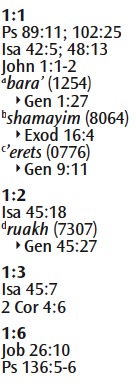
The NLTSB reinvents the cross reference column making it much more useful than merely offering other verses to look up. There are these basic kinds of cross references included, but just enough--not too many. Parallel passages are indicated by two double forward slash marks (//). Asterisks mark intertestamental quotations.
Another new feature in the cross references relate to word studies tied to the original languages. Certain major Hebrew or Greek words are transliterated within the reference column along with its Tyndale-Strong’s number. A reader can look these words up in the “Dictionary and Index for Hebrew and Greek Key Word Studies” in the back of the NLTSB. This dictionary serves as a brief lexicon for about 200 major biblical words. Underneath the reference, a triangled bullet indicates the next occurrence of the particular word much like a chain reference Bible.
Thus the NLTSB manages to combine in its reference system the best qualities of a reference Bible as well as the features of other works such as The Hebrew-Greek Key Study Bible and The Thompson Chain Reference Bible.
RANGE OF SOURCES. Often study Bibles tend to come across as closed systems of reference rather than leading the reader to further information. Many study Bibles simply don’t refer the reader to other works at all. Perhaps this is another influence of the NET Bible which offers references to books and articles right within its notes. While the NLTSB doesn’t do this in the study notes, there is a “Further Reading” section in each introductory article. I was both surprised and delighted to see such a wide range of selections.
These recommendations aren’t relegated to simply Christian writers. Robert Alter, a well known scholar in the Jewish Studies department at Berkeley is recommended further reading for 1 & 2 Samuel. And even among Christian writers, there is a great deal of diversity. Take for instance the introduction to the Book of Psalms. Familiar readers will know there is a VAST difference between the work of James Montgomery Boice on the Psalms and that of Marvin Tate from the Word Biblical Commentary (the latter of whom wrote one of my two recommendation letters to the doctorate program). And in the introductory article on the Book of Daniel, a very traditional scholar like E. J. Young is listed right along with John Goldingay who dates the Book of Daniel much later than the events described therein.
Now, I have to admit that I believe that such diversity among recommended sources is too often sadly rare in some Christian circles. But this demonstrates a confidence in the editors of the NLTSB that readers can make their own informed decisions in regard to the biblical writings. Frankly, such openness is both surprising and refreshing.
Unfortunately, full bibliographic information is not included with the list of further reading recommends, but simply the name of the author and the title of the work--with the exception of volumes from the Cornerstone Biblical Commentary. All completed volumes of the CBC are included in the appropriate lists as would be expected from a Tyndale publication, and the CBC is the only series that enjoys the mention of its name in the “Further Reading” lists. As for the other recommendations, an author’s name and title of the work is probably all one needs to track down any of these volumes at most online resellers.
ACKNOWLEDGING OTHER TEXTS. The writings of the Bible were not written in a vacuum, of course. But from many study Bibles on the market the reader wouldn’t necessarily know otherwise. Sometimes a study Bible will have an included article on the books of the Apocrypha and reasons why Protestants don’t read them, but very little more attention is paid to these books. Most study Bibles include a begrudging reference to 1 Enoch in Jude, but offer little more.
So I was quite amazed Sunday when looking at the article on “Circumcision” that accompanies Acts 15 to read this statement: “For Jews, it had religious significance as the sign of the covenant that God had established with the people of Israel (7:8; Gen 17:9-14; Josh 5:2; John 7:22; Sirach 44:20).” Yes, right along with references to other biblical books was a reference to the Apocrypha. So I looked further, and I found that references to other Jewish literature abounds in the study notes! The note for Romans 4:1 refer the reader to the Prayer of Manasseh, Jubilees, 1 Maccabees and Sirach by way of background. The note for Matt 5:31 quotes the Mishna! I can’t recall seeing so much interaction with extrabiblical Jewish literature in any other study Bible from an Evangelical publisher ever before.
Two more features of note: (1) a five-page, three-column article with timeline titled “Introduction to the Time After the Apostles” follows Revelation describing the process of canonization; (2) the “NLT Study Bible Reading Plan” incorporates all the additional articles and introductions and if followed five days of the week can be completed in five years.
WHAT’S NEXT? The NLTSB won’t be widely available until it hits the retailers mid-September. However, Tyndale has quite a few events coming up in conjunction with the release of the NLTSB. In August, the complete text and all the features of the NLTSB will be released on the internet. This will include fully searchable text with hyperlinked cross references. Unlimited access comes with the purchase of any NLTSB, and others can obtain a 30-day free trial.
Also in August, NLTSB General Editor Sean Harrison will host live “webinars” demonstrating features of the Bible and answering questions.
Simultaneous with the release of the NLTSB on September 15, software editions of the study Bible will be made available for three platforms (Libronix, PocketBible, and WORDSearch (What? Where’s the Accordance module?!).
The NLT Study Bible website is great place to keep up with these developments and to explore the features of the NLTSB. There’s an engaging blog at the website and an errata page has already been started. I commend Tyndale for the errata page as there’s bound to be errors in a project of this scale, and they’re honest enough to make them known (if only this had been done for Zondervan’s Archaeological Study Bible which was rife with errors).
And if you weren’t able to get your hands on one of the early copies of the NLTSB, be sure to place yours on pre-order.
Overall, I’m impressed with the features of the NLT Study Bible, and I truly believe it is yet another step in facilitating the New Living Translation as a choice for serious Bible study.
ONE MORE THING. I failed to mention that the NLTSB breaks with the recent trend for small type in study Bibles by offering a surprisingly larger and readable typeface. The type in the NLTSB is larger than the typeface in the Archaeological Study Bible, the TNIV Reference Bible and even the TNIV Reference Bible. Tyndale was able to do this by opting for a more traditional two-column biblical text instead of a single-column as with most recent study Bibles. Single-column text requires more pages because it does not use space on the page as efficiently as double column text--especially in poetic passages.
Although I’m a fan of single-column text, the larger typeface in the NLTSB is a welcome “feature.” The study notes conserve space even further by using a triple-column layout and thus are easier on the eyes as well.
Rise of the New Living Translation
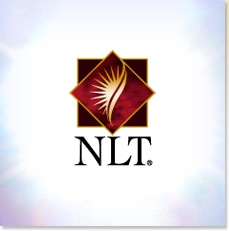
Originally, this week, I was planning to post a preview of the upcoming NLT Study Bible based upon the Genesis sampler I received in the mail over a month ago. I was informed yesterday however, that I would be receiving an advance copy of the entire Bible sometime within the next few days, so that review can wait and I will expand it to cover the entire Bible. Nevertheless, there have been a number of NLT-related issues and trends I’ve been noticing and a number of thoughts have been going through my mind lately. I wondered initially whether I should include them in the review of the NLT Study Bible or treat them separately. I’m going to use this post to do the latter.
THE ELUSIVE COMMON BIBLE. I’ve been collecting and comparing translations of the Bible since my early teenage years. Even after studying biblical languages, I still have a love for English translations, carrying both an English Bible and a Greek New Testament to church on Sundays. Related to that, I’ve watched the trends of what Bibles people carry and read, and I’ve studied the history of English translation development. We live in an age in which we are spoiled by so many translations of the Bible--from every translation methodology and for every niche market. The offset of this fact is that it is now nearly impossible for the church as a whole to embrace ONE Bible as a “common” Bible in the way that the venerable King James Version reigned supreme for nearly three centuries.
And yet even without a common Bible, there is always a preferred Bible, a most often selected, best-selling Bible version. The first Bible version to dethrone King James was the Living Bible in the 1970’s. But this coup was short-lived and the KJV soon regained its kingdom. Nevertheless, it’s interesting to note that the first contender to the KJV for best-selling translation was a Bible that was its complete opposite. The Living Bible wasn’t actually a translation at all, but a paraphrase produced by one man (and later checked by a committee) who had no direct knowledge of the biblical languages. But by the 1970’s the King’s English was quite foreign to the average Christian. Although the Living Bible had many critics at the time, no one argued the fact that it was much easier to understand. And at the time, most Christian homes contained one of those green hardback paraphrases whether it was carried to church or not (and many of them were carried to church).
The Living Bible was certainly not the first Bible to come along with more readable English. Many Bible versions were produced throughout the centuries claiming to the successor to the 1611 “Authorized Version.” Noah Webster and J. N. Darby both attempted to improve upon the KJV in the 19th century. Both of their Bibles were improvements, in the opinions of most, but they never saw widespread acceptance. The 1881 Revised Version and 1901 American Standard Version both sought to replace the KJV as the standard translations for English-speaking Protestants, but while technically translated with more accuracy than the KJV, they did not reflect the beauty of the KJV’s style and never gained wide reading outside primarily academic circles.
In the mid-twentieth century, the Revised Standard Version replaced the KJV for many mainline Protestants, but most Evangelicals looked upon certain renderings in the RSV with suspicion. Thus, the KJV was still able to retain its dominion for a couple of decades more, but its reign as best-selling and most read translation was drawing to a close.
ROYAL DETHRONEMENT. Ultimately, it was the 1978 NIV that would finally and permanently unseat the KJV from the #1 spot. The NIV had a number of things going for it that made it successful where other contender translations had failed. Unlike the Living Bible, the NIV was an actual translation from the Greek and Hebrew texts and was produced by a committee of translators. Reading level was seriously taken into consideration in developing the NIV. The average American reads at a 7th grade reading level and newspapers generally read at that level, too. Considering the fact that the New Testament was written in Koine (common) Greek, why should a Bible be difficult to read? Why should it sound like it was written in a bygone era? Further, unlike the Modern Language Bible, the NIV committee employed stylists that helped keep its translation consistent. While not trying to achieve the majesty of the KJV necessarily, the NIV committee did achieve something that other contenders had not: an accurate, consistent, and readable translation of the Bible. I don’t remember now exactly when it occurred--either in the late eighties or sometime in the nineties--but the NIV became the best-selling, most-used, and most read translation. For millions of people, it opened up the Scriptures and made them readable for the first time.
But let’s be realistic. The NIV is not going to be the Bible of choice for the next three centuries like the KJV was. No translation will ever last that long again because the English language changes too quickly in the modern age. Sadly, the 1978 NIV already sounds a bit dated. And although it is still the best-selling English translation of the Bible, I would suggest that over the next decade another translation is going to replace it in the top spot. I don’t have access to NIV sales figures, but I would guess that its sales are already on the decline. If they aren’t, they will be soon.
WHAT’S NEXT? So what are the contenders? The English Standard Version, Holman Christian Standard Bible, Todays New International Version, the New Living Translation (second edition)--these are all major 21st century translations. If I had been propheticlly looking at this list twenty years ago, it would have been easy to suggest that the TNIV, as an update to the NIV, would be the inheritor of the NIV’s mantle. Even up until recently, I thought it still could be. But I’m less and less certain of that fact.
The TNIV suffers on two fronts: (1) It was the target of a major disinformation campaign that has led to its rejection by many of those who should have been in its target audience; and (2) neither the TNIV’s copyright owner, the International Bible Society, or its major United States distributor, Zondervan, have ever given it precedence over the original NIV in terms of promotion and emphasis.
In regard to the first issue, 50% of stores that belong to the Christian Booksellers Association, including major chains such as Lifeway, refuse to carry the TNIV. Supposedly the TNIV’s primary offense is inclusive language; however, these same stores that won’t carry the TNIV will carry the NLT, the Message, the NCV, the NRSV and others that do contain inclusive language. Further, translation such as the ESV, NASB95, and the HCSB all contain more inclusive language than even the original NIV. This is a heinous double standard. Changing these misconceptions will also require a major re-education campaign on the part of Zondervan and the IBS.
As for concerns with the International Bible Society’s and Zondervan promotion of the TNIV, in March of 2007, I wrote an open letter to both organizations here on This Lamp expressing my concerns. IBS never responded, but Zondervan flew me up to its headquarters in Grand Rapids, Michigan, where I met with editors and marketers--all warm, friendly, and welcoming. I didn’t meet anyone who wasn’t absolutely adamant that the TNIV was the future. I also came to understand better why the company was not in a position to completely remove the NIV from the market. Fine. But there’s evidently a breakdown somewhere.
Run this little experiment. Go to Amazon.com and search for “New International Version.” Then to narrow your results, click on “Books” under “Any category” on the left. Now, change the drop down on the top right to “Publication date.” I count 29 new NIV Bibles already projected for 2009. Run the same search for “Today’s New International Version.” The result? Nothing. You will find results counting new editions for 2008, but in comparison to the new NIV editions for this year, you’ll definitely see where Zondervan’s emphasis is. You ask anyone at Zondervan and they will tell you that the TNIV is the future. But the company simply doesn’t seem to be willing to put that into practice. I’m certain that they fully intend to eventually switch emphasis to the TNIV, but my fear is that by the time they do this, it may be too late for it to matter.
INTERESTING RECENT DEVELOPMENTS. Now, let me show you another interesting indicator of what may be the shape of things to come. Below is the August 2008 translation bestseller list from Christian Booksellers Association. These figures reflect sales from the month of June, 2008.
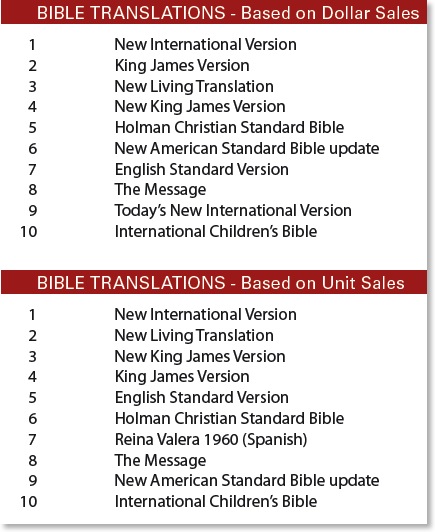
Now, anytime I show CBA translation charts, I always feel obligated to offer a disclaimer. These charts do not reflect the huge number of Bibles sold in non-member stores and bookstore chains including Barnes and Noble and Borders and such. They do not include the sales of retail outlets like Wal-Mart and online retailers like Amazon.com--all of which sell large numbers of Bibles, also. Although some Catholic stores are CBA members, the majority are not; so Catholic translations are never well-represented here. Also, keep in mind that as I have already pointed out, roughly 50% of CBA stores refuse to carry the TNIV, so although it does not show well here, that doesn’t mean that it’s not selling elsewhere. Translations such as the NRSV may also have higher sales that are simply not reflected here. The JPS is a fine translation, but it’s never going to make this list. Okay...
Nevertheless, the above figures do represent an extremely large number of Bibles sold in stores, especially Bibles that Evangelicals are buying. Since we don’t have any actual numbers, obviously the charts are open to a good bit of interpretation. Years ago, while working in a bookstore, I saw a document with some actual numbers. The first three entries counted for the vast majority of all sales. And by the time a translation ranks in the bottom half, we’re usually talking about sales in the single digit percentages.
First let’s look at the charts in regard to the TNIV. The fact that it ranks on dollar sales, but not on unit sales probably means that there aren’t that many inexpensive TNIVs in bookstores. So there aren’t many people buying low cost editions in CBA stores for evangelistic purposes. But what’s surprising is that the TNIV has completely dropped off the units sold chart. So, while it is not carried in every one of these stores, it at least used to still show in the units sold list. The August chart doesn’t mean that the TNIV is not selling in the stores that are carrying it, but it does mean that it has recently been selling less. And I’m sorry, but it boggles my mind that the International Children’s Bible would outsell the TNIV!
But now, let’s look at the chart in regard to the New Living Translation. For the last few years, the NIV, KJV, NKJV and NLT have remained in the top four positions (the HCSB was in the 4th spot after its release for a little over a year). The KJV and NKJV often go back and forth between second and third place, but the NLT is usually ranked fourth.
The unit sales chart has the most significant change. For the first time to my knowledge, the NLT has topped both the KJV and NKJV in unit sells, setting it second only to the NIV. And in dollar sales, it is ranked third and above the NKJV. To my knowledge, the NLT--which has always done fairly well on these charts anyway--has never done this well.
This week, I noticed another interesting development. Over at the NLT Blog, in what was almost an aside comment, it was noted that “Christianity Today, International will be making the NLT the default translation on their websites.” I assume that the NLT is replacing the NIV as the default translation. In my mind, this is an incredibly significant development as Christianity Today, in many ways, represents mainstream Evangelical thought. So it speaks volumes not only to the fact that the NLT was chosen as default translation, but also in regard to the versions that were passed over.
NLT UNDER THE RADAR. Suddenly and seemingly unexpectedly, signs are starting to point to the New Living Translation as a major contender for the spot of top English translation that the NIV has held onto for the last two decades. How did this come about?
Perhaps the success of the NLT can be chalked up to the patient persistence on the part of Tyndale House Publishers as well as near nonstop fine tuning of the translation itself. When the New Living Translation was initially released in 1996, it was far more to the right on the dynamic equivalence scale than it is now. The first edition had many phrasings that still echoed Ken Taylor’s original Living Bible. But with the release of the second edition of the NLT in 2004, a lot of the more dynamic readings were tightened up, active voice replaced passive voice in many passages, and the more questionable renderings were mostly removed. Echoes of the original Living Bible are now all but gone from recent editions of the NLT. I still consider the NLT a dynamic translation, and the best of its breed, but it has now moved much closer to the middle, much closer to the kind of translations I would normally categorize as median translations, containing elements of both formal and dynamic methods, based upon the communicative issues of a particular passage.
In 2007, the NLT was revised yet a third time. But the changes are not as startling as the shift between the first and second edition (see my review of the NLT for discussion of the changes in the second edition). In fact, Tyndale is still referring to the 2007 edition as a second edition, but adding 2007 to the 1996 and 2004 dates. With each revision, the NLT has become...well, I don’t want to say “more literal,” because it’s certainly not a literal translation in the traditional sense of meaning. But it has certainly become less dynamic.
I do not yet have a full 2007 text of the NLT, but when I received the Genesis sampler of the NLT Study Bible, one of the first things I did was to compare the changes in the text from the 2004 edition. As already mentioned, the changes are not on the same level of the change between the 1996 and 2004 editions, in which the NLTse was almost an entirely new translation in my opinion. But the changes reflect a honing of the translation, a fine-tuning of the details if you will. Consider that in Genesis 1-12, there are only 7 verses out of 287 that have been changed from the 2004 edition. That results in a 2.4% change from the 2004 NLTse.
1996 |
2004 |
2007 |
|
1:14 |
And God said, "Let bright lights appear in the sky to separate the day from the night. They will be signs to mark off the seasons, the days, and the years. | Then God said, "Let great lights appear in the sky to separate the day from the night. Let them mark off the seasons, days, and years. | Then God said, "Let lights appear in the sky to separate the day from the night. Let them be signs to mark the seasons, days and years. |
1:16 |
For God made two great lights, the sun and the moon, to shine down upon the earth. The greater one, the sun, presides during the day; the lesser one, the moon, presides through the night. He also made the stars. | God made two great lights, the sun and the moon--the larger one to govern the day, and the smaller one to govern the night. He also made the stars. | God made two great lights--the larger one to govern the day, and the smaller one to govern the night. He also made the stars. |
1:26 |
Then God said, "Let us make people in our image, to be like ourselves. They will be masters over all life--the fish in the sea, the birds in the sky, and all the livestock, wild animals, and small animals." | Then God said, "Let us make human beings in our image, to be like ourselves. They will reign over the fish in the sea, the birds in the sky, the livestock, all the wild animals on the earth, and the small animals that scurry along the ground." | Then God said, "Let us make human beings in our image, to be like us. They will reign over the fish in the sea, the birds in the sky, the livestock, all the wild animals on the earth, and the small animals that scurry along the ground. |
2:5 |
there were no plants or grain growing on the earth, for the LORD God had not sent any rain. And no one was there to cultivate the soil. | neither wild plants nor grains were growing on the earth. The LORD God had not yet sent rain to water the earth, and there were no people to cultivate the soil. | neither wild plants nor grains were growing on the earth. For the LORD God had not yet sent rain to water the earth, and there were no people to cultivate the soil. |
2:10 |
A river flowed from the land of Eden, watering the garden and then dividing into four branches. | A river watered the garden and then flowed out of Eden and divided into four branches. | A river flowed from the land of Eden, watering the garden and then dividing into four branches. |
11:26 |
When Terah was 70 years old, he became the father of Abram, Nahor, and Haran. | When Terah was 70 years old, he had become the father of Abram, Nahor, and Haran. | After Terah was 70 years old, he became the father of Abrah, Nahor, and Haran. |
12:14 |
And sure enough, when they arrived in Egypt, everyone spoke of her beauty. | And sure enough, when Abram arrived in Egypt, everyone spoke of Sarai’s beauty. | And sure enough, when Abram arrived in Egypt, everyone noticed Sarai's beauty. |
Interestingly note that in Gen 2:10, the NLT reverts back to the original 1996 reading. Since writing my initial review of the NLT, I’ve been contacted by a number of NLT1 holdouts. Some people simply prefer the 1996 edition, and my own wife is one of them. Overall, it is more dynamic (though not in Gen 2:10) and that speaks to some people in a greater way. Personally, I have no problem with that, although I believe the changes made in the 2004 edition and now the 2007 revision as demonstrated above are changes for the better.
Over the last few years, I’ve found it quite interesting to watch the TNIV receive criticism in regard to inclusive language when the NLT had used much of the same kind of language almost a decade earlier. I even asked one of the NLT translators about this--why the NLT had remained virtually unscathed while the TNIV took a beating from its detractors. He felt that the TNIV had been a lightning rod for controversy and this allowed the NLT to scoot by a bit under the radar.
And under the radar it is. The NLT has continued to gain readers while improving the translation itself while many have really not realized such changes were going on. Consider that the 2004 update, as radical as it was, barely received mention by Tyndale itself. In fact, when I began planning my review of the NLT in 2006, I was totally unaware the extent of the changes. And I would not have even known about the 2007 revision had a reader of This Lamp not informed me by email.
But if I’m a proponent of the NLT and have been slow to find out about changes to the text, evidently it’s even harder for the detractors. Tim Challies sought to further propagandize the ESV earlier this month by knocking down a few translations he doesn’t like. Evidently, though, he had no idea that the copy of the NLT he was quoting was two editions out of date.
Want further evidence of the NLT’s under-the-radar status? Check out the Wikipedia entries for the ESV, TNIV, and the NLT. The NLT is older than the ESV by five years and the TNIV by nine. The articles for the ESV and TNIV are substantive because they have both been magnets of controversy and have each had their share of supporters and critics. The NLT, on the other hand, doesn’t even have a full article. It’s a stub, and an out of date one at that. Some of the links don’t even work.
Want more? Consider the interview with J. I. Packer from 2006 in which he heartily endorsed the NLT. He even described the NLT as “brilliantly done.” This should be ironic considering Packer was the general editor of the ESV, a translation which in many ways was created to be everything the NLT is not. But it’s not ironic because Packer is not really recommending the NLT as a primary translation. Rather, he thinks of it as a secondary translation, something perhaps to be read beside a more traditional translation like the ESV. He may even think of it in the same vein as the original Living Bible which many used as a simple commentary to the KJV. But the people I see using the NLT are not reading it as a secondary translation. And I can guarantee you that Tyndale is not promoting it to be anything but a primary Bible.
What made the NIV king of the hill beyond its merits as a translation? Well, there were a number of significant editions of the text that were released in the eighties including the NIV Study Bible, the NIV Student Bible and an NIV version of the Thompson Chain Reference Bible. The Expositor’s Bible Commentary, written by top Evangelical scholars demonstrated that the NIV was worthy as a commentary base. The Goodrick-Kohlenberger numbering system tied the NIV’s text to its Greek and Hebrew roots and paved the way for resources like the New International Dictionary of New Testament Theology. Today, there are more modern commentaries based upon the NIV than any other translation.
But now, Tyndale is setting the NLT up for the same kind of reference integration that the NIV has enjoyed. A system known as the “Tyndale-Strong’s numbering system” has been developed to connect the text of the NLT to the original Greek and Hebrew text. In the forthcoming NLT Study Bible, these Tyndale-Strong’s numbers are included right along in the cross reference column next to the text. The Cornerstone Biblical Commentary series and the expanding Tyndale Reference Library relies on the NLT text as well.
Another healthy sign for the NLT can be found in the two NLT-related blogs that have appeared recently. One blog is related to the NLT in general and the other specifically for the forthcoming NLT Study Bible. This is an excellent idea and a wonderful way for Tyndale editors to interact with NLT readers. I made similar recommendations to Zondervan regarding the TNIV as early as two years ago, but an ongoing publisher-based TNIV blog has never become a reality.
Personally, I’ve stated for some time that the NLT is fully capable of being used as a primary English translation for serious study and teaching. Steps are now in place with the growing number of NLT-related resources to make this a reality. And as has been pointed out recently, the NLT translators are no slouches themselves, but rather the cream of Evangelical academia.
LOOKING TO THE FUTURE. In discussing some of these observations with Wayne Leman via email yesterday, he stated “A major translation comes along every few generations and it can become a default translation. The KJV was one of these. The RSV was one, at least for NCC churches. The NIV was one. Now, [in my opinion], the NLT is one. I know that many will disagree with me, but that's okay.” Wayne, who gave me permission to quote him, knows what he is talking about as he is a Bible translation consultant himself and a founder of the Better Bibles Blog.
In my experience, the average Christian really doesn’t pay that much attention to translation issues. I’ve discovered that many people carrying a Bible often can’t tell me what translation they are using without looking at the spine. So, what makes a translation like the NLT rise in popularity, especially among a dozen or so other Bible versions vying for acceptance? I have a hunch that when a person walks into a store looking for a new Bible, he or she opens them up and simply reads various passages. This is where the NLT has the advantage. Without a doubt, of all the major contemporary translations, the NLT’s English sounds the closest to contemporary speech. While some would criticize the NLT for this, we must again remember that the New Testament was originally written in the common speech of the day, not the more formal styles that were used for other, more “official” purposes.
Wayne also wrote yesterday that, “Christian readers today appreciate a Bible version that actually reads as they write and close to how they speak. There have been enough idiomatic English versions around for several decades, so that Christian readers know what good English sounds like in a Bible. If Christian readers have a true choice to purchase a Bible--and don't have to follow the dictates of some ideology--they will often purchase a Bible with good English, at least as a supplement to one that has worse English and is used as their church's pew Bible.”
Readers of This Lamp know that over the past few years when asked for a recommendation for a primary English Bible, I’ve suggested the HCSB, TNIV or NLT. In my own use, the TNIV has been my primary Bible over the last two years, although when I give a Bible to someone who tells me the Bible is difficult to understand, I find that most often I give the NLT. And I’ve done this for well over a decade. In fact, now that I think about it, I’ve given away more NLTs than any other translation in the last ten years, and I have done so because of its superior readability.
I have been teaching from the TNIV the last two years because 70% of those whom I instruct are carrying NIV Bibles. That’s in addition to the fact that I find the TNIV to be an excellent translation. Further, I’ve found that usually a median Bible is best for teaching; although I’ve said that I could use the NLT if enough people in a Bible study or classroom also had the NLT. I’ve often used the NLT in formats that were less interactive such as sermons and devotionals. But the day may be coming in which a majority carries the NLT. If that happens, it would only make sense that I would teach from the NLT. Of course, Tyndale currently lacks a decent NLT reference Bible for teaching or preaching akin to something like the TNIV Reference Bible.
This coming Sunday, I still plan on teaching from the TNIV. But I really wonder what I’ll be teaching from in five years. Could it be that the majority of us will study with the NLT in hand?
I’d really like to have a discussion about this. Let’s avoid the “my translation is better than your translation” kind of nonsense. I don’t believe that for one Bible version to succeed another one must fail. I still recommend reading translations in parallel. Regardless, I believe current trends point to the NLT continuing to gain momentum which may eventually lead to its place as the most used Evangelical translation in a number of years. And it may even be able to reach beyond the walls of Evangelicalism. What do you think? Let me know in the comments.
Recommend: The New Living Translation Blog

I especially appreciated Keith Williams’ “Words in the New Living Translation.” This post directly addressed a recent post by Tim Challies that took swipes at the NLT (and the Message and CEV) in order to prop up the ESV. I found it interesting that Challies would quote from the 1994 edition of the NLT when the translation has seen a significant revision in 2004 and then another minor revision last year. I felt that Challies’ post was primarily another attempt to promote the value of the ESV by attacking Bible versions that use a different method of translation. In the end, such comparisons are apples and oranges, translationally speaking. I don’t see why ESV readers can’t simply applaud their favorite Bible without attempting to knock other versions down, but the internet is full of such posts. Williams’ rebuttal avoided the trap of pitting one translation against another and instead approached the real issue of translational method and the challenge of communicating meaning from one language to another.
The NLT is one of three primary translations (along with the TNIV and HCSB) that I suggest when asked under general circumstances for a translation recommend. Translations, in my opinion, have to be evaluated on their own merits regarding how well they achieve their translational goals. There is no “one size fits all” translation, but the NLT communicates in a style that is more in keeping with contemporary, conversational English than any major translation I know of.
The NLT Blog is described as “Issues, perspectives, and news related to the New Living Translation and Bible Publishing.” A glance at the contributors suggests that this blog will serve as a great way to interact with the keepers of the NLT. They are off to a good start, and I will be interested to see what future posts hold. While I assume they will highlight specific editions of the NLT, I would hope also to see much discussion about the uniqueness of the NLT itself and further discourse on translation method.
Other publisher-based Bible translation blogs:
ESV Blog
NET Bible Revolution (last updated April 30, 2008)
TNIV Blog (defunct? not updated since November, 2006)
Zondervan & This Lamp to Give Away TEN Renaissance Fine Leather TNIV Reference Bibles
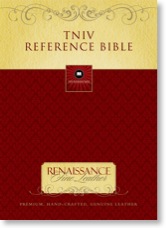
That’s right--Zondervan has offered to give away ten copies of the Renaissance Fine Leather TNIV Reference Bible (a combined retail value of nearly $1,000) to ten qualifying individuals. What must you do to qualify?
- You must be a “Gatekeeper.” What’s a gatekeeper? A gatekeeper in this context is someone who regularly preaches or teaches the Bible in a church or educational setting. For the purposes of this giveaway, if you are a pastor, other minister or teacher of adults and you instruct from the Bible on at least a weekly basis, you are considered a gatekeeper. You should also have been in this position for at least three months.
- You must already use the TNIV as your primary Bible. This is a really nice edition of the TNIV Reference Bible, and Zondervan is being very generous to give these away through This Lamp. So, this is a Bible that’s meant to be used, not one that becomes an addition to your collection of translations.
- In the comments of this post, tell us why you are using the TNIV translation as your primary teaching and/or preaching translation. We’re looking for at least a couple of paragraphs here, not “Because I think it’s really cool.”
- Qualifying winners agree to a follow-up email interview regarding the use of the TNIV in your ministry. Between now and November, I’ll contact you with a few questions based on your post here in the comments. That interview will become the basis of an actual main post here on This Lamp.
- You cannot qualify if you’ve already been deemed a recipient of the similar giveaway on TC Robinson’s website. No double-dipping! And TC emailed me his list of winners!
- Sadly, United States residents only.
If you have any questions, let me know. I’ll post a list of the ten winners once it is finalized.
PLEASE NOTE THAT THIS OFFER HAS NOW ENDED. TEN WINNERS HAVE QUALIFIED.
Preview: TNIV Reference Bible, Renaissance Leather Edition (with photos) [UPDATED]
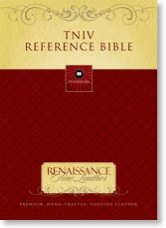
Later this year, Zondervan will release another edition of the TNIVRB, this time with a much nicer cover, described as “Renaissance Fine Leather.” There’s a movement in publishing circles away from naming the animals from which the leather is obtained [I’m still waiting for “genuine dairy cow”], but the new “Renaissance Fine Leather” is
[Update: Okay, here’s the scoop. The Renaissance Fine Leather is cowhide. It is not calf, goat, or pig. I’ve been told that what makes it special is its “Soft supple feel, complemented with stitching accents, & sewn binding.” Further, “the soft supple feel is achieved by the case construction, which has flexible endsheets without a stiff cover board. Some [Renaissance Leather] Bibles also have foam to give it more structure, but maintain the flexibility. So instead of using a thin bookbinding leather and then attaching it to a stiff board (like 99% of Bibles), we use a thicker leather and let the material itself become the cover.”]
The new edition of the TNIVRB has these features:
- November release*
- Over 10,000 references
- Bound in our new premium hand-crafted Renaissance Leather*
- Single Column
- Black letter
- Topical ties at bottom of page
- TWO ribbon markers*
- MSRP: $99.00*
*indicates features pertaining only to the new edition.
I was sent some photos of the new Bible from Zondervan today, which I am reproducing here. Be sure to click on an image to see it in its original size.
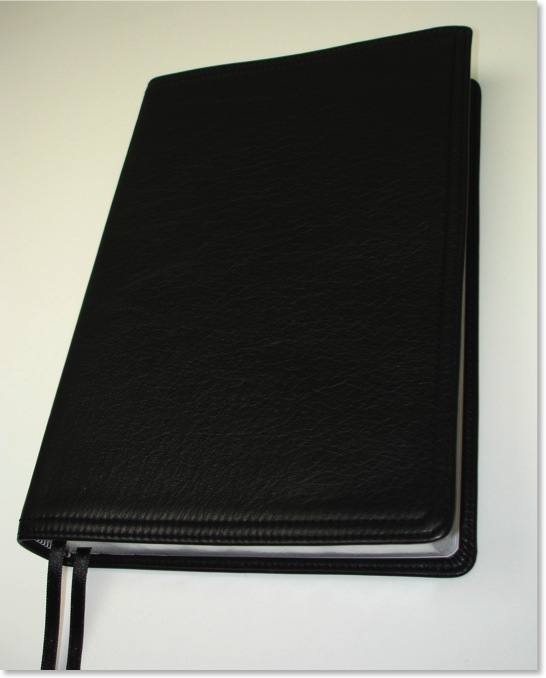
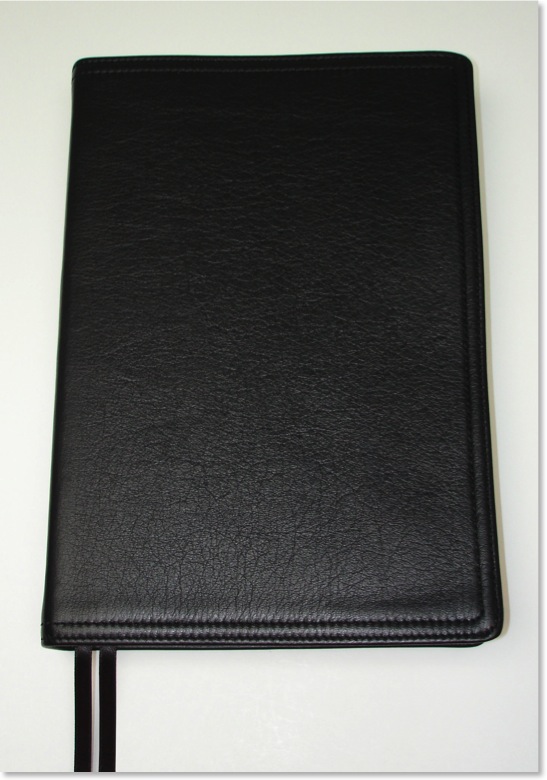
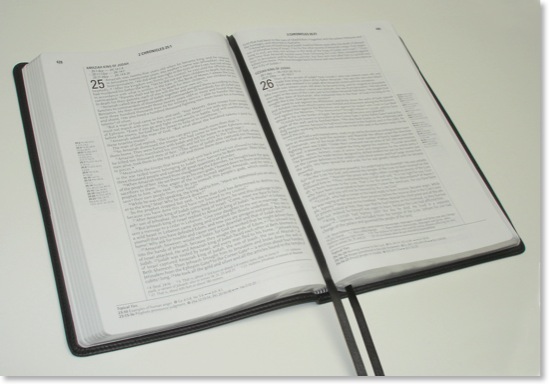
This does, indeed, look to be a very fine Bible. It was described to me in correspondence with these words “I wish you could touch this leather. Smooth as butter. Supple. Exquisite.”
Now, I know that Zondervan has promised to give away some of these Bibles through TC Robinson’s New Leaven website. But today they also contacted me and have generously offered to do something similar through This Lamp.
I’ll spell out the particulars in a day or two, so be sure to stay tuned for more...
A Reflection on the 17-Year Cicadas

As I took pictures, I was mesmerized by the beauty of these alien beings. So odd looking, and yet, God created even these--part of a cycle, part of a purpose. When I was a child, we always called cicadas "locusts." But they really aren't locusts. The biblical writers had nothing good to say about locusts because they always came as destroyers; but really, even locusts served God's purposes.
Whereas locusts were harmful, cicadas are the opposite. According to the Wikipedia, "Cicadas do not bite or sting, are benign to humans, and are not considered a pest." In the 4th century AD, the Christian preacher John Chrysostom compared the pleasure of reading the Old Testament prophets to the song of the cicadas.
I've always identified the sound of cicadas with summer. But I believe that looking into the dark red eyes of this 17-year variety, for the first time, I found a new summertime connection to the majesty and glory of God's creative power. I would imagine that in heaven, in addition to the trumpets of angels, cicadas must also sing their praises to God.
Psalm 145:10-11 states
“All your creatures praise you, Lord,
and your loyal servants bless you.
They talk of the glory of your kingdom
and tell of your might,” (REB)
Surely, this includes even the cicadas.
Follow-up. After I sent the above out in an email to a selected few, I was sitting on my back patio a few days later. We are on the outermost edge of the Eastern time zone, and during the summer, we have sunlight well past 9PM. I enjoy sitting on my patio swing watching the skies as the gray bats indiginous to this part of Kentucky emerge from their secret sites of slumber for their nightly hunt. As the bats began their patrol, and the sound of the cicadas began to lessen for the evening, I thought to myself, “What a great summer to be a bat--a nice, fat, happy bat.”
See the pictures I took of the cicadas (be sure to click on the thumbnail to see a larger view).
Also, if you’re interested in this particular varitey of cicada, check out the recent Courier Journal article, “17-Year Cicadas Sounding Off in Kentucky.”
One More Thing: I believe this will be the last post with mismatched comments. If I’m correct, comments that were originally part of Theron’s review of the Orthodox Study Bible will be attached to this post. If you leave a new comment, it will be below them. One day I may try copying previous comments to the correct posts and deleting the misplaced comments. But as this will be tedious and time consuming, it won’t take place soon.
Umm...Who Rebuilt the Temple?
Okay, maybe that isn’t a problem. Maybe the problem is that no one else pays attention. Maybe the problem is that sometimes the songwriters don’t pay close enough attention.
This morning, we sang the song “Days of Elijah” which includes a good bit of Old Testament imagery. It even refers to God as “riding on the clouds” which I understand is a very ancient image of God, perhaps predating the written Scriptures themselves.
Anyway, if you follow the link above to read the words of the song (or perhaps if you are familiar with it), you’ll notice that it refers to the days of Old Testament figures such as Elijah, Moses, Ezekiel and then...David. That’s where I had the problem.
Here are the exact lines:
And these are the days of Your servant David,
Rebuilding a temple of praise.
Do you see the problem? It’s the reference to David rebuilding the Temple. When exactly did David ever rebuild the Temple? Am I missing something here? Is this supposed to be some kind of Messianic reference that I just don’t get?
While David wanted to build the Temple, God would not allow him to because he was considered a man of war (see 2 Samuel 7). David’s son, Solomon, was the one who built the Temple (1 Kings 5-6). But again, David neither built it, and he certainly didn’t rebuild it.
It’s a pretty basic fact that Zerubbabel rebuilt the temple (completed around 516 BC) as part of the Jewish return from Exile in Babylon (see Ezra 3-6). Pictoral reconstructions of Zerubabbel’s Temple are a staple of any Old Testament resource, such as this one snagged from the NIV Study Bible (via Accordance):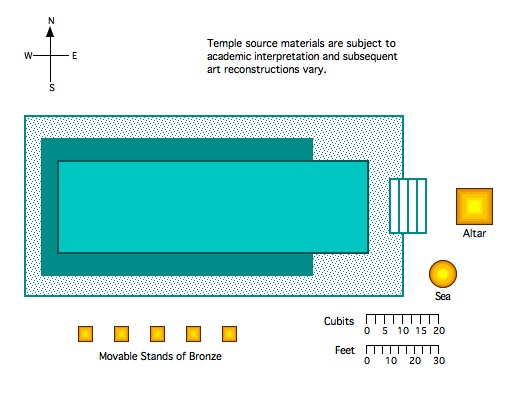
The only other person who had a hand in rebuilding the Temple was Herod the Great in the 1st century BC, but it would a bit odd to sing about Herod in a worship song.
Therefore, I suggest we strive for accuracy in our praise songs. I know it doesn’t flow quite as well, but I recommend that worship leaders everywhere who want to continue using the song “Days of Elijah” change their slides to read
And these are the days of Your servant Zerubbabel,
Rebuilding a temple of praise.
But even if you don’t change the slides, this is the way I’ll be singing it from now on.
And I sing loudly...
The Orthodox Study Bible (A Guest Review)
The Orthodox Study Bible
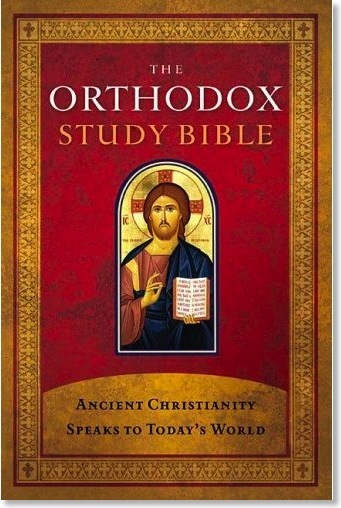
I was fortunate enough to participate with some of the translation of the LXX text, so let me briefly cover the translation methodology that was used. This is not a wholly fresh translation, but will follow the NKJV translation tradition, except for the “Greek” books. This is for at least two reasons. First, it will keep a consistent NKJV flavor found in the New Testament. This is important for us, because so much of this will be read liturgically and therefore the sound of the text matters. Second, there are production issues. Apparently producing a completely fresh translation on a large scale is very costly. Revisions are cheaper, and in many ways this will be a revision of the NKJV. Therefore, the methodology used was to change the NKJV text only where it deviated from the LXX. As a translator this was difficult, and required a lot of restraint. At times, I felt I could phrase a passage better than the NKJV, but unless it changed the meaning I tended to leave it alone. This probably points to a third reason for using this method. It makes the editorial process much quicker. The editors had to spend their time on much fewer words than in full blown translation.
Only recently has LXX translations come into vogue. Yet, the ones that are available are not available on a widespread basis, so this will be the first popular English translation of the LXX to be published by a major American Bible publisher. In fact, the last time this was done was by Lancelot Brenton in 1851. Why is this necessary or important? For Orthodox this is an easy answer---it is our official OT text. To explain the value to other Christian groups, a little background on the LXX is needed. After the Jews became scattered due to the Babylonian captivity and other conquests of Israel, many Jews were unable to read Hebrew. Greek had become the language of the Jewish Diaspora. In order to retain Biblical literacy among Judaism, Jewish scholars in Alexandria from approx. 3rd-1st century BC decided to translate their Hebrew Bible into Greek. Traditionally 72 scholars worked on the project which if you round down to 70 you get the name of the translation--the Septuagint (LXX). The LXX gained widespread use throughout the Diaspora and even in Jerusalem. The Jewish scholars Philo and Josephus seem to rely on the LXX when they quote the OT. For Christians, the importance came during the construction of the NT. A simple cross reference of OT quotations in the NT will show their divergence from the Masoretic text in places. In fact, the Apostles quote most often from the LXX rather than a Hebrew version. When looking at the more complete OT quotations in the NT nearly one hundred agree with the LXX and six agree with the Masoretic Text. What makes this more significant is that most of these quotes deal with prophecies concerning Christ. As a result, the LXX became the Bible of the early church, and has continued to be the OT of the Orthodox Church. The Jews of the 2nd century eventually dropped the use of the LXX. There are probably many reasons for this, but a prime reason was that Christianity had embraced its use and they needed to distance themselves from their rival religion. Also, our oldest extant manuscripts of the OT are from the LXX (4th century AD) and the oldest complete Hebrew OT (Leningrad Codex) was copied around 1000 AD. For these reasons it is important that Christians today can read the Bible used by the Apostles to spread the Gospel throughout the Roman world.
As a side note, there is a tradition regarding the translation that is too fascinating not to mention. The tradition revolves are the person of the righteous Simeon who received the infant Christ as His presentation in the Temple. According to this tradition he was the LXX translator of Isaiah. This would have made him around 200 years. Apparently when he was translating Isaiah 7:14 he debated over whether to translate "almah" with the Greek for virgin or young woman. Virgin seemed impossible to him, so he was about to write young woman and an angel stopped his hand. The angel told him to use virgin, and to confirm the truth of the word choice the righteous Simeon would live to see the fulfillment. This definitely gives a unique perspective on Simeon's words "now let your servant depart in peace" (Luke 2:29).
Now for the review of the Bible. Let me give some basic features of this Bible that make it unique beyond the translation, then follow with a brief evaluation of positive elements and elements that could be improved or revised in future editions. One of the more immediate differences one will notice is the order of the OT books. The "Greek" books are integrated into the contents rather than separated out in an Aprocryphal setting. Here is the list of books: Genesis, Exodus, Leviticus, Numbers, Deuteronomy, Joshua, Judges, Ruth, 1 Kingdoms, 2 Kingdoms, 3 Kingdoms, 4 Kingdoms, 1 & 2 Chronicles, 1 & 2 Ezra, Nehemiah, Tobit, Judith, 1,2,&3 Maccabees, Psalms, Job, Proverbs, Ecclesiastes, Song of Songs, Wisdom of Solomon, Wisdom of Sirach, Hosea, Amos, Micah, Joel, Obadiah, Jonah, Nahum, Habakkuk, Zephaniah, Haggai, Zechariah, Malachi, Isaiah, Jeremiah, Baruch, Lamentations, Epistle of Jeremiah, Ezekiel, Daniel. Yes, its going to take a while to find verses quickly because of the different ordering. One of the surprises is that the editors chose to use the common English names of the books rather than their Greek equivalent, except in the case of Kingdoms. For example, Jonah would have been Jonas, Ezra would be Esdras, etc. However 1 & 2 Kingdoms is called 1 & 2 Samuel in modern English translations. The editors stayed with this same name and place format throughout the translation. I think this was helpful rather than having to relearn names. Even though most could figure out that Elias is Elijah, it could create confusion for Bible newbies.
The Psalter includes Psalm 151 and uses the LXX numbering rather than the Masoretic. However, the Hebrew numbering is placed in parantheses when different. One reviewer has complained about the versification. In most cases this will match the Hebrew version, although there are places where there are more verses than the Hebrew has and often these are inserted in the midst of chapters. Other versions of the LXX have left out the verse numbers in these places or divided it out using letters such as 11a, 11b, 11c, etc. In those places the editors chose to create their own system of versification, which may cause some confusing when comparing LXX to Hebrew passages.
Being a study Bible, it does contain notes at the bottom of each page which is helpful. I found them not to be overwhelming and in the most cases very helpful. The vast majority of notes are direct comments from the Church Fathers. This is a feature that could be beneficial to non Orthodox Christians. Among modern Christians the voice of the Fathers regarding Scripture is unknown, so it is nice to see what John Chrysostom says versus C.I. Scofield. Other notes tend to have a Christological or Trinitarian emphasis. Also interspersed throughout the Bible are various articles and 21 of the articles are specific to OT themes such as Theophanies of Christ, Ancestral Sin, Christ our Passover, etc. Also at the bottom of each page, a text is noted if used liturgically in the Orthodox church. This my not be useful to non-Orthodox, but for Orthodox it provides a nice context to how the Church understands a particular passage.
Overall, I am very pleased with the outcome of the text, and I think it is a welcome addition to English Bibles and can be a great benefit to non-Orthodox believers as well.
The Orthodox Study Bible is available in hardcover and bonded leather. It runs 1,822 pages and is roughly an inch and a half thick. It can be pre-ordered from most retail outlets.
Theron can be reached at mathis5fam@yahoo.com, and be sure to join the discussion in the comments section.
CT "Future" Article Now Online

Chris Armstrong, the writer of the article is spot-on correct in regard to the "identity crisis" among Evangelical/Prostestant Christianity. I've been reflecting on this for a while, and I'm glad to see similar echoes such as what is written about in the article. I don't know if the future lies completely in the past, but recapturing Christian heritage over and above the Next Big Thing (NBT) in pop-spirituality is a good start.
The NASB & the Rejection of Markan Priority
Markan priority--the idea Matthew and Luke independently used Mark's gospel as a starting point, along with the so-called Q source and their own independent traditions--is almost universally accepted in biblical scholarship across almost all theological persuasions.
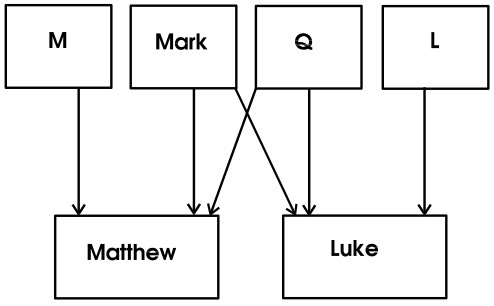
Consider the late F. F. Bruce on the subject in his article on the Gospels in The New Bible Dictionary:
This finding [the idea of Markan priority], which is commonly said to have been placed on a stable basis by C. Lachmann in 1835, depends not merely on the formal evidence that Matthew and Mark sometimes agree in order against Luke; Mark and Luke more frequently against Matthew; but Matthew and Luke never against Mark (which could be explained otherwise), but rather on the detailed comparative examination of the way in which common material is reproduced in the three Gospels, section by section. In the overwhelming majority of sections the situation can best be understood if Mark’s account was used as a source by one or both of the others. Few have ever considered Luke as a possible source of the other two, but the view that Mark is an abridgment of Matthew was held for a long time, largely through the influence of Augustine. But where Matthew and Mark have material in common Mark is fuller than Matthew, and by no means an abridgment; and time after time the two parallel accounts can be much better explained by supposing that Matthew condenses Mark than by supposing that Mark amplifies Matthew. While Matthew and Luke never agree in order against Mark, they do occasionally exhibit verbal agreement against him, but such instances mainly represent grammatical or stylistic improvements of Mark, and are neither numerous nor significant enough to be offset against the general weight of the evidence for Mark’s priority.
In seeking to confirm Wilkin's statements from 1995, I have been in correspondence with a person at the Lockman Foundation over the past couple of weeks in regard to this subject. Although I was not given permission to quote any of the statements from the representative of the Foundation as they consider them private correspondence only to me, I am allowed to confirm that the rejection of Markan priority is indeed a conviction on the part of the NASB translators.
What difference would it make whether a translator holds to Markan priority or not? Well, I have to walk a bit of a discretionary tightrope here regarding the exact nature of the explanation given to me by the representative of the Lockman Foundation. Suffice it to say, at the very least, it involves (according to them) how a translator might view parallel accounts between the synoptics that contain conflicting information. Are they the same event with actual conflicting details or are they two separate, but similar events? This, evidently, is the issue to the translators. Also, there is concern on the translators part that adherence to Markan priority may affect one's view of inspiration. I can't say much more than that as I may have already relayed more than what is appropriate in the request given to me for confidentiality, although I have attempted to be vague in the statements immediately above. I wish I could be more specific regarding the explanation given to me by the Lockman Foundation.
But I have a few questions for the readers of This Lamp. (1) Am I late to this information, or has anyone else ever heard of the rejection of Markan Priority by the NASB translators? (2) Granted the early church held to a position of Matthean priority, but as far as I know, most biblical scholarship--including Evangelical scholarship--rejects the traditional position in favor of Markan priority. Therefore, how widespread is a rejection of of Markan priority among respected scholarship? (3) As I look at the list of other translators for versions such as the ESV, NLT, TNIV, NET, HCSB, etc., I cannot imagine a unanimous rejection of Markan priority on any of these other committees. Am I simply mistaken? And finally and most importantly, (4) would acceptance or rejection of something like Markan priority truly make a difference in the accurate translation of the Synoptic gospels? Would not an honest translator simply render the text as it is?
For the record, I believe Markan priority is the best offered explanation of the so-called synoptic problem. Frankly, I'm surprised that the entire committee of a modern translation would have unanimous and wholesale rejection of it. Your thoughts are welcome and encouraged in the comments.
Guest Review: The Bible Experience Companion Bible
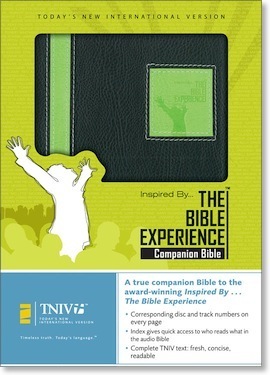
Being my first TNIV purchase I mainly picked up The Bible Experience Companion Bible because it had (IMO) the best looking cover of all the Thinline versions. Hey, I'm a 20-something year-old youth pastor. It matters.
[I wouldn't recommend reading along while listening to the Bible Experience. Since your eyes take in the words faster than they're reading, it "feels" like they're reading it very slow.]
I also appreciate that the Companion Bible comes with a written intro as to how the Bible Experience project came about. I like the thorough listing of who read what part -- the Talent Index. The pro's of this feature is that if I want to quickly locate a Psalm or a Proverb read by my favorite preacher, I can quickly find it. The downside? I don't want to know that it's Cedric the Entertainer reading a part, because it makes me ROFL and I have trouble suspending my disbelief. Same goes with Samuel L. Jackson. Yeah, remember his Scripture-quoting-hit-man in "Pulp Fiction" ?
I guess the only thing missing from this Bible is that the Talent Index replaces your traditional Concordance. But, hey, that's what you have the Internet for, right?
One final observation: In all my previous Bibles, the scripture printed on the Dedication Page has been "The flowers fade and the grass withers, but the word of the Lord stands forever." In this Bible it is: "Go, and make disciples of all nations." Any observations? Is it a recognition of the shifting motives of the new generation, who are more likely to engage with a Cause rather than a Study? The first quotation has a sense of tradition, and Bible-study, etc. While the latter has a ring of action and a call to adventure. I would love to hear people's thoughts on this blog.
Thanks to Rick for inviting me to write a guest blog. And most of all for kindly answering my questions about the TNIV so that I could make the wise choice. I can now say that I'm an NIV-to-NASB-to-ESV-to-TNIV "convert." You could say, I've come full circle.
- R.S., Los Angeles, CA
Related Reviews:
- The Bible Experience: Pentateuch
- The Bible Experience: Historical Books
The Future Lies in the Past
Armstrong describes the church of the early days of his faith after becoming a Christian:
Yet through the years, though this wonderful church formed me in the joy of the Lord that was my strength, I felt like we were missing something. As a stalwart outpost of the kingdom in a threatening world, our faith seemed somehow precarious. We stood, as we faced the world, on a foundation made from the words of our favorite Bible passages--our "canon within the Canon"--and the sermons of of our pastors and a roster of approved visiting evangelists. There was utterly no sense of the mystical massiveness of a church that had stood firmly for 2,000 years. No sense that our foundations stretched down through time. I didn't have a clue who John Wesley, Martin Luther, Bernard of Clairvaux, and Ignatius of Antioch were. I just knew that I felt like we were a part of a church that was in some ways powerful, but in other ways shallow and insecure in a threatening world that did not share our faith.
The church Armstrong describes sounds like almost any Evangelical church I've ever visited. I've complained for years that in spite of the fact that the church has 2,000 years of rich tradition behind it, most Christians are unaware of anything other than their current generation of believers. And many who do venture backwards can't seem to travel beyond the Reformation. But there's a full 2,000 years of that great cloud of witnesses that surrounds us. Rather than continually seeking after the NBT (Next Big Thing), we should reach back to the Bible and to our rich heritage. I once read that Thom Oden said he hoped in his life to offer nothing new to Christianity. Not only do I hope the same for myself, but frankly I'm tired of being bombarded with the supposed newness of one NBT after another in the church. We strive after spiritual junk food to sustain us, neglecting the substance of Scripture, heritage, and tradition.
In the article, Armstrong continues:
I now see that my early sense of the church's insecurity stemmed from what J. I. Packer has called evangelicalism's "stunted ecclesiology," rooted in our alienation from our past. Without a healthy engagement with our past, including historical definitions of "church," we are being true neither to Scripture nor to our theological identity as the church. Though Packer doesn't put it this way, it is easy to see ways in which their stunted ecclesiology has led evangelicals to allow the world to shape the church.
The recent growth of this trend, especially among the young, suggests that evangelicals are still struggling with an identity crisis. Many 20- and 30- something evangelicals are uneasy and alienated in mall-like church environments; high energy, entertainment-oriented worship; and boomer-era ministry strategies and structures modeled on the business world. Increasingly they are asking just how these culturally camouflaged churches can help them rise above the values of the consumerist world around them.
I grew up in Louisiana where Baptist churches like mine wanted so much to separate themselves from the Catholics that we didn't even include crosses on our churches. Yet in rejecting tradition in all forms, we've thrown out the spiritual baby with the bathwater. Our churches try to replace tradition with one new program after another, but we're so afraid of tradition that we cannot even stay with one program for long. We follow trends and seek after the NBT's of the contemporary "Christian" culture, but I'm more than ever convinced that for all the programs we've involved ourselves in and for all the activities we pursued under the guise of discipleship, we haven't moved anywhere nearer to the image of Christ.
Let us stop seeking the new and rediscover the "faith which was once delivered unto the saints."
Haran or Harran?
And have the maps in TNIV Bibles kept up? [No! ...and yes!]
See my newest post, "Keeping up with Harran" at the TNIV Truth blog.
Spinti Reviews Zondervan's Forthcoming A Reader's Hebrew Bible
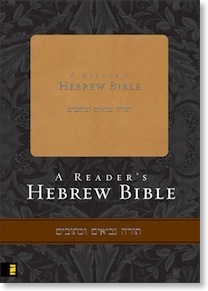
Basic features of the HRB (taken from the Eisenbraun's page) include:
- Complete text of the Hebrew and Aramaic Bible using the Leningrad Codex (minus critical apparatus)
- Shaded Hebrew names that occur less than 100 times
- Footnoted definitions of all Hebrew words occurring 100 times or less (twenty-five or less for Aramaic words)
- Context-specific glosses
- Stem-specific glossed definitions for verb forms (Qal, Piel, Hiphil, and so forth)
- Ketib/Qere readings both noted in the text and differentiated appropriately
- Marker ribbon
- Duo-Tone binding
- Considerable amount of bleedthrough due to thin paper used (the RHB is significantly thinner than the large BHS in keeping with Zondervan's "form-over-function" [my opinion] insistence on thinline Bibles).
- James likes the idea of shading proper nouns, but questions the actual execution of it.
- Points out that some of the words are too far apart because of the text's justification.
- Sees using the same footnote number for a word occurring more than once on a page to be an improvement over Zondervan's A Reader's Greek New Testament.
- Notes that the underlying text is the same as the BHS unlike both editions of the RGNT which departed from the UBS/NA Greek New Testament.
- James concludes that he would not use the RHB because his Hebrew is good enough to not need it; however, he would recommend it to those whose Hebrew skills were lacking. Says he would recommend it more heartily if the paper were not so thin.
As I mentioned in my review of the Greek counterpart to this edition, I am enthusiastic about these kinds of tools because they help students and ministers stay in the original languages and maintain them after seminary education. I've found it handy to carry a Greek NT of this sort with me to church because I don't also want to lug around a lexicon on Sundays.
With four months to go before the final release of the RHB, it will be interesting to see if Zondervan can address any of the shortcomings in this early release.
Also of interest:
- Zondervan's page for A Reader's Hebrew Bible
- My review of Zondervan's A Reader's Greek New Testament, second edition
- My review of The UBS Greek New Testament: A Reader's Edition
Gen 11:3 -- Exactly What Kept the Bricks Together?
I mentioned this fact to my class and asked for a brief survey of translations for this stuff between the bricks. I received a lot of tar, one or two instances of asphalt, an isolated bitumen, and then one fellow reading from the King James Version said his translation read slime.
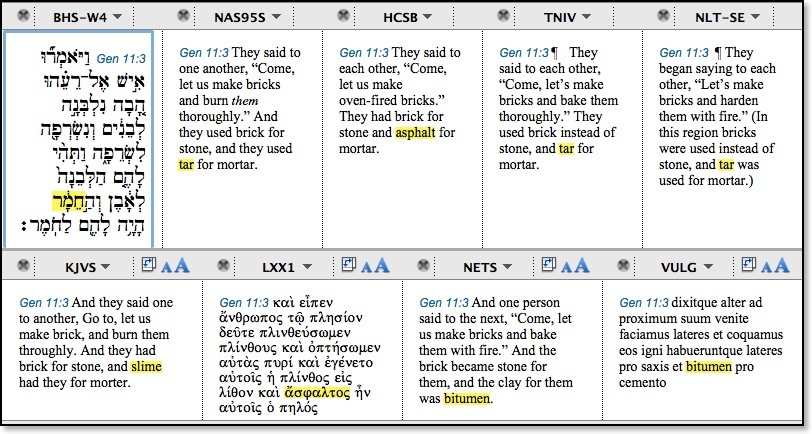
The above screenshot from Accordance displays a few major translations along with original language texts. Due to the Limitations of RapidWeaver, I'll have to transliterate, but the word in question in the Hebrew is chemar. This specific form of the word only occurs in Gen 11:3; 14:10 and Exod 2:3. It's defined in the HALOT as "bitumen, asphalt." But what exactly is that?
First, let's look at the odd man here: the KJV's use of slime. It's frankly a surprising translation to me, and not a very good one. Perhaps someone can provide insight to the KJV translators' choice for this rendering based on older definitions of the word. I wondered initially if there was any connection with the word slime to some kind of Latin meaning. But according to the American Heritage Dictionary on my MacBook, our word slime comes from the Old English slīm which is related to Dutch slijm and German Schleim ‘mucus, slime,’ Latin limus ‘mud,’ and Greek limnē ‘marsh.’ I looked in the Vulgate since the KJV translators often looked there when they were unsure about a word's meaning, but the Vulgate actually reads bitumen. Interesting.
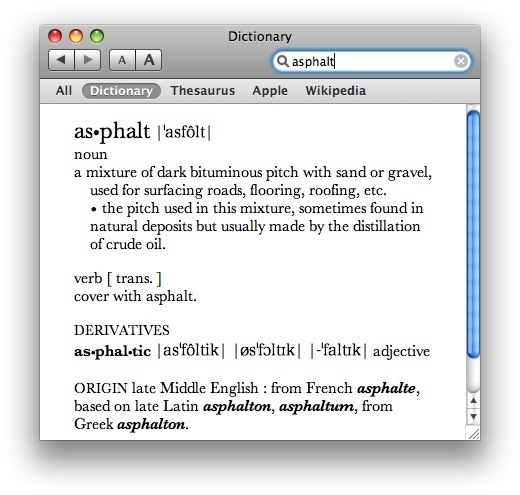
So, although it still sounds a bit odd to my ear, asphalt turns out to be an okay definition. But what about tar which so many translations use? I also associate tar with roads, and I also think of the old tar baby in the Uncle Remus stories. But what exactly is tar? Tar is defined as "a dark, thick, flammable liquid distilled from wood or coal, consisting of a mixture of hydrocarbons, resins, alcohols, and other compounds. It is used in roadmaking and for coating and preserving timber." We have that roadmaking connection to the asphalt, but there's no mention of crude oil here. Is tar a valid translation?
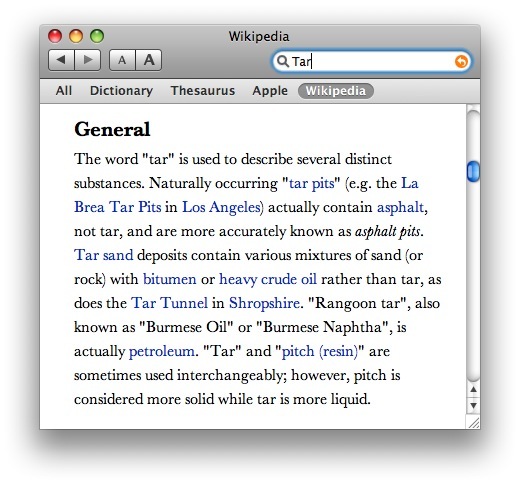
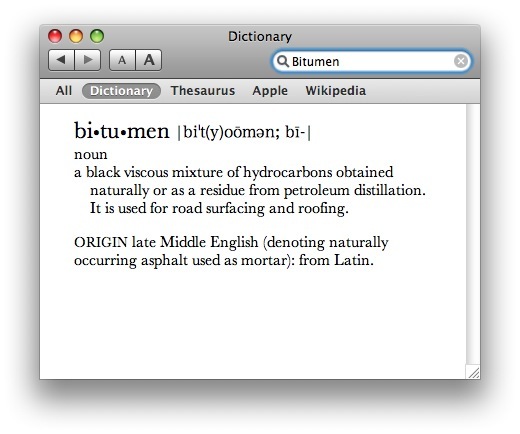
So, in the end, I believe tar, while not entirely incorrect, may not be the best rendering of chemar. Rather, bitumen or asphalt may be better choices. Bitumen is going to be a more unfamiliar word to most, I assume, but I wonder if asphalt still sounds too modern, even if it's really not?
One final point. The story of the Tower of Babel takes place, according to Gen 11:2, in the Valley of Shinar. Where exactly is that? The Anchor Bible Dictionary offers the answer:
"The meaning of Shinar is clear from the biblical references. It is the area known to the Mesopotamians as “the land of Sumer and Akkad,” corresponding to the portion of modern Iraq S[outh] of Baghdad. This meaning is confirmed by the LXX, Targum Onqelos, and the Genesis Apocryphon. All three sometimes translate “Shinar” as Babylon(ia)."
So, it's interesting that the first biblical reference to this region also refers to crude oil petroleum. It was a significant factor in life then, and it is even much more so today.
Sing it with me: "...black gold, Texas tea! Well, the first thing you know, Nimrod's a millionaire..."
The Bible Experience: Pentateuch
Before I received The Bible Experience, I had actually been listening off and on to an earlier recording of the TNIV that was simply a plain reading since the beginning of 2007. But I haven't been listening solely to that. I also listen to podcasts, lectures, sermons, and audio books on my commute. But by taking Tony's challenge, I decided to listen solely to The Bible Experience until I completed it, and offer periodic updates on This Lamp.
Now, I should be honest and say that I'm not going to finish by December 31. I am near the end of 1 Kings, and I actually finished the Pentateuch right before Christmas (so this review is late in coming). But it's been very enjoyable to listen to the Bible in large portions (the way it was originally intended).
As for The Bible Experience itself, I have to say that it's the best dramatized Bible I've ever heard. It's not perfect, but it sets the bar for such things pretty high. I'll be honest. In general, I don't like dramatized Bibles. Why? Well, because usually they're cheesy and not well done. Normally it's like this: "Then the door closed." [Thud]. The Bible Experience is subtly different with [Thud] "The door closed." In The Bible Experience, the background sounds and effects anticipate the narration and dialogue. It's very much like listening to a movie audio track without the picture.
The MP3 Edition. The Bible Experience is roughly 89 hours long. That's at least ten hours longer than the average audio Bible that is a straight reading. If you were to buy the full edition on CD, it would cost you retail $124.99 and comes on 79 CD's. 79 CD's--that's crazy! It makes much more sense in my opinion to get the MP3 edition which comes on only eight CDs (and one bonus "making of" DVD) and sells for retail $69.99. This is a much more sensible way to go, and it makes it much easier to transfer The Bible Experience to your iPod, iPhone, or other MP3-capable player.
The eight CD's contain 1217 separate MP3 files. The first CD contains installation instructions for moving the files to your computer and installing them either in iTunes or Windows Media Player. I was especially pleased to discover instructions specifically for Mac users as we are usually forgotten.
I sync segments of The Bible Experience to my iPhone and listen to it in my car via a cassette adapter.
The Pentateuch. I knew The Bible Experience was going to be powerful from the very first chapters of Genesis. The combination of music, sound effects, narration and acting is a powerful combination and as mentioned earlier, extremely well done. I'm not familiar with Matt Gibson who provides the voice of the narrator, but his voice is very well suited to what is obviously the largest task of the project. His speech is clear and almost soothing, a very good choice for a story teller. As mentioned, I'm not familiar with Gibson, but his voice reminds me of the actor Dennis Haysbert who currently is the spokesman for Allstate commercials. My only real complaint against Gibson is when he occasionally mispronounces a name, but I suppose I can blame the director for that.
For the uninitiated, the cast of The Bible Experience is composed entirely of African American actors, celebrities and other well-known figures. Some have better abilities as voice actors than others. Pastor Paul Adefarasin provides the voice of God throughout the Old Testament. According to a profile on Amazon.com, Adefarasin is Nigerian which in the cast of mostly American voices gives God's voice a noticeable distinction. I'll admit that at first Adefarasin's voice seemed so soft, I had to turn up the volume of my car stereo to hear it. But now that my ears are attuned to Adefarasin's distinct accent, I have no trouble hearing him. Another voice that seemed too soft spoken was that of Abraham's voiced by T. D. Jakes. I never got used to Jakes' voice and frequently had to turn him up.
Some voices are instantly recognizable such as Robert Guillaume as Noah. Someone like Guillaume comes across very well which no doubt reflects his ability as an actor. And Potiphar's wife, voiced by Mo'Nique sounded downright sultry when she propositioned Joseph. However, Danita Patterson's line as Zipporah in Ex 4:25 "Surely, you are a bridegroom of blood to me" fell extremely flat and without emotion.
I know many will disagree with me on what I'm about to say, but personally I feel the worst casting that I've heard so far is Forest Whitaker as Moses. I've very much enjoyed Whitaker's performances elsewhere in the past, but his voice is not "old" enough for Moses, and even worse, Whitaker delivers an absolutely flat performance. Deuteronomy, in which Moses reads the Law to the Israelites was practically unbearable and the only point in listening to The Bible Experience that I was tempted to fast forward or skip a few chapters (however, I did not). Whitaker failed to deliver any emotion whatsoever until Deuteronomy 27, when finally he started to sound like a preacher in rhythm with a congregation. But in what was surely a director's mistake, the refrain "Then all the people shall say, 'Amen!'" was not voiced by the crowd.
Listening in large blocks to an audio Bible offers the listener great insights that might be missed otherwise. Moses' question to God, "Suppose I go to the Israelites and say to them, ‘The God of your fathers has sent me to you,’ and they ask me, ‘What is his name?’ Then what shall I tell them?" in Ex 3:13 is significantly set up by the fact that the name of God is conspicuously absent from most of the Joseph narrative. This was something that I could hear, but it's harder to read and spot such things.
And I have to admit that my face contorted as I winced in reaction to Genesis 34:25 as the narrator says "while all of them were still in pain" [from their circumcision] and the listener can hear men actually groaning in the background!
So far, The Bible Experience is just that--an experience. In spite of some criticisms, I again state that it is the best dramatized Bible I've heard, and one I highly recommend. I'll report some more when I complete my listening to the historical books of the Old Testament.
Review: CEV Outreach Edition Bible
Here's the timeline:
- On December 12, 2007, Lingamish (a.k.a Lingermush, a.k.a. Flingafish, a.k.a David Ker) emailed me asking if I'd be willing to review the CEV Outreach Edition Bible, which he was willing to send me for free. Since I think David is a swell guy, and because I have a psychological inability to turn down a free Bible, I agreed.
- On December 13, David announced on his blog that he was giving away a case of CEV Outreach Edition Bibles.
- On December 15, Steve Ker (David's father) emailed me saying that he had mailed the Bible.
- On December 21, Kathy and I left for Louisiana for the holidays. I looked in my mailbox one last time before we pulled out, but sadly the Bible had not yet arrived.
- Late Monday, December 31, we returned. The Bible had arrived when I got my mail from my neighbor on January 1.
- Today is the first chance I've had to write something. My apologies. Hope it isn't too late.
When David originally emailed me asking me to review the CEV Outreach Edition Bible (CEVOEB from here on), he stressed that he wanted my opinion primarily on three factors: (1) strength of binding, (2) attractiveness, and (3) suitability for a Bible to give to an unbeliever. So, I'll follow that general outline, perhaps slightly altering the categories.
PHYSICAL PROPERTIES
The CEVOEB is a paperback Bible of approximately 840 pages. It measures 5 1/4" x 8 1/4" and looks to be about an inch thick. The paper is newsprint and the binding is glued. I wouldn't think that the CEVOEB is designed to be a legacy Bible, but that doesn't mean it will disintegrate overnight. I still have a paperback Good News for Modern Man NT that belonged to my parents and dates from the late sixties or early seventies. All pages are intact and it has the same binding as the CEVOEB. Further, I have a paperback NRSV that I got at the Urbana '96 Missions Conference which I've carried in my vehicle ever since I got it for times when I needed a Bible and didn't bring one of my "regulars." It's even withstood rainy weather at the Cornerstone Festival and keeps on going. All that to say, that although the CEVOEB is designed as an economical (they sell for $2.15 each on the ABS website) outreach, there's no need to fear that it might not stand up to continued use.
FEATURES
The biblical text of the CEVOEB is presented in two columns. To conserve space (i.e., take up as few pages as possible), there is very little margin between these columns, but a vertical line is used to divide them. The text includes the full complement of CEV textual notes at the bottom of the page in a single column. In what I believe is a standard feature of the CEV itself, the only technical abbreviations in these notes beyond those for the books of the Bible, are c. (CIRCA), OT, NT, and LXX.
Considering the purpose of this Bible (an economical outreach edition), my only real complaint for this edition is the size of the print. However, that may just be me, as regular readers of this blog will note that I almost always complain about text size. I would guess that the text is about a 7 pt. size, but it may be smaller. It uses a serifed font with bold type for chapter and section headings. I can read it without my reading glasses if I try, but it's much better with them on. I personally, would not want to spend long periods of time reading text this size, but again, that's me, and a younger person's eyes probably wouldn't have any problem with this text (I used to carry a pocket Bible when I was in high school and college, but don't use it anymore).
One feature of this Bible I really like is that it separates the biblical texts from the helps which are included in the back of the Bible. I know from experience working with people who have little or no background with the Bible that often the helps get confused with actual scripture. That shouldn't happen with this edition, but I do believe it would be a good idea for the person giving away this Bible to point out the helps in the back.
Following the Book of Revelation, one finds three helps, a section called "What's In the Bible," a mini-dictionary, and maps. The text of these sections is sans-serifed and easier to read in my opinion than the main scripture text. The text of the mini-dictionary is the largest continuous text in the entire Bible.
The "What's In the Bible" section contains brief introductions to the various books of the Bible. The information is very basic and short (about one paragraph per treatment) and not meant to be a scholarly introduction. Some books are treated together such as 1 & 2 Samuel, Ezra and Nehemiah and the four gospels.
The mini-dictionary is arranged topically, but includes both a section index and an alphabetical index. I like these kinds of features in Bibles of any sort (similar to the HCSB bullet point dictionary or the Dictionary of TNIV terms in Bibles of those translations). The meaning of some words, especially those of a cultural or historical nature are impossible to fully communicate in a translation. These kinds of dictionaries are the answer in my opinion, barring notes at the bottom of the actual text. An example of one of these entries in the CEVOEB is that for Amalekites which is under the heading "Cities, Nations, and Groups of People." Here the Amalekites are simply explained to be "A nomadic nation living mostly in the area south and east of the Dead Sea. They were the enemies of Israel." The mini-dictionary contains more than just definitions for mere words, however. It also includes items such as important dates in biblical history (designated using "BC" and "AD") and there is also a listing of the months in the Hebrew calendar.
Following the mini-dictionary the reader will find ten black and white maps: four on the OT and six for the NT, although four of the latter are half-page maps. An index to these maps would have probably been helpful.
USE AS AN OUTREACH EDITION
The CEVOEB has almost all of the standard features one would expect in an outreach Bible. Some outreach Bibles include "plans of salvation," but since such plans have come under scrutiny in recent years, perhaps it's best to let the presenter decide how to communicate the Good News.
One of the greatest strengths of this edition is the Contemporary English Version itself, an excellent "introductory" translation and one that has enough solid scholarship behind it that it can receive continued use even as a person matures as a believer. This review is not designed to be one for the CEV, although I would expect that I will do that eventually (right now I'm working on a review of the NET Bible). Personally, I would never give away a formal equivalent translation in an outreach situation, but rather offer median to dynamic equivalent translations instead. But even median translations often presuppose a certain amount of biblical literacy, so a purely dynamic translation like the CEV is ideal for the unchurched and in situations in which the presenter simply doesn't know the receiver's background.
The only real complaint I've ever had with the CEV is its flattening of Hebrew parallelism. However, discussion on Hebrew poetic structure are probably not going to come up in outreach situations, so this would not be a concern here for me.
In the past, I've given away outreach editions of the NIV, NLT, and GNT. I'd have no qualm in giving out this edition. It's a very good choice.
Because of its size and format, the CEVOEB looks more like a paperback book than a Bible, also making it ideal for outreach purposes. It can be thrown into a backpack easily, and because of the price, one will not worry too much about it getting banged up a bit.
As mentioned earlier, the American Bible Society offers these Bibles for $2.15. However, looking up the same ISBN on Amazon shows them going for as low at 1¢ (yes, one cent). Now, buyer beware as often resellers find what they believe is an equivalent ISBN for what turns out to be a different product; but nevertheless, if you are wanting to find the CEVOEB at an even cheaper price, this might be the ticket.
Regardless, David, this is a good choice and an excellent outreach Bible. Sorry the review took so long to post!
Trans. Abbrev. Conf.
Abbreviations are a helpful thing. When talking about Bibles, it's much easier to simply write "NLT" than New Living Translation every I want to reference it.
I don't always remember to do it, but when writing a blog entry that refers to a translation, I try to write it out the first time I reference it along with the abbreviation in parentheses which I simply use from that point forward.
With the advent of the New American Standard Bible in the 1970's we got the four-letter abbreviation, "NASB," followed by the NKJV, NRSV and now the HCSB (which we have recently heard is going to soon be reduced to simply the three-letter "CSB").
A lot of us who discuss translations regularly take these abbreviations for granted, but surely they cause confusion now and then to the unititiated.
So as excited as I was to see the release of the New English Translation of the Septuagint (which in my opinion is the first significant English translation of the Septuagint since Brenton's of 1851), I was very disappointed in its acronym: NETS. And yes, that IS the acronym as it is set by the publishers on the copyright page with the statement:
"A New English Translation of the Septuagint may be quoted in nonsalable media (such as church bulletins, orders of service, liturgies, newsletters, etc.) without inclusion of a copyright notice, but the abbreviation NETS must appear at the end of each quotation."
What's the problem with "NETS"? Well, to me, it is way too close to NET (New English Translation) which was already too close to NEB (New English Bible).
NEB = New English Bible
NET = New English Transltion
NETS = New English Translation of the Septuagint
And, of course, none of these three translations have anything to do with the others.
I wonder where all the creativity has gone in naming translations. I also wonder if the NET Bible was even on the radar of the NETS editors when they came up with the name. Although I personally consider the NET Bible a major translation (and my review is finally in the works), it has not received the exposure it deserves because it (to my knowledge) is only available through mail order.
Some might feel the nearness of the acronyms to the NEB is a non-issue because it is now nearly four decades from its last edition before the REB. However, I still occasionally come across NEW reference books that refer to the NEB--sometimes in EXCLUSION to the REB which has been available for almost two decades!
So, I see room for all kinds of abbreviation confusion, especially between the NET and NETS. And one would think that with 26 letters of the alphabet, we could come up with a few more unique combinations!
Blum on the HCSB at Anwoth

Blum is incredibly transparent about disagreements among the translators and even the publishers. Also, Blum goes to great length to distinguish the HCSB from other translations and combat the notion that this is a "Baptist Bible" (Blum himself is not Baptist). You must read the entire interview, but here are some of the more surprising elements about the HCSB and Blum that were revealed:
- A second edition of the HCSB will be released in 2009.
- Why "beer" is used instead of "strong drink."
- When the project first started by Arthur Farstad, there were parallel tracks for the HCSB in which there were to be two New Testaments, one based on the Majority Text and one based on the Nestle-Aland text. The Majority Text project was dropped after the death of Farstad.
- Southern Baptists (does he mean Lifeway here?) tried to BUY the NASB from the Lockman Foundation three times--and it almost went through!
- We finally get a better understanding of the relationship of the HCSB to the Logos21/Living Water Gospel of John.
- Blum explains the complicated history behind the name "Holman Christian Standard Bible" and reveals other names considered. Every name including the current one has legal issues, though.
- According to Blum, "Holman" is already being downplayed in the logo and will soon disappear altogether leaving the designation simply "CSB."
- Mounce sent Blum an email stating that the HCSB is the first translation to get John 3:16 right. (I think I said that, too, a while back!)
- Currently, the HCSB uses the designation "Yahweh" instead of the traditional "LORD" (all caps) 75 times. In the 2009 revision, that number will grow to 400.
- Awkward terms like "deluge" and "atmospheric domains" will NOT appear in the 2009 revision.
- Blum explains the decision to go with the half brackets around some words that are added for clarity, but admits he was not in favor of doing it.
- The HCSB translators hate red-letter editions, but publishers love it.
- Farstad was not a Baptist but was a Brethren. Blum is Presbyterian. Only about 1/3 of the translators were Southern Baptist. This hardly justifies the HCSB's reputation as the "Baptist Bible."
- Blum claims that the HCSB is outselling the ESV two to one.
- Agrees that the HCSB website is hard to use.
Good stuff. Really good stuff.
The Best Bible Translation
I do not really believe that there is a BEST translation out there for all people, preferring to ask, “Best for what?”
When studying the Bible, my habit is to start with the original languages (especially with the NT as my Greek is much stronger than my Hebrew), and first work out my own translation. I admit that I don't always do this, especially if I'm about to teach a "well known" passage--that is, one that I've taught before. But when I have the time, I find great value with beginning with the original languages, and then referencing English translations as well. I find that the nuances between translations help me better understand the original languages themselves, especially if there’s great difference from my own translation.
My Core Translations. I have a “core” of first-level English translations I refer to which I believe span the range from formal to dynamic. On the formal side, I will read from the New American Standard Bible (NASB), which is also the Bible in which I still make my “permanent” notations in its wide margin. In the median range, I consult both the Holman Christian Standard Bible (HCSB) and Today's New International Version (TNIV), two very good recent translations, but with different approaches to translating gender in some passages. On the dynamic range, I take a look at the second edition of the New Living Translation (NLT). The scholarship is very solid in this translation, and sometimes its dynamic flavor actually brings out the meaning of the passage better than more literal translations.
Secondary Translations. If I have time, I have a secondary tier of translations that I will consult from including the New English Translation (NET or NET Bible), New Revised Standard Version (NRSV), English Standard Version (ESV), the TANAKH from the Jewish Publication Society (JPS), Revised English Bible (REB), King James Version (KJV) and occasionally a few others. I don't have a large KJV constituency in the groups I teach, but if I did, I would probably move it to the core translations I look at. As for the NET Bible, I like the notes so much that I often consult them early when studying a passage, sometimes before I hit commentaries and other reference works in order to get a quick history of textual issues and interpretation.
Physical vs. Electronic. When I study a passage, I don’t have dozens of Bibles in front of me as I tend to use parallel panes in Accordance for a lot of this work. I may have a Greek NT in front of me because I sometimes like to make notes about the grammar or a word or phrase in the margin. Interpretive and explanatory notes I’ll write down in the wide margin NASB that I’ve already mentioned. And I might also have a TNIV with me since in the last year and a half I primarily have begun to use this when teaching or preaching in public. The margins in my TNIV are much more narrow than those in my NASB, so I can add a few notations, but I have to be selective.
Primary Bible Recommendations. When people ask me to recommend a translation, currently I am only recommending the HCSB, NLT and TNIV as a primary Bible, although I do suggest getting a good formal equivalent Bible such as the NASB to read in parallel. These three that I recommend also happen to be the three that I mostly use in public. Most of the time I teach out of the TNIV. However, sometimes in my preparation, I find a passage in the HCSB that simply seems to be rendered more accurately and I'll opt for that. When speaking in front of groups that I believe may include those who are not Christians or those with less background in the Bible, I often opt for the NLT because it is much closer to conversational English than other translations. For Catholic believers, I recommend the New Jerusalem Bible (NJB) over the New American Bible (NAB). The NRSV has the widest collection of Intertestamental books of any translation, with which more Christians should acquaint themselves.
Best for Children. I still believe the Good News Translation (GNT), especially one with the line drawing illustrations, is the best translation for a child who is just learning to read. Sadly, though, these are becoming more difficult to find.
Favorite for Reading. My favorite Bible strictly for reading is the REB, which is undoubtedly the best literary translation of the Bible since the KJV, but without the archaic baggage.
For more information, consult my series on my "Top Ten Bible Versions."
Note: This post is an expansion of a comment I left over at Said at Southern.
The Forbidden Fruit Was Actually A Papaya
“So she took some of the fruit and ate it.
Then she gave some to her husband,
who was with her, and he ate it, too.”
(Gen 3:6 NLT)

Yesterday, in our Bible study class, I taught on Genesis 3. During my preparation I came across an interesting bit of trivia--how the apple became associated with the forbidden fruit. You know what I'm talking about right? In most popular conceptions of the story, it's an apple that Adam and Eve partake of in violation of God's command, resulting in their fall from innocence and banishment from paradise. I believe I even had a Bible story book or two as a child that specifically said they ate an apple. But as soon as I could read the story for myself, I found out that nowhere is any specific fruit mentioned, let alone an apple (of course, I was also disappointed while still quite young when I couldn't find anywhere in the Bible that Jesus' cross was made from a dogwood tree). So how did an apple get connected to the story? Well it seems that the Latin word for apple is malum, while the word for evil is malus. The phonetic connection between the two words became the key to the association down through the ages. So much for keeping the doctor away...
Eleven Ways to Care for Your New Bible
Here are a few tips for taking care of your new Bible so that it will be of service for years and decades to come.
- Unpack it carefully. It's cold this time of year. So if your new Bible has been sitting on a mail truck for the last few hours or even days, be very careful when you first open it. Most Bibles, even those with sewn bindings, use glue to some extent. Cold weather can make that glue brittle. Opening a Bible that's been in the cold can instantly create a permanent crease in the spine where the glue will actually break. If your Bible has been out in the cold, it might be best to let it come to room temperature before laying it open flat. When examining your new Bible for the first time, gently and slowly open it.
- Inspect it carefully. All Bible publishers have generous return policies if you find a serious defect in your Bible. Be careful with gilded page edges as these will probably be stuck together. I've seen pages torn from being separated too quickly. There are actually methods for separating multiple pages at a time such as gently bending your Bible one way and then the other to let the pages separate. Also look for printing flaws. I've seen it all. Missing pages, missing books of the Bible, maps out of order, and printing defects. For whatever reason I regularly end up with printing defects in a new Bible in which a page has been improperly cut on a corner and is folded up into the Bible. Sometimes two pages were never separated. If you decide to keep a Bible like this rather than returning it, don't tear the pages apart, but use a sharp pair of scissors to separate them. Then, if the corner of the page is greater than the other pages, use the scissors to trim the page slightly shorter than the other pages. Any page sticking out will become ragged over time, but cutting the page a bit short will solve this problem.
- Use your hands. The best method for softening a bonded leather or genuine leather Bible is to simply hold it in your hands regularly. The natural oil from your hands (the stuff that leaves fingerprints everywhere) is what softens Bible leather. Keeping your Bible in a Bible cover/case at all times is actually one of the worst things you can do for a Bible, although many people mistakenly believe they are taking care of them this way. I've seen leather Bibles start to crack along the edges of spine because they were kept in protective Bible covers and never allowed to soften from regular use in someone's hands. If you live in an area with lots of bad weather and need to use a protective Bible cover, take it out of the cover when you are actually reading and studying from it. By the way, number of the newer imitation leather covers come already feeling so soft, they seem to already have seen years of use--kind of like buying pre-faded jeans. But no one really knows yet how these new kinds of imitation leathers will hold up after many years of use. If you definitely want the Bible to be around for a long time, select a leather cover.
- Keep your Bible out of the rain. You think this would be a no-brainer, but not necessarily so. If it's raining and you need to carry your Bible, try to hide it under a jacket or put it in a bag or even a Bible case (but take it out when you use it--see #3). Rain drops will cause those ugly looking spots on the silver or gold gilding your Bible has on its page edges. If you get caught in the rain and have no protection for your Bible, hold it spine up to keep water off the paper as much as possible. Not only does rain cause the aforementioned spots, it also will seep into the pages and cause wrinkles and possibly even create smears of ink if you've taken notes in your Bible.
- Don't leave your Bible on the dashboard of your car. When I see a Bible on someone's dash on Thursday in some parking lot, I know that its probably been sitting there since Sunday and the owner hasn't been reading it. More seriously, a dashboard is one of the worst places to keep your Bible. The windshield intensifies the rays of the sun and will dry out the leather. In the hot summer time, this is about like putting your Bible in an oven. In the wintertime, not only can it dry it out, but you also run the risk of hardening any glue in the binding, causing a break when you go to use it next (see #1).
- Use the right kind of pens and highlighters for taking notes. Never use wet highlighters or felt tip or fountain pens in your Bible as this ink will bleed through the thinner than normal pages. Instead, use dry wax highlighters that can be found in most Christian bookstores and some office supply stores. And for writing, employ a pen that uses archival ink such as the Pigma Micron series. These can be purchased at most arts and craft stores and on the internet.
- Tie off the end of your ribbon marker. Don't do this immediately, but if your ribbon marker starts to fray (most usually will eventually), tie the end of it off in a knot and it won't get any worse.
- Don't bend your cover over backwards. Not only will the librarian tell you this is a no-no for library books, I'll tell you that you should never do this to your Bible. I often see preachers bending a Bible all the way over to where the top and bottom covers are touching. This stretches the spine of your Bible and can possibly break it. This often leads to pages falling out, even from Bibles that have sewn bindings. Most Bibles are designed to lay open in one hand and feel limp. But it shouldn't be pushed back any further than this.
- Unfold curled pages. If the corner of a page folds over for whatever reason, unfold it as soon as possible. Inspect your Bible for this regularly because the turned down corners may eventually crack and come off. I've seen many missing page corners in older books and Bibles. Of course, it should go without saying to never fold over the corner of a page to mark your place. This is what a marker ribbon is for. Or use some other kind of bookmark.
- Don't stuff a bunch of material between your Bible's pages. Don't clutter up your Bible with 18 weeks' worth of previous church bulletins or even your current Bible study guide. The spine of your Bible was designed to support the number of pages within your Bible and that's it. Cramming a bunch of extra stuff in there increases your risk of breaking the spine. The librarian's rule is to mark your place with nothing thicker than a sheet of paper. Basic cardstock bookmarks are fine as well.
- Protect Your Bible from pets and very small children. You know how good that new leather smells? It smells even better to your pet! I've seen quite a few Bible covers that had become partial puppy snacks. If you have a dog, especially one that's under a year old or one with a tendency to chew on leather, keep your Bible up high and out of reach when you aren't using it. Also, I've seen very young children take great delight in tearing out those thinner Bible pages. Also, a child may not know the proper way to carry a Bible, and may drag it around by the pages or one end of the cover. Obviously, this isn't good for the health of your Bible. The best bet if pets and toddlers are around is to simply keep it up high.
Most Bibles, especially those with leather covers, are designed for years and decades of use. Proper care of your Bible will create a cherished family heirloom as opposed to the uncared-for Bible that may sadly be tossed in the trash one day.
If you have other tips of your own, feel free to add them to the comments section.
TNIV Reference Bible: Hands On Review
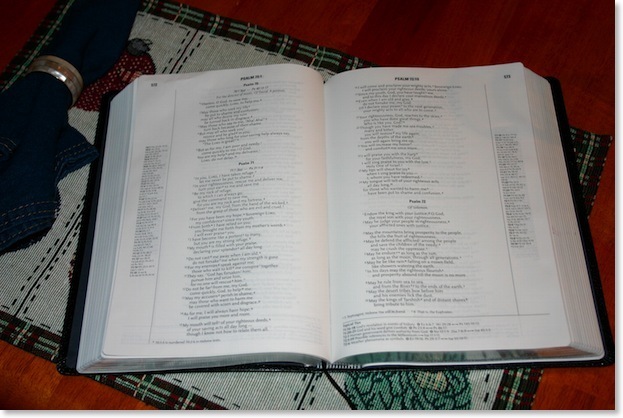
The official word from Zondervan states that the TNIV Reference Bible's official release date is January 2008. However, Christian Book Distributors is showing availability "on or about" December 10 (as of this writing, CBD did not have any copies yet). The TNIVRB has been a highly anticipated Bible for a number of reasons. The complete TNIV translation has only been in circulation for about two and a half years, andI started teaching primarily from it in the latter half of 2006. However, my greatest complaint at the time was that I couldn't find a copy of the TNIV that didn't draw attention to itself. That is, I couldn't find one that wasn't in neon colors, let alone one with a simple traditional look and feel. Further, I had difficulty find a text layout that I liked. I prefer a single-column text with wide margins for taking notes. Yet, at the time, I couldn't even find a single-column edition of the TNIV.
Then, in September of 2006, I laid eyes on proofs for two different editions of the TNIVRB that were being circulated by Zondervan. One contained the single column text which resulted in the final copy, but the other was a two-column text with cross references in the middle. I quickly cast my vote with the editors at Zondervan for the single-column text. Of course, I made a number of other suggestions, too, including those elusive wide-margins and also suggested moving the cross references to the inside of the page. Zondervan hasn't taken those two suggestions to heart yet, but I'll keep pushing. Besides my vote for the single-column text, the only other influence I feel I had on this edition was to press for a non-thinline edition. Unfortunately, this change in plans pushed the publication of the TNIVRB from October to now, and raised the price by about $5. Nevertheless, after quite a bit of waiting, the TNIVRB in its final form arrived in my mail today, a generous gift to me from my friends at Zondervan.
Zondervan aims the TNIVRB at pastors, students, and teachers. Further, their goal was to make the Bible high quality but sell it as low of a cost as possible to get it in as many "gatekeepers'" hands as possible. Therefore, the TNIVRB does not come in the tradition box that most high-end Zondervan Bibles include, but rather a cardstock slip cover. But as for the Bible itself, it appears to be very high quality. Currently, there's only one edition--black bonded leather--but that leather feels quite solid. More importantly, the binding is smyth-sewn so that the user won't have to worry about chunks of pages coming unglued.
I suppose I was most surprised about the size and weight of the Bible. As already mentioned, I lobbied Zondervan strongly not to make the TNIVRB a thinline Bible. After gaining support from other TNIV fans in the blogosphere, Zondervan announced in May of this year that the TNIVRB would measure in at about 1.25" thick. Well, when I got my copy in hand this evening, I immediately thought it looked thicker than that, so I measured it. I can tell you that the TNIVRB is actually about 1.5" thick, and I can't tell you how excited I am about that. This means thicker paper was used in the TNIVRB which will allow for less bleedthrough of text from underlying pages or personal notations.
Further, the TNIVRB feels good in the hand. It has just the right weight when holding it open, Billy-Graham-style in one hand. I like the TNIVRB because it both looks like a Bible and feels like a Bible! As shown in the picture above, it lays flat when laid on a surface. I don't mean that it merely stays open; it lays flat. Does it lay flat at Genesis 1? Well, not quite flat, but it stays open, which is more than I can say for my TNIV Study Bible that I wrestled with while teaching out of Genesis at church last Sunday. And I'm sure given some time, and once the cover absorbs the natural oil from being held in hand, that it will even lay flat at Gen 1.
As mentioned already, the cover is a black bonded leather. This is complemented by silver lettering and gilding of the pages' edge. The spine itself doesn't contain hard corners, but is semi-rounded which contributes to its look of high quality. The text on the spine is fairly simple. "Holy Bible" runs sideways, while "TNIV" and the current three-tiered Zondervan logo sit perpendicular and occupy the bottom 25% of the spine's area. A single black ribbon is included for marking one's place.
According to the publisher's website, the TNIVRB runs at 1,408 pages. Some pages, such as those designating the Old and New Testaments, and even sections of books within those categories have been seen in some other editions of the TNIV. But most of the TNIVRB is brand new layout. The main text pages themselves contain layout and text that looks anything but rushed. Frequent section headers help to set off pericopes, allowing the text to flow with plenty of free space. The main text font measures at 9 points and is adequate for a Bible of this size. In comparing pages in the final product to the proofs I saw in 2006, it may be that Zondervan slightly enlarged the type from the original concept as slightly less text appears on the pages in the published TNIVRB. Such changes are always welcome.
Thankfully, all text is BLACK, meaning no red lettering (I can hear the applause coming through the internet now).
Cross references run along the outer edge of the page and a new feature, "Topical Ties" run along the bottom. The Topical Ties treat subjects in the text along 700 or so categories. The reader is guided by markers demonstrating earlier or later texts which focus on the same subject. Unfortunately, an index to these topics is not included, but I would think it might be helpful if something like this were made available online.
Heavy note-takers, such as myself will find the TNIVRB mixed for note-taking. Some pages have a lesser number of cross references in the margin allowing for notes, but more "well-travelled" passages contain a full margin of notes that often spill over into the bottom of the page. Poetic sections, however, offer ample room for notations.
Nevertheless, between the cross references, Topical Ties, and parallel passage notations under section headings, the TNIVRB is the ultimate reference Bible. According to the slip cover, there are over 100,000 cross references alone. And Zondervan is claiming that the TNIVRB is the most comprehensive reference Bible available.
In the final analysis, the TNIVRB is the edition of the TNIV I wish I had been using from the very beginning. Nevertheless, late is better than never. Everything about it says this is a quality product, and while it isn't everything I finally want in an edition of the TNIV (I'm still holding out for wide margins), it will replace my TNIV Study Bible as my public TNIV of choice. I know a lot of people have been waiting for this Bible, and I'm glad to say that there are no final "gotchas." The TNIVRB is everything it was promised to be. I can readily recommend it to anyone wanting a regular reference edition of the TNIV, and it will be the edition that will receive the majority of my use.
The UBS Greek New Testament: A Readers Edition (A Hands-On, Comparative Review)
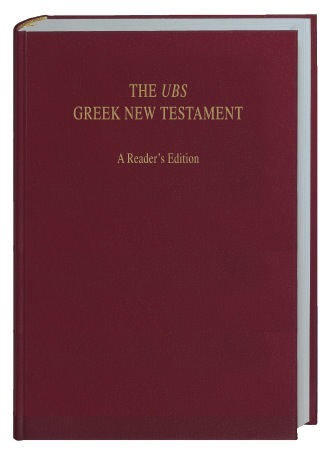
If you haven't read it already, I highly recommend that you see my earlier review of A Reader's Greek New Testament, 2nd Edition from Zondervan for a greater context in understanding this review. If you don't have time to do that, there are four things you should know right up front:
- The UBS Greek New Testament: A Reader's Edition (henceforth UBSRE), is similar in nature to Zondervan's A Reader's Greek New Testament (RGNT from this point forward) which has been published in two separate editions. The first was based upon the Greek text underlying the NIV, and the second is based upon the Greek text underlying the TNIV. All three of these New Testaments include a Greek text with a vocabulary apparatus at the bottom of the page containing definitions for all words that occur less than 30 times in the New Testament. The purpose of such an edition is to allow the reader with at minimum a basic foundation of Greek study to simply read the New Testament in Greek without having to constantly consult a lexicon for words not in one's working knowledge.
- As I explained in the previous review of the RGNT2, although I originally bought the Zondervan RGNT1 for the novelty of having the underlying NIV text, I actually found the volume quite useful, especially as a tool to throw into my book bag that I carry to church on Sundays. I found the idea of a Reader's New Testament in Greek with the vocabulary apparatus is extremely handy when I simply needed to consult the text and wasn't worried about text critical issue or didn't have the time to look up complete definitions in my BDAG lexicon.
- I was never fond of the italic text in the RGNT1, but it was bearable. I was extremely disappointed in the release of the RGNT2 in that although the text was changed to a non-italic font, it used a style with thinner character strokes that actually made the text more difficult to read in my opinion.
- Finally, about a year or so ago, a professor at a seminary extension contacted me wanting to know if I had heard whether the RGNT was being discontinued due to threat of a lawsuit from the United Bible Societies or the German Bible Society. I could not confirm any such lawsuit at the time or that the RGNT was being taken off the market (it was not). However, I did confirm from an off-the-record source recently that there was talk of an actual lawsuit, but it was deemed that since the standard eclectic Greek New Testament is based upon public domain ancient manuscripts, such a suit would not be able to stand up in court.
I'm happy to report that nothing ever came of the lawsuit talk. I would have greatly disappointed (especially in light of 1 Cor 6:1ff) if one Bible publisher had decided to sue another Bible publisher. Rather, the German Bible Society decided to create their own edition of a Greek New Testament similar to Zondervan's RGNT. The UBS version, however, is based upon the UBS Greek New Testament, fourth revised edition. The main features of the UBSRE include the following:
- Translation of all vocabulary items occurring 30 times or less in the New Testament at the bottom of the page
- Translations given according to context
- Definitions of idiomatic word combinations
- Grammatical analysis of all difficult verb forms
- Reader-friendly layout enabling the reader to transfer easily from text to dictionary and vice versa
- An appendix providing translations of all vocabulary items occurring more than 30 times in the New Testament
- The maps from the USB Greek New Testament.
I find it impossible to review the UBSRE without reference to Zondervan's RGNT, so I would prefer to offer a comparative review. From the outset, the immediate difference between these two is size. Although, both have about the same dimensions in height and width (both volumes are around 6" x 9"), the UBSRE is essentially twice as thick as the RGNT. Zondervan's product page for the RGNT states that it contains 576 pages, while the German Bible Society's product pages lists the UBSRE at 712 pages. So why is the UBSRE twice is thick as the competing product, even though it is less than 200 pages longer? Well, it has to do with the very thin paper and space-conserving format used in the RGNT, but I'll write more about that in a moment.

Admittedly, I like the soft, leather-like Italian DuoTone cover on the RGNT better than the hardcover binding of the UBSRE. The Zondervan product feels like a Bible, while the UBS edition feels like a book. The UBSRE is bound in what has become the signature burgundy cover with gold lettering that is used with most editions of the UBS Greek New Testament. However, I know that they also produce flexible covers, and I believe one would be appropriate for this edition.
Nevertheless, it's what's inside that counts, and this is where the UBS shines. I'll get to the layout issues in a moment, but first a few comments on the vocabulary apparatus. The apparatus itself is referred to in the introduction and on promotional materials as a "Running Greek-English Dictionary." The RGNT has this, too, of course, but the UBS edition may just be better. The definitions have been adapted from Barclay Newman's Concise Greek-English Dictionary of the New Testament contained in many UBS editions of the Greek New Testament. Of course, because of space, the definitions have been shortened based upon the context. Therefore, the the contextual decision may theoretically imply some amount of interpretation upon the editor's part, but this would not be any different from using Trenchard's glosses in the RGNT. Further, the running dictionary is not meant to replace use of a lexicon, but merely to allow quick access to the meaning of the text in certain contexts.
The UBSRE also breaks with the Zondervan editions in that it offers grammatical help on what the editors consider more difficult forms. So for instance, in John 1:42, both the UBSRE and the RGNT offer a definition for ἐμβλέψας. The RGNT: "ἐμβλέπω, I look at, consider." The UBSRE: "ἐμβλέπω aor act ptc m.s.nom, look straight at." For many readers, this extra grammatical information is going to be very helpful.
Like the RGNT2, the UBSRE also offers a mini glossary of Greek vocabulary words occuring more than 30 times (the ones that don't get listed with the text) in case the reader simply forgets what shoudl be a memorized word. But this is also a place where the two editions differ greatly. The word list in the RGNT2 is based on Warren C. Trenchard's Complete Vocabulary Guide to the Greek New Testament, so it's definitions are fairly short as one would expect. So, for instance, if one were to look up ἀγαθός in the RGNT2 appendix, would would find this entry: "ἀγαθός, ή, όν (102) good" (the numeral indicates how many times the word occurs in the Greek NT). However, because the definition appendix in the UBSRE bases its entries on Barclay Newman's dictionary, one will find a much more detailed entry: "ἀγαθός, ή, όν good; useful, satisfactory for one’s (its) purpose, fitting, beneficial; sound (of trees), fertile (of soil), happy (of days); in a moral sense upright, just; kind, generous; clear (of conscience); perfect, inherently good (of God); τὸ ἀγαθόν the good, what is good; what is right or upright; what is beneficial or advantageous; τὰ ἀγαθά goods, possessions; good things (Lk 16:25); good deeds (Jn 5:29)." That's quite a difference, but to be fair, one could argue that the RGNT2 offers the most essential information with the understanding that more detail can be derived from other resources. But again, for some readers, this extra information will be seen as quite helpful. I should also point out that the glossary in the RGNT only fills a little less than six pages, while the corresponding feature in the UBSRE fills 22 pages.
This leads me to what I believe is the most significant difference between the UBSRE and the RGNT2: layout and readability. The UBSRE is simply easier to read than the RGNT2. It's font is larger and the text is laid out leaving more white space on the page. Further, the running vocabulary list in the UBSRE runs in a two-column list which allows one to easily find the word he or she is looking for.
I took my own scans of each edition for this review rather than relying on the PDFs made available from each publisher. I thought this might give a fairer comparison between each edition. If the lines don't seem quite straight, it's from a less than perfect attempt on my part to hold the volume flat on my scanner.
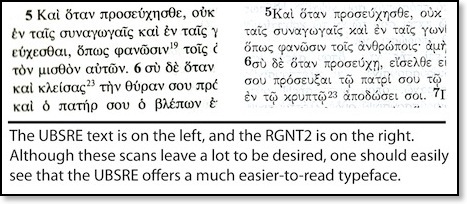
As I stated in the review of the RGNT2, part of the problem comes from my perception that Zondervan, normally a maker of quite excellent reference works, has an unhealthy preoccupation with thinline Bibles. Since the RGNT is a New Testament, someone in marketing or layout and design must have suggested than a thinline form factor be adopted. I'll be the first to admit, that the RGNT fits much more nicely in the hand than the UBSRE. However, this is strictly form over function. The UBSRE doesn't suffer from small print, cramped text, or near as much bleed through (which is even evident in the above samples) as the RGNT2. This issue is also apparent when you look at a full page spread of each edition.
[Note that neither of the scans below captured the full margins of either edition since my scanner space was smaller than a full page spread of either edition.]
First, the RGNT2 (click on the image to get a larger, more detailed view).
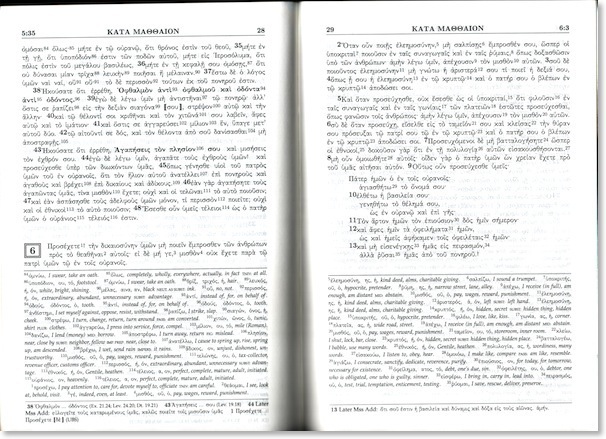
And now, the UBSRE (again, click on the image to see a larger, more detailed view):
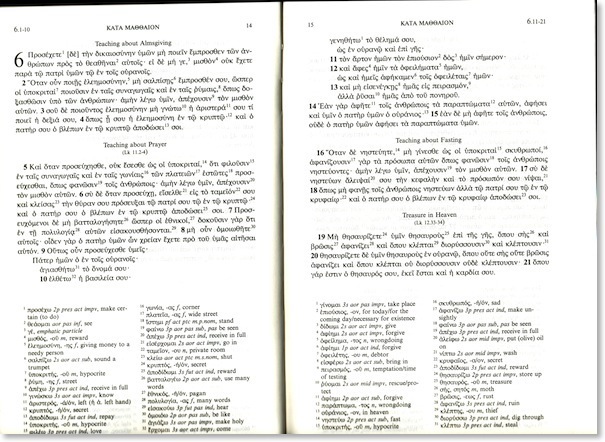
In my opinion, the UBSRE is much more inviting. Section headings separate pericopes, and parallel passages in other gospels are also noted. Of course some people prefer a straight text without section headings. If this is the case, the RGNT may be preferred to those readers. Finally, finding the definition of a word in the UBSRE is made much simpler and quicker with the two columns, rather than hunting through the paragraphed text of the RGNT's apparatus.
WHAT'S MISSING?
Not much. There's very little in the RGNT2 that's missing in the UBSRE. However, I felt the Scripture references for OT quotations in the RGNT2 were a very welcome addition, and one that the reader will not find in the UBSRE. The maps are a bit nicer in the RGNT2 than the standard UBS maps. The RGNT2 also added a few, sparse textual notes in addition those that referenced divergences from the UBS text. The reader of the UBSRE will still need to consult a more traditional edition to see textual issues.
Something should also be said about price. The UBSRE is significantly more expensive than the RGNT. I've stated for a long time that UBS prices were out of control, and this edition is no different. Even with discounts at places like Amazon or CBD, one can expect to pay about $20 more for the UBSRE over the price of the RGNT.
FINAL EVALUATION
Although initially, I was very excited about the release of the RGNT2 and its promised improvements over the first edition, I was quite disappointed in the final product. Yes, the thinline aspect of the RGNT2 might initially seem like a bonus over the twice-as-thick UBSRE, but in actual use, function simply wins out over form for me. The UBSRE is a better product because the designers of it did not choose to take shortcuts necessary to create a thinner form factor. From what I've heard, the RGNT had been greatly cutting into the sales of UBS/NA Greek New Testaments over the past few years, and the UBSRE is nothing less than a counter strike, and a significant one at that.
One last thing. If you read my review of the RGNT2, you'll remember I lamented that a ribbon marker was missing, in spite of the fact that one had been promised in early promotions, and even listed as a new feature on early shots of the box cover. Well, potential purchasers of the UBSRE will be glad to know that it does, in fact, come with a ribbon marker. Admittedly a minor detail, but handy for any reader, nonetheless.
A. T. Robertson on The Minister & His Greek New Testament

It ought to be taken for granted that the preacher has his Greek Testament. This statement will be challenged by many who excuse themselves from making any effort to know the Greek New Testament. I do not say that every preacher should become an expert in his knowledge of the New Testament Greek. That cannot be expected. I do not affirm that no preacher should be allowed to preach who does not possess some knowledge of the original New Testament. I am opposed to such a restriction. But a little is a big per cent. on nothing, as John A. Broadus used to say. This is preeminently true of the Greek New Testament.
The real New Testament is the Greek New Testament. The English is simply a translation of the New Testament, not the actual New Testament. It is good that the New Testament has been translated into so many languages. The fact that it was written in the koiné the universal language of the time, rather than in one of the earlier Greek dialects, makes it easier to render into modem tongues. But there is much that cannot be translated. It is not possible to reproduce the delicate turns of thought, the nuances of language, in translation. The freshness of the strawberry cannot be preserved in any extract.
The preacher cannot excuse himself for his neglect of Greek with the plea that the English is plain enough to teach one the way of life. That is true, and we are grateful that it is so. The Bible is in the vernacular and has entered into the very life of the modem man. It is impossible to overestimate the influence of the King James Version upon the language and life of the English-speaking world. ... But words are living things and, like all life, are constantly changing. Dictionaries run out of date quickly, not merely because of new ideas and new words, but because the old words change their meanings.
We excuse other men for not having a technical knowledge of the Bible. We do not expect all men to know the details of medicine, law, banking, railroading. But the preacher cannot be excused from an accurate apprehension of the New Testament. This is the book that he undertakes to expound. It is his specialty, and this he must know whatever else he does or does not know. Excuses for neglecting the New Testament are only excuses after all.
Now, the Greek New Testament has a message for each mind. Some of the truth in it has never yet been seen by anyone else. It is waiting like a virgin forest to be explored. It is fresh for every mind that explores it, for those who have passed this way before have left it all here. It still has on it the dew of the morning and is ready to refresh the newcomer. Sermons lie hidden in Greek roots, in prepositions, in tenses, in the article, in particles, in cases. One can sympathize with the delight of Erasmus as he expressed it in the Preface of his Greek Testament four hundred years ago: "These holy pages will summon up the living image of His mind. They will give you Christ Himself, talking, healing, dying, rising, the whole Christ in a word; they will give Him to you in an intimacy so close that He would be less visible to you if He stood before your eyes."
Many who saw Jesus in the flesh did not understand Him. It is possible for us all to know the mind of Christ in the Greek New Testament in all the fresh glory of the Galilean Gospel of grace. The originality that one will thus have is the joy of reality, the sense of direct contact, of personal insight, of surprise and wonder as one stumbles unexpectedly upon the richest pearls of truth kept for him through all the ages.
The trouble with all translations is that one's mind does not pause long enough over a passage to get the full benefit of the truth contained in it. The Greek compels one to pause over each word long enough for it to fertilize the mind with its rich and fructifying energy. The very words of the English become so familiar that they slip through the mind too easily. One needs to know his English Bible just that way, much of it by heart, so that it will come readily to hand for comfort and for service. But the minute study called for by the Greek opens up unexpected treasures that surprise and delight the soul.
Three of the most gifted ministers of my acquaintance make it a rule to read the Greek Testament through once a year. One of them has done it for forty years and is as fresh as a May morning to-day in his preaching. One of them is a man of marked individuality and he has added to undoubted genius the sparkling exuberance from the constant contact of his own mind with the Greek text. There is thus a flavor to his preaching and speaking that makes him a marked man wherever he appears upon the platform. He makes no parade of his learning, but simply uses the rich store that he has accumulated through the years. He brings out of his treasure things new and things old. And even the old is put in a new way. Light is turned on from a new angle of vision. The old has all the charm of the old and the glory of the new.
There is less excuse than ever for the man with college and seminary training who does not turn his knowledge of Greek to tremendous account. His tools are far superior to those of a former generation.
The most perfect vehicle of human speech thus far devised by man is the Greek. English comes next, but Greek outranks it. The chief treasure in the Greek language is the New Testament. Homer and Thucydides and Aeschylus and Plato all take a rank below Paul and John and Luke. The cultural and spiritual worth of the Greek New Testament is beyond all computation. In the Renaissance the world woke up with the Greek Testament in its hands. It still stands before the open pages of this greatest of all books in wonder and in rapture as the pages continue to reveal God in the face of Jesus Christ.
It's That Time of Year Again!
To take the quiz, click HERE. Be sure to click "Done" at the end of the quiz so you can see whether your answers are right or wrong.
A Reader's Greek New Testament, 2nd Edition: Hands On Review
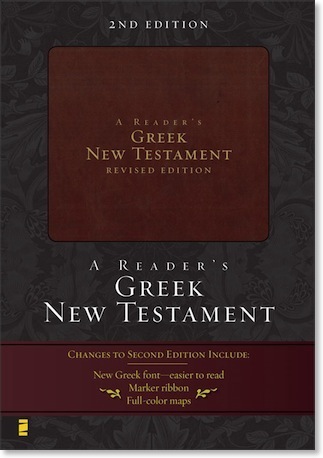
What No One Wants to Talk About
There's a dirty little secret among ministers throughout Christendom: most of them have let their biblical languages slide after graduating seminary. It's sadly understandable, I suppose. Learning a language is hard enough, but maintaining that language takes time and discipline. It's not that ministers are undisciplined (well, maybe some are), but when they get out of school and into the "real world" of ministry, they find new obligations and demands upon their time. Reading the Bible in Greek or Hebrew is replaced with an occasional word study to get at the "meaning" behind key biblical words.
That's where a book like A Reader's Greek New Testament (from this point forward, simply RGNT for the general work and RGNT1 and RGNT2 for the respective editions) can help fill the gap. I'm told there are 5,347 distinct words in the Greek New Testament. The average student taking elementary Greek will only learn a little over 300 vocabulary words in that first course. This accounts for roughly all words that occur in the Greek NT 50 times or more, or approximately 80% or so of words occurring in the NT. A second course related to syntax and exegesis will increase the number of learned vocabulary falling somewhere between 30 and 10 occurrences. The key feature of A Reader's Greek New Testament is the vocabulary apparatus at the bottom of the biblical text which gives definitions for all Greek words occurring 30 times or fewer.
This is a handier tool than one might at first realize. You see, there's another dirty little secret, and this one is among even the most trained academics and theologians: very few scholars ever memorize all 5,347 words. I've sat under quite a few professors in my time, some of whom are quite well known in the world of biblical studies. However, I could probably count on one hand the number of individuals I've known who could "cold read" any passage in the NT and do so well. I admit that years ago I tested this out on more than one occasion on more than one professor. I began to pick up on the fact that when we had a focal passage for study for a day, a professor could read from the Greek quite smoothly. But as soon as a question was asked about another passage, stumbling and stuttering began as an attempt was made to read the unplanned text. Again, I can count on one hand the individuals I've known who seemed to be able to smoothly read aloud any passage from the NT without advanced preparation.
I won't be a hypocrite. I admit up front that I don't have all 5,347 words memorized either. It's a worthy goal, but I haven't reached it, and frankly at the moment I'm not even attempting to. At some point way back, I worked my way through one of those boxes of 1,000 Greek vocabulary cards. Those boxes will get the Greek student down to about all words that occur 10 times or more. I use my Greek almost daily, but I haven't reviewed all 1,000 vocabulary cards in a long time. If I had to guess, I would assume that as of this moment, my current mastery of Greek words falls somewhere below that 30x mark and above that 10x mark.
The Value of the RGNT
I picked up the first edition of the RGNT based mostly on the sheer novelty of the fact that it represented a different Greek text than the "Standard Edition"; that is, the Greek text underlying the NIV Bible (more about that in a moment). But the more I used it, the more I saw the value of what it was designed for: the RGNT allowed me to read the NT in Greek without having to constantly look up words that I didn't know the definition of off the top of my head. They were simply defined at the bottom of the page. Of course, there's value in consulting the lexicons for more in-depth treatment, but I would suggest that very few non-specialists who learn Greek (or at least take Greek classes) ever really read Greek. Instead, they simply muddle their way through. I've been there myself, and it's taken quite a bit of study to proceed further. But the RGNT will help anyone with a basic foundation in Greek studies actually read the NT in its original language.
Although for years I'd carried with me one of those "standard" Greek texts (first the UBS 3rd edition, and later the 27th edition of the Nestle-Aland text), I found myself picking up the RGNT more and more after I bought it. I especially grabbed it for non-academic purposes such as church use. I found that when teaching a Bible study, if I was asked a question that required consulting the Greek text (which happens now and then), I was able to stumble around less on those cold readings if I had the RGNT. So I would imagine that over the last couple of years, when carrying a Greek NT with me, the RGNT has been my choice at least 50% of the time.
The value of the RGNT is fairly universal. Certainly, it's a great tool for the person in ministry, who's out of school, but wants to continue using his or her Greek skills. It allows a pastor to realistically work in actual Greek for exegesis when preparing a sermon because less time is involved. For the student who has recently begun studying Greek, it's a great way to stay in the Greek text and rely less on outside aids. Of course, I've warned folks that the average professor is probably not going to allow it for an exam. But even beyond new students and graduated students, the RGNT is an immensely practical resource for looking to the original languages first as opposed to a translation. Some might be tempted to call it a crutch, but I would contend that the more a person used the vocabulary apparatus at the bottom of the page, the less it would be used over time as new vocabulary was mastered.
The Underlying Text
It's very important that anyone considering the use or purchase of the RGNT know that text itself varies slightly from the accepted, so-called "Standard" eclectic Greek text. For those unfamiliar with this, the average Greek NT bought off the shelf today, whether a UBS 4th edition or a Nestle-Aland 27th edition, does not represent a single Greek manuscript, but is rather an amalgam of what is considered the best and most reliable readings from the manuscript evidence. But sometimes opposing variant readings have such strong evidence that scholars disagree over which variant represents the original. There are formal, but not always rigid rules for making such decisions and this process is known as textual criticism. Bible translators use these standard texts when creating or revising a translation of the Bible, but I suppose the third dirty little secret today is that every translation on the shelf contains some renderings in which the translation committee disagreed with the decision of those who put together the standard text. But until the first edition of the RGNT, it was difficult determining with any translation how many times a committee went rogue against the decisions in the standard text.
The first edition of the RGNT was released in 2003 containing a reverse-engineered Greek text reflecting the translation decisions found in the NIV Bible. So how many times did the NIV translators opt to go with variant readings? Evidently, the magic number is 231. Is that good, bad, on par with other translations? Who knows? This had never been done before (to my knowledge). The newly released second edition also features an underlying Greek text, but not for the NIV. Rather, the underlying Greek text of the RGNT2 is based upon its successor, the TNIV. Regular readers of This Lamp will correctly assume that I'm very pleased with this decision. I've been concerned in the past that Zondervan was still holding on too tightly to the NIV rather than giving deference to the newer and more accurate TNIV. Not only is this change of translations between editions forward-thinking, the RGNT2 represents one of the first reference work related to the original Greek associated with the TNIV, further legitimizing academic use of this translation.
But wait--there's more. One might expect the number of deviations in the Greek text underlying the TNIV to remain close in number to those in the NIV. Not so. Would you believe that the number of deviations from the standard text in the TNIV is 285? That means there is well over 50 separate instances in which the TNIV Committee on Bible Translation made decisions for readings that differed from their predecessors who worked on the NIV. Are these decisions good ones? Well, that will have to be examined, but at least now with RGNT2, we know where they are.
Further, this will settle some questions about the differences between the TNIV and NIV once and for all. For instance, a while back I wrote about the difference between the two translations in their rendering of Mark 1:41 (see here and here).
|
Mark 1:41
|
|
|
NIV
|
TNIV
|
| Filled with compassion, Jesus reached out his hand and touched the man. “I am willing,” he said. “Be clean!” | Jesus was indignant. He reached out his hand and touched the man. “I am willing,” he said. “Be clean!” |
At the time, I wrote to the International Bible Society hoping that my question about the extremely different rendering would be passed on to the TNIV CBT. However, and IBS intermediary answered the email himself and went to great length to defend a decision to translate σπλαγχνίζομαι/splagchnizomai (the underlying Greek word translated in the NIV as "filled with compassion") as indignant in the TNIV. It didn't make much sense to me then, and as I looked at the issue a bit more, I discovered that there was another variant to Mark 1:41 that included the word ὀργίζω/orgizō (be angry, be furious) instead of σπλαγχνίζομαι/splagchnizomai. Upon receiving the RGNT2 in the mail this week, one of the first things I looked up was Mark 1:41 and I was not all too surprised to see that the TNIV does in fact use the variant that contains ὀργίζω/orgizō. Originally, upon receiving the RGNT2, my plan was to sell the first edition. However, I now believe it would be valuable to hold on to both for just these kinds of comparisons.
Improvements in the 2nd Edition
In addition to updating the textual basis, a number of other improvements have been made in the RGNT2. I've complained before that I didn't care for the italic Greek font in the RGNT1. Most will be pleased to know that the text has been completely reset in a non-italic font. Unfortunately, I'm still not satisfied with the new font, but I'll speak more to that below.
The RGNT is known for including vocabulary words at that bottom of the page for all words that occur 30 times or fewer. But what if the reader forgets the definition of one of those words that occur more than 30 times? I'll never forget the time I was in a class about a decade ago and it was my turn to recite a text and I completely blanked on a very basic, frequently occurring word (ποιέω/poieo). Well the new RGNT2 includes a "mini-Lexicon" (it's actually called that) in the back that includes all those words occurring 30 times or more. It's a good way to review vocabulary as well. All definitions, like those in the apparatus with the text are taken from Warren Trenchard's Complete Vocabulary Guide to the New Testament. The mini-lexicon takes up only 6 pages, much fewer than I would have imagined.
Four color maps relating to the New Testament have been added. These maps will be recognizable to anyone who's bought a Zondervan Bible in recent years, but they are certainly a welcome addition. Old Testament quotations within the NT text are now referenced in a separate apparatus at the bottom of the page. This second apparatus also includes notations to differences in the standard NA/UBS Greek text as well as a few minimal textual notes such as "Later MSS Add... ." Again, no one is going to be able to do hardcore textual criticism with this New Testament, but the improvements in the RGNT2 help to make it a more complete package for most situations.
Like the previous edition, the new RGNT2 comes in an "Italian Duo-Tone" cover, which is a very leather-like imitation leather. Personally, I like the cover just like I did in the first edition. It feels immediately soft like a leather that has experienced a good amount of use already. I'm not sure any of us know what these new kinds of imitation leathers will look like in 20 years, but I'm not concerned. And I especially appreciate the lower cost (about $23 on Amazon.com).
What I found very interesting, though, is that contrary to early advertisements promoting a marker ribbon, no such item is included. In fact, as of this writing. the box cover image on both Amazon.com AND the Zondervan website (reflected at the top of this post) promises a marker ribbon. Evidently, the ribbon was cut at the last minute, but still done in time to update the box cover which now sports only two "Changes to Second Edition" in the copy on the front of the box (the new supposedly easier to read Greek font and the full-color maps).
I might also point out, too, that when I did my earlier "first look" (i.e not hands on) review of the RGNT2, I speculated based on released PDF files that this new edition might have wide margins. Sadly, it does not.
A Reader's Edition That's Difficult to Read
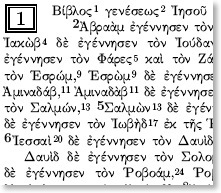
One of the supposed improvements in the second edition over the first edition of the RGNT is the new non-italic typeface (seen in actual size to the right). It's true, I've never liked italic Greek typefaces or saw the need for them. My first Greek New Testament years ago was a USB 3rd edition that had an italic, but readable typeface. However, I thought the 4th edition italic font was horrible and I've never used it. I have generally preferred instead to use a Nestle-Aland 27th edition Greek New Testament with non-italic type. I was never fond of the italic type in the RGNT1, but the work itself was so very practical that as described above, I've used it regularly over the last two or three years.
I was excited about the prospect of non-italic type in the RGNT2. Yet, when I saw the type of the main body text, I was astounded. I believe I said aloud, "My goodness, it's actually worse." The strokes that form the characters in this Greek font are so very thin that in my opinion, the second edition is even more difficult to read than the first. If you think about it, this completely contradicts the concept of a supposed "Reader's Edition" because what Zondervan has produced is a work that is difficult to read! I can only imagine that extended time spent with the RGNT2 would seriously make one's eyes ache.
And to illustrate the oddity of this thin Greek font, all I have to do is point to the English font in the introduction of the work. It looks like it is probably about a 10 point Times-based font. It's easy to read. But it's in stark contrast to the thin letters in the Greek text. And to add even further evidence to the impracticality of this font, I should point out that the compilers of the RGNT2 chose an entirely different and thicker (i.e. normal) font for the Greek in the mini-lexicon. If they had used the same Greek typeface in the main text that they had used in the lexicon, I would have no complaint.
I showed the new edition to one of my Greek students with the original edition for comparison. I waited for a reaction. He looked back and forth at the two editions and then he asked, "Wait a minute...is the new typeface smaller?" I'm not so sure it's smaller, but it's definitely thinner. In fact because of the new typeface that takes up less space, the second edition comes in at 11 pages shorter than the first edition--and that's including the mini-lexicon in the second edition!
I can only speculate that the desire to have so few pages comes from what I see as a preoccupation that Zondervan has with thinline Bibles. Personally I can't stand thinline Bibles because compromises have to be made to reach a smaller size and that usually means small, cramped type and pages that are way too thin. And, of course, think paper leads to text bleed-through from underlying pages. All three are true for the RGNT2, and all three make this edition even more difficult to use than the first.
I complained to Zondervan about the thinline format because of the sacrifices in the type and paper, but Zondervan's marketing shows that people really seem to prefer thinline Bibles. I'm sure they do. They are compact and easy to carry, but personally, I don't find them practical for regular/heavy use. If I were to make a publishing rule regarding such things, I'd say never produce thinline reference works.
Further, in regard to my complains about the type, I was told that at the recent SBL & ETS conferences, attendees were given the chance to compare the two editions:
"I can say this that the vast majority of those at the convention who looked at the two editions preferred the second edition's font over the first as being much easier to read. Even though the first edition was $5.00 cheaper than the second edition and we had lots of both editions at the conventions, we sold out of the second edition first at both conventions, and 'from my perch' I made sure that people looked at both fonts if they were unaware of the first edition."
My hunch is that people looking at the two simply prefer the non-italic type in the second edition over the italic type in the first, but time will tell. It's a different issue altogether when one is actually trying to use a work like this as opposed to simply looking at it in a conference booth.
I'm going to really attempt to use the second edition despite my initial misgivings. I didn't like the italic type of the original edition at first, but it grew on me. However, I don't know if that will be possible with a font that's simply difficult to read.
No Longer the Only Game in Town
About a year or so ago, I had a professor from a seminary extension contact me about the original RGNT. He was using it in his Greek classes, but he had heard that the United Bible Societies were going to sue Zondervan over their Reader's Edition in spite of the 231 places where it diverged from their text. He was so concerned about this, he had been buying up extra copies of the RGNT for his future students to buy from him. He wanted to know if I had heard about any of this. I had not heard about it, but I didn't believe at the time that any such lawsuit was be tenable in a court of law because the UBS text is made up of an arrangement of public domain ancient manuscripts. Later on I would find out that such an idea for a lawsuit had indeed been considered, but eventually abandoned because of the exact reason I suspected.
Nevertheless, there is a new UBS Greek New Testament: A Reader's Edition to compete with Zondervan's. Granted, it's $20 more expensive than Zondervan's (UBS prices are out of control in my opinion) even at discounters, but it may end up giving Zondervan's RGNT2 a run for it's money. I have not held one in my hand yet (when I do, I'll offer yet another review), but based on PDF's, I wonder if they haven't built a better mousetrap. My concerns about the typeface in Zondervan's RGNT don't look like they will be an issue in the UBS edition based on what I've seen. I would invite you to compare the PDF sample for the UBS Reader's Edition to the PDF sample for the Zondervan RGNT2 and let me know your thoughts. I should also point out that the UBS text is about 200 pages longer than the Zondervan version and it is definitely not a thinline.
Concluding Thoughts
Zondervan has developed a wonderful concept with its Reader's Greek New Testament which is aimed at allowing a person with at minimum basic Greek skills to simply read the New Testament in its original language without having to consult a full lexicon every few words. Most of the additions to the second edition are welcome and for the most part improves upon its predecessor. I especially like having the text that underlies the TNIV. Since I teach out of the TNIV at church, the RGNT2 would seemingly make for an excellent complementary resource. Unfortunately, the ghastly thin typeface in the second edition threatens to defeat the purpose of this being a reader's edition because it's simply difficult to read. If the new UBS Reader's Edition begins to cut into Zondervan's sales, I hope they will consider resetting the type as quickly as possible. Unfortunately such projects never take place quickly, and I wouldn't expect anything different from the current RGNT2 for at least three years or more.
December 2007 Bible Sales Rankings by Translation

Interesting jockeying going on this month. It's not surprising to see the NIV, KJV, and NKJV at the top three in sales on both charts (although deep down it still amazes me that the NKJV sells so well). The fact that the ESV ranks #4 on unit sales, but #7 on dollar sales continues to reinforce my hunch that a lot of the 50¢ New Testaments are being sold, probably based more on price than translation preference, although I'm positive both are significant factors for its continued acceptance. The HCSB which ranked #10 last month in both dollar and unit sales moved up both charts significantly. Perhaps this has to do with the release of the Apologetics Study Bible (Ken, where's my review?) which ranked #2 on study Bibles sold. The TNIV, the most recently released version on the list, didn't show up in either rankings last month, but lists as #9 on dollar sales and #10 on unit sales which is surely significant since half of the reporting CBA stores refuse to carry it (suggestion: the next time you're in the market for a TNIV BIble, special order it from one of the stores that won't carry it).
Biblical Illustrator Plus: Winter 2007-08
The Back of the CD jewel case has this analysis:
In November 2005, news broke that the world's oldest map had been discovered. The Soleta Map, as it came to be called, was about the size of a postage stamp and showed the location of various cities along the boot heel of Italy. The map dated to about 500 BC. Since its discovery, however, some have suggested that the map may be a modern forgery. If it is a genuine artifact, it's a reminder of how far we have come in map-making technology. GPS systems in our cars can show us exactly where we are on a map. And online electronic satelite maps can zoom in our your backyard or on someone's property half a world away. Those who have studied maps have long noted how cities dot the water sources. Rivers and fresh-water lakes became the home to families, villages, cities, and eventually civilizations. This issue of Biblical Illustrator Plus explores how water affected civilization development and how those civilizations interacted with one another and how they came to know, understand, and relate to God. As you read and study, take time to evaluate where you are--and where you are going.

Click the image above for a larger view.
The BI+ CD contains background articles for a number of Lifeway Bible study curriculums. I teach from the "Explore the Bible" curriculum which essentially goes through the entire Bible in eight year cycles. This Fall, a brand new cycle began with our study of Matthew. I'll be honest and say that I was disappointed that we only spent only one quarter in Matthew's gospel. However, I'm very pleased that the corresponding Old Testament study in Genesis will span two quarters. The first book of the Bible is absolutely foundational for everything that comes after it, and I don't believe 50 chapters could have been adequately covered in only three months. Therefore, in the list of new BI articles below, many of them are related to our study of Genesis. Other articles relate to the "Bible Studies for Life" curriculum which looks related to be a study in the Gospels (but I don't have a schedule for that series, so I'm not certain).
Here are the current new articles found in both editions of Biblical Illustrator:
| Jeff S. Anderson | Understanding David's Enemies | Psalm 7 |
| Gary P. Arbino | Book Review: The IVP Atlas of Bible History by Paul Lawrence and Alan Millard | |
| Alan Ray Buescher | The Land of the Philistines | Gen 20-33 |
| Trent C. Butler | Polytheism in Abram's Day | Gen 12:1-9 |
| Joseph R. Cathey | ARTIfacts: The Goliath Inscription | |
| Mark R. Dunn | Who Were the Samaritans? | John 4:4-26 |
| Terry Ellis | Roman Tax Collectors | Luke 15:1-2, 11-24 |
| R. D. Fowler | Farming in the First Century | Luke 10:1-12, 16 |
| Thomas H. Goodman | Praising God from A to Z: The Acrostic Psalms | Psalm 145 |
| D. Larry Gregg Sr. | The Servant Songs in Isaiah | Isa 52:13 - 53:12 |
| Kevin Hall | Eden: All We Know | Gen 2-4 |
| Scott Hummel | Ur: The "Capital of the World" | Gen 11:1-9, 27-32 |
| Dorman Laird | Lot: the Master of Poor Choices | Gen 11, 13, 14, 19 |
| LeBron Matthews | The Invasion of the Kings | Gen 14 |
| Claude F. Mariottini | "...and Not a Drop to Drink": Water's Effect on Civilization Development | Gen 26 |
| R. Kelvin Moore | Melchizedek | Gen 14 |
| Harold R. Mosley | Mt. Ararat | Gen 8 |
| James Newell | Who Were the Hittites? | Gen 15, 23, 26 |
| Gary M. Poulton | Archaelaus: Ruler of Judea | Matt 2:1-23 |
| Mark A. Rathel | The Nazareth Jesus Knew | Luke 1-2 |
| James Wiles | Zechariah and Elizabeth: A Silence Broken | Luke 1:5-25, 57-80 |
For those fortunate enough (which includes me) to have the Biblical Illustrator Plus CDROM, dozens of articles from previous issues are included as well. In addition to Explore the Bible and Bible Studies for Life, these archived articles also support Lifeway's other curriculums such as MasterWork and the January Bible Study (Romans).
| N/A | Samaria in Jesus' Day | N/A |
| Jeff S. Anderson | King's Privileges or King's Crimes? | 2 Sam 11:1-5, 14-17 |
| Waylon Bailey | Languages of the Ancient Near East | Gen 11:6-7 |
| Albert Bean | The Arm of the Lord | Isa 53:1-12 |
| Albert Bean | Chesed Love | Psalm 86:1-17 |
| Martha S. Bergen | Rome: The Growth of the Eternal City | Romans |
| Robert Bergen | Potiphar in Egyptian Society | Gen 39:1-23 |
| Bryan E. Beyer | The Practice of Covenant Making | Gen 12:1-3; 15:1-18 |
| Ronald E. Bishop | Isaac | Gen 17:19; 22:2; 24:4, 67; 25:11a |
| Steve Booth | Of Inns and Inns | Luke 2:1-20; 10:25-37 |
| Bennie R. Crockett Jr | Immanuel | Matt 1:18-23; 2:1-2, 10-11 |
| Rick Davis | Destroyed Relationships | Gen 3:1-24 |
| Bob Dean | Paul's Use of the Old Testament in Romans | Romans |
| Robert J. Dean | Roads and Travel in the First Century | Luke 1:26-35; 2:4-7 |
| Joel Drinkard | Beersheba | Gen 26:12-33 |
| Bob Dunston | The Hills and the Valley | Gen 13:1-18 |
| Wayne Etheridge | Admah and Zeboiim | Gen 9:24-29 |
| Gary Lee Gramling | The Samaritans | John 4:7, 9-15, 28-30, 39-40 |
| Elmer L. Gray | Capital Punishment in the Ancient Near East | Gen 9:6 |
| Sharon H. Gritz | Life for a First Century Housewife | Luke 15:1-10 |
| Sharon H. Gritz | The "Word" in John's Gospel | John 1:1-18 |
| George H. Guthrie | First-Century Roman Government | Rom 13:1-14 |
| Stephen Z. Hearne | Forgiveness in the New Testament | Matt 18:21 |
| Norma S. Hedin | Birth Rituals of the First Century | Luke 2:8-20, 36-38 |
| Gene Henderson | A Description of Noah's Ark | Gen 6:1 - 8:22 |
| Timothy Paul Jones | The Meaning of "Raca" | Matt 5:21-26 |
| Francis X. Kimmitt | Ancient Near Eastern Flood Stories | Gen 8:20 - 9:17 |
| Thomas D. Lea | The Early Church's Use of Messianic Passages | Isa 53; Acts 28:23 |
| Jerry W. Lee | The Dust of the Ground | Gen 2:4-25 |
| David C. Maltsberger | Where Is Mt. Moriah? | Gen 21:1-7; 22:6-8, 15-18 |
| Claude Mariottini | Canaan in Patriarchal Times | Gen 12 |
| John Mason | Love's Abiding Nature | 1 Cor 12:31b - 13:13 |
| John Mason | Sychar and Jacob's Well | John 4:1-45 |
| David M. May | The Spirit of Restoration | Gal 6:1-10, 14-18 |
| T. Van McClain | Abraham's Homeland | Gen 12:1-20 |
| Glenn McCoy | First Century Priesthood | Luke 1:1-80 |
| Glenn McCoy | Introduction to Romans | Romans |
| Daniel R. McGee | The Servant Songs in Isaiah | Isa 53:1-11 |
| Larry McGraw | The Meaning of Violence | Gen 6:11-13; Psalm 55:9-11; Jonah 3:6-10; 1 Pet 3:9-12 |
| Warren McWilliams | The Galatian People | Galatians |
| Warren McWilliams | Grief Practices in New Testament Times | Psalm 23:4; John 11:24-26; 1 Thess 4:13-18; Rev 21:4 |
| Allan Moseley | David and Absalom: A Family Tragedy | Gen 50:17; 2 Sam 19:4, 7-8; Luke 15:20-24; Eph 4:32 |
| Allan Moseley | Who Were the Philistines? | 1 Samuel |
| Harold R. Mosley | In God's Image | Gen 1:1 - 2:23 |
| Harold R. Mosley | Zoar | Gen 18-19 |
| Timothy L. Noel | Jewish Inheritance Laws | Luke 15:25-30 |
| John Polhill | Paul and the Romans | Romans |
| Michael Priest | To "Tabernacle" | John 1:1-18 |
| Carolyn Ratcliffe | Messianic Expectations in Intertestamental Judaism | Luke 1:26-38; Matt 1:18-25 |
| Charles A. Ray | Nero: Ruler of Rome | Romans 13:1-14 |
| C. Mack Roark | Forgiveness & the Jewish Tradition | Matt 18 |
| C. Mack Roark | Martha of Bethany | Luke 9:51 - 10:42 |
| Glenn E. Robertson | Jewish Teachings on Forgiveness | Matt 18:1-9; 21-22 |
| Glenn E. Robertson | Was John the Baptist a Nazirite? | Luke 1:5-25, 57-80 |
| Bob Ross | Journey to Bethlehem | Luke 2:1-7 |
| Thomas Sawyer | Feasting: First Century Practices | John 12:2; Luke 7:37; 15:23 |
| W. Murray Severance | Fiery Darts | Eph 6:16 |
| George H. Shaddix | Ancient Altars | Gen 8:15 - 9:11 |
| Bob Simmons | The Curse | Gal 3:15 - 4:7 |
| T. C. Smith | A Convenient Theology | Job 8:6; Psalm 145:15-20 |
| Don H. Stewart | Obedient Joseph | Matt 1:18-25; 2:13-23 |
| Robert A. Street | Deceiver | Gen 25-33 |
| Robert A. Street | Haran | Genesis |
| Philip J. Swanson | Esau and the Edomites | Gen 32 |
| J. Rodney Taylor | Noah in Jewish Folklore | Gen 5:28 - 9:29 |
| John Mark Terry | Absalom: David's Son | 2 Sam 13-19 |
| John Mark Terry | Eliezer: Faithful Steward | Gen 15:2 |
| William Tolar | A Different Gospel | Gen 1:6-7; 2:11-21 |
| William Tolar | Jews in First Century Rome | Romans |
| Wayne VanHorn | Curses and Blessings in the Old Testament | Gen 2:15 - 3:24 |
| Fred M. Wood | Abimelech | Genesis |
| Fred M. Wood | My Brother's Keeper | Gen 4:1-26 |
| Fred M. Wood | Valley of Gerar | Genesis |
| R. Garland Young | Naming a Child | Luke 1:5-13, 24-25, 59-64 |
Biblical Illustrator Magazine is available by subscription for $24.95 and Biblical Illustrator Plus CDROM for $34.35. I highly recommend it even if you don't use these curriculums simply to build up a personal library of biblical backgrounds articles.
From the Patriarchs to Patmos: BI Time Line of the Bible
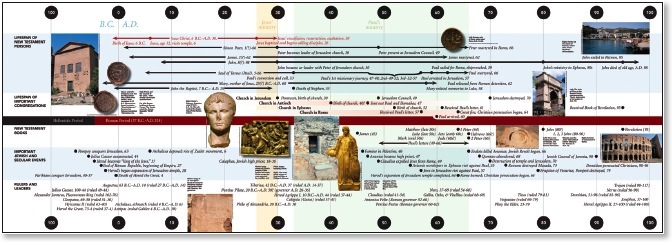
Regular readers of This Lamp are aware that I'm a fan of Biblical Illustrator magazine as a tool for Bible study preparation. Well the editors of BI have just released a wonderful set of new teaching aids: The Biblical Illustrator Time Line of the Bible. This is a set of three individual timeline charts (two for the Old Testament and one for the New Testament) that graphically illustrate the history of biblical events as well as related history of the Ancient Near East.
The two OT timelines cover events from 2100 BC (roughly the time of Abraham forward) to 100 BC. The OT timelines are broken down by divisions: religious events, military and political events, lifespans of important persons, archaeological eras, Palestine, Mesopotamia, involvement with other nations, and Bible books.
The NT timeline begins at 100 BC and ends at AD 100. NT divisions include lifespans of NT persons, lifespan of important congregations, archaeological eras, NT books, important Jewish and secular events, and rulers and leaders.
The three timelines themselves measure 17" x 48.5" each. They are full-color matching the professional look of regular Biblical Illustrator articles and charts. Don't tell the folks at Lifeway I said this, but at $9.95, I actually believe they are underpriced.
When I teach at church, I always include historical context. There's always an appropriate map on the wall to go along with our study. Now that I have these timelines, I'm going to laminate them and leave them indefinitely on the wall of the main room I teach from at church.
If you teach the Bible regularly in any church or classroom setting, I highly recommend these timelines. You can find them at any Lifeway store or you can order them online.
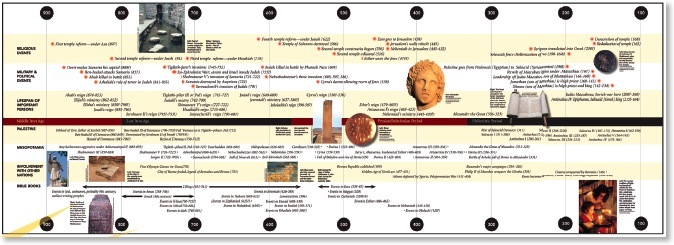
Tyndale Select Insert
So while I don't have access to a copy of this Bible (and I am not even sure it will be stocked in the stores locally because of its price), I have gained access to the text copy from the Tyndale Select insert. I am reproducing it below because I know a number of you will find it interesting.
TREASURE
God's presence in our lives through Scripture is priceless. His Word is a treasure to be passed down to future generations. Introducing Tyndale Select. For those who want a Bible they can enjoy for a lifetime. This exquisite edition is crafted out of the finest calfskin leather with deluxe features throughout.
FEEL
Highest quality hand-bound calfskin leather. Supple. Durable. Beautiful.
FIND
Dual satin ribbon markers trace your study and mark key passages for personal reference.
REVEAL
A ready resource--full color maps and concordance make Tyndale Select a valuable reference tool.
SURPASS
The highest quality binding available in the clear and accurate New Living Translation
TYNDALE SELECT BIBLE CARE
Congratulations on owning Tyndale Select, the highest quality binding available in the New Living Translation. or a lifetime of use, take note of these tips to protect your investment:
- SPINE FLEXIBILITY
The durable Smyth Sewn binding should be gently stretched as soon as you bring it home so it will remain flexible for decades to come. Hold the closed Bible in one hand with the spine flat on a table. Then hold all of the pages together and let the covers slowly fall to the table. Next take a series of pages from the front of the Bible and lay them down, running your fingers across the top page, near the crease, pressing gently. Sill holding most of the pages upright in your hand, repeat, taking a section of pages from the back of the Bible. Continue repeating this process, first on one side and then on the other, until the entire Bible has been opened into two even halves.
- MARKING
A well-marked Bible with personal notes will become very valuable to you as a companion and customized reference tool. Do not use felt-tip or roller points, as these will often bleed through the pages. Instead, use a pencil or ball point pen or a special Bible marking highlighter or pen, available at most Christian bookstores.
- LEATHER CARE
The best way to care for the calfskin leather cover is to use it. The natural oils from your hands actually nourish the leather fibers. To clean dirt or spills, dab with a soft cloth dampened with water and mild detergent, without getting the leather too wet. Wipe with a slightly damp cloth to remove soap residue. Dry with a clean soft towel.
GUARANTEED FOR LIFE
Premier quality materials and meticulous old world craftmanship come together to create a cherished heirloom. Carry this Bible and appreciate every word knowing the truth it contains--and the Bible itslef--will be a part of a legacy to the next generation.
If for any reason this Bible does not meet your expectations, we will replace it or give you a full refund.
You can also download the PDF insert itself with pictures here:

Note: in the Amazon links to the right, the first link is the ebony edition and the second is the mahogany.
Intelligible Is Not Preferred If the Rendering Is Inaccurate: Matthew 16:18-19 in the TNIV
Our focal text for the day was Matthew 16:13-28. As I do on most Sundays, I was teaching from the TNIV. When I'm teaching, I prefer not to have to undermine the translation I'm using in order to clarify actual meaning in the text. But the TNIV was lacking, in my opinion, in two very important places in our study. Had I been thinking, I probably should have grabbed my HCSB when I walked out the door as it was much better.
First, I'm not fond of the rendering in v. 18: "and the gates of death will not overcome it" (emphasis added). The original NIV simply had Hades here, transliterated from the Greek. On the one hand, hell (KJV, NLT) is too strong of a translation. But in my opinion, the TNIV's death lacks a certain amount of punch. Hades certainly does carry the meaning of death, and at times could be legitimately translated simply as death or grave (Acts 2:27 for instance, although here the TNIV ironically uses "the realm of the dead"). But my concern with death in Matt 16:18 is that the reader will miss the spiritual aspect of Jesus' words. Yes, I know that theologically speaking, all death is a spiritual event. But many don't realize that and merely see it as a physical act at the end of existence.
I perfectly realize that Hades by itself isn't any clearer and many will still need explanation, but again, I feel that death simply doesn't say enough while hell overreaches. I know that many readers will disagree with me and see death as a fine translation. Please realize, I'm not calling it inaccurate, just less effective and incomplete. But that does lead to the next issue where I believe there is an actual inaccuracy in the TNIV (and the majority of translations in use today).
I was disappointed in v. 19 to see that the future perfect aspect of binding and loosing that is in the Greek (δεδεμένον and λελυμένον, respectively) were ignored in favor of a fairly traditional rendering: "whatever you bind on earth will be bound in heaven, and whatever you loose on earth will be loosed in heaven.” But if misery loves company, very few translations render this correctly. In fact, only three major modern translations even attempt to bring out an accurate understanding of the passage:
“...and whatever you bind on earth shall have been bound in heaven, and whatever you loose on earth shall have been loosed in heaven.” (NASB) “...and whatever you bind on earth is already bound in heaven, and whatever you loose on earth is already loosed in heaven.” (HCSB) "Whatever you bind on earth will have been bound in heaven, and whatever you release on earth will have been released in heaven." (NET)
Certainly, the alternatives above are a bit more awkward, but the difference theologically is enormous, and more importantly, they are more accurate. So, since I have said before that "literal is not more accurate if it's unintelligible," I might also suggest that intelligible is not preferred if the rendering is inaccurate.
It cuts both ways.
Final note: alternate (and more accurate) renderings for v. 19 are found in some translations including the ESV and TNIV:
Or shall have been bound . . . shall have been loosed (ESV)
Or will have been. (TNIV)
Keeping One's Emotions in Check: Psalm 4:4 in the RSV/ESV
I was teaching the imperative mood in my Greek class today when a question came up about an example I used. To illustrate the idea of an imperative granting permission, I offered the same verse as our textbook, Eph 4:26—
ὀργίζεσθε καὶ μὴ ἁμαρτάνετε
[You may] Be angry and/but do not sin
One of my students asked about the original OT passage that Paul quotes. He wanted to know if it was an imperative in the LXX. It’s true that the passage quotes Psalm 4:4 (4:5 in the LXX/BHS). And although I didn’t know the answer off the top of my head, it was easy enough to find out. So I threw an Accordance window onto the projector screen.
We looked up the passage in the LXX, and sure enough it was exactly the same down to the letter. The same imperative form for ὀργίζω (to be angry) was used in the passage: a present passive imperative, 2nd person plural. Someone looking in his own copy of the Bible noted however, that the NASB did not use “Be angry,” but rather Tremble. I suggested that often such a disagreement occurs because the NT writers usually quoted the LXX, but our modern translations are based off the Hebrew text and sometimes variations occur. Then I threw up a few English translations for comparison, most of which had the same or a similar idea as the NASB. But when I opened a pane with the ESV, I was surprised to see that it said, “Be angry... .”
Having spent enough time on this issue, I went back to our lesson. However, I was curious enough to look at this issue after class. As I was to confirm, the Hebrew for Psalm 4:4/5 is not a word that specifically means to be angry. The Hebrew word used 4:4/5, rigzu, is the qal imperative form of rgz. My Hebrew is in the rustier section of my language toolbelt, but I can still read a lexicon. And according to the HALOT, the qal form of rgz means (1) to tremble, be caught in restless motion, (2) to tremble with emotion: from terror, (3) to come out quaking with fear, (4) to get excited. Although it's not my desire to try to defend the LXX's choice of ὀργίζω for rgz, I can question the ESV's use of "Be angry" since the translation claims to be based on the Hebrew OT, and certainly not the Greek.
I should point out that the ESV does include an alternate translation to "Be angry" in the footnotes: "Or Be agitated." Is Be agitated a better translation? Well, according to the HALOT, only if rgz takes the hifil form (which it does not in Psalm 4).
My first hunch was simply to assume that the ESV translators were once again engaging in the questionable practice of trying to make the OT text conform to NT quotations, something that doesn't always work for reasons I've stated above. However, rather than jump to any sudden conclusions, I decided to check out other translations in the Tyndale tradition, especially the ESV's immediate predecessor, the RSV. After checking with the Tyndale translation, I was reminded that there is no Tyndale version of the Psalms (at least that's survived), so it's probably more accurate to say in the KJV tradition. The chart below demonstrates the variations of Psalm 4:4 in all translations that trace their lineage in one way or another to the KJV.
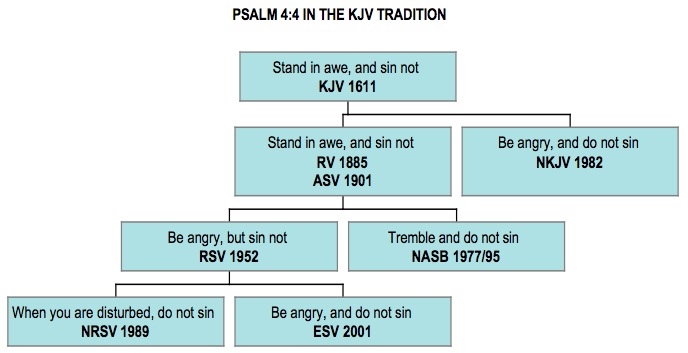
It's very interesting that while the KJV followed the Hebrew, it was the RSV that first departed and followed the LXX instead. I find this highly ironic since the RSV was heavily criticized by conservatives for following the Hebrew reading in Isa 7:14 instead of the LXX which harmonized with Matt 1:23. So I believe it's fair to say that initial fault does not lie with the ESV, but with the RSV. And I haven't looked at every translation on my shelf, but between the ASV and the RSV, only a couple of translations of any significance stand out: the Moffatt version and the Smith/Goodspeed version. Both of these use tremble. Therefore, as far as I know, it is the RSV that first introduced "Be angry" to Psalm 4:4.
However, the ESV is to be questioned here regardless because the translators have chosen to leave a faulty translation in place for what I can only guess is simply is simply for the sake of artificial harmonization. This follows one of my primary problems with the ESV--that the revisers did not update the RSV enough. Many of the awkward renderings or simply less-than-adequate translations found in the ESV are simply leftover baggage from the RSV.
That the ESV, which was moderately revised again earlier this year, has retained "Be angry" only suggests to me the original assumption I made that the handlers of this version wish to create a direct correspondence, a harmonization, between the OT text and the passages where it's quoted in the NT. This is problematic, though, when it no longer accurately reflections the meaning of the OT texts such as is the case here. Even the alternate translation, Be agitated would be closer to accuracy, but as is often the case with the ESV, the more accurate rendering is in the footnotes and a more "traditional" (even if inaccurate) rendering is in the main text (see for example, the ESV's consistent translation of ἀδελφοί/adelphoi in Paul's writings as "brothers" while noting the more accurate translation of "brothers and sisters" in the footnotes: Rom 1:13; 7:1; 8:12; 10:1; 11:25; 12:1; 15:14; 16:14; 1 Cor 1:10; 2:1; 3:1; 4:6; 6:8; 7:24; 8:12; 11:33; 12:1; 14:6; 15:1; 16:15; 2 Cor 1:8; 8:1; 13:11; Gal 1:2; 3:15; 4:12; 6:1; Eph 6:23; Phil 1:12; 3:1; 4:1; Col 1:2; 4:15; 1 Thess 3:7; 4:1; 2 Thess 1:3; 2:1; 3:1; 1 Tim 4:6; 2 Tim 4:21). One wonders why the more accurate translations wouldn't simply be preferred in the main text? Well, evidently because it flies in the face of tradition.
As always, your thoughts are invited in the comments below. For reference sake, here is Psalm 4:4 in a few other translations. The ESV is not to be criticized by itself. The NLT and HCSB both use anger, which is even more surprising for the latter which usually goes out of its way to shun traditional renderings for the sake of accuracy. Of course "tradition" in this case only dates back to 1956 as far as I can tell. The original NIV also used anger, but the TNIV appropriately corrects this with Tremble.
“Be angry and do not sin” [note: Or Tremble] (HCSB)
“Tremble and do not sin” (GWT)
"So tremble, and sin no more" (JPS)
"Tremble with fear and do not sin!" (NET)
"In your anger do not sin" (NIV)
"Tremble and do not sin" (TNIV)
"Don’t sin by letting anger control you" (NLTse)
"Let awe restrain you from sin" (REB)
"Tremble with fear and stop sinning" (GNT)
CBA Updates Bible Translation Rankings & Method for Rankings [UPDATED]
After an unexplained absence the last couple of months, the Christian Booksellers Association (CBA) has now posted Bible translation rankings for the month of November. Perhaps responding to previous criticisms for the way reports are calculated, the CBA rankings have now been separated into two separate lists: one by dollar sales and one by volume sales.
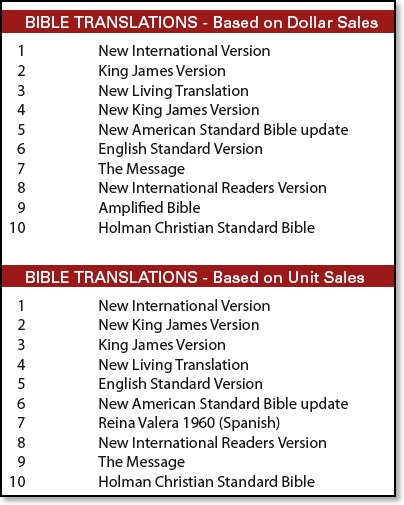
This change is certainly welcome because the two separate lists tell us exactly what we're seeing. Of course, I'd like to see the actual numbers of unit sales as my hunch is probably 75% of all units sold are represented in the first two or three listings. The other issue readers need to keep in mind is that these sale are only reflective of CBA member stores. Thus, significant numbers are not included from such outlets as Wal-Mart, Amazon.com, book chains such as Barnes & Noble and all other non-CBA member businesses.
Regarding Willow Creek's So-Called Repentance...
But I've been amazed at the inordinate amount of attention given today to statements made by Bill Hybels at last summer's Leadership Conference. The word repentance comes not from Hybels as far as I can tell, but from the title of a Christianity Today blog , Out of Ur, in a post called "Willow Creek Repents?" The statement that seems to be getting the most attention is this:
We made a mistake. What we should have done when people crossed the line of faith and become Christians, we should have started telling people and teaching people that they have to take responsibility to become ‘self feeders.’ We should have gotten people, taught people, how to read their bible between service, how to do the spiritual practices much more aggressively on their own.
Well, duh.
But let's be really honest here for a moment. If this is a statement of repentance, can I take the collective planks out of the church's eye for a moment, and simply be the first to say that just about every local body I've ever been a member of, and every church I've ever visited--Baptist, Methodist, WCA, Independent, whatever--should really be ready to repent of the very same thing?
Lot's of folks are having some kind of "Aha!" moment with Hybels' confession. But I would still venture to say that discipleship is seriously neglected (or poorly implemented) among churches of all stripes and variations. Program-driven ministry? The vast majority of evangelical churches engage in some kind of program- or event-driven ministry. At least Hybels/Willow Creek is willing to admit there's a problem.
Whatever Happened to the CBA Bible Translation Bestseller List?

It's been MIA for two (or is it three?) months now.
I've been watching the list on and off since 1986 when I got my first job in a Christian bookstore. Although it's been quite a while since my last bookstore gig, at various times, I worked at three different companies (including one national chain and two independents, all CBA members), and I used to regularly cut the chart out of the back of the CBA Journal and frame it next to the Bible section.
Of course, no one ever really thought the rankings were overly accurate. I've even had publishing insiders tell me how poorly configured it was. But I had also heard that an improved system was in the works. And now suddenly it's gone! Yet surprisingly, if you follow the link above, the CBA is still tracking other Bible sales. How come they can't track translations anymore?
What have you heard?
"No one seeks God" (Rom 3:11): Is This an Absolute Statement?
Let me briefly lay some cards out on the table for a moment. For many years, I was quite enamored with the so-called "seeker" movement when it came to how I thought churches ought to function in the contemporary world. Yet after experience, study, and reflection, let's just say I'm not quite so enamored these days. In fact, I'd go so far as to say that for a local church to gear nearly all its ministry around the idea of reaching seekers is ultimately a mistake. Nevertheless, I believe there is some value in the seeker movement in that it reminded the church universal that often Christians and non-Christians have very different thought processes. So I believe there must be some balance, and I'll come back to that idea in a separate post later on.
I'm writing this because many times I hear those who are opposed to seeker-targeted ministry quote Rom 3:11, "no one seeks God." Then the conclusion that almost always follows is that there is no such thing as a seeker and thus any ministry to reach seekers is invalid. Well, I believe this is a complete misunderstanding of this verse that lifts a handful of words that Paul somewhat paraphrases from Psalm 14 (or 53) and completely takes them out of context.
Speaking of context, here's the passage from Romans from the TNIV with textual notes referencing OT quotations.
9 What shall we conclude then? Do we have any advantage? Not at all! We have already made the charge that Jews and Gentiles alike are all under the power of sin. 10 As it is written:
“There is no one righteous, not even one;
11 there is no one who understands;
there is no one who seeks God.
12 All have turned away,
they have together become worthless;
there is no one who does good,
not even one.”c
13 “Their throats are open graves;
their tongues practice deceit.”d
“The poison of vipers is on their lips.”e
14 “Their mouths are full of cursing and bitterness.”f
15 “Their feet are swift to shed blood;
16 ruin and misery mark their ways,
17 and the way of peace they do not know.”g
18 “There is no fear of God before their eyes.”hcPsalms 14:1-3; 53:1-3; Eccles. 7:20.
dPsalm 5:9
ePsalm 140:3.
fPsalm 10:7 (see Septuagint)
gIsaiah 59:7, 8.
gPsalm 36:1.
In regard to Rom 3:11, Paul is paraphrasing a bit from what is Psalm 14 in English and Hebrew and Psalm 13 in the LXX. I may be wrong, but I believe he is favoring the LXX over the Hebrew Bible here as in most quotations that he makes. Below is my very literal translation of Psalm 13:2 from the LXX:
From heaven, the Lord bent down to look upon the sons of men to see if there were any who understand or seek after God.
Thus, you can see why I say Paul is paraphrasing a bit. Actually, he tells us the results of God's quest: "there is no one who understands; there is no one who seeks after God."
But is this to be taken absolutely? I mean, isn't the Bible full of references to people seeking God? I ran an entirely non-academic search by simply using Accordance to search the NASB for the string, seek*. Here are the results as I have categorized them:
Commands to Seek the Lord |
References to Those Who Seek the Lord |
References to Those Who Will One Day Seek the Lord |
Deut 4:29 “But from there you will seek the LORD your God, and you will find Him if you search for Him with all your heart and all your soul. Deut 12:5 “But you shall seek the LORD at the place which the LORD your God will choose from all your tribes, to establish His name there for His dwelling, and there you shall come. 1 Chr 16:11 Seek the LORD and His strength; 1 Chr 22:19 “Now set your heart and your soul to seek the LORD your God; arise, therefore, and build the sanctuary of the LORD God, so that you may bring the ark of the covenant of the LORD and the holy vessels of God into the house that is to be built for the name of the LORD.” 2 Chr 14:4 and commanded Judah to seek the LORD God of their fathers and to observe the law and the commandment. 2 Chr 15:12 They entered into the covenant to seek the LORD God of their fathers with all their heart and soul; Ps 105:4 Seek the LORD and His strength; Isa 55:6 ¶ Seek the LORD while He may be found; Amos 5:4 ¶ For thus says the LORD to the house of Israel, Amos 5:6 “Seek the LORD that you may live, Zeph 2:3 Seek the LORD,
|
1 Chr 16:10 Glory in His holy name; 2 Chr 11:16 Those from all the tribes of Israel who set their hearts on seeking the LORD God of Israel followed them to Jerusalem, to sacrifice to the LORD God of their fathers. 2 Chr 15:12 They entered into the covenant to seek the LORD God of their fathers with all their heart and soul; 2 Chr 26:5 He continued to seek God in the days of Zechariah, who had understanding through the vision of God; and as long as he sought the LORD, God prospered him. 2 Chr 30:19 everyone who prepares his heart to seek God, the LORD God of his fathers, though not according to the purification rules of the sanctuary.” 2 Chr 34:3 For in the eighth year of his reign while he was still a youth, he began to seek the God of his father David; and in the twelfth year he began to purge Judah and Jerusalem of the high places, the Asherim, the carved images and the molten images. Ezra 6:21 The sons of Israel who returned from exile and all those who had separated themselves from the impurity of the nations of the land to join them, to seek the LORD God of Israel, ate the Passover. Ezra 8:22 For I was ashamed to request from the king troops and horsemen to protect us from the enemy on the way, because we had said to the king, “The hand of our God is favorably disposed to all those who seek Him, but His power and His anger are against all those who forsake Him.” Job 5:8 ¶ “But as for me, I would seek God, Ps 9:10 And those who know Your name will put their trust in You, Ps 22:26 The afflicted will eat and be satisfied; Ps 27:8 When You said, “Seek My face,” my heart said to You, Ps 34:10 The young lions do lack and suffer hunger; Ps 40:16 Let all who seek You rejoice and be glad in You; Ps 63:1 ¶ O God, You are my God; I shall seek You earnestly; Ps 69:6 May those who wait for You not be ashamed through me, O Lord GOD of hosts; Ps 69:32 The humble have seen it and are glad; Ps 70:4 ¶ Let all who seek You rejoice and be glad in You; Ps 105:3 Glory in His holy name; Ps 122:9 For the sake of the house of the LORD our God, Prov 28:5 Evil men do not understand justice, Isa 51:1 ¶ “Listen to me, you who pursue righteousness, Isa 58:2 “Yet they seek Me day by day and delight to know My ways, Lam 3:25 The LORD is good to those who wait for Him, Dan 9:3 So I gave my attention to the Lord God to seek Him by prayer and supplications, with fasting, sackcloth and ashes. Zech 7:2 Now the town of Bethel had sent Sharezer and Regemmelech and their men to seek the favor of the LORD,
|
Jer 50:4 ¶ “In those days and at that time,” declares the LORD, “the sons of Israel will come, both they and the sons of Judah as well; they will go along weeping as they go, and it will be the LORD their God they will seek. Hos 3:5 Afterward the sons of Israel will return and seek the LORD their God and David their king; and they will come trembling to the LORD and to His goodness in the last days. Zech 8:21 ‘The inhabitants of one will go to another, saying, “Let us go at once to entreat the favor of the LORD, and to seek the LORD of hosts; I will also go.” Zech 8:22 ‘So many peoples and mighty nations will come to seek the LORD of hosts in Jerusalem and to entreat the favor of the LORD.’ Acts 15:17 SO THAT THE REST OF MANKIND MAY SEEK THE LORD, |
Obviously, there's record in the Scriptures of those who seek God, regardless of how imperfectly they perform the task. One discovery that's immediately apparent by the above listing is that those who are referenced as seeking God are those who are believers, those who are part of the people of God, those who are part of the covenant already. These individuals are the seekers. That's somewhat different from the way seeker is used in church discussions today in which a seeker is thought of to be the person who has become dispositioned (is this a word?) toward the idea of God, but simply hasn't settled enough issues to claim any kind of spiritual allegiance to a religious philosophy. Based on the examples above, I find it difficult to find the contemporary idea of a seeker in the Scriptures. Perhaps it might be found in 2 Chron 34:3 listed above, in which Josiah has a certain point in life in which he begins to seek the Lord. Four years later he is shown to be an individual who takes obedience to the Lord quite seriously. Perhaps also, inherent in some of the commands to seek the Lord, are those who may not be seeking him to begin with.
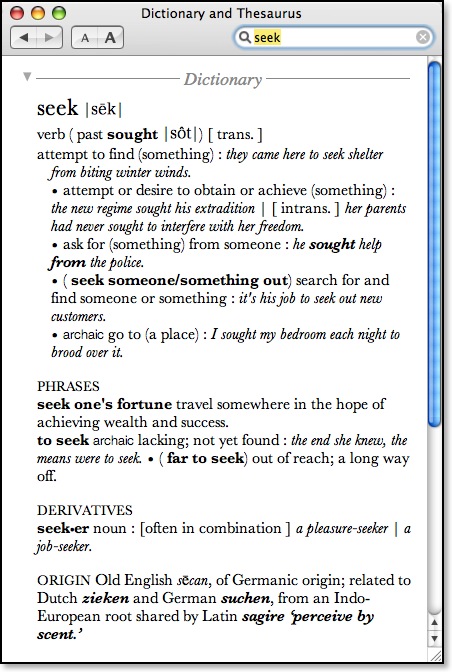
Obviously, in Romans, Paul is making the case that all are guilty of sin, whether Jew or Gentile. And yes, on the whole, in terms of humanity as a collective, we simply haven't sought God. But that doesn't negate the verses in the middle column above. Psalm 14 (or Psalm 53) serves as a contrast between the fool who doesn't seek God, and the faithful person who does. It's been demonstrated many times in recent years, that when Paul quotes a short passage of scripture, especially a string of short passages as he does in Rom 3:9-18, those passages are intended to be representative of the greater context from where they are found.
I don't always agree with James Dunn when it comes to the book of Romans, but I believe he's absolutely correct when, in the Word Biblical Commentary (p. 150), he writes,
Next the catena draws on Pss 14:1-3 [LXX 13:2-3] and 53:2-3 [LXX 52:3-4]. Significantly, it is "the fool" who is indicted, and those described are set over against God's people, "the righteous generation" (Ps 14:4, 5, 7), those who do seek after God (cf Pss 9:10; 22:26; 24:6; 27:8, etc. ... But when used as an elaboration of Eccl 7:10 [Dunn surely means 7:20 here], according to the conventions of Jewish interpretation, the Psalm passages can be understood to fill out the universal condemnation of Qoheleth ("the principal method in which the rabbis clarify the sacred text and probe its depths is by recourse to parallel passages"--Bloch, "Midrash," 32). Those who recognized teh quotation (whose repetition in the Psalms would make it all the more familiar) would recognize too the shocking implication that Paul was in effect lumping Jewish presumptions with gentile idolatry and sexual perversion (cf. Ps 14:1) as equally an expression of the fool's denial of God. ἠχρεώθησαν is the LXX translation of [ne’elachu], "become sour" (of milk)--hence NJB: "all alike turned sour."
Thus, to argue against so-called "seeker-sensitive" churches by quoting Rom 3:11 is to do an injustice to the text. We should remember, however, that our modern conception of a seeker may not square with the biblical definition of one.
Further, I believe it is incumbent upon the church to proclaim the εὐαγγέλιον (good news) every time we meet. And if that's not seeker-sensitive (that is, has the actual good of the seeker in mind, regardless of how we define seeker), I don't know what is.
TNIV Truth: Can the TNIV Be Used for "In-Depth" Study?
Can someone please explain to me how you can use the TNIV for in-depth study? I love the TNIV, but I am having a hard time using it for deep study because of the dynamic equivalence. I don't know if this is a mindset or an actual problem.
To read my response, click here.
TNIV Truth: Dig Deeper
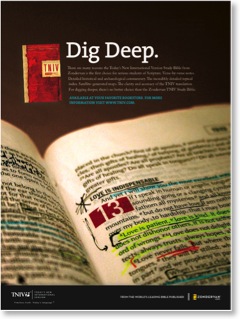
To read why I like this ad for the TNIV Study Bible, as well as my thoughts on work still to be done, read my latest post at TNIV Truth.
First Look: A Reader's Greek New Testament, Second/Revised Edition
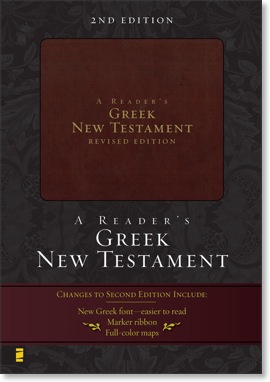
SOME BACKGROUND: THE FIRST EDITION
I've always found A Reader's Greek New Testament (RGNT from this point forward) to be an extremely practical resource. The RGNT addresses the issue that while there are over 5,000 distinct words in the Greek NT, the reality is that many of this words only occur a few times or even in single occurances. While it's an admirable goal for a student of Greek to memorize every word, it's not a reality for most. Most introductory grammars, in fact, only cover a little over 300 words, but these words occur so frequently that they account for roughly 80 of the entire New Testament. But that remaining 20% is still enough from keeping the average person who has a familiarity with Greek from sitting down and reading the New Testament in its original language as easily as one might read an English translation. In fact, in my experience and observation, I've known personally of only about two or three people who can really read the Greek NT without stumbling. Oh, sure, the dirty little secret is that any of us can read a passage just fine when we've taken the time to work through it ahead of time. But as soon as someone asks us a question about a different passage--one that we haven't prepared beforehand, we stumble and stammer as we try to read it in a quick and efficient manner.
The RGNT is noted for including lexical forms for all words of the Greek New Testament that occur 30 times or less. If this sounds like a crutch, think again. The reader still has to know his or her Greek grammar fairly well to use this resource. In fact, I tend to carry the first edition of the RGNT with me to church on Sundays. If I need to look up something quickly, and come across a word that's not part of my working vocabulary, I can look at the footnote at the bottom of the page. It's not realistic for me to carry a lexicon with me to church, and I usually don't have my MacBook so that I can access such tools in Accordance. Perhaps one day, I'll make time to memorize all 5000+ words in the Greek NT, but for right now it's not a practical goal and the RGNT is an ideal solution.
The other distinct feature of the RGNT first edition has to do with its textual basis. Most might assume that this is simply an edition of the current UBS/NA eclectic Greek text with a special apparatus. Not so. The Greek text in this edition is actually one that has been retrofitted, so to speak, to match the text that underpins the New International Version. The reality is that every translation committee makes decisions that sometimes causes them to choose a different textual route than the majority opinion of the UBS/NA committees. The RGNT first edition has about 200 instances, all noted in the footnotes, where its text differs from the standard text.
IMPROVEMENTS/CHANGES IN THE SECOND EDITION
New Greek font. I don't know if the font itself is actually a different font, but the main difference from the first edition is that the text in the second edition is not in italics. And I say, "Thank goodness!" My major complaint about the first edition of the RGNT is the italicized text that is extremely difficult to read. I have no idea why some publishers of Greek texts like to do this. The UBS 4th edition Greek NT uses a horribly thin italicized text also making it difficult to read. Thankfully, Zondervan changed this policy in the RGNT 2nd edition.
However, the font itself does look slightly smaller than the original edition. I've made a comparison in the graphic below that displays the first page of Matthew's Gospel on the left in the first edition and with the second edition on the right (note that the image below is not actual size).
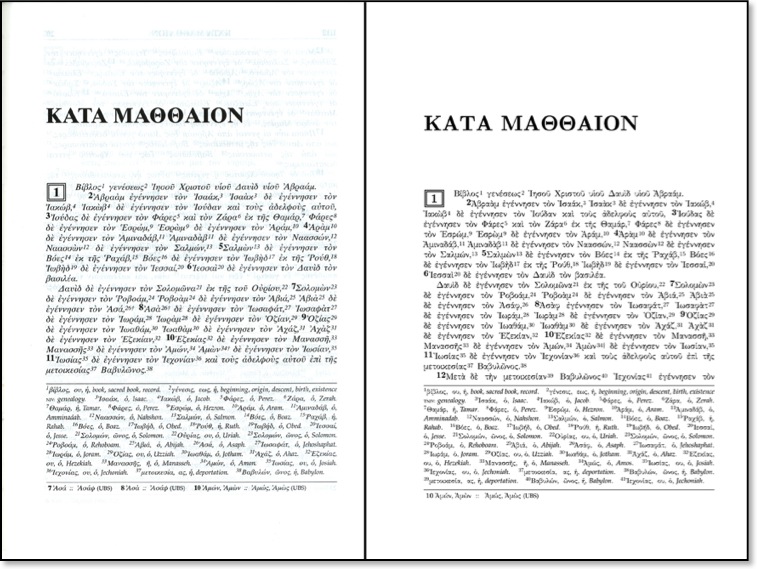
The observant reader may notice that there's slightly more text (most of Matt 1:12) on the second edition page. Therefore, the font is either tighter or smaller. Zondervan offers a PDF sample of the RGNT2 featuring the first five pages of Matthew. The second edition ends with Matt 3:17 while the equivalent page in the fist edition ends with 3:15. Two verses--is that a big deal? Probably not, but there is definitely an attempt to use fewer pages. Why? Because while there are more features in the RGNT2, but there are actually fewer pages than the first edition. Therefore, an attempt was made to conserve space. And while I wish Zondervan had not chosen to use a tighter/smaller font, I will say that regardless, the new text is much easier to read than the italicized text of the first edition.
But that brings us to another issue, and frequent readers of This Lamp will have to pardon a familiar complaint that I've discussed many times before. This New Testament, (presumably) like its predecessor is a thinline. How do I know this? Well, in spite of the fact that complete measurements have not been released, we do know a few things. I'm guessing the dimensions are a bit wider because the outer margin on each page is wider (see more below). We also know that although there is about a twenty page difference in the two editions, the weight is comparable (1.065 lbs. for the first edition vs. 1 lb. for the second edition). Thickness measurements for the second edition have not been released, but the first edition is 7/10 of an inch thick. Since the two editions weigh virtually the same, I can only assume that the second edition will be just as thin.
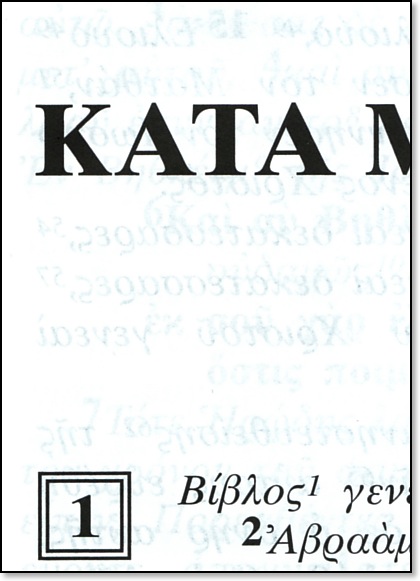
Personally, I hope that one day, publishers will get over their infatuation with thin Bibles and realize that the target market for a resource like this does not mind having a book that is somewhere between one inch and one and a half inches in thickness. I'm sorry, but cramming 576 pages into 7/10 of an inch is ridiculous.
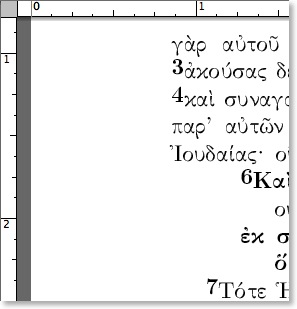
Again, this is an area where I with publishers would realize that those who buy products such as the RGNT appreciate not just thicker paper, but also wide margins for making notes, Regardless, whereas, the first edition's anemic margins were useless for any annotations, the new wider margins begin to approach a minimum width for note-taking,
Mlnl-Lexlcon. For those occasions when the reader forgels one of those words that occur more than 30 times, a new mini-lexicon has been added, presumably in the back of the RGNT.
Maps. Four new color maps have been added to the second edition of the RGNT. Already UBS/NA Greek New Testaments tend to have basic contextual maps inside the front and back covers. With the addition of these maps to the RGNT, this resource begins to take the feel of a standard reference tool and even a one-stop instrument for public use.
And the rest. Like the first edition, the new RGNT comes in an Italian Duo-Tone binding, I've stated before that I like this material just as much as actual leather. Assuming that these covers are going to hold up over decades-long use, I find them to be a very adequate substitute for real leather, especially if this keeps the price down. Perhaps Zondervan could put a disclaimer on the copyright page: "No cows were harmed in the publishing of this New Testament."
And of of course, the RGNT second edition will continue to offer lexical forms of words that occur less than 30 times in the Greek NT as well as noting where the text diverges from the UBS/NA texts. I'm pleased that they continue to keep these notes on the same page as the NT text, in footnote fashion, rather than by some other means.
I'll have more to say about the RGNT2 after I get my hands on one in November, Butfrom what l can already determine, it is already looking to be a great improvement over what was already a very practical and useful resource.
"A. T. Robertson Is My Homeboy" Apparel and Gifts Now Available
However, you may immediately notice that my design is somewhat different than merely being a knockoff of the Edwards shirt. Since A. T. Roberts is so closely associated with New Testament Greek studies, I thought it would be fitting to offer an equivalent Greek rendering of "is my homeboy." At first, I came up with some awkward phrasing that literally said "A. T. Robertson is the boy of my house." This didn't work, so after some thought and consultation, I cracked open the Louw & Nida lexicon which groups words around semantic domains. I began working my way through the section on "kinship terms." Finally, I came across the word, οἰκεῖος, a derivative of the Greek word for home/house [οἶκος] and which means kinsman, relative or member of a household. The word only occurs three times in the New Testament (Gal 6:10; Eph 2:19; 1 Tim 5:8), and I admit it was not part of my working vocabulary. But after looking at it and getting the opinion of a couple of other folks, I decided that in contemporary terms, in a very, very dynamic rendering, οἰκεῖος could be translated as "homeboy." Thus we have "A. T. Robertson ἐστιν ὁ ἐμὸς οἰκεῖος."
A bit of a stretch? Perhaps, but still valid I believe. Plus, like the "Jonathan Edwards is my homeboy" shirt, this is done somewhat tongue in cheek. I imagine such a shirt would draw quite a few stares, as well as being quite the conversation starter for those who get it and for those to whom you have to explain it.
A. T. Robertson was not only one of the greatest Southern Baptist theologians to have ever lived, but he would still probably rank as one of the most significant scholars in the area of modern New Testament Greek studies. After graduating from the Southern Baptist Theological Seminary in Louisville, Kentucky, Robertson was invited to teach at the school where he remained until his death in 1934. During his lifetime, he wrote over 45 books including four Greek grammars. Many of his works are still in print, and some are now thankfully in the public domain and can be accessed as easily as performing an internet search on his name. Robertson is probably best known for his six volume Word Pictures of the New Testament, a work that he wrote with both the reader in mind who knew Greek and the reader who did not. And of course, Robertson's 1500+ page magnum opus, Grammar of the Greek New Testament in the Light of Historical Research has more than stood the test of time. Although dated in some places, it is still a valuable resource and must for any serious student of NT Greek.
There's such a rich legacy of works left behind A. T. Robertson, that I've often thought of creating a podcast simply based on the reading of selections from his writing. In the meantime, if you want to show your appreciation to this great figure Greek studies, be sure to drop by my Café Press store and pick up a shirt, mug, journal or other item and let the world know, "A. T. Robertson ἐστιν ὁ ἐμὸς οἰκεῖος."



Biblical Illustrator Plus: Fall 2007
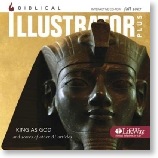
I highly recommend Biblical Illustrator for any student of the Bible's history. The articles are accessible for anyone of almost any background. Even if one has access to journals and such works as the Anchor Bible Dictionary (a favorite of mine), BI is sometimes a faster and more specific resource. And although I could not imagine preparing a Sunday School lesson without it, BI is also valuable for those not using Lifeway's curriculum. Every quarter I take all the articles on the CD (which are in PDF format) and organize them onto my computer's hard drive by biblical book. Then whenever I am preparing a sermon, Bible study, doing research, or anything in which I would need to access historical information about biblical ideas and customs, I have scores of articles at my disposal.
The cover of the Fall issue of BI contains a photograph of the "statue of Amenophis III from his mortuary temple on the West Bank at Thebes, famous for the so-called 'Colossi of Memnon.' Amenophis III was the first Egyptian king to be worshiped as a god in his own lifetime. Eighteenth dynasty, about 1350 B.C." The image relates to the article "King as God" by Joel F. Drinkard, Jr.
The back cover of the CD-ROM case contains these thoughts:
"The God said, 'Let us make man in Our image, according to Our likeness' ...
So God created man in His own image;
He created him in the image of God;
He created them male and female."
--Genesis 1:26-27, HCSB
How simple and yet profound! "Created" changes our origin and destiny. "In His own image" affects our understanding of human dignity, worth, and potential.
Of all creation, God created human beings in His image. That unique feature has compelled mankind to seek, to know, and to worship Him. But, how we have messed that up! People have worshiped everything from nature to creatively fashioned idols. Some have even worshiped man as god. In all of those cases, mankind has missed it.
But "In these last days, [God] has spoken to us by His Son, whom He has appointed heir of all things and through whom He made the universe. He is the radiance of His glroy, the exact expression of His nature, and He sustains all things by His powerful word. After making purification for sins, He sat down at the right hand of the Majesty on high" (Heb. 1:2-3, HCSB). In Him alone do we find worship satisfaction.
Below are the new articles in the Fall 2007 issue of Biblical Illustrator:
| Andrews, Stephen J. | Book Review: Bible Archaeology: An Exploration of the History and Culture of Early Civilizations by Alfred Hoerth and John McRay | |
| Bergen, Robert | Jerusalem's Fall to the Babylonians | Dan 1 |
| Beyer, Bryan E. | Who Were the Medes? | Dan 5 |
| Booth, Steve | Who Were the "Sinners"? | Matt 9, 11, 25 |
| Capes, David B. | First Century Capernaum | Matt 4, 8, 12 |
| Drinkard, Joel F. | The King as God in the Ancient Near East and Israel | Dan 3 |
| Eddinger, Terry W. | Kings and Kingdoms in Daniel's Time | Book of Daniel |
| Gonzalez, Rudy | Almsgiving: Its Use and Abuse | Matt 6:1-18 |
| Gritz, Sharon H. | Judas Iscariot, the Betrayer | Matt 26-28 |
| Jackson, Paul N. | The Righteousness of the Scribes and Pharisees | Matt 5:13-20 |
| Kelly, Bobby | Matthew and His Gospel | Matt 1-2 |
| Lane, Hal | Stranger: A Word Study | Matt 25:31-46 |
| McCoy, Glenn | Joseph the Carpenter | Matt 1, 2, 13 |
| Polhill, John | You Have Heard It Said: Jewish Laws Behind Jesus' Teachings | Matt 5:21-48 |
| Ray, Charles A. | John the Baptist: His Life and Ministry | Matt 3, 11, 14 |
| Roark, C. Mack | Forgiveness and the Jewish Tradition | Matt 18 |
| Stevens, Gerald L. | Divorce in the First Century | Matt 1, 5, 19 |
| VanHorn, Wayne | Belshazzar: All We Know | Dan 5:1-31 |
| Ward, Patrick D. | The "John the Baptist Cave" [ARTifacts] | |
| Weathers, Robert A. | The "Kingdom of Heaven" in Matthew | Matt 12, 13, 16, 19 |
| Wilder, Terry L. | What About the Gospel of Judas? | |
| [CenterSpread] | The Messiah's Ministry: An Account by Matthew |
The articles above are in both the print issue of BI and the BI Plus CD-ROM. However, the articles below are from previous issues and can be found only on the CD-ROM edition.
| Arnold, Stuart | Debtor's Slavery | Matt 18:21-35 |
| Bailey, John | Jesus as "Prophet" | Matt 21:4-14 |
| Boyd, Timothy N. | The Disciples in History and Tradition | Matt 9:36 - 10:1, 27-29 |
| Brooks, James A. | Lawyer and Scribe in the First Century | Luke 10:25; Matt 5:20; 23:1, 23, 27 |
| Caldwell, Daniel | Babylonian and Persian Kings | Dan 3:1-30 |
| Carter, Terry | A Talent | Matt 18:21-35; 25:14-30 |
| Champy III, Harry D. | Belshazzar: All We Know | Dan 5:1-7, 25-28 |
| Cheavens, Alice D. | The Roman Mile | Matt 5:41 |
| Cole, Dennis | First Century Bethlehem | Matt 2:1-12 |
| Cook, Donald E. | Jesus' Use of Parables | Isa 5:1-7 |
| Cook III, William F. | Lamps in Ancient Israel | Matt 5:13-20 |
| Davis, Conn | House Construction in Jesus' Time | Matt 7:24-29 |
| Dehoney, Wayne | The Place of Jesus' "Sermon" | |
| Draper, Charles W. | The Heavenly Host | Ps 148:2-5; 103:20-21 |
| Drinkard, Joel | The Spoils of War | Dan 1:3-5, 8-16 |
| Drinkard, Joel | Wealth, Trade, Money & Coinage in the Ancient World | Prov 16:16; 22:4; 28:20 |
| Dunn, Mark R. | The Blind in Jesus' Day | Matt 9:18-38; 15:16-20 |
| Fowler, R. D. | Zebedee the Fisherman | Matt 20:20-28; Rom 12:9-13 |
| Easley, Kendall H. | Commerce in First-Century Israel | Matt 13:24-52 |
| Easley, Kendall H. | Prayer Customs in First Century Judaism | Matt 6:5-15 |
| Evans, Bob | The Practice of Making Oaths | Matt 5:27-37 |
| Green, Joe | The Learning and Wisdom of Chaldea | Dan 1:17 |
| Gregg Sr., D. Larry | The House of Herod | Isa 9:6-7; Matt 1:18-23; 2:1-2, 9-11 |
| Gritz, Sharon | Kingdom of God in Intertestamental Judaism | Matt 13:1-23; 13:24-52; 16:13-28 |
| Gritz, Sharon | Pilate's Power and Authority | Matt 28 |
| Haag, H. Joseph | The Early Church's View of Poverty | John 12:5; James 2:15-16 |
| Hall, Kevin | Apocalyptic Literature | Books of Daniel and Revelation |
| Hankins, L. Milton | Beams & Motes | Matt 7:1-12 |
| Huckaby, Gary C. | Caesarea Philippi | Matt 16:13 |
| Jackson, Paul | Jesus' Last 40 Days | Matt 28:1-10 |
| Jones, Timothy Paul | The Meaning of "Raca" | Matt 5:21-26 |
| Knight, George W. | The Galilee Boat | Matt 14:22-33 |
| Knowles, Julie Nall | The Church's Use of the Model Prayer | Matt 6:9-15 |
| Lain, Gil | Ancient Storage Facilities | Matt 6:26 |
| Lain, Gil | Early Ships and Boats | Matt 14:29 |
| Lane, Hal | Worry: a Word Study | Matt 6:25-34 |
| Lanier, David E. | Salt in Ancient Israel | Matt 5:1-16 |
| Lemke, Steve W. | "Falling Away" or "Erring" from the Faith? | 1 Tim 4:1; 6:10 |
| McCoy, Glenn | God as Heavenly Father | Matt 5:45, 48 |
| McCoy, Glenn | The Mount of Transfiguration | Matt 17:1-13 |
| McGraw, Larry | God's Angelic Messengers in the New Testament | Psalm 103:20-21; Matt 13:39-42; Mark 13:26-27; Acts 12:7-9, 11; 27:23-24 |
| McWilliams, Warren | Predestination: Time and Space | Matt 6:8 |
| Miller, Stephen R. | Capital Punishment in the Ancient Near East | Dan 3; Esth 4:11 |
| Miller, Stephen R. | The Neo-Babylonian Empire | Book of Daniel |
| Moseley, Allan | Shadrach, Meshach, and Abednego: All We Know | Dan 1:8, 14-17; 3:17-18, 26-28 |
| Parsons, Mikeal C. | The Holy Spirit: A History of Interpretation | Rom 5:5 |
| Patterson, Bill | Divorce in First Century Israel | Matt 19:4-6, 10-12; Rom 16:3-5a; 1 Cor 7:7-9, 32-35; Eph 5:21-22, 25 |
| Peacock, Kevin C. | The Battle of Carchemish | Books of Ezekiel and Daniel |
| Poulton, Gary | The Roman Military in Jesus' Day | Matt 8:1-13 |
| Pouncey, Greg | Who Were the Magi? | Matt 2:1-23 |
| Rathel, Mark | Salvation: A Word Study | Luke 2:25-38 |
| Reeves, Rodney | Mourning the Dead in the First Century | Matt 9:18-31; 36-38 |
| Register, Dean N. | Jesus as the Son of God | Matt 3:17; 4:3 |
| Roberts, Sharon | Pearls in the Ancient World | |
| Robertson, Paul E. | The Love of Money | 1 Tim 6:10 |
| Robinson, Dale G. | The Trumpet in the New Testament | Matt 24:3-6, 29-31, 42-47 |
| Sandlin, Bryce | A History of Darius I | Dan 6:1-28 |
| Simmons, Billy E. | Poverty and Wealth in the Early Church | Matt 6:1-18 |
| Tench, Tony | The Pure in Heart | Matt 5:3-12 |
| Trammell, Timothy | Introducing Matthew's Gospel | Matt 2:1-12 |
| Ward, Patrick D. | City Gates in Jesus' Day | Matt 7:13-29 |
| Ward, Patrick D. | Jesus' Early Life | |
| Warren, William | Our English Bible | |
| Wood, Darryl | Prayer: Its History and Use | 1 Thess 5:17 |
| Woodward, C. Alan | Annas and Caiaphas | Matt 26:1-56; John 18:15-27; 19:1-42 |
| Woodward, C. Alan | "Mammon" | Matt 6:19-24 |
Finally, I was honored to be quoted in an ad for Biblical Illustrator appearing in one of Lifeway's publications this quarter. Here is a reproduction of the ad below. Click on the image to see a larger version.
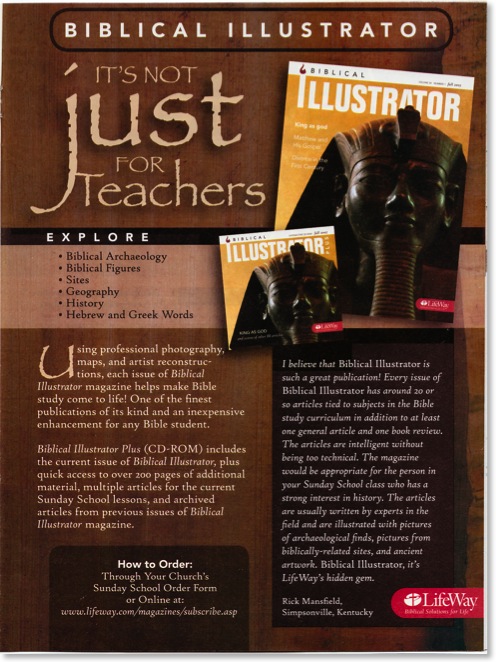
NLT Update: August 2007
This past week I received correspondence from Kevin O'Brien, Director of Bibles and Bible Reference at Tyndale House Publishers. Although there is no timetable at the moment, the folks at Tyndale are evidently considering taking an existing edition of the New Living Translation and making a wide margin Bible out of it.
O'Brien's question to me, and one that I'm passing on to you is, "Is there is a specific edition of the NLT that you would prefer to see used for such a Bible?" Leave your thoughts in the comments. I'll make sure to pass them on.
_________________________________________________________________
I also heard from Laura Bartlett, who is a marketing manager at Tyndale. Some of you may remember my review of the NLT Premium Slimline a few months back. Although overall, this was a nice text edition of the NLT with a readable font, but it was marred by text that was way too close to the inner margin. It's hard to read without pressing the Bible flat in the middle.
Well, Laura tells me that there's a new NLT Personal Size Large print coming out that includes a larger font (12 pt.) and an inside margin that is a tenth of an inch wider than the previous edition. This might not sound like much, but it's enough to make the Bible much more usable than the earlier edition I reviewed. The new NLT Personal Size Large is also a good bit thicker than the other edition (2128 pages vs. 1560 pages!).
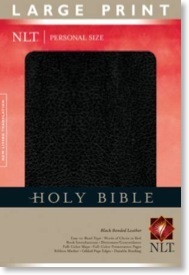
ISBN-13: 978-1-4143-1405-1 Hardcover
ISBN-13: 978-1-4143-1401-3 Bonded Black
ISBN-13: 978-1-4143-1402-0 Bonded Burgundy
ISBN-13: 978-1-4143-1403-7 LeatherLike Black
ISBN-13: 978-1-4143-1404-4 LeatherLike Burgundy
ISBN-13: 978-1-4143-1871-4 LeatherLike Brown/Tan
To access a PDF sampler of the new NLT Personal Size Large Print Bible, click here.
Laura also mentioned the new Discover God Study Bible:
Our big new deal in NLT Bibles right now is the Discover God Study Bible. The premise is that it’s the only study Bible in which the notes all focus on the person of God, what he has revealed to us about himself in the Bible, and how we can be in relationship with him. It’s not primarily for new believers, which the title can imply. Most of the notes are from Bill Bright’s ministry. It has an innovative topic system that some people are calling the “Thompson Chain of the 21st Century.
And then finally, Laura told me about an upcoming product that sounds extremely interesting. Unfortunately, it didn't make it into the Fall catalog, so I can't talk about it...yet.
iPhone Bible App Roundup: 08/09/07
About three weeks have passed since I wrote my first iPhone Bible app roundup. Yet in that very short span of time, four new iPhone Bible offerings have been made available. In this post I will offer short reviews of each of these apps.
While looking at these apps, I began to notice some similarities in interfaces. I discovered that a number of them are based on the "iPhone User Interface" (iUI) created by Joe Hewitt. This interface is similar to the color and design of some of the Apple-based apps on the iPhone such as the Mail app and the list view in the iPod app. Of course, it's not just Bible apps that are using the iUI; a quick look at the iPhone Application List shows that lots of folks are using it. This is in spite of the fact that Hewitt himself has called the interface a bit boring. Personally, I like the simplicity of Hewitt's interface because I immediately know how to use any app created with it.
Also, I want to point out that although I used screen captures from my MacBook for the last roundup, from this point forward, I will be using a camera to take pictures of the screen to give a better idea of what these apps look like on an actual iPhone (with one exception below). The downside of that is that the images will not be as clear as the previous ones. That is not to say that these apps are not clear on the actual iPhone, but rather that it is just extremely difficult to take a picture of the screen on an electronic device. I did finally figure out that I should turn off my flash though.
iPhone Bible (NAB)
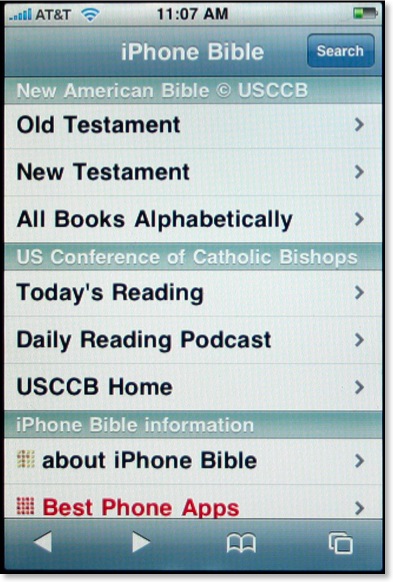
I was initially intrigued when I first heard of the iPhone Bible (does this mean they now have control of that name?) because it would be the first iPhone Bible app to include the deuterocanonicals/apocrypha. Using Hewitt's aforementioned iUI, the opening screen of the iPhone Bible is both clear and colorful. Using a similar method we've seen elsewhere, the user selects Old or New Testament, which leads to the appropriate books of that testament (plus preface and section introductions), chapter numbers, and finally the full text of the selected chapter. That's where the surprise comes.
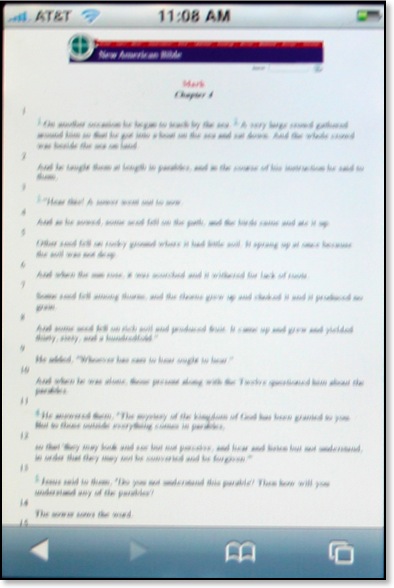
The biblical text for the iPhone actually comes from the already existing NAB pages from the United States Council of Catholic Bishops website. What that means is that these pages are not already formatted to a mobile device such as the iPhone and as demonstrated above, can be barely read at first. To see the text better, the user has two options. First, the iPhone can be turned sideways:

This is helpful, but still not a perfect solution. Another option of course is to simply do the iPhone multi-touch pinch resulting in text as large as desired:
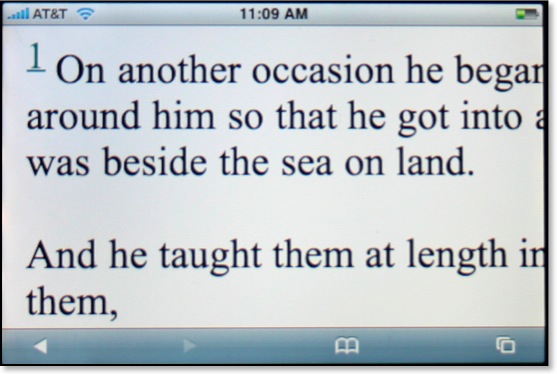
Yes, Steve said we'd have the actual internet on the iPhone, but it's not always as practical as it sounds. Even with the text enlarged, this is still not an ideal solution for reading large sections of Scripture as one would constantly have to move the page around to see the entire text.
The NAB iPhone Bible is a great idea, but it suffers from the inherently small text that renders from the original USCCB pages. There is no search function built into the iPhone Bible, but there is a search available upon arriving at the USCCB pages. However, the user will want to restrict searches to the entire Bible because by default the entire site is searched. This was certainly a good idea, but perhaps the developers could get permission to reformat the NAB text specifically for the iPhone and other mobile devices.
The Net Bible

Soon after I got my iPhone, I thought to myself how incredible it might be to have the NET Bible with all 60,000 notes literally in the palm of my hand. I contacted the folks at Bible.org to suggest they offer a NET Bible iphone app, but they were already well ahead of me as they had already been considering the very same thing. The NET Bible for the iPhone also uses Hewitt's iUI, and the navigation to a particular passage of the Bible is similar to the one described above.
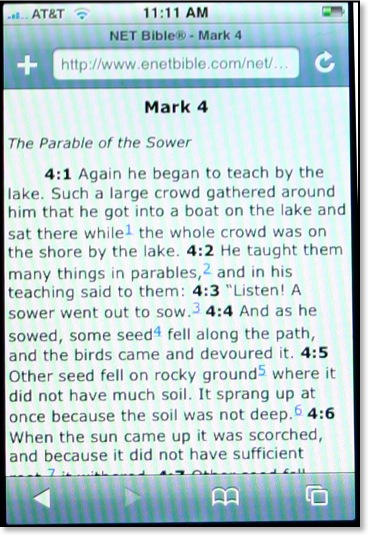
In my last set of reviews, I praised iBibleSpace for the best interface of any iPhone Bible app so far. That evaluation remains so far, but I can say that the NET Bible has the best layout of text of any of the Bible apps so far. Not only are all formatting features (italics, bold, etc.) retained from the original NET Bible, but also the text is large and not crowded. There are spaces before and after section headings so that the text does not run together. Note the blue numbers above. These are links to the NET Bible's 60,000+ textual notes. The folks at Bible.org have thought through the implementation of these notes quite well because when the user seeks to access the NET notes, an entirely separate page is launched. This allows the user to flip back and forth between the text and the notes without having to wait for a page to load from the internet.
However, a current limitation of the iPhone causes a problem in the NET Bible notes as well. Compare these two screens below--notes from Gen 1 on the left and Mark 4 on the right:
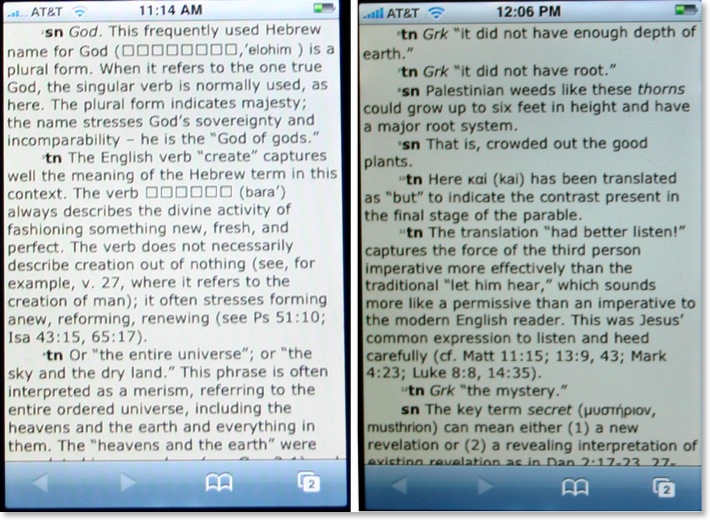
[Note: the actual screens of the NET Bible notes are the same color. The images above just reflect my poor photography skills.]
As I mentioned in a previous post, Hebrew does not show up correctly yet on the iPhone. So notice on the left image which contains notes from Genesis 1, that square boxes appear where Hebrew text displays in the original. There are other places where the boxes show up in place of Hebrew, such as the section headings in Psalm 119 and references to Sinaiticus in the NT notes. However, on the right screen, with notes from Mark 4, the Greek word μυστήριον appears correctly. I would recommend to the NET Bible team that for right now they do nothing to "fix" this text. The iPhone will have to include Hebrew as the phone is marketed internationally. One would assume that the addition of Hebrew and other international fonts will be included in a later iPhone software update. I should also point out that the since I took these shots, the superscript numbering at the beginning of each note has been enlarged.
The NET Bible on the iPhone will no doubt be very beneficial to many iPhone users, including myself. Like a lot of these apps, there's no search feature as of yet. I might also throw out a challenge to the programmers to create a window that has the biblical text on top and the notes on bottom (or side to side if the phone is turned). Regardless, this is a good and needed beginning.
God's iPhone (GWT)

[Note: the above image was taken as a screenshot off my MacBook because the opening screen has changed so dramatically since I first took my photographs.]
God's iPhone was created by Israel Anderson of New Zealand. This Bible app uses the lesser known, but still very good, God's Word Translation of the Bible. This project is not yet complete, but so far, Anderson has made available the entire New Testament and parts of the Old Testament (Genesis, Exodus, and Psalms). Also Anderson has added a section for Christian classic (presumably public domain) works. The first entry made available is A. W. Tozer's Pursuit of God.
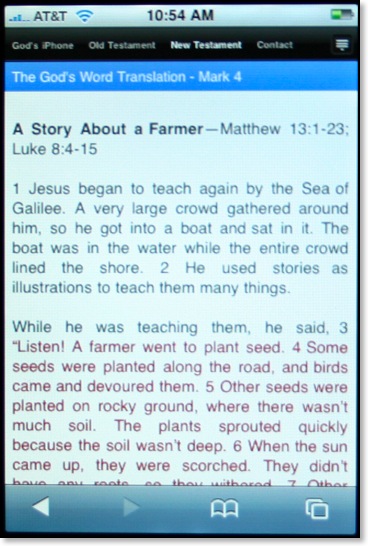
I'm assuming that Anderson has used RapidWeaver's new iPhone template for his Bible app. As a RW user myself I've played around with this template in hopes of eventually offering a Greek NT for the iPhone (but I'm not sure how legal this is since the NA text is copyrighted). The RW iPhone template includes a drop down menu seen in the icon at the far right of the image above. Anderson has opted not to take advantage of this leaving all menu items on the screen. This is just as well because I've found it difficult to make selections with this menu in my own tests.
As seen in the image above, text is clear and well spaced, but I can't help thinking it would be easier to read if the text were not displayed using full justification. Studies have shown that full justification, while looking neat and orderly, is actually harder to read because it makes it harder for the eyes to find the next line.
Regardless, God's iPhone has an easy to use interface and has the distinction of being the only way to view the GWT on the iPhone. There is no search function yet, but it is still a work in progress.
ESV Mobile
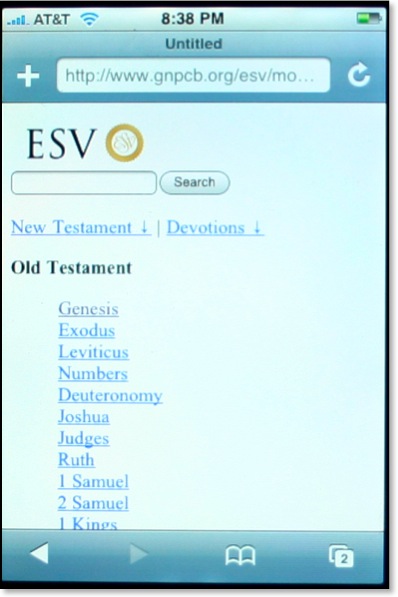
I've found the community of ESV users to be quite savvy when it comes to the internet and most things technological. They tend to be forward thinking and embrace new technologies quicker than those who sponsor competing translations of the Bible. Crossway, the publisher of the ESV has updated their mobile site making it more iPhone friendly. This now makes three separate iPhone apps that use the ESV (iBibleSpace uses the ESV by default and 3onesix allows for the ESV by including the abbreviation before a search). Crossway is distinguished as being the first major Bible publisher as of this writing that has offered a method of reading the Bible to iPhone users.
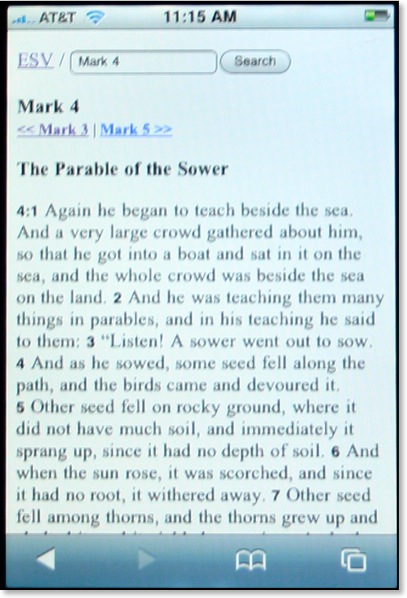
A very helpful feature of the ESV Mobile site is the inclusion of a search feature on every screen. The text is formatted with plenty of space, perhaps even better than iBibleSpace which tends to run headings and text together and use a verse by verse format. Oddly however, the text itself when viewed on the iPhone is serifed in spite of the fact that when I look at it on my MacBook it is sans serifed. I'm not sure what font is being used, or if one is specified at all, but I would think a sans serifed font like Arial or Helvetica would be much easier to read not only on the iPhone, but other mobile devices as well.
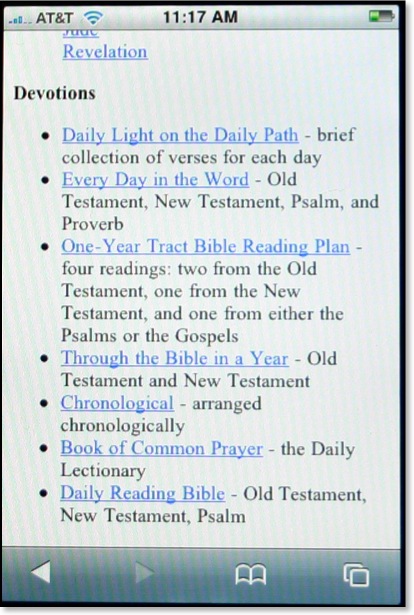
The ESV Mobile site also offers a variety of daily devotionals/readings as well. Like I said in my review of iBibleSpace, I can't imagine reading a devotional from my iPhone (or even a full daily reading of the BIble), but others may be more so inclined.
If you hear of an iPhone Bible app, or an iPhone app related to biblical studies, be sure to let me know and I'll mention it here on This Lamp.
Plural "You" in John 1:51

My third point, drawn from John 1:47-51, I labeled "Be ready for the unexpected." In my initial study of this passage, I noticed that in the Greek that in v. 51 Jesus shifts from simply addressing Nathaniel to addressing other disciples who were presumably present. Translating a plural you into English can be a bit tricky since we technically don't have a separate word in standard English for the second person plural. A fairly literal translation of this verse would read something like this:
And he said to him, "Truly, truly I say to y'all [ὑμῖν], y'all will see [ὄψεσθε] heaven open...
Of course, I can translate with y'all because I grew up in the south. And I should also mention that the KJV communicates the second person plural (at least clearly in the second instance) because Elizabethan English also allowed for the distinction by using the now archaic ye:
And he saith unto him, Verily, verily, I say unto you, Hereafter ye shall see heaven open (John 1:51 KJV)
Regardless, when there is a shift of person in the Bible such as that in v. 51, I readily admit that it's not always significant. But here I believe it is. Jesus' message of what a disciple would experience was not something meant for Nathaniel alone. A few translations make an effort to represent the second person plural, but most traditionally have not. Originally, I had been planning to use the NLT for this message, not only because I believe it communicated the entire passage well, but especially because it brought out the plural "you" here:
Then he said, “I tell you the truth, you will all see heaven open... (John 1:51 NLT)
However, then on Friday, I received my copy of the NET Readers Bible in the mail. Looking at the passage and especially v. 51, I was pleased to see the second person plural rendered here as well:
He continued, “I tell all of you the solemn truth–you will see heaven opened... (John 1:51 NET)
Thus I began my little "NET for a month" experiment and preached from it on Sunday.
I should point out that a number of other translations mention the plural "you's" in the footnotes, including the ESV, HCSB, NRSV, NIV and TNIV. The REB is another translation that renders the plural in the actual text.
So which is better: text or notes? I would suggest that the better rendering is when it can be done in the text for the sake of those listening without a Bible in front of them.
Feel free to leave your opinion in the comments.
NET for a Month

I’m doing this so that I can get to know the translation better. When I wrote my Top Ten Bible Translations series, I included the NET Bible in my honorable mentions but not in my top ten. Like most who are familiar with the NET, I’ve been very impressed with the inclusion of the 60K+ notes in the regular edition, but I’ve never spent a whole lot of time with the translation itself. I’ll confess that my limited amount of time with the NET has made me think the translation is a bit flat at times, kind of like the original NIV. However, this may be an unfair assessment since as I have said, I really have not spent enough time with it to give the NET translation a fair evaluation.
I’d been planning this little experiment for a while, but today I received in the mail a nice top grain leather edition of the Reader’s Edition of the NET sent to me by Mitch Guthrie who works with Bible.org. This is a really nice edition of the NET Bible, with only about 10% of the full notes, but fits in the hand quite well. It has a very readable print size and mercifully, it’s not a thinline. [Thanks again for the Bible, Mitch.]
So, in an attempt to become better friends with the NET, I am going to attempt to use it as a primary (but not exclusive) translation over the next month or so. That means when I leave the house, I’ll take the NET Bible with me. I’ll use it for teaching as well as preaching (I’m filling in for my pastor day after tomorrow) and I’ll use it in my IWU classes for our devotionals. As I often bring along a Greek NT in my book bag, too, I’m going to take the NET Diglot instead of the normal Greek NT I carry.
Although my top ten series is over, I promised to continue reviewing Bible translations. So after my 30 days or so with the NET Bible, I’ll post a full review along the same kind of format as my earlier reviews. Look for this sometime in September.
Missing My Wide Margin NASB
Frequent readers of This Lamp will remember that although I've always been an aficionado of Bible translations, I used the NASB for almost two decades in teaching and preaching settings until I became convicted a couple of years ago that the formality and literalness of the translation itself was getting in the way of what I was trying to teach. Since then, I have primarily used the TNIV in public, but I've also used the HCSB and NLT to a certain extent as well. And often even when needing to carry a translation to a setting where I wasn't presenting, I tended to pick up my TNIV.
But yesterday is a good example of this "change" in my habits. I've been meeting a friend of mine for breakfast for a couple of years now, and we usually read a book together and discuss it over bagels. Over the last few weeks we've been reading Bonhoeffer's Cost of Discipleship. Yesterday as I was heading out the door to meet for breakfast, I grabbed a Bible as I always do. But instead of grabbing the TNIV Study Bible which has been my practice for a few months, I picked up my wide margin NASB.

Doesn't the TNIV Study Bible have notes? Sure it does. But the notes in my NASB are my notes. These notes are the facts and insights that stuck out to me. These notes are the triggers I used to discuss the text when I was teaching it last. The TNIV Study Bible is the first study Bible that I have ever consistently carried with me. It's notes are helpful, but I find that I don't automatically turn to them. I look at them if I need to look something up and hope that the information I need is there.
After using other Bibles for over a year and a half now, I have to admit that i really miss my wide margin NASB. And I don't think it's the NASB that I miss so much, although I will always have a great familiarity with it. What I miss is the ability to refer to my notes, to refer to a tangible experience of having spent time--studied and wrestled--with a particular passage before. I don't have notes on every page of my Bible. But the notes that I do have are footprints that I was there, evidence that I stopped and camped out a while, as opposed to merely passing by.
I stay in a continuing conundrum. I really do feel committed to public use of a contemporary translation. And I would prefer a gender-accurate, non-Tyndale translation when presenting in front of mixed audiences. But no usable wide margin edition of a contemporary translation exists that meets these factors. There is no wide margin NLT and the only wide margin TNIV offering limits writing space to one column on a two column page and has paper too thin for extensive use. I might be willing to settle for the HCSB even though it is not gender accurate, but the pages in its only wide margin offering are so thin that they curl when writing on them.
At this point, I would like a new wide margin Bible (leather, of course) in a contemporary translation--any translation. I'm willing to transcribe my notes even a third time. TNIV? NLT? NET? HCSB? Something else? At this point, I'm not even overly concerned with the exact translation, in spite of the fact that I have my personal favorites and feel some are better suited for teaching than others. Whichever publisher first delivers a wide margin edition in one of these translation wins--at least with me.
Every Sunday morning when I leave for church, I push aside my wide margin NASB in favor of the TNIV Study Bible. Despite the fact that as I've studied a passage that I will be teaching I've taken diligent notes in the margins of my NASB, I've been forced to create a subset of these notes in the anemic margins of the TNIV Study Bible or in whatever white space I can manage. But the temptation to grab my trusty NASB and run remains. And I wonder if this temptation is growing stronger?
Biblical Fonts on the iPhone: Greek--YES! Hebrew--NO!
As I said in my post yesterday reviewing Bible apps on the iPhone, I would like to eventually see original language biblical texts on the iPhone in addition to the English translations already available. So I decided to conduct a couple of tests on my own. If the iPhone won't display Hebrew, will it display Greek?
First, I wanted to confirm the lack of Hebrew character support, so I ran over to Iyov's blog where I remember he used some Hebrew fonts last Monday in regard to a post by yours truly. Below is an actual photograph of my iPhone screen on Iyov's post "Brief Notes (Rosh Chodesh Av, 5767)":
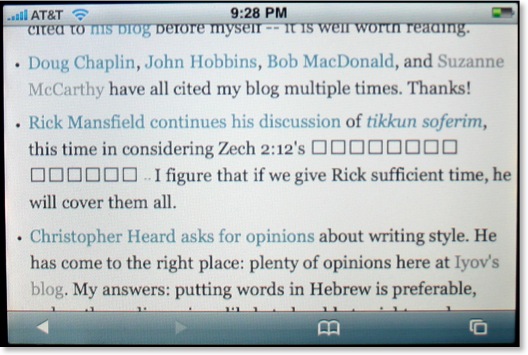
Sure enough--the Hebrew does not display at all.
So what about Greek? On Wednesday, Suzanne McCarthy posted an entry on the Better Bibles Blog titled "From Sapho 2." While not technically a biblical passage, the post includes Greek text. Here is another photo of my iPhone:
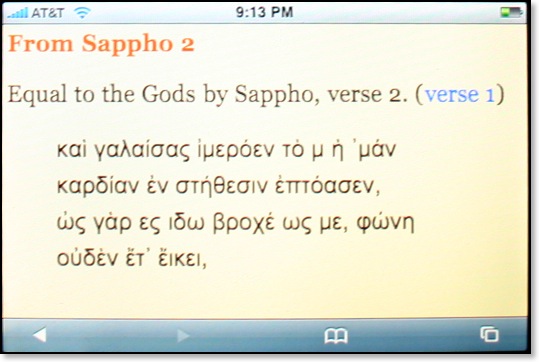
As you can see the Greek renders fine--in fact, it's perfect. So why doesn't the Hebrew? Modern Unicode fonts include characters for both Greek and Hebrew as well as quite a few other character language sets. My only conclusion is that iPhone v. 1 software uses limited font sets.
Hopefully, as the iPhone is introduced in other parts of the world, these missing languages--including Hebrew--will be added in.
TNIV Truth: TNIV on the iPhone
See my newest post at TNIV Truth.
iPhone Bible App Roundup: July 2007
Let me say up front that on the iPhone, there's nothing like the kind of offerings Olive Tree has for other PDA's and smartphones. In fact, I contacted Olive Tree to see if they were working on any kind of solution for the iPhone. They asked me if I would be interested in testing the text files they offer for iPods on my iPhone since no one at Olive Tree actually has an iPhone. I had to inform them that text files cannot be placed on an iPhone in the same manner that one can on an iPod because the free space on the iPhone's flash drive cannot be directly accessed. At this point, I don't know where Olive Tree's strategy stands for the iPhone, if there is one at all.
A major drawback of the iPhone is that Apple will not allow third party applications on the iPhone at this point. Now, I've heard rumors that a software development kit is in the works, but supposedly the Windows version isn't up to speed with the OS X version at the moment, so Apple wants to wait until the SDK's have platform parity before either is released. These days, Apple Inc. (no longer Apple Computer) has quite a few Windows software offerings and actually sells more iPods and iPhones to Windows users than to Mac users. Until the Windows SDK is up to par, we have no third party apps. Again...if this rumor is true at all.
The solution, and one endorsed publicly by Apple, revolves around Web 2.0 apps that can run in the iPhone's stripped down Safari browser. Quite a few "programs" have been released so far and are cataloged at websites such as The iPhone Application List. Some of these applications are quite handy, but in the interest of myself and readers of this blog, I thought I would try to create an ongoing series regarding the Bible offerings for the iPhone as they become available.
Currently, there are three iPhone applications that offer access to the Bible. I will offer brief reviews of them in the order they were released.
iPhone Scriptures/LDS Standard Works (KJV & Mormon)
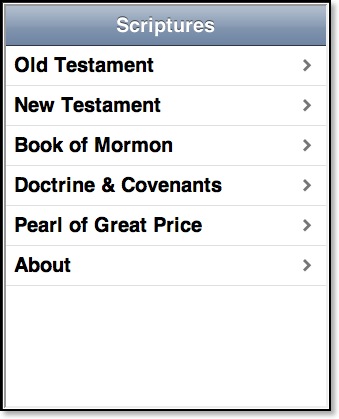
Technically, these are two separate programs, but they use a similar interface, so I'm going to assume there's some connection between them. Released about a week after the launch, iPhone Scriptures was the first Bible related app available for the iPhone. The interface is straightforward. Clicking on a selection such as "New Testament" offers the user a list of New Testament books. Selecting a book takes the reader to another screen with chapter numbers. Selecting a chapter yields the entire text for that chapter:
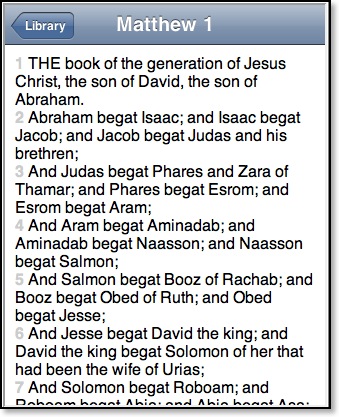
The button at the top of the text that says "Library" takes the reader back to the initial screen. What seems to be an obvious omission are arrows that would take the reader to the previous or next chapters. No search features are present, but it's promised to be available soon. In case you didn't notice, the biblical text is limited to the King James Version, which is the officially used translation of the Mormon Church. This isn't surprising, but will certainly limit widespread use of this program.
The only functional difference between iPhone Scriptures and LDS Standard Works is the ability to turn off the Mormon Scriptures in the latter program for those who don't want to look at the Mormon-specific titles. This is done in a "Settings" tab at the bottom in place of the "About" tab in iPhone Scriptures.
I saw iPhone Scriptures within a day or two of it's release, and the initial interface had very tiny tabs making it virtually unusable. The current version is much improved.
3onesix Ministry Tools (NIV)
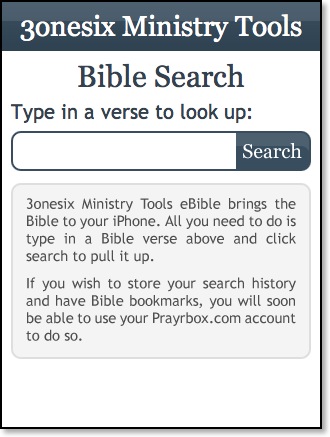
This Bible was released around July 10, and takes a slightly different approach to accessing the Scriptures than the programs mentioned above. In 3onesix Ministry Tools, the user must know what passage he or she wants to view in advance. For instance, typing "Matthew 1" results in that chapter being displayed.
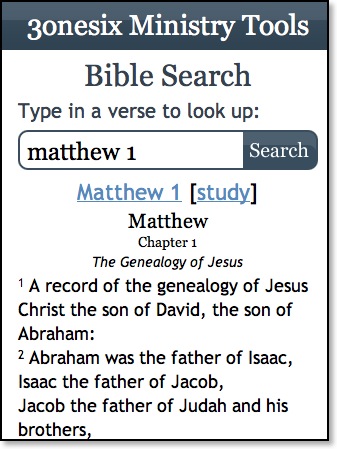
Clicking either of the links on the chapter screen takes the user to the regular eBible website which is what this program is based on. Currently, the only text available from 3onesix is the NIV, but one would hope that others would eventually be made available since eBible offers multiple versions. At the moment, unless the user goes to the eBible site, there is no direct search feature in the app specifically made for the iPhone.
iBibleSpace (ESV)
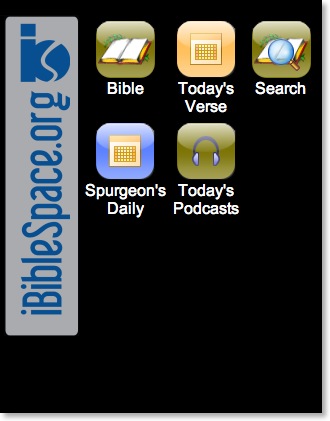
By far the most impressive iPhone Bible app to date is iBibleSpace released a couple of days ago. Anyone who has already spent time on an iPhone will immediately recognize an interface that draws its cues from the regular iPhone home screen. By choosing the first option, "Bible," one is presented with a similar interface as found in the original iPhone Scriptures application mentioned above, but it's designed to look much better in iBibleSpace. Again, the user can select a book of the BIble (OT & NT books are on the same screen), and then a chapter.
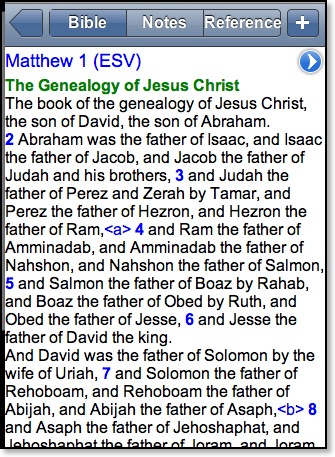
The text as shown above is quite clear, and contrary to the screenshots I took above on my MacBook (I don't know of any way to grab screens on my iPhone), the text such as the word "Reference" above fits perfectly onto it's button on the iPhone.
iBibleSpace has quite a few features going for it that puts it ahead of the other two iPhone Bibles. First of all, the ESV text as shown here includes access to textual footnotes: notice the "" at the end of v. 3. That note designation is actually hyperlinked and will take the user to the bottom of the screen where the footnotes all appear at the end of any chapter. You might also notice the right-pointing arrow that will take the user to--you guessed it--chapter 2 where there are both previous chapter and next chapter buttons.
A number of other options are offered at the top of the screen as well. The large single-colored left pointing arrow will take the user back to a listing of all chapters in the biblical book. The "Notes" button allows the reader to access a personalized account where one can store customized notes. The plus (+) button on the far right allows the user to add a new note and even highlight a verse in one of six different colors [gee, maybe I could transfer all the notes from my wide margin NASB to my iPhone!...or maybe not]. The "Reference" button takes the user to notes from Matthew Henry's Concise Commentary (not of great interest to me, but it's a nifty feature, nonetheless).
The only real downside I saw of the biblical text in iBibleSpace was the dreaded words of Christ in red. If this "feature" could be turned off, I believe that would be helpful to many.
Going back to the IBibleSpace main screen is simple because it always remains as a separate page/tab in the iPhone browser (in case you didn't know, the iPhone will allow the user to have multiple pages open at once, much like tabs in regular browsers). "Today's Verse" is just what you would expect it to be: a daily Bible verse. There is a link to read the entire chapter from which the verse comes in context if one is so inclined.
Another distinguishing feature of iBibleSpace is its search feature:
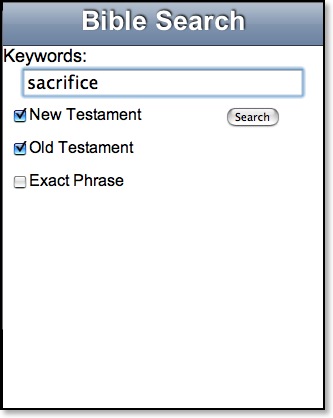
One can search either or both testaments and exact phrases. Results are displayed in groups of five at a time with an option to select "More."
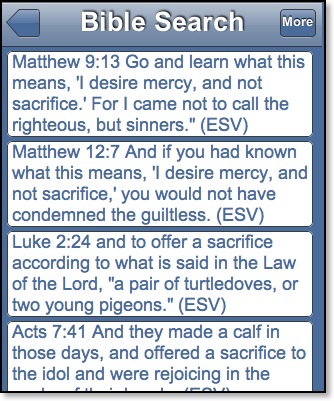
However, I found it odd that NT hits are listed before OT results. I would prefer them my results to be listed in canonical order. Further, in most Bible programs the search word is usually highlighted in some way, but not so in iBibleSpace.
The other two buttons on the home screen will lead the user to daily devotions from Spurgeon or podcasts from a variety of conservative Christian radio shows. The selections are a bit odd in my opinion. I cringed when I saw Joyce Meyer, but I occasionally enjoy listening to Ravi Zacharias' show. The great majority of the offerings, however, I would not have any regular interest in. I also doubt I'd run to my iPhone for a daily devotional from Charles Spurgeon either. In fact, it seems odd to me that it's a primary button on the home screen.
Regarding the podcasts, though, I followed one all the way to the show to see if the iPhone would actually play it. The link was to an MP3 file that launched QuickTime on the iPhone. I think that was the first time that I realized that I even had QuickTime on my iPhone!
iBibleSpace is impressive on many levels: features, design, and consistency of its interface (one never follows a link that leads to a page not formatted to the iPhone unlike the 3onesix app). Even though the ESV is not one of my preferred translations, I put iBibleSpace at the top of my iPhone app bookmarks. At the present time, iBibleSpace is far and away the best Bible app available for the iPhone.
I'd still like to see original language texts on the iPhone, although I have no idea if the iPhone would even support Greek and Hebrew fonts. Of course one would presume that it is using Unicode fonts already. Something like the NET Bible would be interesting to have on the iPhone as well, and perhaps because the folks behind the NET have been so Internet savvy, we will see something in the near future. One also wonders if an iPhone interface to something like Bible Gateway couldn't be created to take advantage of multiple translations.
Further, I still am hopeful for third party apps. The major drawback of any of these apps relates to their dependence on the Internet. Even with a WiFi connection, they are not as fast as a native application would be.
In the meantime, three weeks have yielded three distinct Bible apps of varying creativity and features. As others will undoubtedly come available in the weeks ahead, I'll be sure to cover as many as possible here on This Lamp.
Comparing Apples to Pupils: Zechariah 2:8 in the HCSB, NET, and NLT
also all Hebrew below has been transliterated as RapidWeaver seems to continue to have difficulties correctly rendering Unicode Hebrew]
I've stated on a number of occasions how much I respect the HCSB translators' decision to regard accuracy over tradition in many of the translation's renderings. In my review last year of the HCSB, I remarked that although the HCSB courageously breaks with traditional wording of a favorite verse like John 3:16, it does so strictly for the sake of better communicating the meaning of that verse which is easily misunderstood in most translations.
And so it is with Zech 2:8 which was part of our Bible study yesterday at church.
Zechariah 2:8 |
|
Traditional Renderings |
Accurate Renderings |
| For thus saith the LORD of hosts; After the glory hath he sent me unto the nations which spoiled you: for he that toucheth you toucheth the apple of his eye. (KJV) | For the LORD of Hosts says this: “He has sent Me for |His| glory against the nations who are plundering you, for anyone who touches you touches the pupil of His eye. (HCSB) |
| For this is what the LORD Almighty says: “After the Glorious One has sent me against the nations that have plundered you—for whoever touches you touches the apple of his eye— (TNIV) | For the LORD who rules over all says to me that for his own glory he has sent me to the nations that plundered you–for anyone who touches you touches the pupil of his eye. (NET) |

Using Accordance, I scanned the KJV to determine that this translation uses the English word apple for four separate Hebrew words in the OT:
- ’ishwon: Deut 32:10; Ps 17:8; Prov 7:2
- tappuach: Song 2:3; 8:5; Joel 1:12
- vat: Lam 2:18
- vava: Zech 2:8
If anything, "apple of his eye" seems to communicate something slightly different in our culture than what was intended in the text. I did a quick survey of my class yesterday as to the meaning of "apple of his/my eye" and most responses were of the "cutesy" variety, often noting the idea of a daughter being the apple of her father's eye.
In Zech 2:8, vava literally means "gate" of the eye; but ultimately, that's too literal for understanding in English. The meaning here is essentially the pupil as the HCSB and NET correctly translate it. McComiskey notes:
In this analogy, the eye is Yahweh's [...] As the eye is extremely sensitive to touch, so God is sensitive to what threatens his people. The statement develops further the important postexilic theme that God will protect his people and allow no hostile intervention. (The Minor Prophets, vol. 3, p. 1061)
In other words, to mess with God's people is like poking a stick in God's eye, so watch out!
One more note: the NLTse translation of Zech 2:8 bypasses the apple/pupil issue to focus on the meaning of the phrase:
After a period of glory, the LORD of Heaven’s Armies sent me against the nations who plundered you. For he said, “Anyone who harms you harms my most precious possession.
But more important than that, of all the most recent translations, only the NLT attempts to correct the tiqqune soferim found in this verse. That is, the ancient Hebrew scribes were offended at the idea of poking a stick in God's eye, so the wording was changed from "my eye" to "his eye." Thus, in the end, according to one's opinion and evaluation of the dynamic rendering "my most precious possession," the NLT may turn out to be the most accurate translation of Zech 2:8 of those surveyed here.
For another look at a tiqqune soferim, see my post on Hab 1:12.
Forthcoming Wide-Margin Bible Survey Update
Here's where you can help me. Take a look at the original post linked in the above paragraph. If you know of any new wide-margin Bibles that have been released, please leave the information in the comments below so I can include it.
Also, although I opted not to include KJV offerings last time, I occasionally get emails asking about KJV wide-margin Bibles. I still don't recommend the KJV as a primary study Bible, which is why I didn't list them last time. However, I am considering adding them to the new survey, so if you know of some specific KJV wide-margins out there, please let me know--especially if you can give descriptions of them.
2007 ESV Changes: Hebrews - Revelation
The verses below are from the General Epistles and Revelation.
2001 ESV |
2007 ESV |
|
| Heb 2:11 | For he who sanctifies and those who are sanctified all have one origin. That is why he is not ashamed to call them brothers, | For he who sanctifies and those who are sanctified all have one source. That is why he is not ashamed to call them brothers, |
| Heb 3:9-10 Note verse division. |
9 where your fathers put me to the test and saw my works 10 for forty years. Therefore I was provoked with that generation, and said, ‘They always go astray in their heart; they have not known my ways.’ |
9 where your fathers put me to the test and saw my works for forty years. 10 Therefore I was provoked with that generation, and said, ‘They always go astray in their heart; they have not known my ways.’ |
| Heb 3:14 | For we share in Christ, if indeed we hold our original confidence firm to the end. | For we have come to share in Christ, if indeed we hold our original confidence firm to the end. |
| Heb 6:4 | For it is impossible to restore again to repentance those who have once been enlightened, who have tasted the heavenly gift, and have shared in the Holy Spirit, | For it is impossible, in the case of those who have once been enlightened, who have tasted the heavenly gift, and have shared in the Holy Spirit, |
| Heb 6:6 | if they then fall away, since they are crucifying once again the Son of God to their own harm and holding him up to contempt. | and then have fallen away, to restore them again to repentance, since they are crucifying once again the Son of God to their own harm and holding him up to contempt. |
Heb 6:10 |
For God is not so unjust as to overlook your work and the love that you showed for his sake in serving the saints, as you still do. | For God is not unjust so as to overlook your work and the love that you have shown for his name in serving the saints, as you still do. |
| Heb 7:18 | On the one hand, a former commandment is set aside because of its weakness and uselessness | For on the one hand, a former commandment is set aside because of its weakness and uselessness |
| Heb 9:13 | For if the sprinkling of defiled persons with the blood of goats and bulls and with the ashes of a heifer sanctifies for the purification of the flesh, | For if the blood of goats and bulls, and the sprinkling of defiled persons with the ashes of a heifer, sanctify for the purification of the flesh, |
| Heb 10:2 | Otherwise, would they not have ceased to be offered, since the worshipers, having once been cleansed, would no longer have any consciousness of sin? | Otherwise, would they not have ceased to be offered, since the worshipers, having once been cleansed, would no longer have any consciousness of sins? |
| Heb 10:3 | But in these sacrifices there is a reminder of sin every year. | But in these sacrifices there is a reminder of sins every year. |
| Heb 10:9 | then he added, “Behold, I have come to do your will.” He abolishes the first in order to establish the second. | then he added, “Behold, I have come to do your will.” He does away with the first in order to establish the second. |
| Heb 11:29 | By faith the people crossed the Red Sea as if on dry land, but the Egyptians, when they attempted to do the same, were drowned. | By faith the people crossed the Red Sea as on dry land, but the Egyptians, when they attempted to do the same, were drowned. |
| James 1:20 | for the anger of man does not produce the righteousness that God requires. | for the anger of man does not produce the righteousness of God. |
| James 1:27 | Religion that is pure and undefiled before God, and the Father, is this: to visit orphans and widows in their affliction, and to keep oneself unstained from the world. | Religion that is pure and undefiled before God, the Father, is this: to visit orphans and widows in their affliction, and to keep oneself unstained from the world. |
| James 3:2 | For we all stumble in many ways, and if anyone does not stumble in what he says, he is a perfect man, able also to bridle his whole body. | For we all stumble in many ways. And if anyone does not stumble in what he says, he is a perfect man, able also to bridle his whole body. |
James 5:6 |
You have condemned; you have murdered the righteous person. He does not resist you. | You have condemned and murdered the righteous person. He does not resist you. |
| 1 Pet 1:20 | He was foreknown before the foundation of the world but was made manifest in the last times for your sake, | He was foreknown before the foundation of the world but was made manifest in the last times for the sake of you |
| 1 Pet 2:2 | Like newborn infants, long for the pure spiritual milk, that by it you may grow up to salvation— | Like newborn infants, long for the pure spiritual milk, that by it you may grow up into salvation— |
| 1 Pet 3:3 | Do not let your adorning be external—the braiding of hair, the wearing of gold, or the putting on of clothing— | Do not let your adorning be external—the braiding of hair and the putting on of gold jewelry, or the clothing you wear— |
| 1 Pet 3:5 | For this is how the holy women who hoped in God used to adorn themselves, by submitting to their husbands, | For this is how the holy women who hoped in God used to adorn themselves, by submitting to their own husbands, |
| 1 Pet 3:15-16 Note verse division. |
15 but in your hearts regard Christ the Lord as holy, always being prepared to make a defense to anyone who asks you for a reason for the hope that is in you; 16 yet do it with gentleness and respect, having a good conscience, so that, when you are slandered, those who revile your good behavior in Christ may be put to shame. | 15 but in your hearts honor Christ the Lord as holy, always being prepared to make a defense to anyone who asks you for a reason for the hope that is in you; yet do it with gentleness and respect, 16 having a good conscience, so that, when you are slandered, those who revile your good behavior in Christ may be put to shame. |
| 1 Pet 4:3 | The time that is past suffices for doing what the Gentiles want to do, living in sensuality, passions, drunkenness, orgies, drinking parties, and lawless idolatry. | For the time that is past suffices for doing what the Gentiles want to do, living in sensuality, passions, drunkenness, orgies, drinking parties, and lawless idolatry. |
| 1 John 2:5 | but whoever keeps his word, in him truly the love of God is perfected. By this we may be sure that we are in him: | but whoever keeps his word, in him truly the love of God is perfected. By this we may know that we are in him: |
| 1 John 3:24 | Whoever keeps his commandments abides in him, and he in them. And by this we know that he abides in us, by the Spirit whom he has given us. | Whoever keeps his commandments abides in God, and God in him. And by this we know that he abides in us, by the Spirit whom he has given us. |
| Jude 12 | These are blemishes on your love feasts, as they feast with you without fear, looking after themselves; waterless clouds, swept along by winds; fruitless trees in late autumn, twice dead, uprooted; | These are hidden reefs at your love feasts, as they feast with you without fear, shepherds feeding themselves; waterless clouds, swept along by winds; fruitless trees in late autumn, twice dead, uprooted; |
| Jude 14 | It was also about these that Enoch, the seventh from Adam, prophesied, saying, “Behold, the Lord came with ten thousands of his holy ones, | It was also about these that Enoch, the seventh from Adam, prophesied, saying, “Behold, the Lord comes with ten thousands of his holy ones, |
| Jude 20 | But you, beloved, build yourselves up in your most holy faith; pray in the Holy Spirit; | But you, beloved, building yourselves up in your most holy faith and praying in the Holy Spirit, |
| Rev 1:14 | The hairs of his head were white like wool, as white as snow. His eyes were like a flame of fire, | The hairs of his head were white, like white wool, like snow. His eyes were like a flame of fire, |
| Rev 2:23 | and I will strike her children dead. And all the churches will know that I am he who searches mind and heart, and I will give to each of you as your works deserve. | and I will strike her children dead. And all the churches will know that I am he who searches mind and heart, and I will give to each of you according to your works. |
| Rev 6:4 | And out came another horse, bright red. Its rider was permitted to take peace from the earth, so that men should slay one another, and he was given a great sword. | And out came another horse, bright red. Its rider was permitted to take peace from the earth, so that people should slay one another, and he was given a great sword. |
| Rev 17:13 | These are of one mind and hand over their power and authority to the beast. | These are of one mind, and they hand over their power and authority to the beast. |
See also:
• Genesis - Deuteronomy
• Joshua - Esther
• Job - Song of Solomon
• Isaiah - Malachi
• Matthew - Acts
• Romans - Philemon
2007 ESV Changes: Romans - Philemon
I look forward to your thoughts in the comments below, and I promise to revisit some of these specific passages in a future post, perhaps in a formal review of the 2007 ESV.
2001 ESV |
2007 ESV |
|
| Rom 1:23 | and exchanged the glory of the immortal God for images resembling mortal man and birds and animals and reptiles. | and exchanged the glory of the immortal God for images resembling mortal man and birds and animals and creeping things. |
| Rom 2:2 | We know that the judgment of God rightly falls on those who do such things. | We know that the judgment of God rightly falls on those who practice such things. |
| Rom 2:3 | Do you suppose, O man—you who judge those who do such things and yet do them yourself—that you will escape the judgment of God | Do you suppose, O man—you who judge those who practice such things and yet do them yourself—that you will escape the judgment of God? |
| Rom 3:30 | since God is one. He will justify the circumcised by faith and the uncircumcised through faith. | since God is one—who will justify the circumcised by faith and the uncircumcised through faith. |
| Rom 4:5 | And to the one who does not work but trusts him who justifies the ungodly, his faith is counted as righteousness, | And to the one who does not work but believes in him who justifies the ungodly, his faith is counted as righteousness, |
| Rom 5:17 | If, because of one man’s trespass, death reigned through that one man, much more will those who receive the abundance of grace and the free gift of righteousness reign in life through the one man Jesus Christ. | For if, because of one man’s trespass, death reigned through that one man, much more will those who receive the abundance of grace and the free gift of righteousness reign in life through the one man Jesus Christ. |
| Rom 6:12 | Let not sin therefore reign in your mortal bodies, to make you obey their passions. | Let not sin therefore reign in your mortal body, to make you obey its passions. |
| Rom 6:20 | When you were slaves of sin, you were free in regard to righteousness. | For when you were slaves of sin, you were free in regard to righteousness. |
| Rom 6:21 | But what fruit were you getting at that time from the things of which you are now ashamed? The end of those things is death. | But what fruit were you getting at that time from the things of which you are now ashamed? For the end of those things is death. |
| Rom 7:2 | Thus a married woman is bound by law to her husband while he lives, but if her husband dies she is released from the law of marriage. | For a married woman is bound by law to her husband while he lives, but if her husband dies she is released from the law of marriage |
| Rom 7:6 | But now we are released from the law, having died to that which held us captive, so that we serve not under the old written code but in the new life of the Spirit. | But now we are released from the law, having died to that which held us captive, so that we serve in the new way of the Spirit and not in the old way of the written code. |
| Rom 7:7 | What then shall we say? That the law is sin? By no means! Yet if it had not been for the law, I would not have known sin. I would not have known what it is to covet if the law had not said, “You shall not covet.” | What then shall we say? That the law is sin? By no means! Yet if it had not been for the law, I would not have known sin. For I would not have known what it is to covet if the law had not said, “You shall not covet.” |
| Rom 7:8 | But sin, seizing an opportunity through the commandment, produced in me all kinds of covetousness. Apart from the law, sin lies dead. | But sin, seizing an opportunity through the commandment, produced in me all kinds of covetousness. For apart from the law, sin lies dead. |
| Rom 7:15 | I do not understand my own actions. For I do not do what I want, but I do the very thing I hate. | For I do not understand my own actions. For I do not do what I want, but I do the very thing I hate. |
| Rom 8:6 | To set the mind on the flesh is death, but to set the mind on the Spirit is life and peace. | For to set the mind on the flesh is death, but to set the mind on the Spirit is life and peace. |
| Rom 8:21 | that the creation itself will be set free from its bondage to decay and obtain the freedom of the glory of the children of God. | that the creation itself will be set free from its bondage to corruption and obtain the freedom of the glory of the children of God. |
| Rom 9:10 | And not only so, but also when Rebecca had conceived children by one man, our forefather Isaac, | And not only so, but salso when Rebekah had conceived children by one man, our forefather Isaac, |
| Rom 9:11 | though they were not yet born and had done nothing either good or bad—in order that God’s purpose of election might continue, not because of works but because of his call— | though they were not yet born and had done nothing either good or bad—in order that God’s purpose of election might continue, not because of works but because of him who calls— |
| Rom 9:21 | Has the potter no right over the clay, to make out of the same lump one vessel for honored use and another for dishonorable use? | Has the potter no right over the clay, to make out of the same lump one vessel for honorable use and another for dishonorable use? |
| Rom 10:2 | I bear them witness that they have a zeal for God, but not according to knowledge. | For I bear them witness that they have a zeal for God, but not according to knowledge. |
| Rom 10:3 | For, being ignorant of the righteousness that comes from God, and seeking to establish their own, they did not submit to God’s righteousness. | For, being ignorant of the righteousness of God, and seeking to establish their own, they did not submit to God’s righteousness. |
| Rom 10:12 | For there is no distinction between Jew and Greek; the same Lord is Lord of all, bestowing his riches on all who call on him. | For there is no distinction between Jew and Greek; for the same Lord is Lord of all, bestowing his riches on all who call on him. |
| Rom 10:14 | But how are they to call on him in whom they have not believed? And how are they to believe in him of whom they have never heard?* And how are they to hear without someone preaching? | How then will they call on him in whom they have not believed? And how are they to believe in him of whom they have never heard? And how are they to hear without someone preaching? |
| Rom 11:20 | That is true. They were broken off because of their unbelief, but you stand fast through faith. So do not become proud, but stand in awe. | That is true. They were broken off because of their unbelief, but you stand fast through faith. So do not become proud, but fear. |
| Rom 11:25 | Lest you be wise in your own conceits, I want you to understand this mystery, brothers: a partial hardening has come upon Israel, until the fullness of the Gentiles has come in. | Lest you be wise in your own sight, I want you to understand this mystery, brothers: a partial hardening has come upon Israel, until the fullness of the Gentiles has come in. |
| Rom 11:30 | Just as you were at one time disobedient to God but now have received mercy because of their disobedience, | For just as you were at one time disobedient to God but now have received mercy because of their disobedience, |
| Rom 12:16 | Live in harmony with one another. Do not be haughty, but associate with the lowly. Never be conceited. | Live in harmony with one another. Do not be haughty, but associate with the lowly.Never be wise in your own sight. |
| Rom 13:6 | For the same reason you also pay taxes, for the authorities are ministers of God, attending to this very thing. | For because of this you also pay taxes, for the authorities are ministers of God, attending to this very thing. |
| Rom 13:9 | The commandments, “You shall not commit adultery, You shall not murder, You shall not steal, You shall not covet,” and any other commandment, are summed up in this word: “You shall love your neighbor as yourself.” | For the commandments, “You shall not commit adultery, You shall not murder, You shall not steal, You shall not covet,” and any other commandment, are summed up in this word: “You shall love your neighbor as yourself.” |
| Rom 14:8 | If we live, we live to the Lord, and if we die, we die to the Lord. So then, whether we live or whether we die, we are the Lord’s. | For if we live, we live to the Lord, and if we die, we die to the Lord. So then, whether we live or whether we die, we are the Lord’s. |
| Rom 15:27 | They were pleased to do it, and indeed they owe it to them. For if the Gentiles have come to share in their spiritual blessings, they ought also to be of service to them in material blessings. | For they were pleased to do it, and indeed they owe it to them. For if the Gentiles have come to share in their spiritual blessings, they ought also to be of service to them in material blessings. |
| 1 Cor 1:30 | He is the source of your life in Christ Jesus, whom God made our wisdom and our righteousness and sanctification and redemption. | And because of him you are in Christ Jesus, who became to us wisdom from God, righteousness and sanctification and redemption, |
| 1 Cor 1:31 | Therefore, as it is written, “Let the one who boasts, boast in the Lord.” | so that, as it is written, “Let the one who boasts, boast in the Lord.” |
| 1 Cor 4:4 | I am not aware of anything against myself, but I am not thereby acquitted. It is the Lord who judges me. | For I am not aware of anything against myself, but I am not thereby acquitted. It is the Lord who judges me. |
| 1 Cor 6:9 | Do you not know that the unrighteous will not inherit the kingdom of God? Do not be deceived: neither the sexually immoral, nor idolaters, nor adulterers, nor men who practice homosexuality, | Or do you not know that the unrighteous will not inherit the kingdom of God? Do not be deceived: neither the sexually immoral, nor idolaters, nor adulterers, nor men who practice homosexuality, |
| 1 Cor 7:9 | But if they cannot exercise self-control, they should marry. For it is better to marry than to be aflame with passion. | But if they cannot exercise self-control, they should marry. For it is better to marry than to burn with passion. |
| 1 Cor 7:16 | Wife, how do you know whether you will save your husband? Husband, how do you know whether you will save your wife? | For how do you know, wife, whether you will save your husband? Or how do you know, husband, whether you will save your wife? |
| 1 Cor 9:17 | For if I do this of my own will, I have a reward, but not of my own will, I am still entrusted with a stewardship. | For if I do this of my own will, I have a reward, but if not of my own will, I am still entrusted with a stewardship. |
| 1 Cor 9:24 | Do you not know that in a race all the runners compete, but only one receives the prize? So run that you may obtain it. | Do you not know that in a race all the runners run, but only one receives the prize? So run that you may obtain it. |
| 1 Cor 10:1 | I want you to know, brothers, that our fathers were all under the cloud, and all passed through the sea, | For I want you to know, brothers, that our fathers were all under the cloud, and all passed through the sea, |
| 1 Cor 11:5 | but every wife who prays or prophesies with her head uncovered dishonors her head—it is the same as if her head were shaven. | but every wife who prays or prophesies with her head uncovered dishonors her head, since it is the same as if her head were shaven. |
| 1 Cor 11:27 | Whoever, therefore, eats the bread or drinks the cup of the Lord in an unworthy manner will be guilty of profaning the body and blood of the Lord. | Whoever, therefore, eats the bread or drinks the cup of the Lord in an unworthy manner will be guilty concerning the body and blood of the Lord. |
| 1 Cor 12:8 | To one is given through the Spirit the utterance of wisdom, and to another the utterance of knowledge according to the same Spirit, | For to one is given through the Spirit the utterance of wisdom, and to another the utterance of knowledge according to the same Spirit, |
| 1 Cor 15:19 | If in this life only we have hoped in Christ, we are of all people most to be pitied. | If in Christ we have hope in this life only, we are of all people most to be pitied. |
| 1 Cor 15:30 | Why am I in danger every hour? | Why are we in danger every hour? |
| 2 Cor 2:10 | Anyone whom you forgive, I also forgive. What I have forgiven, if I have forgiven anything, has been for your sake in the presence of Christ, | Anyone whom you forgive, I also forgive. Indeed, what I have forgiven, if I have forgiven anything, has been for your sake in the presence of Christ, |
| 2 Cor 4:16 | So we do not lose heart. Though our outer nature is wasting away, our inner nature is being renewed day by day. | So we do not lose heart. Though our outer self is wasting away, our inner self is being renewed day by day. |
| 2 Cor 4:17 | For this slight momentary affliction is preparing for us an eternal weight of glory beyond all comparison, | For this light momentary affliction is preparing for us an eternal weight of glory beyond all comparison, |
| 2 Cor 5:1 | For we know that if the tent, which is our earthly home, is destroyed, we have a building from God, a house not made with hands, eternal in the heavens. | For we know that if the tent that is our earthly home is destroyed, we have a building from God, a house not made with hands, eternal in the heavens. |
| 2 Cor 8:3 | For they gave according to their means, as I can testify, and beyond their means, of their own free will, | For they gave according to their means, as I can testify, and beyond their means, of their own accord, |
| 2 Cor 8:13 | I do not mean that others should be eased and you burdened, but that as a matter of fairness | For I do not mean that others should be eased and you burdened, but that as a matter of fairness |
| 2 Cor 9:3 | But I am sending the brothers so that our boasting about you may not prove vain in this matter, so that you may be ready, as I said you would be. | But I am sending the brothers so that our boasting about you may not prove empty in this matter, so that you may be ready, as I said you would be. |
| 2 Cor 9:7 | Each one must give as he has made up his mind, not reluctantly or under compulsion, for God loves a cheerful giver. | Each one must give as he has decided in his heart, not reluctantly or under compulsion, for God loves a cheerful giver. |
| 2 Cor 9:11 | You will be enriched in every way for all your generosity, which through us will produce thanksgiving to God. | You will be enriched in every way to be generous in every way, which through us will produce thanksgiving to God. |
| 2 Cor 10:14 | For we are not overextending ourselves, as though we did not reach you. We were the first to come all the way to you with the gospel of Christ. | For we are not overextending ourselves, as though we did not reach you. For we were the first to come all the way to you with the gospel of Christ. |
| 2 Cor 11:2 | I feel a divine jealousy for you, for I betrothed you to one husband, to present you as a pure virgin to Christ. | For I feel a divine jealousy for you, since I betrothed you to one husband, to present you as a pure virgin to Christ. |
| 2 Cor 11:5 | I consider that I am not in the least inferior to these super-apostles. | Indeed, I consider that I am not in the least inferior to these super-apostles. |
| 2 Cor 12:7 | So to keep me from being too elated by the surpassing greatness of the revelations, a thorn was given me in the flesh, a messenger of Satan to harass me, to keep me from being too elated. | So to keep me from becoming conceited because of the surpassing greatness of the revelations,a thorn was given me in the flesh, a messenger of Satan to harass me, to keep me from becoming conceited. |
| Gal 2:21 | I do not nullify the grace of God, for if justification were through the law, then Christ died for no purpose. | I do not nullify the grace of God, for if righteousness were through the law, then Christ died for no purpose. |
| Gal 3:28 | There is neither Jew nor Greek, there is neither slave nor free, there is neither male nor female, for you are all one in Christ Jesus. | There is neither Jew nor Greek, there is neither slave nor free, there is no male and female, for you are all one in Christ Jesus. |
| Eph 1:5 | he predestined us for adoption through Jesus Christ, according to the purpose of his will, | he predestined us for adoption as sons through Jesus Christ, according to the purpose of his will, |
Eph 2:15 |
by abolishing the law of commandments and ordinances, that he might create in himself one new man in place of the two, so making peace, | by abolishing the law of commandments expressed in ordinances, that he might create in himself one new man in place of the two, so making peace, |
Eph 4:9 |
In saying, “He ascended,” what does it mean but that he had also descended into the lower parts of the earth? | In saying, “He ascended,” what does it mean but that he had also descended into the lower regions, the earth? |
| Eph 4:11 | And he gave the apostles, the prophets, the evangelists, the pastors and teachers, | And he gave the apostles, the prophets, the evangelists, the shepherds and teachers, |
| Eph 5:7 | Therefore do not associate with them; | Therefore do not become partners with them; |
| Eph 5:19 | addressing one another in psalms and hymns and spiritual songs, singing and making melody to the Lord with all your heart, | addressing one another in psalms and hymns and spiritual songs, singing and making melody to the Lord with your heart, |
| Phil 2:21 | They all seek their own interests, not those of Jesus Christ. | For they all seek their own interests, not those of Jesus Christ. |
| Phil 3:3 | For we are the real circumcision, who worship by the Spirit of God and glory in Christ Jesus and put no confidence in the flesh— | For we are the circumcision, who worship by the Spirit of God and glory in Christ Jesus and put no confidence in the flesh— |
| Col 3:12 | Put on then, as God’s chosen ones, holy and beloved, compassion, kindness, humility, meekness, and patience, | Put on then, as God’s chosen ones, holy and beloved, compassionate hearts, kindness, humility, meekness, and patience, |
| Col 4:5 | Conduct yourselves wisely toward outsiders, making the best use of the time. | Walk in wisdom toward outsiders, making the best use of the time. |
| 1 Thess 4:1 | Finally, then, brothers, we ask and urge you in the Lord Jesus, that as you received from us how you ought to live and to please God, just as you are doing, that you do so more and more. | Finally, then, brothers, we ask and urge you in the Lord Jesus, that as you received from us how you ought to walk and to please God, just as you are doing, that you do so more and more. |
| 1 Tim 1:3 | As I urged you when I was going to Macedonia, remain at Ephesus that you may charge certain persons not to teach any different doctrine, | As I urged you when I was going to Macedonia, remain at Ephesus so that you may charge certain persons not to teach any different doctrine, |
| 1 Tim 1:11 | in accordance with the glorious gospel of the blessed God with which I have been entrusted. | in accordance with the gospel of the glory of the blessed God with which I have been entrusted. |
| 1 Tim 3:15 | if I delay, you may know how one ought to behave in the household of God, which is the church of the living God, a pillar and buttress of truth. | if I delay, you may know how one ought to behave in the household of God, which is the church of the living God, a pillar and buttress of the truth. |
1 Tim 4:15 |
Practice these things, devote yourself to them, so that all may see your progress. | Practice these things, immerse yourself in them, so that all may see your progress. |
| 1 Tim 5:1 | Do not rebuke an older man but encourage him as you would a father. Treat younger men like brothers, | Do not rebuke an older man but encourage him as you would a father, younger men as brothers, |
| 1 Tim 5:2 | older women like mothers, younger women like sisters, in all purity. | older women as mothers, younger women as sisters, in all purity. |
| 1 Tim 5:16 | If any believing woman has relatives who are widows, let her care for them. Let the church not be burdened, so that it may care for those who are really widows. | If any believing woman has relatives who are widows, let her care for them. Let the church not be burdened, so that it may care for those who are truly widows. |
| 2 Tim 2:26 | and they may escape from the snare of the devil, after being captured by him to do his will. | and they may come to their senses and escape from the snare of the devil, after being captured by him to do his will. |
| Phlm 5 | because I hear of your love and of the faith that you have toward the Lord Jesus and all the saints, | because I hear of your love and of the faith that you have toward the Lord Jesus and for all the saints, |
| Phlm 14 | but I preferred to do nothing without your consent in order that your goodness might not be by compulsion but of your own free will. | but I preferred to do nothing without your consent in order that your goodness might not be by compulsion but of your own accord. |
See also:
• Genesis - Deuteronomy
• Joshua - Esther
• Job - Song of Solomon
• Isaiah - Malachi
• Matthew - Acts
• Hebrews - Revelation
2007 ESV Changes: Matthew - Acts
This selection includes all alterations from the Gospels and Acts.
2001 ESV |
2007 ESV |
|
| Matt 3:7 | But when he saw many of the Pharisees and Sadducees coming for baptism, he said to them, “You brood of vipers! Who warned you to flee from the wrath to come? | But when he saw many of the Pharisees and Sadducees coming to his baptism, he said to them, “You brood of vipers! Who warned you to flee from the wrath to come? |
| Matt 3:11 | I baptize you with water for repentance, but he who is coming after me is mightier than I, whose sandals I am not worthy to carry. He will baptize you with the Holy Spirit and with fire. | I baptize you with water for repentance, but he who is coming after me is mightier than I, whose sandals I am not worthy to carry. He will baptize you with the Holy Spirit and fire. |
| Matt 5:32 | But I say to you that everyone who divorces his wife, except on the ground of sexual immorality, makes her commit adultery. And whoever marries a divorced woman commits adultery. | But I say to you that everyone who divorces his wife, except on the ground of sexual immorality, makes her commit adultery, and whoever marries a divorced woman commits adultery. |
| Matt 8:18 | Now when Jesus saw a great crowd around him, he gave orders to go over to the other side. | Now when Jesus saw a crowd around him, he gave orders to go over to the other side. |
| Matt 13:17 | Truly, I say to you, many prophets and righteous people longed to see what you see, and did not see it, and to hear what you hear, and did not hear it. | For truly, I say to you, many prophets and righteous people longed to see what you see, and did not see it, and to hear what you hear, and did not hear it. |
| Matt 13:38 | The field is the world, and the good seed is the children of the kingdom. The weeds are the sons of the evil one, | The field is the world, and the good seed is the sons of the kingdom. The weeds are the sons of the evil one, |
| Matt 16:26 | For what will it profit a man if he gains the whole world and forfeits his life? Or what shall a man give in return for his life? | For what will it profit a man if he gains the whole world and forfeits his soul? Or what shall a man give in return for his soul? |
| Matt 17:18 | And Jesus rebuked him, and the demon came out of him, and the boy was healed instantly. | And Jesus rebuked the demon, and it came out of him, and the boy was healed instantly. |
| Matt 17:24 | When they came to Capernaum, the collectors of the half-shekel tax went up to Peter and said, “Does your teacher not pay the tax?” | When they came to Capernaum, the collectors of the two-drachma tax went up to Peter and said, “Does your teacher not pay the tax?” |
| Matt 19:5 | and said, ‘Therefore a man shall leave his father and his mother and hold fast to his wife, and they shall become one flesh’? | and said, ‘Therefore a man shall leave his father and his mother and hold fast to his wife, and the two shall become one flesh’? |
| Matt 22:15 | Then the Pharisees went and plotted how to entangle him in his talk. | Then the Pharisees went and plotted how to entangle him in his words. |
| Matt 24:37 | As were the days of Noah, so will be the coming of the Son of Man. | For as were the days of Noah, so will be the coming of the Son of Man. |
| Matt 25:26 | But his master answered him, ‘You wicked and slothful servant! You knew that I reap where I have not sowed and gather where I scattered no seed? | But his master answered him, ‘You wicked and slothful servant! You knew that I reap where I have not sown and gather where I scattered no seed? |
| Matt 27:62 | Next day, that is, after the day of Preparation, the chief priests and the Pharisees gathered before Pilate | The next day, that is, after the day of Preparation, the chief priests and the Pharisees gathered before Pilate |
| Mark 1:10 | And when he came up out of the water, immediately he saw the heavens opening and the Spirit descending on him like a dove. | And when he came up out of the water, immediately he saw the heavens being torn open and the Spirit descending on him like a dove. |
| Mark 2:5 | And when Jesus saw their faith, he said to the paralytic, “My son, your sins are forgiven.” | And when Jesus saw their faith, he said to the paralytic, “Son, your sins are forgiven.” |
| Mark 3:30 | for they had said, “He has an unclean spirit.” | for they were saying, “He has an unclean spirit.” |
| Mark 3:35 | Whoever does the will of God, he is my brother and sister and mother.” | For whoever does the will of God, he is my brother and sister and mother.” |
| Mark 4:41 | And they were filled with great fear and said to one another, “Who then is this, that even wind and sea obey him?” | And they were filled with great fear and said to one another, “Who then is this, that even the wind and the sea obey him?” |
| Mark 5:5 | Night and day among the tombs and on the mountains he was always crying out and bruising himself with stones. | Night and day among the tombs and on the mountains he was always crying out and cutting himself with stones. |
| Mark 7:25 | But immediately a woman whose little daughter was possessed by an unclean spirit heard of him and came and fell down at his feet. | But immediately a woman whose little daughter had an unclean spirit heard of him and came and fell down at his feet. |
| Mark 8:34 | And he called to him the crowd with his disciples and said to them, “If anyone would come after me, let him deny himself and take up his cross and follow me. | And calling the crowd to him with his disciples, he said to them, “If anyone would come after me, let him deny himself and take up his cross and follow me. |
| Mark 8:36 | For what does it profit a man to gain the whole world and forfeit his life? | For what does it profit a man to gain the whole world and forfeit his soul? |
| Mark 8:37 | For what can a man give in return for his life? | For what can a man give in return for his soul? |
| Mark 9:23 | And Jesus said to him, “If you can! All things are possible for one who believes.” | And Jesus said to him, “‘If you can’! All things are possible for one who believes.” |
| Mark 10:8 | and they shall become one flesh.’ So they are no longer two but one flesh. | and the two shall become one flesh.’ So they are no longer two but one flesh. |
| Mark 13:14 | But when you see the abomination of desolation standing where it ought not to be (let the reader understand), then let those who are in Judea flee to the mountains. | But when you see the abomination of desolation standing where he ought not to be (let the reader understand), then let those who are in Judea flee to the mountains. |
| Mark 13:22 | False christs and false prophets will arise and perform signs and wonders, to lead astray, if possible, the elect. | For false christs and false prophets will arise and perform signs and wonders, to lead astray, if possible, the elect. |
| Mark 13:35 | Therefore stay awake—for you do not know when the master of the house will come, in the evening, or at midnight, or when the cock crows, or in the morning— | Therefore stay awake—for you do not know when the master of the house will come, in the evening, or at midnight, or when the rooster crows, or in the morning— |
| Luke 1:19 | And the angel answered him, “I am Gabriel, who stands in the presence of God, and I was sent to speak to you and to bring you this good news. | And the angel answered him, “I am Gabriel. I stand in the presence of God, and I was sent to speak to you and to bring you this good news. |
| Luke 1:53 | he has filled the hungry with good things, and the rich he has sent empty away. |
he has filled the hungry with good things, and the rich he has sent away empty. |
| Luke 8:12 | The ones along the path are those who have heard. Then the devil comes and takes away the word from their hearts, so that they may not believe and be saved. | The ones along the path are those who have heard; then the devil comes and takes away the word from their hearts, so that they may not believe and be saved. |
| Luke 14:14 | and you will be blessed, because they cannot repay you. You will be repaid at the resurrection of the just.” | and you will be blessed, because they cannot repay you. For you will be repaid at the resurrection of the just.” |
| Luke 18:24 | Jesus, looking at him with sadness, said, “How difficult it is for those who have wealth to enter the kingdom of God! | Jesus, seeing that he had become sad, said, “How difficult it is for those who have wealth to enter the kingdom of God! |
| Luke 20:4 | Was the baptism of John from heaven or from man? | was the baptism of John from heaven or from man? |
| John 3:19 | And this is the judgment: the light has come into the world, and people loved the darkness rather than the light because their deeds were evil. | And this is the judgment: the light has come into the world, and people loved the darkness rather than the light because their works were evil. |
| John 3:20 | For everyone who does wicked things hates the light and does not come to the light, lest his deeds should be exposed. | For everyone who does wicked things hates the light and does not come to the light, lest his works should be exposed. |
| John 3:21 | But whoever does what is true comes to the light, so that it may be clearly seen that his deeds have been carried out in God. | But whoever does what is true comes to the light, so that it may be clearly seen that his works have been carried out in God. |
| John 4:7 | There came a woman of Samaria to draw water. Jesus said to her, “Give me a drink.” | A woman from Samaria came to draw water. Jesus said to her, “Give me a drink.” |
| John 4:14 | but whoever drinks of the water that I will give him will never be thirsty forever. The water that I will give him will become in him a spring of water welling up to eternal life. | but whoever drinks of the water that I will give him will never be thirsty again. The water that I will give him will become in him a spring of water welling up to eternal life. |
| John 5:46 | If you believed Moses, you would believe me; for he wrote of me. | For if you believed Moses, you would believe me; for he wrote of me. |
| John 6:58 | This is the bread that came down from heaven, not as the fathers ate and died. Whoever feeds on this bread will live forever. | This is the bread that came down from heaven, not like the bread the fathers ate and died. Whoever feeds on this bread will live forever. |
| John 6:53 | It is the Spirit who gives life; the flesh is of no avail. The words that I have spoken to you are spirit and life. | It is the Spirit who gives life; the flesh is no help at all. The words that I have spoken to you are spirit and life. |
| John 7:21 | Jesus answered them, “I did one deed, and you all marvel at it. | Jesus answered them, “I did one work, and you all marvel at it. |
| John 8:17 | In your Law it is written that the testimony of two men is true. | In your Law it is written that the testimony of two people is true. |
| John 8:39 | They answered him, “Abraham is our father.” Jesus said to them, “If you were Abraham’s children, you would be doing what Abraham did, | They answered him, “Abraham is our father.” Jesus said to them, “If you were Abraham’s children, you would be doing the works Abraham did, |
| John 8:41 | You are doing what your father did.” They said to him, “We were not born of sexual immorality. We have one Father—even God.” | You are doing the works your father did.” They said to him, “We were not born of sexual immorality. We have one Father—even God.” |
| John 12:2 | So they gave a dinner for him there. Martha served, and Lazarus was one of those reclining with him at the table. | So they gave a dinner for him there. Martha served, and Lazarus was one of those reclining with him at table. |
| John 12:8 | The poor you always have with you, but you do not always have me.” | For the poor you always have with you, but you do not always have me.” |
| John 15:2 | Every branch of mine that does not bear fruit he takes away, and every branch that does bear fruit he prunes, that it may bear more fruit. | Every branch in me that does not bear fruit he takes away, and every branch that does bear fruit he prunes, that it may bear more fruit. |
| John 15:13 | Greater love has no one than this, that someone lays down his life for his friends. | Greater love has no one than this, that someone lay down his life for his friends. |
| John 19:17 | and he went out, bearing his own cross, to the place called the place of a skull, which in Aramaic is called Golgotha. | and he went out, bearing his own cross, to the place called The Place of a Skull, which in Aramaic is called Golgotha. |
| John 20:23 | If you forgive the sins of anyone, they are forgiven; if you withhold forgiveness from anyone, it is withheld. | If you forgive the sins of any, they are forgiven them; if you withhold forgiveness from any, it is withheld. |
| Acts 1:3 | To them he presented himself alive after his suffering by many proofs, appearing to them during forty days and speaking about the kingdom of God. | He presented himself alive to them after his suffering by many proofs, appearing to them during forty days and speaking about the kingdom of God. |
| Acts 1:18 | (Now this man bought a field with the reward of his wickedness, and falling headlong he burst open in the middle and all his bowels gushed out. | (Now this man acquired a field with the reward of his wickedness, and falling headlong he burst open in the middle and all his bowels gushed out. |
| Acts 2:15 | For these men are not drunk, as you suppose, since it is only the third hour of the day. | For these people are not drunk, as you suppose, since it is only the third hour of the day |
| Acts 2:42 | And they devoted themselves to the apostles’ teaching and fellowship, to the breaking of bread and the prayers. | And they devoted themselves to the apostles’ teaching and the fellowship, to the breaking of bread and the prayers. |
| Acts 3:11 | While he clung to Peter and John, all the people ran together to them in the portico called Solomon’s, astounded. | While he clung to Peter and John, all the people, utterly astounded, ran together to them in the portico called Solomon’s. |
| Acts 5:21 | And when they heard this, they entered the temple at daybreak and began to teach. ¶ Now when the high priest came, and those who were with him, they called together the council and all the senate of Israel and sent to the prison to have them brought. | And when they heard this, they entered the temple at daybreak and began to teach. ¶ Now when the high priest came, and those who were with him, they called together the council and all the senate of the people of Israel and sent to the prison to have them brought. |
| Acts 7:52 | Which of the prophets did not your fathers persecute? And they killed those who announced beforehand the coming of the Righteous One, whom you have now betrayed and murdered, | Which of the prophets did your fathers not persecute? And they killed those who announced beforehand the coming of the Righteous One, whom you have now betrayed and murdered, |
| Acts 8:7 | For unclean spirits came out of many who were possessed, crying with a loud voice, and many who were paralyzed or lame were healed. | For unclean spirits, crying out with a loud voice, came out of many who had them, and many who were paralyzed or lame were healed. |
| Acts 10:6 | He is lodging with one Simon, a tanner, whose house is by the seaside. | He is lodging with one Simon, a tanner, whose house is by the sea. |
| Acts 13:15 | After the reading from the Law and the Prophets, the rulers of the synagogue sent a message to them, saying, “Brothers, if you have any word of exhortation for the people, say it.” | After the reading from the Law and the Prophets, the rulers of the synagogue sent a message to them, saying, “Brothers, if you have any word of encouragement for the people, say it.” |
| Acts 13:38-39 note verse divisions |
38 Let it be known to you therefore, brothers, that through this man forgiveness of sins is proclaimed to you, and by him everyone who believes is freed from everything 39 from which you could not be freed by the law of Moses. | 38 Let it be known to you therefore, brothers, that through this man forgiveness of sins is proclaimed to you, 39 and by him everyone who believes is freed from everything from which you could not be freed by the law of Moses. |
| Acts 17:19 | And they took hold of him and brought him to the Areopagus, saying, “May we know what this new teaching is that you are presenting? | And they took him and brought him to the Areopagus, saying, “May we know what this new teaching is that you are presenting? |
| Acts 20:4 | Sopater of Berea, the son of Pyrrhus from Berea, accompanied him; and of the Thessalonians, Aristarchus and Secundus; and Gaius of Derbe, and Timothy; and the Asians, Tychicus and Trophimus. | Sopater the Berean, son of Pyrrhus, accompanied him; and of the Thessalonians, Aristarchus and Secundus; and Gaius of Derbe, and Timothy; and the Asians, Tychicus and Trophimus. |
| Acts 25:10 | But Paul said, “I am standing before Caesar’s tribunal, where I ought to be tried. To the Jews I have done no wrong, as you yourselves know very well. | But Paul said, “I am standing before Caesar’s tribunal, where I ought to be tried. To the Jews I have done no wrong, as you yourself know very well. |
| Acts 27:34 | Therefore I urge you to take some food. It will give you strength, for not a hair is to perish from the head of any of you. | Therefore I urge you to take some food. For it will give you strength, for not a hair is to perish from the head of any of you |
See also:
• Genesis - Deuteronomy
• Joshua - Esther
• Job - Song of Solomon
• Isaiah - Malachi
• Romans - Philemon
• Hebrews - Revelation
ESV Comparison Backlash??
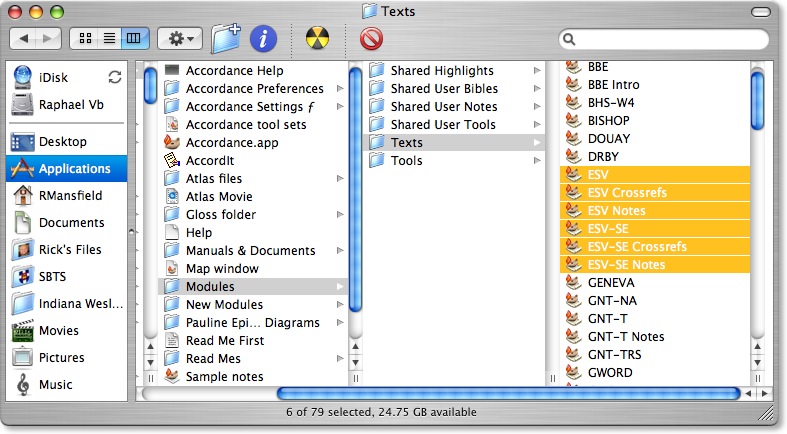
Anyone following this blog knows that I've been posting changes between the 2001 and 2007 editions of the ESV over the last few days. A few hours ago I finished with the Old Testament and over the next two or three days I will cover the New Testament and in doing so complete the entire Bible.
I've been able to compare the editions simply because OakTree Software released the Accordance etext of the 2007 edition as a separate module, listed simply as ESV-SE (SE standing for "second edition"). Previous purchasers of the ESV module could pay $10 to download the update. Over the weekend, in a surprising turn of events, the ESV-SE module has been withdrawn from the Accordance website, and now an update to the original 2001 module has been released that will update it to the 2007 edition. Those of us who paid for the update last week have been told we will receive a credit on our next order. According to the Accordance forum, the release of a separate module was "due to a misunderstanding."
Now I find all of this very interesting, and pardon me if the importance of This Lamp is exaggerated in my own mind, but I have to wonder if any of my posts from the last week created part of the problem. Let me back up a minute and offer a brief history of the events related to this extremely minor controversy.
Last year, when it first became evident that Crossway was planning to update the ESV, I and a number of others received word that the changes were minor (they are) and some kind of list would be made available as to what these changes between editions were.
Then, to the consternation of many, Crossway and/or the Standard Bible Society changed their minds on the issue and decided not to release a list of changes.
Last Fall, the first part of the new revision of the ESV was released in the form of the The English-Greek Reverse Interlinear New Testament, a join project between Crossway and Logos Bible Software. I bought a copy of the Reverse Interlinear and did my best to produce a list of changes that I could find. It was a very short list indeed, but it can still be read: "Truth Unchanged Not Changed that Much: A Preliminary Survey of Updates to the ESV New Testament." What amazed me at the time--given all the criticisms of the ESV as holding over too much baggage from the RSV and feeling like a project that was rushed to market--was that the revision wasn't more extensive considering there had been half a decade to improve the version.
Earlier this year, upon hearing that OakTree Software was working on the update to the ESV for Accordance, I requested through email correspondence that they keep the update as a separate module so that the two editions could be listed side-by-side using the wonderful comparison feature in Accordance.
On May 24, I received an email from OakTree stating, "We have come up with a solution which should work all around. The new ESV edition will be a $10 upgrade and will have a slightly different name. Installing it will not overwrite the older version, so you will be able to run both in parallel." This was a perfect solution. Granted the texts are publicly published, but finding the differences between them without the aid of a computer would certainly be a chore. So if Crossway didn't want to disclose the changes, at least we could hunt them down ourselves using Accordance.
Now one has to wonder why Crossway and the Standard Bible Society would be so secretive about the changes in the two editions. But the reality is that they were so secretive that they wouldn't even offer a list of changes to OakTree, but forced the Accordance engineers to prep a brand new etext for use in the software--something that was much more time consuming and expensive than it would have been simply to have a list of the changes and apply them to the earlier module.
A week ago, on June 17, OakTree released the ESV-SE module for an upgrade price of $10 or $30 for new users. I bought my copy of the update early last week and began running comparisons of the 2001 and 2007 editions and publishing the results here on my blog.
As I've been comparing the texts, I've come across errors in both the 2001 module and 2007 module and have been dutifully reporting these back to OakTree as I've found them. Yet tonight after sending in a few errors I found in the 2001 text (which you'll remember was kept as a separate module all of last week), I received an email instructing me with the following: "Since the new ESV is now what was the ERSV-SE, there is no point is sending corrections to the old ESV module. Please just send any you find on the ESV-SE or the version 2 of the ESV. See the notice on the Forum and News page."
I had no idea that there had been any kind of change. But sure enough, upon checking the Accordance website, the ESV-SE module has been removed, and now an update has been posted that will replace a user's original 2001 ESV module with the 2007 edition. The update is now free, in spite of a statement last week that a $10 charge had been placed on the ESV-SE module to cover the cost of prepping the three modules (text, notes, and cross references) for the ESV-SE.
A statement has been made on both the Accordance Blog and the Accordance Forums that:
Due to a misunderstanding, last week we released the updated ESV as a separate second edition, following the model we had used for the New Living Translation. We now understand that Crossway prefers that this update replace the original ESV rather than considering it a second edition. This means that the original and updated ESV can no longer be viewed in parallel and compared using the Text Compare feature.
Well, they can still be viewed in parallel on this user's MacBook, because I still have both modules. However, after I finish publishing the changes in the New Testament, I'll probably go ahead and update my modules. Otherwise I would never be able to get updates to the text as it's improved. However, if anyone really wants to keep both versions--assuming the ESV-SE module was purchased--the text from the 2001 edition could be exported to text and then re-imported creating a custom user Bible.
Of course, I really can't imagine why anyone would want to do this. Again, the changes are not that significant. Obviously, Crossway contacted OakTree asking them to remove the separate module. But why? Is it because the comparison is embarrassing to them? Is it because it supports my contention that the 2001 edition was rushed and changes from the RSV were not as extensive as they could have and should have been?
Yes, there are mistakes in the 2001 version, but these are forgivable--especially by diehard ESV aficionados. And I can't see how sales could be hurt by the comparisons. First of all, the ESV is going gangbusters in sales, incredibly hitting the #3 spot on the CBA list for June. And second, in my opinion, the only thing my comparisons can do for Crossway is to encourage ESV users to go out and get the new edition, thus increasing their sales even more.
So I don't know what the big deal is. There was a separate Accordance module that allowed for comparisons with the original. So what? In the end, by blog has the potential to reach more people with the changes than the software did. My blog is accessible to anyone who runs a search on Google for "ESV changes."
And I get a lot of these very hits, and have ever since my posts last year.
Related:
- 2007 ESV Changes: Genesis - Deuteronomy
- 2007 ESV Changes: Joshua - Esther
- 2007 ESV Changes: Job - Song of Solomon
- 2007 ESV Changes: Isaiah - Malachi
- 2007 ESV Changes: Matthew - Acts
- 2007 ESV Changes: Romans - Philemon
- 2007 ESV Changes: Hebrews - Revelation
- Truth Unchanged Not Changed That Much: A Preliminary Survey of Updates to the ESV New Testament
- Truth Unchanged Changed? Revised ESV Release Imminent: Solid Evidence
- Official Word from Crossway: No Complete ESV Revision until 2007
- Sign of the End Times: Singular They in the ESV
- More on 1 John 3:24 in the ESV: Change Is Coming
2007 ESV Changes: Isaiah - Malachi
2001 ESV |
2007 ESV |
|
| Isa 2:6 | For you have rejected your people, the house of Jacob, because they are full of things from the east and of fortunetellers like the Philistines, and they strike hands with the children of foreigners. |
For you have rejected your people, the house of Jacob, because they are full of things from the east and of fortune-tellers like the Philistines, and they strike hands with the children of foreigners. |
| Isa 5:26 | He will raise a signal for nations afar off, and whistle for them from the ends of the earth; and behold, quickly, speedily they come! |
He will raise a signal for nations far away, and whistle for them from the ends of the earth; and behold, quickly, speedily they come! |
| Isa 7:8 | For the head of Syria is Damascus, and the head of Damascus is Rezin. (Within sixty-five years Ephraim will be broken to pieces so that it will no longer be a people.) |
For the head of Syria is Damascus, and the head of Damascus is Rezin. And within sixty-five years Ephraim will be shattered from being a people. |
| Isa 8:1 | Then the LORD said to me, “Take a large tablet and write on it in common characters,‘Belonging to Maher-shalal-hashbaz.’ | Then the LORD said to me, “Take a large tablet and write on it in common characters,‘Belonging to Maher-shalal-hash-baz.’ |
| Isa 8:3 | And I went to the prophetess, and she conceived and bore a son. Then the LORD said to me, “Call his name Maher-shalal-hashbaz; | And I went to the prophetess, and she conceived and bore a son. Then the LORD said to me, “Call his name Maher-shalal-hash-baz; |
| Isa 8:6 | Because this people have refused the waters of Shiloah that flow gently, and rejoice over Rezin and the son of Remaliah, | Because this people has refused the waters of Shiloah that flow gently, and rejoice over Rezin and the son of Remaliah, |
| Isa 8:13 | But the LORD of hosts, him you shall regard as holy. Let him be your fear, and let him be your dread. | But the LORD of hosts, him you shall honor as holy. Let him be your fear, and let him be your dread. |
| Isa 10:30 | Cry aloud, O daughter of Gallim! Give attention, O Laishah! O Poor Anathoth! |
Cry aloud, O daughter of Gallim! Give attention, O Laishah! O poor Anathoth! |
| Isa 14:22 | “I will rise up against them,” declares the LORD of hosts, “and will cut off from Babylon name and remnant, descendants and posterity,” says the LORD. | “I will rise up against them,” declares the LORD of hosts, “and will cut off from Babylon name and remnant, descendants and posterity,” declares the LORD. |
| Isa 26:12 | O LORD, you will ordain peace for us; you have done for us all our works. |
O LORD, you will ordain peace for us, for you have indeed done for us all our works. |
| Isa 28:24 | Does he who plows for sowing plow continually? does he continually open and harrow his ground? |
Does he who plows for sowing plow continually? Does he continually open and harrow his ground? |
| Isa 31:4 | For thus the LORD said to me, “As a lion or a young lion growls over his prey, and when a band of shepherds is called out against him is not terrified by their shouting or daunted at their noise, so the LORD of hosts will come down to fight* on Mount Zion and on its hill. |
For thus the LORD said to me, “As a lion or a young lion growls over his prey, and when a band of shepherds is called out against him he is not terrified by their shouting or daunted at their noise, so the LORD of hosts will come down to fight on Mount Zion and on its hill. |
| Isa 37:16 | O LORD of hosts, God of Israel, who is enthroned above the cherubim, you are the God, you alone, of all the kingdoms of the earth; you have made heaven and earth. | O LORD of hosts, God of Israel, enthroned above the cherubim, you are the God, you alone, of all the kingdoms of the earth; you have made heaven and earth. |
| Isa 45:15 | Truly, you are a God who hides yourself, O God of Israel, the Savior. |
Truly, you are a God who hides himself, O God of Israel, the Savior. |
| Isa 48:14 | Assemble, all of you, and listen! who among them has declared these things? The LORD loves him; he shall perform his purpose on Babylon, and his arm shall be against the Chaldeans. |
Assemble, all of you, and listen! Who among them has declared these things? The LORD loves him; he shall perform his purpose on Babylon, and his arm shall be against the Chaldeans. |
| Isa 49:13 | Sing for joy, O heavens, and exult, O earth; break forth, O mountains, into singing! for the LORDhas comforted his people and will have compassion on his afflicted. |
Sing for joy, O heavens, and exult, O earth; break forth, O mountains, into singing! For the LORDhas comforted his people and will have compassion on his afflicted. |
| Isa 51:9 | Awake, awake, put on strength, O arm of the LORD; awake, as in days of old, the generations of long ago. Was it not you who cut Rahab in pieces, that pierced the dragon? |
Awake, awake, put on strength, O arm of the LORD; awake, as in days of old, the generations of long ago. Was it not you who cut Rahab in pieces, who pierced the dragon? |
| Isa 53:1 | Who has believed what they heard from us? And to whom has the arm of the LORD been revealed? |
Who has believed what he has heard from us? And to whom has the arm of the LORD been revealed? |
| Isa 53:10 | Yet it was the will of the LORD to crush him; he has put him to grief; when his soul makes an offering for sin, he shall see his offspring; he shall prolong his days; the will of the LORD shall prosper in his hand. |
Yet it was the will of the LORD to crush him; he has put him to grief; when his soul makes an offering for guilt, he shall see his offspring; he shall prolong his days; the will of the LORD shall prosper in his hand. |
| Isa 59:14 | Justice is turned back, and righteousness stands afar off; for truth has stumbled in the public squares, and uprightness cannot enter. |
Justice is turned back, and righteousness stands far away; for truth has stumbled in the public squares, and uprightness cannot enter. |
| Isa 66:19 | and I will set a sign among them. And from them I will send survivors to the nations, to Tarshish, Pul, and Lud, who draw the bow, to Tubal and Javan, to the coastlands afar off, that have not heard my fame or seen my glory. And they shall declare my glory among the nations. | and I will set a sign among them. And from them I will send survivors to the nations, to Tarshish, Pul, and Lud, who draw the bow, to Tubal and Javan, to the coastlands far away, that have not heard my fame or seen my glory. And they shall declare my glory among the nations. |
| Jer 2:20 | For long ago I broke your yoke and burst your bonds; but you said, ‘I will not serve.’ yes, on every high hill and under every green tree you bowed down like a whore. |
For long ago I broke your yoke and burst your bonds; but you said, ‘I will not serve.’ Yes, on every high hill and under every green tree you bowed down like a whore. |
| Jer 9:26 | Egypt, Judah, Edom, the sons of Ammon, Moab, and all who dwell in the desert who cut the corners of their hair, for all these nations are uncircumcised, and all the house of Israel is uncircumcised in heart.” | Egypt, Judah, Edom, the sons of Ammon, Moab, and all who dwell in the desert who cut the corners of their hair, for all these nations are uncircumcised, and all the house of Israel are uncircumcised in heart.” |
| Jer 11:11 | Therefore, thus says the LORD, behold, I am bringing disaster upon them that they cannot escape. Though they cry to me, I will not listen to them. | Therefore, thus says the LORD, Behold, I am bringing disaster upon them that they cannot escape. Though they cry to me, I will not listen to them. |
| Jer 18:11 | Now, therefore, say to the men of Judah and the inhabitants of Jerusalem: ‘Thus says the LORD, behold, I am shaping disaster against you and devising a plan against you. Return, every one from his evil way, and amend your ways and your deeds.’ | Now, therefore, say to the men of Judah and the inhabitants of Jerusalem: ‘Thus says the LORD, Behold, I am shaping disaster against you and devising a plan against you. Return, every one from his evil way, and amend your ways and your deeds.’ |
| Jer 22:2 | Hear the word of the LORD, O King of Judah, who sits on the throne of David, you, and your servants, and your people who enter these gates. | and say, ‘Hear the word of the LORD, O king of Judah, who sits on the throne of David, you, and your servants, and your people who enter these gates. |
| Jer 23:23 | Am I a God at hand, declares the LORD, and not a God afar off? | Am I a God at hand, declares the LORD, and not a God far away? |
| Jer 29:11 | For I know the plans I have for you, declares the LORD, plans for wholeness and not for evil, to give you a future and a hope. | For I know the plans I have for you, declares the LORD, plans for welfare and not for evil, to give you a future and a hope. |
| Jer 29:13 | You will seek me and find me. When you seek me with all your heart, | You will seek me and find me, when you seek me with all your heart. |
| Jer 31:19 | For after I had turned away, I relented, and after I was instructed, I slapped my thigh; I was ashamed, and I was confounded, because I bore the disgrace of my youth.’ |
For after I had turned away, I relented, and after I was instructed, I struck my thigh; I was ashamed, and I was confounded, because I bore the disgrace of my youth.’ |
| Jer 31:38 | Behold, the days are coming, declares the LORD, when the city shall be rebuilt for the LORDfrom the tower of Hananel to the Corner Gate. | Behold, the days are coming, declares the LORD, when the city shall be rebuilt for the LORDfrom the Tower of Hananel to the Corner Gate. |
| Jer 32:17 | Ah, Lord GOD! It is you who has made the heavens and the earth by your great power and by your outstretched arm! Nothing is too hard for you. | ‘Ah, Lord GOD! It is you who have made the heavens and the earth by your great power and by your outstretched arm! Nothing is too hard for you. |
| Jer 38:10 | Then the king commanded Ebed-melech the Ethiopian, “Take three men with you from here, and lift Jeremiah the prophet out of the cistern before he dies.” | Then the king commanded Ebed-melech the Ethiopian, “Take thirty men with you from here, and lift Jeremiah the prophet out of the cistern before he dies.” |
| Jer 44:30 | Thus says the LORD, behold, I will give Pharaoh Hophra king of Egypt into the hand of his enemies and into the hand of those who seek his life, as I gave Zedekiah king of Judah into the hand of Nebuchadnezzar king of Babylon, who was his enemy and sought his life.” | Thus says the LORD, Behold, I will give Pharaoh Hophra king of Egypt into the hand of his enemies and into the hand of those who seek his life, as I gave Zedekiah king of Judah into the hand of Nebuchadnezzar king of Babylon, who was his enemy and sought his life.” |
| Jer 46:14 | Declare in Egypt, and proclaim in Migdol; proclaim in Memphis and Tahpanhes; Say, ‘Stand ready and be prepared, for the sword shall devour around you.’ |
Declare in Egypt, and proclaim in Migdol; proclaim in Memphis and Tahpanhes; say, ‘Stand ready and be prepared, for the sword shall devour around you.’ |
| Jer 48:3 | Hark! A cry from Horonaim, ‘Desolation and great destruction!’ |
A voice! A cry from Horonaim, ‘Desolation and great destruction!’ |
| jer 49:3 | Wail, O Heshbon, for Ai is laid waste! Cry out, O daughters of Rabbah! put on sackcloth, lament, and run to and fro among the hedges! For Milcom shall go into exile, with his priests and his officials. |
Wail, O Heshbon, for Ai is laid waste! Cry out, O daughters of Rabbah! Put on sackcloth, lament, and run to and fro among the hedges! For Milcom shall go into exile, with his priests and his officials. |
| Jer 50:20 | In those days and in that time, declares the LORD, iniquity shall be sought in Israel, and there shall be none. And sin in Judah, and none shall be found, for I will pardon those whom I leave as a remnant. | In those days and in that time, declares the LORD, iniquity shall be sought in Israel, and there shall be none, and sin in Judah, and none shall be found, for I will pardon those whom I leave as a remnant. |
| Jer 52:31 | And in the thirty-seventh year of the exile of Jehoiachin king of Judah, in the twelfth month, on the twenty-fifth day of the month, Evil-merodach king of Babylon, in the year that he became king, lifted up the head of Jehoiachin king of Judah and brought him out of prison. | And in the thirty-seventh year of the exile of Jehoiachin king of Judah, in the twelfth month, on the twenty-fifth day of the month, Evil-merodach king of Babylon, in the year that he became king, graciously freed Jehoiachin king of Judah and brought him out of prison. |
| Ezek 3:7 | But the house of Israel will not be willing to listen to you, for they are not willing to listen to me. Because all the house of Israel have a hard forehead and a stubborn heart. | But the house of Israel will not be willing to listen to you, for they are not willing to listen to me: because all the house of Israel have a hard forehead and a stubborn heart. |
| Ezek 16:30 | How lovesick is your heart, declares the Lord GOD, because you did all these things, the deeds of a brazen prostitute, | How sick is your heart, declares the Lord GOD, because you did all these things, the deeds of a brazen prostitute, |
| Ezek 21:9 | Son of man, prophesy and say, Thus says the Lord; Say: “A sword, a sword is sharpened and also polished, |
Son of man, prophesy and say, Thus says the Lord, say: “A sword, a sword is sharpened and also polished, |
| Ezek 33:19 | And when the wicked turns from his wickedness and does what is just and right, he shall live by them. | And when the wicked turns from his wickedness and does what is just and right, he shall live by this. |
| Ezek 37:11 | Then he said to me, “Son of man, these bones are the whole house of Israel. Behold, they say, ‘Our bones are dried up, and our hope is lost; we are clean cut off.’ | Then he said to me, “Son of man, these bones are the whole house of Israel. Behold, they say, ‘Our bones are dried up, and our hope is lost; we are indeed cut off.’ |
| Ezek 44:19 | And when they go out into the outer court to the people, they shall put off the garments in which they have been ministering and lay them in the holy chambers. And they shall put on other garments, lest they communicate holiness to the people with their garments. | And when they go out into the outer court to the people, they shall put off the garments in which they have been ministering and lay them in the holy chambers. And they shall put on other garments, lest they transmit holiness to the people with their garments. |
| Ezek 46:20 | And he said to me, “This is the place where the priests shall boil the guilt offering and the sin offering, and where they shall bake the grain offering, in order not to bring them out into the outer court and so communicate holiness to the people.” | And he said to me, “This is the place where the priests shall boil the guilt offering and the sin offering, and where they shall bake the grain offering, in order not to bring them out into the outer court and so transmit holiness to the people.” |
| Ezek 48:35 | The circumference of the city shall be 18,000 cubits. And the name of the city from that time on shall be, The LORD is there. | The circumference of the city shall be 18,000 cubits. And the name of the city from that time on shall be, The LORD Is There. |
| Dan 2:26 | The king said to Daniel, whose name was Belteshazzar, “Are you able to make known to me the dream that I have seen and its interpretation?” | The king declared to Daniel, whose name was Belteshazzar, “Are you able to make known to me the dream that I have seen and its interpretation?” |
| Dan 7:9 | As I looked, thrones were placed, and the Ancient of days took his seat; his clothing was white as snow, and the hair of his head like pure wool; his throne was fiery flames; its wheels were burning fire. |
As I looked, thrones were placed, and the Ancient of Days took his seat; his clothing was white as snow, and the hair of his head like pure wool; his throne was fiery flames; its wheels were burning fire. |
| Dan 11:11 | Then the king of the south, moved with rage, shall come out and fight with the king of the north. And he shall raise a great multitude, but it shall be given into his hand. | Then the king of the south, moved with rage, shall come out and fight against the king of the north. And he shall raise a great multitude, but it shall be given into his hand. |
| Jon 2:4 | Then I said, ‘I am driven away from your sight; Yet I shall again look upon your holy temple.’ |
Then I said, ‘I am driven away from your sight; yet I shall again look upon your holy temple.’ |
| Mic 4:3 | He shall judge between many peoples, and shall decide for strong nations afar off; and they shall beat their swords into plowshares, and their spears into pruning hooks; nation shall not lift up sword against nation, neither shall they learn war anymore; |
He shall judge between many peoples, and shall decide for strong nations far away; and they shall beat their swords into plowshares, and their spears into pruning hooks; nation shall not lift up sword against nation, neither shall they learn war anymore; |
| Mic 5:2 | But you, O Bethlehem Ephrathah, who are too little to be among the clans of Judah, from you shall come forth for me one who is to be ruler in Israel, whose origin is from of old, from ancient days. |
But you, O Bethlehem Ephrathah, who are too little to be among the clans of Judah, from you shall come forth for me one who is to be ruler in Israel, whose coming forth is from of old, from ancient days. |
| Mic 7:19 | He will again have compassion on us; he will tread our iniquities under foot. You will cast all our sins into the depths of the sea. |
He will again have compassion on us; he will tread our iniquities underfoot. You will cast all our sins into the depths of the sea. |
| Hab 1:13 | You who are of purer eyes than to see evil and cannot look at wrong, why do you idly look at traitors and are silent when the wicked swallows up the man more righteous than he? |
You who are of purer eyes than to see evil and cannot look at wrong, why do you idly look at traitors and remain silent when the wicked swallows up the man more righteous than he? |
| Zech 9:9 | Rejoice greatly, O daughter of Zion! Shout aloud, O daughter of Jerusalem! behold, your king is coming to you; righteous and having salvation is he, humble and mounted on a donkey, on a colt, the foal of a donkey. |
Rejoice greatly, O daughter of Zion! Shout aloud, O daughter of Jerusalem! Behold, your king is coming to you; righteous and having salvation is he, humble and mounted on a donkey, on a colt, the foal of a donkey. |
| Zech 14:14 | Even Judah will fight against Jerusalem. And the wealth of all the surrounding nations shall be collected, gold, silver, and garments in great abundance. | Even Judah will fight at Jerusalem. And the wealth of all the surrounding nations shall be collected, gold, silver, and garments in great abundance. |
| Mal 2:16 | For the man who hates and divorces, says the LORD, the God of Israel, covers his garment with violence, says the LORD of hosts. So guard yourselves in your spirit, and do not be faithless.” | For the man who does not love his wife but divorces her, says the LORD, the God of Israel, covers his garment with violence, says the LORD of hosts. So guard yourselves in your spirit, and do not be faithless.” |
| Mal 3:10 | Bring the full tithes into the storehouse, that there may be food in my house. And thereby put me to the test, says the LORD of hosts, if I will not open the windows of heaven for you and pour down for you a blessing until there is no more need. | Bring the full tithe into the storehouse, that there may be food in my house. And thereby put me to the test, says the LORD of hosts, if I will not open the windows of heaven for you and pour down for you a blessing until there is no more need. |
See also:
• Genesis - Deuteronomy
• Joshua - Esther
• Job - Song of Solomon
• Matthew - Acts
• Romans - Philemon
• Hebrews - Revelation
2007 ESV Changes: Job - Song of Solomon
Iyov has been diligent to check my references and most of the errors in previous posts have come from hyphenated words. In performing a bit of translational textual criticism, my hunch is that the original ESV 2001 modules for both Accordance and Logos both came from scans of the ESV Classic Reference Bible because most of the mistakes found in the etexts have been at hyphenated breaks that occur in this specific edition. The Logos module of the 2001 edition is slightly more up to date than the Accordance module, but this isn't too surprising since Logos and Crossway seems to have a fairly close business relationship as evidenced in the ESV Reverse Interlinear NT. This makes it even more interesting that OakTree would release the 2007 update before Logos.
We've also discovered that evidently Crossway has made some of these changes along the way before the 2007 release, such as changing upwards to upward in 2 Chron 31:17 as demonstrated in the last post (see also the discussion in the comments). Early releases contained the words upwards, but there have been editions of the ESV before the 2007 edition that also contained the changed word, upward. I'm not certain how many other changes were also added between the editions. Nevertheless, I'm posting here any alteration from the 2001 edition that I find.
The changes made in the Wisdom Literature below are fewer than the number in the previous post of the Historical Books. Nevertheless, some of these are more interesting. Again, comments and discussion are welcome and encouraged.
2001 ESV |
2007 ESV |
|
| Job 39:29 | From there he spies out the prey; his eyes behold it afar off. |
From there he spies out the prey; his eyes behold it from far away. |
| Psalm 2:2 | The kings of the earth set themselves, and the rulers take counsel together, against the LORD and against his anointed, saying, |
The kings of the earth set themselves, and the rulers take counsel together, against the LORD and against his Anointed, saying, |
| Psalm 8:2 | Out of the mouth of babes and infants, you have established strength because of your foes, to still the enemy and the avenger. |
Out of the mouth of babies and infants, you have established strength because of your foes, to still the enemy and the avenger. |
| Psalm 10:1 | Why, O LORD, do you stand afar off? Why do you hide yourself in times of trouble? |
Why, O LORD, do you stand far away? Why do you hide yourself in times of trouble? |
| Psalm 11:4 | The LORD is in his holy temple; the LORD’s throne is in heaven; his eyes see, his eyelids test, the children of man. |
The LORD is in his holy temple; the LORD’s throne is in heaven; his eyes see, his eyelids test the children of man. |
| Psalm 19:4 | Their measuring line goes out through all the earth, and their words to the end of the world. In them he has set a tent for the sun, |
Their voice goes out through all the earth, and their words to the end of the world. In them he has set a tent for the sun, |
| Psalm 28:6 | Blessed be the LORD! for he has heard the voice of my pleas for mercy. |
Blessed be the LORD! For he has heard the voice of my pleas for mercy. |
| Psalm 35:21 | They open wide their mouths against me; they say, “Aha, Aha! our eyes have seen it!” |
They open wide their mouths against me; they say, “Aha, Aha! Our eyes have seen it!” |
| Psalm 40:6 | Sacrifice and offering you have not desired, but you have given me an open ear. Burnt offering and sin offering you have not required. |
In sacrifice and offering you have not delighted, but you have given me an open ear. Burnt offering and sin offering you have not required. |
| Psalm 40:8 | I desire to do your will, O my God; your law is within my heart.” |
I delight to do your will, O my God; your law is within my heart.” |
| Psalm 40:14 | Let those be put to shame and disappointed altogether who seek to snatch away my life; let those be turned back and brought to dishonor who desire my hurt! |
Let those be put to shame and disappointed altogether who seek to snatch away my life; let those be turned back and brought to dishonor who delight in my hurt! |
| Psalm 42:3 | My tears have been my food day and night, while they say to me continually, “Where is your God?” |
My tears have been my food day and night, while they say to me all the day long, “Where is your God?” |
| Psalm 42:10 | As with a deadly wound in my bones, my adversaries taunt me, while they say to me continually, “Where is your God?” |
As with a deadly wound in my bones, my adversaries taunt me, while they say to me all the day long, “Where is your God?” |
| Psalm 53:6 | Oh, that salvation for Israel would come out of Zion! When God restores the fortunes of his people, Let Jacob rejoice, let Israel be glad. |
Oh, that salvation for Israel would come out of Zion! When God restores the fortunes of his people, let Jacob rejoice, let Israel be glad. |
| Psalm 64:5 | They hold fast to their evil purpose; they talk of laying snares secretly, thinking, who can see them? |
They hold fast to their evil purpose; they talk of laying snares secretly, thinking, “Who can see them?” |
| Psalm 65:2 | O you who hears prayer, to you shall all flesh come. |
O you who hear prayer, to you shall all flesh come. |
| Psalm 70:2 | Let them be put to shame and confusion who seek my life! Let them be turned back and brought to dishonor who desire my hurt! |
Let them be put to shame and confusion who seek my life! Let them be turned back and brought to dishonor who delight in my hurt! |
| Psalm 80:19 | Restore us, O LORD God of hosts! let your face shine, that we may be saved! |
Restore us, O LORD God of hosts! Let your face shine, that we may be saved! |
| Psalm 86:14 | O God, insolent men have risen up against me; a band of ruthless men seek my life, and they do not set you before them. |
O God, insolent men have risen up against me; a band of ruthless men seeks my life, and they do not set you before them. |
| Psalm 106:7 | Our fathers, when they were in Egypt, did not consider your wondrous works; they did not remember the abundance of your steadfast love, but rebelled by the Sea, at the Red Sea. |
Our fathers, when they were in Egypt, did not consider your wondrous works; they did not remember the abundance of your steadfast love, but rebelled by the sea, at the Red Sea. |
| Psalm 107:8 | Let them thank the LORD for his steadfast love, for his wondrous works to the children of men! |
Let them thank the LORD for his steadfast love, for his wondrous works to the children of man! |
| Psalm 107:15 | Let them thank the LORD for his steadfast love, for his wondrous works to the children of men! |
Let them thank the LORD for his steadfast love, for his wondrous works to the children of man! |
| Psalm 107:21 | Let them thank the LORD for his steadfast love, for his wondrous works to the children of men! |
Let them thank the LORD for his steadfast love, for his wondrous works to the children of man! |
| Psalm 107:31 | Let them thank the LORD for his steadfast love, for his wondrous works to the children of men! |
Let them thank the LORD for his steadfast love, for his wondrous works to the children of man! |
| Psalm 109:31 | For he stands at the right hand of the needy, to save him from those who condemn his soul to death. |
For he stands at the right hand of the needy one, to save him from those who condemn his soul to death. |
| Psalm 139:16 | Your eyes saw my unformed substance; in your book were written, every one of them, the days that were formed for me, when as yet there were none of them. |
Your eyes saw my unformed substance; in your book were written, every one of them, the days that were formed for me, when as yet there was none of them. |
| Prov 6:33 | Wounds and dishonor will he get, and his disgrace will not be wiped away. |
He will get wounds and dishonor, and his disgrace will not be wiped away. |
| Prov 20:14 | “Bad, Bad,” says the buyer, but when he goes away, then he boasts. |
“Bad, bad,” says the buyer, but when he goes away, then he boasts. |
| Prov 24:22 | for disaster from them will rise suddenly, and who knows the ruin that will come from them both? |
for disaster will arise suddenly from them, and who knows the ruin that will come from them both? |
| Prov 30:15 | The leech has two daughters; “Give” and “Give,” they cry. Three things are never satisfied; four never say, “Enough”: |
The leech has two daughters: Give and Give. Three things are never satisfied; four never say, “Enough”: |
| Eccl 7:22 | Your heart knows that many times you have yourself cursed others. | Your heart knows that many times you yourself have cursed others. |
| Eccl 9:2 | It is the same for all, since the same event happens to the righteous and the wicked, to the good and the evil, to the clean and the unclean, to him who sacrifices and him who does not sacrifice. As is the good, so is the sinner, and he who swears is as he who shuns an oath. | It is the same for all, since the same event happens to the righteous and the wicked, to the good and the evil, to the clean and the unclean, to him who sacrifices and him who does not sacrifice. As the good one is, so is the sinner, and he who swears is as he who shuns an oath. |
| Eccl 9:7 | Go, eat your bread in joy, and drink your wine with a merry heart, for God has already approved what you do. | Go, eat your bread with joy, and drink your wine with a merry heart, for God has already approved what you do. |
| Eccl 10:20 | Even in your thought, do not curse the king, nor in your bedroom curse the rich, for a bird of the air will carry your voice, or some winged creature tell the matter. |
Even in your thoughts, do not curse the king, nor in your bedroom curse the rich, for a bird of the air will carry your voice, or some winged creature tell the matter. |
| Song 4:14 | nard and saffron, calamus and cinnamon, with all trees of frankincense, myrrh and aloes, with all chief spices— |
nard and saffron, calamus and cinnamon, with all trees of frankincense, myrrh and aloes, with all choice spices— |
See also:
• Genesis - Deuteronomy
• Joshua - Esther
• Isaiah - Malachi
• Matthew - Acts
• Romans - Philemon
• Hebrews - Revelation
2007 ESV Changes: Joshua - Esther
Below is the list of changes beginning in Joshua and going through Esther (although no changes actually occur in the latter book):
2001 ESV |
2007 ESV |
|
| Josh 10:14 | There has been no day like it before or since, when the LORD obeyed the voice of a man, for the LORD fought for Israel. | There has been no day like it before or since, when the LORD heeded the voice of a man, for the LORD fought for Israel. |
| Josh 11:5 | And all these kings joined their forces and came and encamped together at the waters of Merom to fight with Israel. | And all these kings joined their forces and came and encamped together at the waters of Merom to fight against Israel. |
| Judges 2:20 | So the anger of the LORD was kindled against Israel, and he said, “Because this people have transgressed my covenant that I commanded their fathers and have not obeyed my voice, | So the anger of the LORD was kindled against Israel, and he said, “Because this people has transgressed my covenant that I commanded their fathers and have not obeyed my voice, |
| Judges 6:17 | And he said to him, “If now I have found favor in your eyes, then show me a sign that it is you who speaks with me. | And he said to him, “If now I have found favor in your eyes, then show me a sign that it is you who speak with me. |
| Judges 6:21 | Then the angel of the LORD reached out the tip of the staff that was in his hand and touched the meat and the unleavened cakes. And fire sprang up from the rock and consumed the flesh and the unleavened cakes. And the angel of the LORD vanished from his sight. | Then the angel of the LORD reached out the tip of the staff that was in his hand and touched the meat and the unleavened cakes. And fire sprang up from the rock and consumed the meat and the unleavened cakes. And the angel of the LORD vanished from his sight. |
| Judges 6:24 | Then Gideon built an altar there to the LORD and called it, The LORD is Peace. To this day it still stands at Ophrah, which belongs to the Abiezrites. | Then Gideon built an altar there to the LORD and called it, The LORD Is Peace. To this day it still stands at Ophrah, which belongs to the Abiezrites. |
| Judges 8:1 | Then the men of Ephraim said to him, “What is this that you have done to us, not to call us when you went to fight with Midian?” And they accused him fiercely. | Then the men of Ephraim said to him, “What is this that you have done to us, not to call us when you went to fight against Midian?” And they accused him fiercely. |
| Judges 11:6 | And they said to Jephthah, “Come and be our leader, that we may fight with the Ammonites.” | And they said to Jephthah, “Come and be our leader, that we may fight against the Ammonites.” |
| Judges 11:8 | And the elders of Gilead said to Jephthah, “That is why we have turned to you now, that you may go with us and fight with the Ammonites and be our head over all the inhabitants of Gilead.” | And the elders of Gilead said to Jephthah, “That is why we have turned to you now, that you may go with us and fight against the Ammonites and be our head over all the inhabitants of Gilead.” |
| Judges 11:9 | Jephthah said to the elders of Gilead, “If you bring me home again to fight with the Ammonites, and the LORD gives them over to me, I will be your head.” | Jephthah said to the elders of Gilead, “If you bring me home again to fight against the Ammonites, and the LORD gives them over to me, I will be your head.” |
| 1 Sam 1:14 | And Eli said to her, “How long will you go on being drunk? Put away your wine from you.” | And Eli said to her, “How long will you go on being drunk? Put your wine away from you.” |
| 1 Sam 10:3 | Then you shall go on from there further and come to the oak of Tabor. Three men going up to God at Bethel will meet you there, one carrying three young goats, another carrying three loaves of bread, and another carrying a skin of wine. | Then you shall go on from there farther and come to the oak of Tabor. Three men going up to God at Bethel will meet you there, one carrying three young goats, another carrying three loaves of bread, and another carrying a skin of wine. |
| 1 Sam 11:3 | The elders of Jabesh said to him, “Give us seven days respite that we may send messengers through all the territory of Israel. Then, if there is no one to save us, we will give ourselves up to you.” | The elders of Jabesh said to him, “Give us seven days’ respite that we may send messengers through all the territory of Israel. Then, if there is no one to save us, we will give ourselves up to you.” |
| 1 Sam 13:18 | another company turned toward Beth-horon; and another company turned toward the border that looks down on the valley of Zeboim toward the wilderness. | another company turned toward Beth-horon; and another company turned toward the border that looks down on the Valley of Zeboim toward the wilderness. |
| 1 Sam 16:14 | Now the Spirit of the LORD departed from Saul, and an evil spirit from the LORD tormented him. | Now the Spirit of the LORD departed from Saul, and a harmful spirit from the LORD tormented him. |
| 1 Sam 16:15 | And Saul’s servants said to him, “Behold now, an evil spirit from God is tormenting you. | And Saul’s servants said to him, “Behold now, a harmful spirit from God is tormenting you. |
| 1 Sam 16:16 | Let our lord now command your servants who are before you to seek out a man who is skillful in playing the lyre, and when the evil spirit from God is upon you, he will play it, and you will be well.” | Let our lord now command your servants who are before you to seek out a man who is skillful in playing the lyre, and when the harmful spirit from God is upon you, he will play it, and you will be well.” |
| 1 Sam 16:23 | And whenever the evil spirit from God was upon Saul, David took the lyre and played it with his hand. So Saul was refreshed and was well, and the evil spirit departed from him. | And whenever the harmful spirit from God was upon Saul, David took the lyre and played it with his hand. So Saul was refreshed and was well, and the harmful spirit departed from him. |
| 1 Sam 17:19 | Now Saul and they and all the men of Israel were in the valley of Elah, fighting with the Philistines. | Now Saul and they and all the men of Israel were in the Valley of Elah, fighting with the Philistines. |
| 1 Sam 23:14 | And David remained in the strongholds in the wilderness, in the hill country of the Wilderness of Ziph. And Saul sought him every day, but God did not give him into his hand. |
And David remained in the strongholds in the wilderness, in the hill country of the wilderness of Ziph. And Saul sought him every day, but God did not give him into his hand. |
| 1 Sam 23:15 | David saw that Saul had come out to seek his life. David was in the Wilderness of Ziph at Horesh. | David saw that Saul had come out to seek his life. David was in the wilderness of Ziph at Horesh. |
| 1 Sam 27:11 | And David would leave neither man nor woman alive to bring news to Gath, thinking, “Lest they should tell about us and say, ‘So David has done.’ ” Such was his custom all the while he lived in the country of the Philistines. | And David would leave neither man nor woman alive to bring news to Gath, thinking, “lest they should tell about us and say, ‘So David has done.’” Such was his custom all the while he lived in the country of the Philistines. |
| 2 Sam 8:4 | And David took from him 1,700 horsemen, and 20,000 foot soldiers. And David hamstrung all the chariot horses but left enough for a hundred chariots. | And David took from him 1,700 horsemen, and 20,000 foot soldiers. And David hamstrung all the chariot horses but left enough for 100 chariots. |
| 2 Sam 18:9 | And Absalom happened to meet the servants of David. Absalom was riding on his mule, and the mule went under the thick branches of a great terebinth, and his head caught fast in the oak, and he was suspended between heaven and earth, while the mule that was under him went on. | And Absalom happened to meet the servants of David. Absalom was riding on his mule, and the mule went under the thick branches of a great oak,and his head caught fast in the oak, and he was suspended between heaven and earth, while the mule that was under him went on. |
| 2 Sam 24:23 | All this, O king, Araunah gives to the king.” And Araunah said to the king, “The LORD your God accept you.” | All this, O king, Araunah gives to the king.” And Araunah said to the king, “May the LORD your God accept you.” |
| 1 Kings 2:24 | Now therefore as the LORD lives, who has established me and placed me on the throne of David my father, and who has made me a house, as he promised, Adonijah shall be put to death this day.” | Now therefore as the LORD lives, who has established me and placed me on the throne of David my father, and who has made me a house, as he promised, Adonijah shall be put to death today.” |
| 2 Kings 5:5 | And the king of Syria said, “Go now, and I will send a letter to the king of Israel.” So he went, taking with him ten talents of silver, six thousand shekels of gold, and ten changes of clothes. | And the king of Syria said, “Go now, and I will send a letter to the king of Israel.” So he went, taking with him ten talents of silver, six thousand shekels of gold, and ten changes of clothing. |
| 2 Kings 5:22 | And he said, “All is well. My master has sent me to say, ‘There have just now come to me from the hill country of Ephraim two young men of the sons of the prophets. Please give them a talent of silver and two festal garments.’ ” |
And he said, “All is well. My master has sent me to say, ‘There have just now come to me from the hill country of Ephraim two young men of the sons of the prophets. Please give them a talent of silver and two changes of clothing.’” |
| 2 Kings 5:23 | And Naaman said, “Be pleased to accept two talents.” And he urged him and tied up two talents of silver in two bags, with two festal garments, and laid them on two of his servants. And they carried them before Gehazi. | And Naaman said, “Be pleased to accept two talents.” And he urged him and tied up two talents of silver in two bags, with two changes of clothing, and laid them on two of his servants. And they carried them before Gehazi. |
| 2 Kings 19:15 | And Hezekiah prayed before the LORD and said: “O LORD the God of Israel, who is enthroned above the cherubim, you are the God, you alone, of all the kingdoms of the earth; you have made heaven and earth. | And Hezekiah prayed before the LORD and said: “O LORD, the God of Israel, enthroned above the cherubim, you are the God, you alone, of all the kingdoms of the earth; you have made heaven and earth. |
| 2 Kings 21:6 | And he burned his son as an offering and used fortune-telling and omens and dealt with mediums and with wizards. He did much evil in the sight of the LORD, provoking him to anger. | And he burned his son as an offering and used fortune-telling and omens and dealt with mediums and with necromancers. He did much evil in the sight of the LORD, provoking him to anger. |
| 2 Kings 22:16 | Thus says the LORD, behold, I will bring disaster upon this place and upon its inhabitants, all the words of the book that the king of Judah has read. | Thus says the LORD, Behold, I will bring disaster upon this place and upon its inhabitants, all the words of the book that the king of Judah has read. |
| 1 Chron 4:31 | Beth-marcaboth, Hazar-su-sim, Beth-biri, and Shaaraim. These were their cities until David reigned. | Beth-marcaboth, Hazar-susim, Beth-biri, and Shaaraim. These were their cities until David reigned. |
| 1 Chron 7:9 | And their enrollment by genealogies, according to their generations, as heads of their fathers’ houses, mighty warriors, was 22,200. | And their enrollment by genealogies, according to their generations, as heads of their fathers’ houses, mighty warriors, was 20,200. |
| 1 Chron 19:19 | And when the servants of Hadadezer saw that they had been defeated by Israel, they made peace with David and became subject to him. So the Syrians were not willing to save the Ammonites any more. | And when the servants of Hadadezer saw that they had been defeated by Israel, they made peace with David and became subject to him. So the Syrians were not willing to save the Ammonites anymore. |
| 2 Chron 1:5 | Moreover, the bronze altar that Bezalel the son of Uri, son of Hur, had made, was there before the tabernacle of the LORD. And Solomon and the assembly resorted to it. | Moreover, the bronze altar that Bezalel the son of Uri, son of Hur, had made, was there before the tabernacle of the LORD. And Solomon and the assembly sought it out. |
| 2 Chron 9:18 | The throne had six steps and a footstool of gold, which were attached to the throne, and on each side of the seat were arm rests and two lions standing beside the arm rests, | The throne had six steps and a footstool of gold, which were attached to the throne, and on each side of the seat were armrests and two lions standing beside the armrests, |
| 2 Chron 21:2 | He had brothers, the sons of Jehoshaphat: Azariah, Jehiel, Zechariah, Azariah, Michael, and Shephatiah; all these were the sons of Jehoshaphat king of Judah. | He had brothers, the sons of Jehoshaphat: Azariah, Jehiel, Zechariah, Azariah, Michael, and Shephatiah; all these were the sons of Jehoshaphat king of Israel. |
| 2 Chron 21:19 | In course of time, at the end of two years, his bowels came out because of the disease, and he died in great agony. His people made no fire in his honor, like the fires made for his fathers. | In the course of time, at the end of two years, his bowels came out because of the disease, and he died in great agony. His people made no fire in his honor, like the fires made for his fathers. |
| 2 Chron 30:14 | They set to work and removed the altars that were in Jerusalem, and all the altars for burning incense they took away and threw into the Kidron valley. | They set to work and removed the altars that were in Jerusalem, and all the altars for burning incense they took away and threw into the Kidron Valley. |
| 2 Chron 31:17 | The enrollment of the priests was according to their fathers’ houses; that of the Levites from twenty years old and upwards was according to their offices, by their divisions. | The enrollment of the priests was according to their fathers’ houses; that of the Levites from twenty years old and upward was according to their offices, by their divisions. |
| 2 Chron 33:6 | And he burned his sons as an offering in the Valley of the Son of Hinnom, and used fortune-telling and omens and sorcery, and dealt with mediums and with wizards. He did much evil in the sight of the LORD, provoking him to anger. | And he burned his sons as an offering in the Valley of the Son of Hinnom, and used fortune-telling and omens and sorcery, and dealt with mediums and with necromancers. He did much evil in the sight of the LORD, provoking him to anger. |
| 2 Chron 34:24 | Thus says the LORD, behold, I will bring disaster upon this place and upon its inhabitants, all the curses that are written in the book that was read before the king of Judah. | Thus says the LORD, Behold, I will bring disaster upon this place and upon its inhabitants, all the curses that are written in the book that was read before the king of Judah. |
| 2 Chron 34:32 | Then he made all who were present in Jerusalem and in Benjamin stand to it. And the inhabitants of Jerusalem did according to the covenant of God, the God of their fathers. | Then he made all who were present in Jerusalem and in Benjamin join in it. And the inhabitants of Jerusalem did according to the covenant of God, the God of their fathers. |
| 2 Chron 36:9 | Jehoiachin was eight years old when he became king, and he reigned three months and ten days in Jerusalem. He did what was evil in the sight of the LORD. | Jehoiachin was eighteen years old when he became king, and he reigned three months and ten days in Jerusalem. He did what was evil in the sight of the LORD. |
| Ezra 6:21 | It was eaten by the people of Israel who had returned from exile, and also by everyone who had joined them and separated himself from the uncleanness of the peoples of the land to worship the LORD, the God of Israel. | It was eaten by the people of Israel who had returned from exile, and also by every one who had joined them and separated himself from the uncleanness of the peoples of the land to worship the LORD, the God of Israel. |
| Ezra 7:8 | And he came to Jerusalem in the fifth month, which was in the seventh year of the king. | And Ezra came to Jerusalem in the fifth month, which was in the seventh year of the king. |
| Neh 1:9 | but if you return to me and keep my commandments and do them, though your dispersed be under the farthest skies, I will gather them from there and bring them to the place that I have chosen, to make my name dwell there.’ | but if you return to me and keep my commandments and do them, though your outcasts are in the uttermost parts of heaven, from there I will gather them and bring them to the place that I have chosen, to make my name dwell there.’ |
| Neh 3:15 | And Shallum the son of Col-hozeh, ruler of the district of Mizpah, repaired the Fountain Gate. He rebuilt it and covered it and set its doors, its bolts, and its bars. And he built the wall of the Pool of Shelah of the king’s garden, as far as the stairs that go down from the City of David. | And Shallum the son of Col-hozeh, ruler of the district of Mizpah, repaired the Fountain Gate. He rebuilt it and covered it and set its doors, its bolts, and its bars. And he built the wall of the Pool of Shelah of the king’s garden, as far as the stairs that go down from the city of David. |
| Neh 9:29 | And you warned them in order to turn them back to your law. Yet they acted presumptuously and did not obey your commandments, but sinned against your rules, which if a person does them, he shall live by them, and turned a stubborn shoulder and stiffened their neck and would not obey. | And you warned them in order to turn them back to your law. Yet they acted presumptuously and did not obey your commandments, but sinned against your rules, which if a person does them, he shall live by them, and they turned a stubborn shoulder and stiffened their neck and would not obey. |
| Neh 9:35 | Even in their own kingdom, enjoying your great goodness that you gave them, and in the large and rich land that you set before them, they did not serve you or turn from their wicked works. | Even in their own kingdom, and amid your great goodness that you gave them, and in the large and rich land that you set before them, they did not serve you or turn from their wicked works. |
| Neh 11:30 | Zanoah, Adullam, and their villages, Lachish and its fields, and Azekah and its villages. So they encamped from Beersheba to the valley of Hinnom. | Zanoah, Adullam, and their villages, Lachish and its fields, and Azekah and its villages. So they encamped from Beersheba to the Valley of Hinnom. |
| Neh 13:24 | And half of their children spoke the language of Ashdod, and they could not speak the language of Judah, but the language of each people. | And half of their children spoke the language of Ashdod, and they could not speak the language of Judah, but only the language of each people. |
See also:
• Genesis - Deuteronomy.
• Job - Song of Solomon
• Isaiah - Malachi
• Matthew - Acts
• Romans - Philemon
• Hebrews - Revelation
2007 ESV Changes: Genesis - Deuteronomy
Earlier this week, OakTree Software released the updated edition of the ESV as a separate module from the original one. The changes between the editions are relatively minor, but I had petitioned OakTree earlier this year to keep the modules separate for sake of comparison. For whatever reason, Crossway and the Standard Bible Society opted not to release a list of the changes in spite of the fact that there was earlier indication that they would. Evidently, the changes were such a tightly kept secret that they wouldn't even give a list of changes to OakTree, but rather gave them a brand new etext that had to be prepped along with footnotes and cross-references. Undoubtedly, a simple list of corrections would have made the update a much easier task, but as Helen Brown noted in the comments over at the Accordance Blog:
If Crossway had supplied a list of corrections, our work would have been trivial, but we had to start over with a new etext and redo all three modules. In order to stay in business we do have to try to cover our costs.
Her last statement is in reference to the $10 upgrade fee (very reasonable in my opinion) charged to those who had the original ESV text in Accordance.
Now that I have both the 2001 and 2007 ESV editions available as separate modules in Accordance, I can use the comparison tool to find what should be an exhaustive list of changes between the editions. As I've already said, the changes are fairly minor in the big scheme of things. Unlike the significant change in the 1996 and 2004 editions of the NLT, the ESV update is really more of the standard "second run" with a few minor fixes that most translations experience (consider the 1978 and 1984 editions of the NIV, but compare John 1:18 in both).
Some of the changes are related to spelling or grammar, and a few reflect mild theological change (see Num 21:3 for instance). I am going to list the changes without commentary (other than to say Gen 30:35 is quite the chuckler), but I encourage discussion of the significance of any of these changes in the comments for this post. Over the next few days, I will display changes throughout the entire Bible between the two editions of the ESV.
For now, here is the Pentateuch:
2001 ESV |
2007 ESV |
|
| Gen 2:19 | So out of the ground the LORD God formed every beast of the field and every bird of the heavens and brought them to the man to see what he would call them. And whatever the man called every living creature, that was its name. | Now out of the ground the LORD God had formed every beast of the field and every bird of the heavens and brought them to the man to see what he would call them. And whatever the man called every living creature, that was its name. |
| Gen 24:60 | And they blessed Rebekah and said to her, “Our sister, may you become thousands of ten thousands, and may your offspring possess the gate of those who hate them!” |
And they blessed Rebekah and said to her, “Our sister, may you become thousands of ten thousands, and may your offspring possess the gate of those who hate him!” |
| Gen 25:20 | and Isaac was forty years old when he took Rebekah to be his wife, the daughter of Bethuel the Aramean of Paddan-aram, the sister of Laban the Aramean. | and Isaac was forty years old when he took Rebekah, the daughter of Bethuel the Aramean of Paddan-aram, the sister of Laban the Aramean, to be his wife. |
| Gen 26:17 | So Isaac departed from there and encamped in the valley of Gerar and settled there. | So Isaac departed from there and encamped in the Valley of Gerar and settled there. |
| Gen 30:35 | But that day Laban removed the male goats that were striped and spotted, and all the female goats that were speckled and spotted, every one that had white on it, and every lamb that was black, and put them in charge of his sons. | But that day Laban removed the male goats that were striped and spotted, and all the female goats that were speckled and spotted, every one that had white on it, and every lamb that was black, and put them in the charge of his sons. |
| Gen 37:22 | And Reuben said to them, “Shed no blood; cast him into this pit here in the wilderness, but do not lay a hand on him”—that he might rescue him out of their hand to restore him to his father. | And Reuben said to them, “Shed no blood; throw him into this pit here in the wilderness, but do not lay a hand on him”—that he might rescue him out of their hand to restore him to his father. |
| Gen 37:24 | And they took him and cast him into a pit. The pit was empty; there was no water in it. | And they took him and threw him into a pit. The pit was empty; there was no water in it. |
| Gen 38:12 | In course of time the wife of Judah, Shua’s daughter, died. When Judah was comforted, he went up to Timnah to his sheepshearers, he and his friend Hirah the Adullamite. | In the course of time the wife of Judah, Shua’s daughter, died. When Judah was comforted, he went up to Timnah to his sheepshearers, he and his friend Hirah the Adullamite. |
| Gen 44:18 | Then Judah went up to him and said, “O my lord, please let your servant speak a word in my lord’s ears, and let not your anger burn against your servant, for you are like Pharaoh himself. | Then Judah went up to him and said, “Oh, my lord, please let your servant speak a word in my lord’s ears, and let not your anger burn against your servant, for you are like Pharaoh himself. |
| Ex 17:15 | And Moses built an altar and called the name of it, The LORD is my banner, | And Moses built an altar and called the name of it, The LORD Is My Banner, |
| Ex 20:11 | For in six days the LORD made heaven and earth, the sea, and all that is in them, and rested the seventh day. Therefore the LORD blessed the Sabbath day and made it holy. | For in six days the LORD made heaven and earth, the sea, and all that is in them, and rested on the seventh day. Therefore the LORD blessed the Sabbath day and made it holy. |
| Ex 22:16 | If a man seduces a virgin who is not engaged to be married and lies with her, he shall give the bride-price for her and make her his wife. | If a man seduces a virgin who is not betrothed and lies with her, he shall give the bride-price for her and make her his wife. |
| Ex 29:27 | And you shall consecrate the breast of the wave offering that is waved and the thigh of the priests’ portion that is contributed from the ram of ordination, from what was Aaron’s and his sons. | And you shall consecrate the breast of the wave offering that is waved and the thigh of the priests’ portion that is contributed from the ram of ordination, from what was Aaron’s and his sons’. |
| Ex 32:31 | So Moses returned to the LORD and said, “Alas, this people have sinned a great sin. They have made for themselves gods of gold. | So Moses returned to the LORD and said, “Alas, this people has sinned a great sin. They have made for themselves gods of gold. |
| Lev 19:31 | Do not turn to mediums or wizards; do not seek them out, and so make yourselves unclean by them: I am the LORD your God. | Do not turn to mediums or necromancers; do not seek them out, and so make yourselves unclean by them: I am the LORD your God. |
| Lev 20:6 | If a person turns to mediums and wizards, whoring after them, I will set my face against that person and will cut him off from among his people. | If a person turns to mediums and necromancers, whoring after them, I will set my face against that person and will cut him off from among his people. |
| Lev 20:24 | But I have said to you, ‘You shall inherit their land, and I will give it to you to possess, a land flowing with milk and honey.’ I am the LORD your God, who have separated you from the peoples. | But I have said to you, ‘You shall inherit their land, and I will give it to you to possess, a land flowing with milk and honey.’ I am the LORD your God, who has separated you from the peoples. |
| Lev 20:27 | A man or a woman who is a medium or a wizard shall surely be put to death. They shall be stoned with stones; their blood shall be upon them. | A man or a woman who is a medium or a necromancer shall surely be put to death. They shall be stoned with stones; their blood shall be upon them. |
| Lev 23:6 | And on the fifteenth day of the same month is the Feast of Unleavened bread to the LORD; for seven days you shall eat unleavened bread. | And on the fifteenth day of the same month is the Feast of Unleavened Bread to the LORD; for seven days you shall eat unleavened bread. |
| Lev 26:46 | These are the statutes and rules and laws that the LORD made between him and the people of Israel through Moses on Mount Sinai. | These are the statutes and rules and laws that the LORD made between himself and the people of Israel through Moses on Mount Sinai. |
| Num 4:7 | And over the table of the bread of the Presence they shall spread a cloth of blue and put on it the plates, the dishes for incense, the bowls, and the flagons for the drink offering; the regular show bread also shall be on it. | And over the table of the bread of the Presence they shall spread a cloth of blue and put on it the plates, the dishes for incense, the bowls, and the flagons for the drink offering; the regular showbread also shall be on it. |
| Num 21:3 | And the LORD obeyed the voice of Israel and gave over the Canaanites, and they devoted them and their cities to destruction. So the name of the place was called Hormah. | And the LORD heeded the voice of Israel and gave over the Canaanites, and they devoted them and their cities to destruction. So the name of the place was called Hormah. |
| Num 21:14 | Wherefore it is said in the Book of the Wars of the LORD, “Waheb in Suphah, and the valleys of the Arnon, | Therefore it is said in the Book of the Wars of the LORD, “Waheb in Suphah, and the valleys of the Arnon, |
| Num 21:18 | the well that the princes dug, that the nobles of the people delved, with the scepter and with their staffs.” And from the wilderness they went on to Mattanah, |
the well that the princes made, that the nobles of the people dug, with the scepter and with their staffs.” ¶ And from the wilderness they went on to Mattanah, |
| Deut 9:26 | And I prayed to the LORD, ‘O Lord GOD, destroy not your people and your heritage, whom you have redeemed through your greatness, whom you have brought out of Egypt with a mighty hand. | And I prayed to the LORD, ‘O Lord GOD, do not destroy your people and your heritage, whom you have redeemed through your greatness, whom you have brought out of Egypt with a mighty hand. |
| Deut 18:11 | or a charmer or a medium or a wizard or a necromancer, | or a charmer or a medium or a necromancer or one who inquires of the dead, |
See also:
• Joshua - Esther
• Job - Song of Solomon
• Isaiah - Malachi
• Matthew - Acts
• Romans - Philemon
• Hebrews - Revelation
Newest Acquisition: the Twentieth Century New Testament
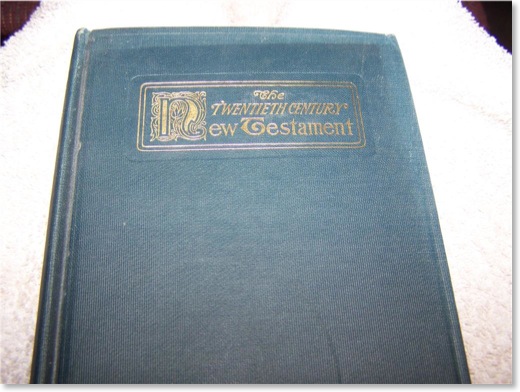
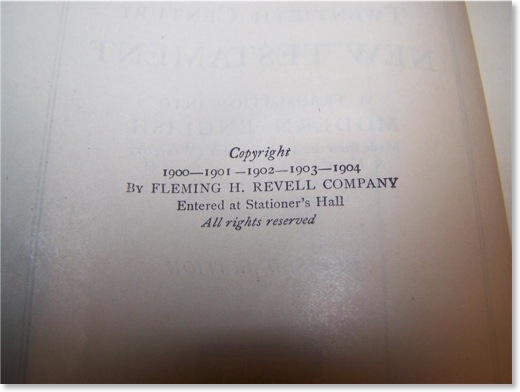
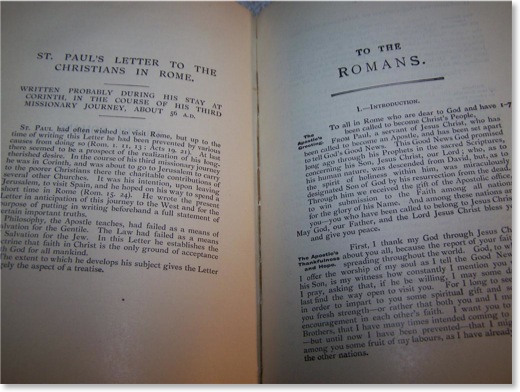
I haven't had a whole lot of time to spend with it yet, but I note that the gospels begin with Mark under the conviction that this was the first gospel written. Also Paul's letters begin with 1 Thessalonians since most believe this was the first letter written by Paul. Also it's worth noting that James is included before Paul's letters.
The Twentieth Century New Testament (TCNT) shows a concern almost a century old that the KJV used outdated and archaic language with the risk that modern readers exposed only to the 1611 translation might consider the Bible to be irrelevant, merely an ancient document of history. It's also worth noting that the TCNT is one of the first translations based on the Westcott and Hort text.
I ran a search for the title through the theological journals I have in Accordance and I found a review in Bibliotheca Sacra from 1963. The review itself, written by S. D. Toussaint, was in reference to a recent Moody Press reprint of the TCNT. Below is an edited version of the review with pertinent information retained:
This is not a mid-twentieth century translation but a pre-twentieth century work based on the text of Westcott and Hort. It [was] first published in 1900 and made by twenty unnamed men and women from “various sections of the Christian Church.”
The 1900 publication has the books arranged in a chronological order. Significantly, Mark is given as the earliest gospel; strangely, Titus is placed after 2 Timothy. [The TNTC provides] an introduction to each book containing data concerning authorship, date, sources, etc. Some of these occasionally reveal a liberal view. (In the introduction to Revelation it is stated concerning its authorship, “There is at present no certain clue to his identity").
...The preface of the original translation...does not claim this is a verbal translation but it also denies being a paraphrase. It asserts: “…The effort has been made to give the exact force and meaning in idiomatic modern English.” Despite this fact, it definitely tends toward a paraphrase. Aside from this shortcoming, the translation does have a number of advantages. The books are divided into sections and paragraphs; outlines are incorporated into the books; quotations are indicated by finer print; and measures, values, and titles are given in the nearest English equivalents.
This translation may prove to be useful to the Bible student who would like to add another translation to his already extended shelf of “twentieth century” renditions.
Bible Note-Taking: My Method
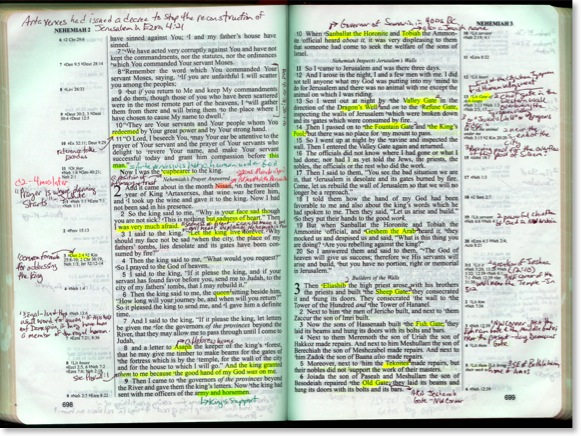
I actually developed it while I was in college, and although I've tweaked it along the way here and there, it's not overly changed from the way it was years ago. I have to admit that the actual structure is based on the colors available in a pack of Stabilo Boss Dry Highlighters. The pack came in five colors. I never figured out what to do with the orange, so I used it elsewhere. However, here is how I arranged my categories:
YELLOW = General and miscellaneous notes that do not fall into other categories.
RED = Dates, chronology, date of composition
GREEN = symbolism, metaphor, literary features
BLUE = Messianic, Christological
With each of the dry highlighters, I use a corresponding pen for my annotations with the exception of the first category for which I use a black pen. In other words, I highlight in yellow, but the corresponding note is in black, unlike the other colors for which I have matching highlighter and pens.
The main Bible I take notes in is a NASB wide-margin single column reference Bible from Foundation Publications. I would be willing to use a more contemporary version such as the TNIV or NLT, but no adequate wide margin Bible is available in these translations. I make these annotations whenever I study a passage (using commentaries and other reference works) for personal edification or teaching others. I make different kinds of notes in a Greek NT, usually grammatical issues relating to the Greek text or a gloss of a rarely used word that is not in my memorized vocabulary.
Here are some random examples of the kind of annotations I've got marked in my NASB wide-margin Bible:
GENERAL AND MISCELLANEOUS NOTES
- In Gen 45:4, I have the word alive highlighted in yellow. In the margin I have the words "meaning 'enjoying health and well-being.'" I have no idea where I got this information--probably from a commentary. I will list a source for extended notes, but not short comments like these.
- Sometimes I merely write annotations without highlighting anything specific. For instance, In the top margin above 2 Sam 13, I have "reminder" bullets: • Absalom and Tamar were David's children by Maacah, daughter of the king of Gesure; and • Amnon Was David's son by Ahinoam, the Jezruelitess.
- At Neh 4:3, I have highlighted in yellow the words "break their stone wall down." In the margin are the words, "Actually archaeological discoveries have revealed Nehemiah's wall to be four feet thick--NAC." In this case, I did note the source: the New American Commentary. I could have just as easily noted the author instead of the series, but more than likely, the series would make a more familiar reference in this case.
- At Neh 3:13, Zanoah is highlighted in yellow with the accompanying note, "13 mi. sw of Jerusalem."
- Sometimes the notes will reflect alternate translations. In Neh 5:7, I highlighted the words "I consulted with myself" and in the margin have the note "lit. 'my heart took counsel upon me.'"
- Certain books like Job are heavily annotated. In this case, I was doing personal study through Job at one point, and then I've taught the book a few times.
- In many places throughout the Bible, I'll highlight a word in yellow, and in the margin or very close to it, write the actual underlying original language word.
DATES AND CHRONOLOGICAL ISSUES
- In Jer 1:2, I highlighted in red the phrase, "the thirteenth year of his reign." The corresponding note (written in red ink) says 627 BC.
- I highlighted in red the Hebrew month "Nisan" with the corresponding note "spans March-April; 1st month of the Persian year." Similarly at Neh 9:1, I highlighted the phrase "the twenty-fourth day of this month" with the annotation "Oct 30, 445 BC."
- I have a note in red at Acts 6 that these events occur five years after Pentecost.
- At the beginning of books, I often try to list suggested dates of composition. For instance in Matthew, I have a number of suggestions including on the more conservative side: "60's <70" from Carson, Moo, & Morris' NT Intro and "After 70" from Kümmel's more progressive NT Intro. Because these types of annotations come at the beginning of the book, I sometimes write other introductory notes in red as well such as suggested authors, but I don't do this consistently, it seems.
- I occasionally use red for brief outlines and structural notes.
SYMBOLISM/METAPHOR/LITERARY
- I highlighted "with fasting, in sackcloth and with dirt upon them" in green and my corresponding note written in green says "mourning and humility." This kind of note seems unnecessary after a while. I simply "know" that kind of information. Do I really need to make a note of it? And yet, I tend to add that kind of notation anyway for teaching purposes as it reminds me to mention it in an instructural setting.
- In Job 1:2 I have highlighted "Seven sons and three daughters" with the annotation "The symbolism of the numbers imply that Job had an ideal family." This kind of note gets a lot of play in a book like Revelation, where I have quite a bit of green.
- In Psalm 74:19, turtledove is highlighted with the simple annotation "Israel."
- A passage like Eccl 12:3-6 is loaded with symbols. "watchmen of the house" = arms, "mighty men" = legs, "grinding ones" = teeth, etc. I have all of these highlighted in green with accompanying annotations written in green.
- I use green for the many euphemisms in a book like Song of Solomon.
MESSIANIC/CHRISTOLOGICAL
- This turns out to be my least used color, perhaps because it could be overdone, especially in the gospels and become meaningless. Often annotations that could receive blue treatment simply get highlighted in yellow.
- Since the NASB wide margin that I use has a cross reference system, I often will highlight in blue the cross references between the testaments referred to in messianic prophecies. Surprisingly, often I find that the references aren't included both ways and I will have to write one of them in using a blue pen.
- In Rev 5:5, I have Lion highlighted in blue with an annotation written in blue that says "conquering warrior messiah." Then in v. 6, I have the accompanying Lamb highlighted in blue with the note "sacrificial death; links the Messiah to the passover lamb." I also have a note written in blue with v. 6, but not directly related to anything specifically highlighted, that says "Here John joins the OT Davidic Messiah and the Suffering Servant of Isaiah (Isa 52-53)." I really should have listed my source for that because I doubt it was my own original conclusion. It may have come from John Newport's book, The Lion and the Lamb.
Obviously, there are thousands of other examples, but the above are a sampling which I believe gives the flavor for what I am doing.
The actual Stabilo Boss Dry Highlighters are no longer made, but are still available on eBay. I have stocked up on enough to last for a very long time. The dry highlighters I usually see in stores these days are the Staedtler dry highlighters. To me these are a perfectly suitable replacement, except for the yellow pencil which makes me continue to seek out the older highlighters.
For years, I used ballpoint pens for my corresponding notes, with green ballpoints always the most difficult to come by. Noticing that some of my oldest notes were starting to bleed through, and I began to look for something else. A number of readers for this blog suggested the Pigma Micron pens. These are what I use exclusively in my Bibles now, and having experimented with different nib sizes, settled on a 01 point for writing in my Bibles. I like these pens so much, I use the larger nibs for grading papers and writing in my Moleskine journal.
I also discovered that Pigma Micron has a brown pen. I like the color brown for a pen, having used brown ink the last couple of years in the Mont Blanc I carry with me everyday. I incorporated brown into my Bible notetaking recently (the first new color added since the originals) by using it as the color for notable quotations that I sometimes find room for in the top or bottom margins of the page.
When I was teaching out of the NASB in which I take notes, I could truly say this was my primary Bible. At one time, I was studying with this Bible, teaching from it, and occasionally preaching from it. I really feel there's great value in using the same Bible for both preparation and delivery. Because I have chosen to teach from a more contemporary version, I have to leave my NASB at home and rely on typed notes and any annotations I may have had room to write in the limited space of the Bible I've been using. Of course, I always taught from pages of notes as well anyway, but in conjunction with the annotations in my Bible. Obviously, not everything could fit into a Bible's margins. But not having the same Bible for both phases definitely has its drawbacks.
And every Sunday morning as I pack up my bag of books to take to church, I am often tempted to chuck the contemporary versions and go back to my trusty NASB instead. Again, I've been willing for two years to make a complete jump to newer translations. The publishers just don't seem to want to comply.
GUEST REVIEW: The New Life Version
Review of the New Life Version of the Bible
by Claudio Duckardt

As I said, I was raised on the KJV, but rarely read more than a few verses in one sitting since I could not understand many of the passages. For years, I neglected much of the Bible, especially the Old Testament. I will never forget how excited and happy I was when I discovered modern versions. These Bibles made God’s word understandable, warm, alive, and personal. I finally learned what the Bible was all about. Sure, the KJV-only camp criticized me, but I didn’t care. I am in complete agreement that language is fluid, and God’s word must reflect these updates or His message will become obscured.
One thing that has always bothered me, however, is the textual issue. As you know, the KJV is based on the received (or traditional) text while most modern translations are based on the critical one. As a result, many verses found in the KJV are not found in the body of most modern translations. Don’t get me wrong…. all mainstream Bible translations are God’s word. I am not suggesting that one stream of manuscripts is better or worse than the other. Yet, I have often thought that there should be a dynamic equivalent translation follows the received text. We as Christians owe it to ourselves to have Bibles from both streams. After all, the superiority of one text over the other is based on theory. Sure, the NKJV was translated from the traditional text, but can also be a difficult read. I have often thought it would be nice to have a dynamic equivalence Bible based on the traditional stream of texts.
Well, there is and has been an easy-to-read Bible that is very similar in spirit to the traditional family of English Bibles, the New Life Version. This version uses a base of only 850 vocabulary words (not including names of people and places) in its text. It is not a direct translation from the Hebrew and Greek. Instead, it was “translated” from a more literal Bible into simple English, with most received text readings in place. The reader my be thinking “Ah ha! Paraphrase!” but it is actually pretty accurate. While the preface and official website (www.newlifebible.org) does not say which version was used, this Bible seems to use the KJV as its basis. The NLV is not well known, but has been available in its complete form since 1986.
At first glance, this version may seem like just another paraphrase. It is much more than that. First, a little history about the NLV. Between 1946-1961, a Canadian missionary couple, Gleason and Kathryn Ledyard, had the privilege of spreading the Gospel to Eskimos that lived in the Canadian artic. They actually lived in igloos with the Eskimos! Mr. Ledyard had a strong desire for the natives to read a Bible in simple English. The versions available at that time were not approachable by new English speakers. Together with his wife, he decided to simplify the text to make the Bible more accessible to their Eskimo friends. However, the couple had a few rules. First of all, no changes would be made to the text in order to avoid making the version a paraphrase. Second, no footnotes would be included. All of the verses (again, as in the KJV) would be included in the text, but asterisks and parenthesis would be used to indicate readings not in some of the ancient witnesses (even though critical text readings are used in some instances). Thirdly, other than proper names of people and places, only 850 Basic English words would be used. Their version of the New Testament was completed in 1969. The Old Testament followed a few years later. Their completed Bible was completed in 1986.
Some Bible terms were simplified to make it more understandable. “Noah’s ark” becomes “Noah’s boat”; “Gentiles” become “people who do not know God or are not Jews”; “glory” becomes “shining-greatness”; “idolatry” becomes “worshiping false gods.” While some of these terms seem childlike, it must be remembered that originally this Bible was designed for beginning English speakers.
STRENGTHS OF THE NLV
The main strength of this version its use of simple sentences and vocabulary. This makes the NLV great for people who have never read the Bible or speak English as a second language. Difficult terms are simplified (much like the NLT). Let me compare a few verses between the KJV and NLV.
GENESIS 3:1-5 |
|
KJV |
NLV |
| 1 Now the serpent was more subtil than any beast of the field which the LORD God had made. And he said unto the woman, Yea, hath God said, Ye shall not eat of every tree of the garden? 2 And the woman said unto the serpent, We may eat of the fruit of the trees of the garden: 3 But of the fruit of the tree which is in the midst of the garden, God hath said, Ye shall not eat of it, neither shall ye touch it, lest ye die. 4 And the serpent said unto the woman, Ye shall not surely die: 5 For God doth know that in the day ye eat thereof, then your eyes shall be opened, and ye shall be as gods, knowing good and evil. | 1 Now the snake was more able to fool others than any animal of the field which the Lord God had made. He said to the woman, "Did God say that you should not eat from any tree in the garden?" 2 Then the woman said to the snake, "We may eat the fruit of the trees of the gar-den. 3 But from the tree which is in the center of the garden, God has said, 'Do not eat from it or touch it, or you will die.' " |
EXODUS 3:11-14 |
|
KJV |
NLV |
| 11 And Moses said unto God, Who am I, that I should go unto Pharaoh, and that I should bring forth the children of Israel out of Egypt? 12 And he said, Certainly I will be with thee; and this shall be a token unto thee, that I have sent thee: When thou hast brought forth the people out of Egypt, ye shall serve God upon this mountain. 13 And Moses said unto God, Behold, when I come unto the children of Israel, and shall say unto them, The God of your fathers hath sent me unto you; and they shall say to me, What is his name? what shall I say unto them? 14 And God said unto Moses, I AM THAT I AM: and he said, Thus shalt thou say unto the children of Israel, I AM hath sent me unto you. | 11 But Moses said to God, "Who am I to go to Pharaoh and bring the people of Israel out of Egypt?" 12 God said, "But I will be with you. And this will be something special for you to see to know that I have sent you: When you have brought the people out of Egypt, you will worship God at this mountain." 13 Then Moses said to God, "See, I am going to the people of Israel, and I will say to them, 'The God of your fathers has sent me to you.' Now they might say to me, 'What is His name?' What should I say to them?" 14 And God said to Moses, "I AM WHO I AM." And He said, "Say to the Israelites, 'I AM has sent me to you.' " |
PSALM 23 |
|
KJV |
NLV |
| 1 The LORD is my shepherd; I shall not want. 2 He maketh me to lie down in green pastures: he leadeth me beside the still waters. 3 He restoreth my soul: he leadeth me in the paths of righteousness for his name’s sake. 4 Yea, though I walk through the valley of the shadow of death, I will fear no evil: for thou art with me; thy rod and thy staff they comfort me. 5 Thou preparest a table before me in the presence of mine enemies: thou anointest my head with oil; my cup runneth over. 6 Surely goodness and mercy shall follow me all the days of my life: and I will dwell in the house of the LORD for ever. |
1 The Lord is my Shepherd. I will have everything I need. 2 He lets me rest in fields of green grass. He leads me beside the quiet waters. 3 He makes me strong again. He leads me in the way of living right with Himself which brings honor to His name. 4 Yes, even if I walk through the valley of the shadow of death, I will not be afraid of anything, because You are with me. You have a walking stick with which to guide and one with which to help. These comfort me. 5 You are making a table of food ready for me in front of those who hate me. You have poured oil on my head. I have everything I need. 6 For sure, You will give me goodness and loving-kindness all the days of my life. Then I will live with You in Your house forever. |
Job 36:26-31 |
|
KJV |
NLV |
| 26 Behold, God is great, and we know him not, neither can the number of his years be searched out. 27 For he maketh small the drops of water: they pour down rain according to the vapour thereof: 28 Which the clouds do drop and distil upon man abundantly. 29 Also can any understand the spreadings of the clouds, or the noise of his tabernacle? 30 Behold, he spreadeth his light upon it, and covereth the bottom of the sea. 31 For by them judgeth he the people; he giveth meat in abundance. | 26 See, God is honored, and we do not know Him. We are not able to know the number of His years. 27 For He takes up the drops of water that become rain, 28 which the clouds pour down. Much rain falls on man. 29 Can anyone understand how the clouds are spread out, or how He thunders from His tent? 30 See, He spreads His lightning around Him and covers the bottom of the sea. 31 For by these He judges the people and He gives much food. |
The NLV’s New Testament keeps intact most of the readings found in the KJV.
For example, compare the Lord’s Prayer between both versions:
MATTHEW 6:9-13 |
|
KJV |
NLV |
| 9 After this manner therefore pray ye: Our Father which art in heaven, Hallowed be thy name. 10 Thy kingdom come. Thy will be done in earth, as it is in heaven. 11 Give us this day our daily bread. 12 And forgive us our debts, as we forgive our debtors. 13 And lead us not into temptation, but deliver us from evil: For thine is the kingdom, and the power, and the glory, for ever. Amen. |
9 "Pray like this: 'Our Father in heaven, Your name is holy. 10 May Your holy nation come. What You want done, may it be done on earth as it is in heaven. 11 Give us the bread we need today. 12 Forgive us our sins as we forgive those who sin against us. 13 'Do not let us be tempted, but keep us from sin. *Your nation is holy. You have power and shining-greatness forever. Let it be so.' |
The following are other examples of the NLV following the KJV’s lead:
MARK 7:15-16 |
|
KJV |
NLV |
| 15 There is nothing from without a man, that entering into him can defile him: but the things which come out of him, those are they that defile the man. 16 If any man have ears to hear, let him hear. |
15 It is not what goes into a man's mouth from the outside that makes his mind and heart sinful. It is what comes out from the inside that makes him sinful. 16 You have ears, then listen!" |
LUKE 9:55-56 |
|
KJV |
NLV |
| 55But he turned, and rebuked them, and said, Ye know not what manner of spirit ye are of. 56For the Son of man is not come to destroy men's lives, but to save them. And they went to another village. |
55 Jesus turned and spoke sharp words to them. (*He said, "You do not know what kind of spirit you have. 56 The Son of Man did not come to destroy men's lives. He came to save them from the punishment of sin." They went on their way to another town.) |
JOHN 5:2-4 |
|
KJV |
NLV |
| 2Now there is at Jerusalem by the sheep market a pool, which is called in the Hebrew tongue Bethesda, having five porches. 3In these lay a great multitude of impotent folk, of blind, halt, withered, waiting for the moving of the water. 4For an angel went down at a certain season into the pool, and troubled the water: whosoever then first after the troubling of the water stepped in was made whole of whatsoever disease he had. |
2 In Jerusalem there is a pool with five porches called Bethesda near the sheep gate. 3 Inside these porches lay many sick people. Some were blind. Some could not walk. Some could not move their bodies. 4 (*An angel of the Lord came at certain times and made the water move. All of them were waiting for it to move. Whoever got in the water first after it was moving was healed of whatever sickness he had.) |
ACTS 8:36-37 |
|
KJV |
NLV |
| 36And as they went on their way, they came unto a certain water: and the eunuch said, See, here is water; what doth hinder me to be baptized? 37And Philip said, If thou believest with all thine heart, thou mayest. And he answered and said, I believe that Jesus Christ is the Son of God. | 36 As they went on their way, they came to some water. The man from Ethiopia said, "See! Here is water. What is to stop me from being baptized?" 37 (*Philip said, "If you believe with all your heart, you may." The man said, "I believe that Jesus Christ is the Son of God." |
1 JOHN 5:6-7 |
|
KJV |
NLV |
| 6This is he that came by water and blood, even Jesus Christ; not by water only, but by water and blood. And it is the Spirit that beareth witness, because the Spirit is truth. 7For there are three that bear record in heaven, the Father, the Word, and the Holy Ghost: and these three are one. |
6 Jesus Christ came by water and blood. He did not come by water only, but by water and blood. The Holy Spirit speaks about this and He is truth. 7 There are three Who speak of this in heaven: the Father and the Word and the Holy Spirit. These three are one. |
By now, the reader can see that the NLV does indeed follow the KJV. As I had mentioned earlier, most verses that do not agree with the critical text are either in parenthesis or are marked with an asterisk, but not consistently.
DISADVANTAGES OF THE NLV
The fact that this version includes most readings found in the received text will be a disadvantage for those that favor the critical one. Another problem with the NLV is that it may be too simple for the seasoned Bible reader. Some Biblical terms are perhaps represented too vaguely in the NLV. The term “circumcise,” for instance, is rendered “religious act of becoming a Jew.” “Pharisee” becomes “proud religious law-keeper.” Too many Biblical words are represented by entire phrases in order to make this version readable. However, it is important to keep in mind that the Ledyards wanted to make sure non-native English learners could read Scripture in English.
Barbour Books picked up the rights to publish the NLV recently and offers several, very inexpensive editions. I picked my favorite copy up directly through the New Life Version website, but I don’t think they will be producing any more editions once their stock runs out. Mine is large print with a very strong vinyl cover. It includes several beautiful illustrations and appears to have a sewn binding. All of this for only $14.50, plus $4.50 for shipping. I also have the Barbour edition, hard cover, and its nice too. You can pick one of these up through Amazon.
All in all, I think that the NLV Bible would make a welcome addition to any Bible collection. While perhaps not good for serious study, it is great during personal devotionals and just plain quiet time with God. I haven’t read through entirely through it, but I think it is similar in spirit to the first edition of the NLT. It was produced through a true labor of love. As I dive into it, I can picture many Eskimos living in the cold Antarctic reading and understanding the Word of God for the very first time. We can enjoy it too, and read an edition of the Bible that is both dynamic and traditional.
Claudio Duckardt can be reached at Cduck1965@aol.com.
Top Ten Bible Versions: The Complete Boxed Set
Top Ten Bible Bible Versions: A Few Introductory Words
The Holman Christian Standard Bible (Top Ten Bible Versions #1)
Today's New International Version (Top Ten Bible Versions #2)
Follow-Up Regarding the TNIV
The New American Standard Bible (Top Ten Bible Versions #3)
Is a Paraphrase in the Eye of the Beholder?
The New Living Translation (Top Ten Bible Versions #4)
Addendum to my Review of the NLT
Eugene Peterson's The Message (Top Ten Bible Versions #5)
Follow-Up to the Message: What Is the Proper Use of a Bible Paraphrase?
The Revised English Bible (Top Ten Bible Versions #6)
The New Jerusalem Bible (Top Ten Bible Versions #7)
The Good News Translation (Top Ten Bible Versions #8)
The Wycliffe New Testament [1388] (Top Ten Bible Versions #9)
The Modern Language Bible: New Berkeley Version (Top Ten Bible Versions #10)
Top Ten Bible Versions: The Honorable Mentions (KJV, NET Bible, Cotton Patch Version, NRSV)
Top Ten Bible Versions: Final Thoughts (For Now)
Top Ten Bible Versions: Final Thoughts (For Now)

My Own Journey. I've been collecting English translations of the Bible for over two decades and now own a number approaching ninety different translations. Believe it or not, there are still quite a few in circulation that I still do not have (but I have a list!). Two of my most recent acquisitions include an original 1959 edition of Verkuyl's Berkeley Version of the BIble (the first edition with the Old Testament, and the precursor to the edition I reviewed) and the New Testament Transline which was sent to me by Wayne Leman. It may be the most literal modern translation I've seen so far.
Even after taking original language courses in seminary and working these texts into my study practices, I still publicly teach from English translations. I do this for two reasons. A common translation serves as a better common ground base between myself and those in my classes, although I can certainly supplement with my own translation as I need to. Further, my language skills are not good enough yet. I've tried it, and while I can certainly prepare for a focus text, as soon as a question is raised about another passage and we turn there, I run into a word I either do no know or can't remember, and so it's not yet practical for me to use the Greek and/or Hebrew exclusively.
Although I've always celebrated the variety of translations available, up until two or three years ago, I was squarely in the formal equivalent camp in regard to what I used as a primary translation both in public and in private. It was primarily the needs of my audience--the result of my experience teaching both high school students at a private school for about five years and my long term experience teaching adults at church--that made me change my translational tool belt around a good bit. Although I personally preferred more literal translations, especially the NASB, I was never the kind of person I occasionally run into who thought that dynamic/functional equivalence was an illegitimate method of translation. However, like a lot of people, I naively assumed that literalness was always equated with a greater degree of accuracy. However, it was in my experience teaching that I realized if a literal translation does not communicate the message of the original--if the readers or hearers cannot understand it because of its literalness--it is not more accurate; it is less so. I've tried to demonstrate this in a number of my posts with my favorite being "Grinding Another Man's Grain" (also see "This Is Why" and "Literal Is Not More Accurate If It's Unintelligible").
Since I began this series, my own practices have changed somewhat. When I began writing it, I was attempting to make the HCSB my primary translation in public and in private with the TNIV, NLT, and NASB in secondary roles. The HCSB and TNIV have switched places a good bit in much of my use over the last few months. In private I have gone back to taking notes in my wide-margin NASB because I haven't found a suitable replacement edition in any of the more modern translations that I use. This is too bad because I can't legitimately call any translation a primary one for myself until I can take the edition with which I've written my notes in private and teach from that same Bible in public. Nevertheless, when I am asked, I currently only recommend three translations for primary Bibles: the TNIV, NLT and the HCSB.
An Admitted Bias. I admit that I am biased toward newer translations for primary Bibles because they represent not only the latest scholarship, but usually the most current English--although certainly both factors are on a relative scale. That doesn't mean that the older translations are useless. I simply can't recommend them for anything other that secondary purposes--to be read in parallel with a primary translation or to be read for devotional use.
I freely admit that I cannot recommend something like the King James Version, as prominent as it is in Christian and literary history, as a primary Bible. I cannot recommend it for two reasons. The first is that it is based on a deficient textual tradition. This is where my bias for the most recent scholarship comes into play. And although I respect those who hold to a favorable tradition toward the Textus Receptus or the Majority Text, I would politely disagree. In my experience, most of those with whom I've come into contact who favor a TR position often are simply using it as an excuse to justify King James Onlyism. Otherwise, why wouldn't they use the New King James Version? This is certainly not always the case, but I find a lot of people who say they favor the TR, but claim the NKJV as corrupt and practically put the KJV on its own level of inerrancy. Really, I have little patience with this, and simply cannot take such positions seriously.
Secondly, I cannot recommend the KJV to the average church member simply because of my experience in teaching the Bible to adults over the last two decades. Over and over I've seen people struggle with the KJV, often failing to understand what they just read, and stumbling through the text when trying to read it aloud. In many cases I've given these people a modern translations and watched light bulbs go off over their head as suddenly the Bible has new relevance. And I don't know of a worse Bible to give to a child than the KJV. In the end, it simply comes down to a communication issue. I want to see God's Word communicated as clearly as possible
For those who appreciate the KJV on a historical and literary level, we have no argument. I agree that it's place is secure in those regards.
The Bible Wars. It genuinely saddens and even distresses me that adherents of modern translations would fight over which version is supposedly better. I am appalled at some of the rhetoric thrown around toward certain translations often as a smokescreen for promoting another version. Yes, there are certainly translations I recommend over others--I've admitted that. But one thing I've tried very hard to do on this blog is not to promote one version at the expense of another. I really do believe in reading the Bible in parallel. Bible versions are different simply because they often have different goals and purposes. I also acknowledge that certain translations simply connect and resonate with individuals. Sometimes it is a personality factor (and Bible translations have personalities of their own) and sometimes it is for other reasons.
There is some good news though. Sometime near the end of 2006, I set up Technorati and Google search RSS feeds on a number of particular translations. I especially targeted translations such as the TNIV and NLT which I thought had been unfairly attacked more than any other versions. On this blog I went on the offensive promoting these translations, and on the greater blogosphere, I went on the defensive defending them whenever I thought they were given unfair treatment. The good news is that I see fewer and fewer of these kinds of negative posts. When I first started looking for them, I saw multiple posts every week. Since they often made the same charges over and over again, I began compiling a file of my own arguments so that I wouldn't have to retype so much information every time. I can honestly say now that sometimes entire weeks go by, and I really don't find that much to address. It's certainly still out there, and I don't think a ceasefire has been called in the Bible wars, but maybe we've seen a lull in the fighting and things will continue to die down a bit.
It's really pointless in my opinion. I mean who would go into Baskin Robins and try to convince people only to get chocolate mint when there are 30 other flavors to choose from? However, most of the folks who do this kind of thing with Bibles honestly think they are correct in their arguments. They somehow think they are defending God's honor and God's Word. The nonsense about the TNIV removing the masculinity of the Bible is just that--nonsense. All modern translations have moved away in some degree from masculine universals. Even the ESV, the most conservative of the new translations, has made a number of changes in this regard from the RSV. In many instances "sons" has been changed to "children" and "a man" has been changed to "anyone." These changes are certainly legitimate, but I don't think it's fair to label the TNIV or the NLT as translations that remove masculinity when even the most conservative of the modern translations (and not just the ESV, but also the NASB95) have done the same thing to at least some extent.
Further, the most recent argument I hear being thrown around is that dynamic/functional equivalent translations violate the command in Rev 22:18-19 to not add to or take away. Such an assertion is problematic on multiple levels. First, the actual command really applies only to the original manuscripts (this is why I favor newer translations because they are based on the most up to date editions of our Greek and Hebrew texts that are the results of very strong convictions to represent the original words of the biblical writers as accurately as possible). But if someone is just counting by numbers, every translation adds or takes away words to communicate the message of the original. Further, to say that translations like the TNIV or NLT violate Rev 22:18-19 would also eliminate the first major translation of the Bible, the Septuagint. The Septuagint itself does not follow one strict model of translation, and the student of the LXX will discover that some portions are quite literal and others are quite dynamic, even paraphrased at times. Are we going to level restrictions that would even eliminate the translation that the apostles, New Testament writers, and Jesus himself used? I think not. Really, to make such a claim as this reveals little more than a lack of knowledge for translation and translation history, and it serves to simply scare the average church member and cause unnecessary mistrust of certain versions.
The Current State. There seems to be a Bible for everyone, doesn't there? In the end this should be something to celebrate because it allows God's Word to communicate to the largest number of people possible. But do we have too many? The claim is often made that English speakers have countless translations which come only at great effort and expense while there are still some language groups that do not have the Bible at all in their language. This may be true. Our culture seems to find a way to bring gluttony into everything, and so perhaps we do so as well with Bibles. But nevertheless they are here. We can't untranslate any of them. And the reality is, as demonstrated in the various categories of my Top Ten, most of them fulfill a particular kind of niche.
So are all the niches filled? The English language will continue to change and textual criticism will improve, so there will be a need for new translations in the future. But I cannot imagine the need for any new translations right now. Perhaps the Orthodox Study Bible (OSB) that I mentioned earlier this week is a legitimate exception. This will be the very first official translation of the Bible for English-speaking believers in the Orthodox Church, so that seems like a legitimate niche. But I really cannot imagine any other niche that needs to be filled. Anyone thinking of forming a new committee to create a brand NEW translation should really rethink that idea--in my opinion.
Speaking of niches and the OSB, I'm really surprised that we haven't seen more translations based on the above mentioned TR/MT texts that have been released in recent years. I find that holders to the Textus Receptus/Majority Text/Byzantine textform traditions to be very vocal about their convictions. But I'm surprised that I haven't seen more translations based on this. It is well known that the HCSB was originally based on Farstad & Hodges Majority Text edition back when Farstad was till alive (Lifeway, who bought the copyright moved it to the eclectic text after Farstad's death). The edition of the Majority Text released two decades ago by Farstad and Hodges seemed to be readily embraced by a number of adherents (or at least a very vocal number). But in my own collection of translations, I only count one Bible version based on it, and it was self-published by the translator--certainly not a significant project in the big scheme of things. The text edition in vogue right now for many of these folks seems to be Byzantine Textform produced in 2005 by Maurice Robinson and the late William Pierpont. Who knows if we will see a translation based on this edition sometime in the future, especially since Robinson commands a significant amount of influence at Southeastern Baptist Theological Seminary. Or maybe if the upcoming OSB isn't too sectarian, and if it could be released simply as a text edition, it might do it for these folks.
But one thing we definitely don't need is yet another modern language update to the King James Version. There are half a dozen or more of these already: some in print, some only available online. I'll say it again... I don't know why the NKJV isn't enough for these folks.
Regardless, your options are out there. No one has an excuse not to read the Bible because it's supposedly too hard to understand. Certainly, there are still concepts that require serious study, but from a contemporary language perspective, all bases seem to be covered right now.
Here on This Lamp we will continue to review Bible translations. If I've reviewed 10 I suppose I still have a few dozen more to go. I have a life goal to read through all these, too, but unless I receive a gift of longevity, I may not be able to accomplish that goal--especially at the rate they seem to be published.
My thanks goes to you readers who have interacted in the comments providing feedback and occasionally even offering a guest blog entry. Keep it coming; there's still lots to discuss.
Up next: Top Ten Bible Versions: The Complete Boxed Set
Orthodox Bible Coming in Feb 2008?
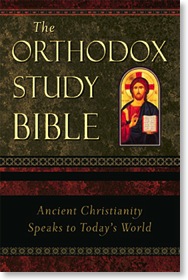
Theron himself worked on part of the OT project, specifically in translating segments of 1 & 2 Samuel, all the way back in 1999. The interesting twist (to me) is that at the time, Theron was a recent graduate of the Southern Baptist Theological Seminary (where he learned biblical Greek), but also a new convert to the Orthodox Church. Now that the OSB project is nearing its end Theron says he more excited about its release than the new Harry Potter novel.
I would hope so...
Inspired By...The Bible Experience Wins Audiobook of the Year
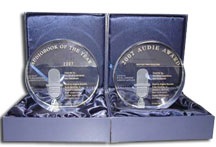
GRAND RAPIDS, Mich., June 4, 2007 – The most ambitious and bestselling audio presentation of the Bible ever produced, Inspired By… The Bible Experience (New Testament), has been named Audiobook of the Year, the most prestigious award for excellence in audiobooks, by the Audio Publishers Association (APA).
The award recognizes the audiobook that made the greatest impact on the audio publishing industry. To date, the New Testament edition of Inspired By… The Bible Experience has sold more than 300,000 units in eight months to become Zondervan’s fastest-selling new Bible, outselling perennial bestsellers. The combination of the product’s original score, theatrical production, world-class talent and use of the most accessible Bible translation, the TNIV (Today’s New International Version), also earned Inspired By… The Bible Experience a second Audie in the Inspirational/Spiritual category. The winners were announced during the Audies ceremony on Friday, June 1, in New York City.
BibleMemory.us Now Offering Free Memberships
BibleMemory.us offers specific tracks for Bible memorization or you can create your own. A number of Bible versions are offered including ASV, ESV, HCSB, KJV, The Message, NASB95, NCV, NIV, NKJV, and TNIV. If you don't see your translation of choice, let Robert know and he might be able to accommodate you.
Don't think that Bible memorization is just for the kids at AWANA! Pick it up today as part of your own spiritual disciplines. BibleMemory.us is a great place to start.
“I have treasured Your word in my heart
so that I may not sin against You.” (Psalm 119:11 HCSB)
Links:
• BibleMemory.us main program site
• BibleMemory.us Blog
• This Lamp Archives: "BibleMemory.us Now Available in TNIV"
TNIV Truth: Thick Not Thin
Has Faith: John 3:16 in the NEB/REB--Good Translation or Not?
“For God so loved the world, that he gave his only begotten Son, that whosoever believeth in him should not perish, but have everlasting life.” (John 3:16 KJV)
Yet the NEB (1961/70) translators were bold enough to make a few minor changes and one significant change in John 3:16, only to have all but one of them removed in the more conservative REB of 1989.
"God loved the world so much that he gave his only Son, that everyone who has faith in him may not die but have eternal life." (John 3:16 NEB)
“God so loved the world that he gave his only Son, that everyone who has faith in him may not perish but have eternal life.” (John 3:16 REB)
Neither "God loved the world so much" (NEB) or "God so loved the world" (REB, also KJV) reflects the meaning of John's Greek here. A much better, but certainly less traditional reading is found in the HCSB: "For God loved the world in this way" or in the NET Bible: "For this is the way God loved the world:" (for a discussion of why these renderings are more accurate, see my review of the HCSB).
But that's not the focus of this post. Rather, I want to call attention to the NEB/REB's use of "has faith" instead of the traditional "believe."
When I first got a copy of the REB, hot off the presses in 1989, the peculiar rendering of has faith got my attention in my initial examination of this version of the Bible. I did not yet have a copy of the NEB, so I did not know that this particular phrase was handed down from its predecessor. I was in college at the time, and I had a couple of significant influences in my life--mentors, if you will. In discussing the REB with one of these individuals, I pointed out the interesting phrasing of John 3:16 to him. He told me he wasn't quite sure how accurate "has faith" was in John's gospel. He had just finished a seminar at Golden Gate Seminary on John, and one of the things pointed out in the class is that the specific word faith (πίστις/pistis) never occurs in the fourth gospel.
And that's technically true. The noun form of of the word never appears in John. But, of course, as referenced in John 3:16, the verb form (πιστεύω/pisteuo) does. In fact, πιστεύω/pisteuo occurs 98 times in John!
From the UBS Greek Dictionary, here are the two words, the noun first and then the verb (which appears in John 3:16):
πίστις, εως f faith, trust, belief; the Christian faith; conviction, good conscience (Ro 14:22,23); perhaps body of faith, doctrine (Jude 1:3,20); assurance, proof (Ac 17:31); promise (1Tm 5:12)
πιστεύω believe (in), have faith (in) (with God or Christ as object); believe, believe in; have confidence (in someone or something), entrust (something to another); ὅς μὲν π. φαγεῖν πάντα one man’s faith allows him to eat anything (Ro 14:2)
I understand why the NEB/REB translators rendered πιστεύω "has faith" instead of believe. In the Greek the relationship between the noun and verb are evident; they have the same root. But in English, there isn't a direct verb form of faith. We don't say, "I faithed in Jesus." So why not just use the traditional believe?
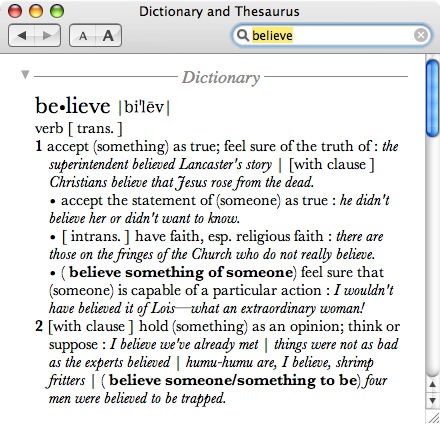
“You believe that there is one God. Good! Even the demons believe that—and shudder.” (James 2:19 TNIV)
Believe may simply not be an adequate word for πιστεύω in English. It's awkward, but the Amplified Bible gets the meaning across fairly well with "..so that whoever believes in (trusts in, clings to, relies on) Him shall not perish..." The parenthetical definition for believes in--"trusts in, clings to, relies on"--gets it right. But the Amplified Bible is not really suitable for any kind of use in a group setting (I don't really even recommend the Amplified Bible in general), so how can πιστεύω in John 3:16 best be rendered?
The NEB/REB may indeed have the best solution with has faith. What do you think? Is this good translation or do you think it's not allowed to use faith as a direct object in this verse since technically πίστις never occurs in John? Feel free to offer your opinion in the comments.
As an aside... Last Christmas, I went back to my home church for a worship service. I came across the same individual mentioned above who had been one of my mentors in college. He had just come from teaching a Bible study and was carrying two Bibles. He told me that he likes them both and gave up trying to choose one over the other. He carries them both to any study he leads or participates in. What were they? He was holding a TNIV Study Bible and a Cambridge text edition of the REB.
They say the apple doesn't fall far from the tree...
Making the Case (Yet Again) for Wide Margin Bibles
Although I've provided the link above, it won’t remain active after a few weeks, so I’ll include a screenshot below:
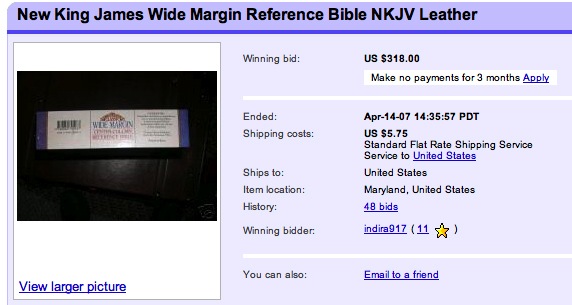
It boggles my mind really to think that someone would pay $318 for a wide margin NKJV--and a bonded leather one at that! But Larry summed it up quite well in his comments when he said this:
This must be proof positive that people are passionate about wide margin Bibles. More than $300 for a bonded leather cheapo Bible from Nelson? A NKJV?
And the fact that Nelson allowed this to go out of print while Crossway is publishing multiple note-taking Bibles may perhaps play some role in the NKJV's fall and the ESV's rise. (Certainly, there are other factors, but given the investment that publishers claim to make in new Bibles, why wouldn't they want to make their franchises available in every format that there is demand for?)
I think you put your finger on it a few months ago when you pointed out that while sales of wide margins may appear weak, they are sold to opinion makers -- and thus influence many more sales.
I've had representatives from three different Bible publishers tell me that wide margin Bibles just don't sell well. But it's that last statement made by Larry that I believe most Bible publishers just don't get. But Crossway gets it. They know that the teachers, preachers, and other serious Bible students want wide margin Bibles. And even if these particular buyers don't represent a large market, the fact is that this is the group that influences the purchases made by those sitting under their instruction. The fact that Crossway gets this is evidenced by the fact that they offer four different ESV Bibles with wide margins: The Deluxe Reference Bible, The Journaling Bible, The Single Column Reference Bible, and the Wide Margin Reference Bible.
But where are the decent wide-margin Bibles from the other 21st century translations (NLTse [2004], HCSB [2004], NET [2005], TNIV [2005])? Let's run through that list real quick.
New Living Translation
The original NLT1 (1996) had one of the best wide margin Bibles I've ever seen in terms of the Notemakers Bible. It had a healthy one and a half inches of space in the margins of a single-column text and two inches of lined space at the bottom for journaling. But since sells weren't that great, Tyndale has decided not to release an edition in the NLT second edition.
But why didn't the Notemakers Bible sell? The Living Bible and its inheritor, the New Living Translation have always been a bit of a populist Bible. While scholars put down the original Living Bible, Christians bought them in droves, and many testified that this was the first Bible they ever really understood. But these were probably not the kind of folks--for the most part--who would have been interested in a wide margin edition for their own notes.
The 1996 NLT wasn't that far removed from it's predecessor--especially in the public's eye--in spite now being called a translation rather than a paraphrase. Regardless, the top notch team of Evangelical scholars who produced the 1996 first edition reconvened to tighten up the translation, bringing it closer to the autographs and hopefully bring about the respect the NLT deserved. That resulted in the 2004 NLT second edition, which although quietly introduced was radically different than the first edition.
To gain even greater credibility, Tyndale has begun the Cornerstone Biblical Commentary Series, based solely on the NLTse. From the two volumes I have so far in the series, I can say that it's an excellent evangelical commentary series on the Bible. And I'm not sure it could have been based on the earlier NLT1 (let alone the Living Bible) without a great amount of work. But the NLTse is a different creature! And now that a commentary series is based on it, what would be a better match than an NLTse Bible with wide margins to study along with it and make notes? It seems to only make sense to me.
Holman Christian Standard Bible
There is only one wide margin HCSB Bible available: The HCSB Minister's Bible. So far it has received mixed reviews (see my review here). The main complaints stem from paper that is too thin and wide margins that really aren't that wide. Plus I've had more than one person email me who was not a minister saying they would like to use it simply to have a wide margin HCSB, but have been reluctant to do so because they feel funny carrying around something with that title on the spine. I'm really surprised there aren't more offerings here from Holman considering the HCSB is now the default translation in all of Lifeway's Sunday School curriculum. It would seem to me that a decent wide margin HCSB would be a perfect match.
NET Bible
I'm not totally surprised that the NET Bible has not seen a wide margin edition yet. Certainly with 60,000+ notes, one would wonder what could be added. Plus, the NET is still trying to gain the attention of the larger Evangelical world. Selling through more than merely mail order might help them out some. To me of all these Bible translations listed here that don't have wide-margin editions, the NET is the only one that gets a pass.
Today's New International Version
I would guess that the possibility of a TNIV Wide Margin Bible primarily suffers from the mixed track record of Zondervan's wide margin NIV and NASB Bibles. But if these editions have not sold quite as well as Zondervan would have liked there might be a reason why. Last year when I posted a Survey of Wide Margin Bibles by Version, I counted two other publishers of wide margins NIV's besides Zondervan and and three other NASB offerings. Could it be that the market for NIV and NASB wide margin Bibles is simply flooded? Consider also that most NASB aficionados have been using the classic single-column reference edition since the 1971 NASB. Foundation Press now offers a variety of high quality leather bindings in the classic reference edition, while Zondervan only offers hardback and bonded leather. There is a similar weakness for Zondervan's wide margin NIV: Cambridge offers a variety much higher quality bindings (scroll down to the bottom of the page for the previous link).
I'll come back to this, but one thing I believe that publishers like Cambridge and Crossway might get and Zondervan might not, is that people who buy a Bible for taking notes in want to use this Bible long term. Generally, there's going to be a preference for higher quality bindings. And if there's a choice, quality will trump cost--at least for these buyers.
The TNIV does have a wide margin represented in the "Squared" Bible. However, the TNIV Squared Bible breaks two cardinal rules of wide margin Bibles: (1) It is a thinline Bible, so the paper is not suitable for heavy annotations, and (2), as a two-column text, it does not allow any margin for the inner column. Ultimately, this Bible misses its intended market.
There is a TNIV Reference Bible coming out later this year, and many of the "gatekeepers" will use it as the best option of what's available, but I get emails and comments on this blog every week bemoaning the fact that it's not a wide-margin TNIV Bible. I would hope that eventually Zondervan will offer the TNIV Reference in a wide-margin offering.
Here's what most publishers are missing...
Most publishers don't get two things about wide margin Bibles:
- Despite lower sales, wide margin Bibles are for gatekeepers, and gatekeepers influence the translation choice of others who will buy the more popular editions.
- People who are in the market for a wide margin Bible want a quality Bible: genuine leather or better and a solid stitched binding. A wide-margin Bible is going to be considered by most to be a long term investment.
Finally, there's another little secret that Bible publishers don't realize, and I almost even hate to bring it up. But as evidenced by the sale of a $318 wide margin NKJV on eBay, people who want wide margin Bibles are willing to pay extra for them. It is well known that publishers make limited printings of some Bible editions. Why can't this be done for wide-margin Bibles, too? Heck, I imagine most of us would even be willing to order them straight from the publisher if there's some fear they wouldn't sell in stores. But most of us who would like to use a wide margin Bible would be willing to pay upwards of $100 knowing that it would be a long term investment, knowing that it should be a publication made with the utmost standards in binding and materials.
The wide margin survey that I posted last year remains one of the most popular pages on this blog. It gets hits everyday. There's a market out there. The products just need to match the demand.
Upcoming Sunday Morning Studies: Selected Minor Prophets
Below is our schedule for the summer:
| UNIT 1: KNOW GOD | |
| June 3 | Appropriate God's Mercy (Joel 1:1 - 3:21) |
| June 10 | Accept God's Lordship (Obad 1-21) |
| June 17 | Affirm God's Justice (Nah 1:1 - 3:19) |
| June 24 | Await God's Timing (Hab 1:1 - 3:19) |
| UNIT 2: DO WHAT GOD EXPECTS | |
| July 1 | Humility (Zeph 1:1 - 3:20) |
| July 8 | Commitment (Hag 1:1 - 2:23) |
| July 15 | Repentance (Zech 1:1 - 3:10) |
| July 22 | Dependence (Zech 4:1 - 6:15) |
| July 29 | Integrity (Zech 7:1 - 8:23) |
| August 5 | Joy (Zech 9:1 - 14:21) |
| UNIT 3: HONOR GOD | |
| August 12 | Love Wholeheartedly (Mal 1:1 - 4:6) |
| August 19 | Live Honorably (Mal 2:1-16) |
| August 26 | Worship Appropriately (Mal 2:17 - 4:6) |
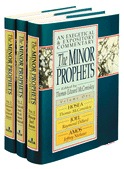
Although often overshadowed by the angst of their major counterparts, the Minor Prophets are a vital part of Scripture providing beauty, pathos, humility, and questioning. Based on the NRSV, this authoritative series features nine of the finest evangelical Old Testament scholars, insightful exposition, and meticulous exegesis of the Hebrew text. Each chapter is prefaced by an insightful introduction and provides meticulous exegesis of the Hebrew text. This commentary is a useful tool for both scholars and laypeople.
I've had volume one for a while. Yesterday, I began looking for the best price on vols. 2 & 3. However, this price at CBD is cheaper for the set than what I would pay for vols. 2 & 3 separately. I've got the set on order and I'll sell my duplicate copy of vol. 1 once the others arrive. Here is a list of contributors for this series:
VOLUME 1
Hosea: Thomas McComiskey
Joel: Raymond Dillard
Amos: Jeffrey Niehaus
VOLUME 2
Obadiah: Jeffrey Niehaus
Jonah: Joyce Baldwin
Micah: Bruce Waltke
Nahum: Tremper Longman III
Habakkuk: F. F. Bruce
VOLUME 3:
Zephaniah: J. Alec Motyer
Haggai: J. Alec Motyer
Zechariah: Thomas McComiskey
Malachi: Douglas Stuart
Biblical Illustrator Plus: Summer 2007
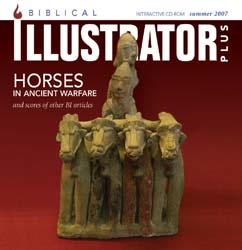
It's just dirt. Some believe that. But what people do with that dirt makes a huge difference. In some large metropolitan cities, land is being sold, not by the acre, but by the square foot. Location does matter.
This issue of Biblical Illustrator Plus looks at dirt and location and what happened at those locations. It looks at the Land of Promise that God gave His people. It looks at events that occurred in specific locations and at people from specific regions. This issue looks at those who built buildings and empires on that dirt--some for worship, some for self-aggrandizement. And we look at how some of those empires rose and waned.
People feel a kinship to the dirt, to the land, to its peoples, and to its cultures and traditions. In the end, though, may we remember that what matters is what we do for God and how we honor Him.
As I've mentioned before, Biblical Illustrator contains background articles for a number of Lifeway's Sunday School curriculums. The class I teach at Simpsonville Baptist Church uses the Explore the Bible curriculum, and this quarter we will take our lessons from the Minor Prophets of the Old Testament. The articles below that are drawn from the Minor Prophets directly relate to the texts I'll be teaching.
Below are the new articles in the Summer 2007 issue of Biblical Illustrator:
| Ken Cox | The Promised Land: A Crucial Locale | Deut 1-5 |
| R. Raymond Lloyd | Who Were the Amorites ? | Book of Deuteronomy |
| Rick W. Byargeon | The Cities of Refuge | Deut 4-5 |
| David L. Jenkins | What Happened at Ebal and Gerizim? | Deut 27-34 |
| C. Alan Woodward | Temple Personnel in the First Century | Acts 2:41-47; 4:1-37 |
| Timothy Trammel | Joppa: Its History and Significance |
Acts 9-11 |
| Stephen W. Carlson | Do You Believe in Magic? | Acts 13-14 |
| David E. Lanier | The Synagogue in the First Century | Acts 13-15 |
| Paul E. Kullman | The Synagogue: Its Design and Construction | Acts 13-15 |
| LeBron Matthews | Solomon in All His Splendor | 1 Kings 3:1-28 |
| John Traylor | The Allure of Baal | 1 Kings 19; 2 Kings 23 |
| Alan Moseley | Locusts! | Joel 1-3 |
| John Mark Terry | The Early and Latter Rains | Joel 1-3 |
| John L. Harris | The Day of the Lord | Books of Joel and Obadiah; Zeph 1-2; Zech 14 |
| Robert C. Dunston | Nahum: Getting His Message Across | Book of Nahum |
| Wayne VanHorn | The World Situation According to the 7th Century Prophets | Books of Nahum, Habakkuk & Zephaniah |
| David M. Wallace | Idols in Production and Ritual | Hab 1:1 - 3:19; Deut 4-5 |
| Martha S. Bergen | Zechariah and Haggai: Motivators and Builders | Books of Haggai & Zechariah |
| Robert A. Street | Zechariah's Visions and Oracles | Zech 1-8 |
| Jeff S. Anderson | The Spritiual Climate at the End of the Old Testament Era | Book of Malachi |
| Daniel P. Caldwell | Horses in Ancient Warfare | Books of Nahum, Habakkuk, Haggai & Zechariah |
| Eric A. Mitchell | ARTIFacts: Giants in the Land: Southern Baptists and Biblical Archaeology | |
| D. Larry Craig | Book Review: Kregel Dictionary of the Bible and Theology by Henry W. Holloman |
Now, as I've said many times, the best value of Biblical Illustrator lies in the CD: Biblical Illustrator Plus. In addition to the articles above, the CD contains over sixty articles from past issues. Additional articles in the Summer 2007 are listed below.
| Bob Simmons | Corinth: A Roman City | 1 & 2 Corinthians |
| Robert Street | Josiah: Rebuilder and Reformer | 2 Kings 21:1 - 23:5 |
| Charles W. Draper | Law & Faith | Book of Galatians |
| Bryan E. Beyer | Evil: the Meaning | Gen 3:1-6; Isa 5:20-21; Mal 2:16 |
| Bryce Sandlin | The Life Situation of Zechariah | Zech 3:1-2, 6-8; 4:1-6, 8-10a |
| Vernon Elmore | The Life Situation of Obadiah |
Obadiah 1-4, 8-10, 8-10, 13-17 |
| Fred Wood | Life Situation in Malachi | Mal 1:6-9; 2:8-9, 13-16 |
| James Travis | Historical Setting of Nahum | Nah 1:1-3a, 7-9, 12-15; 3:5-7 |
| Harold Moseley | Israel and the Nations | Minor Prophets |
| Larry McGraw | Tanning | Acts 10:34-36, 39-48 |
| Thomas D. Lea | The Sanhedren in the First Century | Acts 4:1-4, 7-12, 31; 5:17-21a, 29-33, 40-42 |
| Bill Tolar | Hellenist and Hebrew Christians | Acts 4:32, 34-35; 6:1-5, 7a |
| Mark Rathal | The Fear of the Lord | Eph5:21; 2 Cor 5:11 |
| R. Wayne Jones | Ancient Persia | Ezra 1:1 |
| Harry B. Hunt | From Cyrus II to Darius I | Ezra 4-5 |
| Sharon Roberts | Prophetesses in Ancient Israel | |
| Kevin C. Peacock | Pentecost and the Feast of Weeks | Acts 2:1-47 |
| L. Manning Garrett III | What Is Wisdom? | 1 Kings 3-4 |
| Claude F. Mariottini | Origins of the Monarchy in Israel | 1 Chron 4:9-10; 1 Kings 3:5-15 |
| Julie Nall Knowles | Jezebel Unveiled | 1 Kings 19-20 |
| Marsha Ellis Smith | Syria & Israel in 9th Century BC | 2 Kings 5:2-6, 9-14 |
Ray Lloyd |
Habakkuk: the Man and His Times | Hab 1:1 |
| Steve Lemke | Mount Carmel | 1 Kings 18:20; 2 Kings 5:15 |
| A. O. Collins | Josiah's Reform | 2 Kings 22 |
| Claude F. Mariottini | Josiah and His Court | 2 Kings 22:1 - 23:30 |
| John D. Duncan | Reconcilliation | 2 Cor 5:11 - 6:2 |
| Wayne Van Horn | People Who Built the Temple | Ezra 6:14-22 |
| Donald W. Garner | Zerubbabel's Temple | Ezra 4:1-6; 5:2-3; 6:14 |
| Bryce Sandlin | A History of Darius | Dan 6:1-28 |
| George W. Knight | First Century Antioch of Syria | Acts 11:19-30; 12:24-25 |
| Rick Johnson | God's Jealousy | Deut 5:1-9, 11-13, 16-21 |
| David S. Dockery | Sanctification | 2 Thess 2:13 |
| D. C. Martin | Malachi: His Life and Times | Book of Malachi |
| Julie Nall Knowles | First-Century Cypress | Acts 13:1-52 |
| Waylon Bailey | Ahab: King and Adversary | 2 Kings 17:1-24 |
| Elgia "Jay" Wells | Lessons for Race Relations | Acts 10:1-48; 8:26-40 |
| Larry McGraw | Barnabas and Paul's Missionary Journey | Acts 13; 14 |
| Linda Oaks Garrett | Kosher or Not? | Acts 9:32 - 11:18 |
| C. Mack Roark | Controversy and Response | Acts 15:1-35 |
| Harold R. Mosley | Does It Pay to Be Good? | Mal 3:13 - 4:6 |
| Robert A. Street | The Hind | Hab 2-3 |
| Billy E. Simmons | Barnabas and Mark | Acts 12:12, 25; 13:5, 13; 15:37-39; Col 4:10; 2 Tim 4:11 |
| Patrick D. Ward | Beersheba | 1 Kings 19:3 |
| Linda M. Bridges | Barnabas: An Early Missionary | Acts 14:12; 15:2 |
| Robert O. Coleman | Repentance in the Old Testament | Mal 3:7 |
| James Travis | Of Dreams and Visions | Joel 2:28; Dan 8:1 |
| A. O. Collins | Locusts | Joel 1:4 |
| Harry B. Hunt Jr. | Attitudes Toward Divorce in Post-Exilic Judaism | Mal 2:13-16; Matt 5:31 |
| Glenn McCoy | Reuben, Gad, and East-Manasseh | Deut 29:8 |
| Eugene Skelton | Darius I Hystaspes | Hag 1:1 |
| Robert A. Weathers | Sexual Purity in the New Testament | Job 31:1-4; Ps 101:3-4; 2 Cor 10:4-5; 1 Thess 4:3, 5-7 |
| James E. Carter | The Chosen | Acts 6:5 |
| Kelvin Moore | The Persian Empire | Books of Ezra, Nehemiah and Esther |
| R. Raymond Lloyd | The Heart in Old Testament Theology | |
| E. Lebron Matthews | Treaties and Covenants | Book of Deuteronomy |
| Wayne VanHorn | The Levites | Deut 9:1 - 11:22 |
| James Newell | The Fathers in Israel's History | Book of Deuteronomy |
| David M. Wallace | The Arabah | Deut 1:1 - 3:29 |
| Rick Byargeon | Memory and History in Israel's Faith | Deut 6:1-25; 7:1 - 8:20 |
| Dorman Laird | A Jealous God | Deut 4:44 - 5:33 |
| Stephen J. Andrews | How the Giants Have Fallen | Deut 1:1 - 4:43; 29:1 - 30:30 |
| Claude Mariottini | Mount Nebo | Deut 31:1-8, 34 |
| Francis X. Kimmitt | From Kadesh Barnea to Jericho | Books of Leviticus, Numbers, Deuteronomy & Joshua |
| Stephen R. Miller | Tithes & Offerings | Mal 3:6-18 |
Biblical Illustrator magazine is available for $24.95 a year. Biblical Illustrator Plus CD runs $34.35. I recommend the latter. If you teach Sunday School in a Southern Baptist Church, you may simply want to ask your Minister of Education to order you a copy of the CD with the next curriculum order. And although BI is aimed primarily at teachers, in my opinion, anyone interested in biblical history and backgrounds will benefit from this quarterly publication.
TNIV Truth: Thick or Thin?
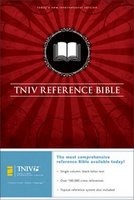
Question:
Is the upcoming TNIV Reference Bible going to have a standard thickness or is it going to be a thinline?
No one seems to know, but over in my newest post at TNIV Truth, "TNIV Reference Bible: Thick or Thin?" you have an opportunity to make your opinion known.
Top Ten Bible Versions: The Honorable Mentions
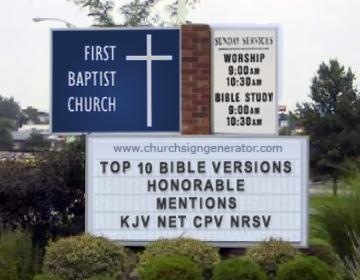
In hindsight, I don't know if the "Top Ten" designation was all that accurate because these aren't the ten Bibles I use the most. But in addition to the first few which I actually do use a good bit, I also wanted to introduce a few other translations that have stood out to me over the past couple of decades since I began collecting them. There are a few other Bibles that were contenders for such a list. I thought that I could briefly mention them in this follow up post.
King James Version.
I would imagine that if most people put together a top ten list, the KJV would be on it. I almost included it, but it seemed too predictable. Plus, I'm in no position to necessarily write anything new on the KJV (not that my other posts were wholly original either). Nevertheless, the KJV does deserve recognition because no other English translation has held the place of prominence that it has in the history of translations. It is still used today as a primary Bible by millions of Christians, still ranks somewhere in the top three positions of sales in CBA rankings, and even for those who have moved onto something newer, it is still the translation that verses have been memorized in like no other version.
I predict this is the last generation in which the KJV will still receive so much attention, but I have no trouble saying I may be wrong. It's difficult to say that one can be reasonably culturally literate--especially when it comes to the standards of American literature--without a familiarity of the KJV. Nevertheless, I cannot in good judgment recommend the KJV as a primary translation for study or proclamation because its use of language is too far removed from current usage. I don't mean that it's entirely unintelligible--not at all. But a primary Bible should communicate clear and understandable English in keeping with the spirit of the Koiné Greek that the New Testament was written in. I also cannot recommend it as a primary Bible because of the manuscript tradition upon which it rests. There's simply too much that has been added to the text. It was certainly the most accurate Bible in its day, but this is no longer true. My exception to this, however, is that I do find the KJV acceptable for public use with audiences made up primarily of senior citizens since this was exclusively their Bible. And the KJV still seems to be appropriate for use in formal ceremonies including churches and weddings--although I have not recently used it for such.
There is some confusion on what is actually the true King James version. Most do not realize that the average KJV picked up at the local book store is not the 1611 edition, but rather a 1769 fifth edition. And the reality is that there are numerous variations of this out there. For those who want a true and unadulterated KJV, the recently released New Cambridge Paragraph Edition seems to be the one worth getting.
The NET Bible.
The NET Bible is one of about four translations (including the ESV, NRSV, and KJV) of which I received the most emails asking why it wasn't included in my top ten. The primary initial reason for the NET Bible's exclusion was simply that I had not spent enough time with it. I made the unfortunate decision to purchase a "2nd beta edition" only a few weeks before the final first edition came out (of which I recently obtained a copy).
Everyone I've heard speak about the NET Bible has high remarks about the 60K+ notes that come with the standard edition. And I can honestly say that these notes have become a regular resource for me when I study a passage. I don't hear as much high praise for the translation itself, though I don't hear anything particularly negative about it either. In general, though, I do recommend the NET Bible. I really like the editions I've seen made available--not just the standard edition, but also the reader's edition, and the Greek/English diglot which I'm very impressed with. The notes in the diglot are a slightly different set than what is in the standard edition. The "ministry first" copyright policy and the ability to download the NET Bible for free from the internet are very commendable on the part of its handlers.
I'd like to see the NET Bible get more attention, and I'd like to see more people introduced to it. I'm not sure it will get the widespread attention it deserves as long as it can only be obtained through Bible.org. In spite of the fact that my top ten series is over, I am going to continue to review translations, and the NET Bible will probably receive my attention next. But we have to spend some quality time together first.
The Cotton Patch Version.
I decided not to include a colloquial translation in my top ten, but if I had, the Cotton Patch Version of the New Testament would have held the category. Most colloquial translations are fun, but a bit gimmicky. The Cotton Patch Version rendered from the Greek by Clarence Jordan was anything but gimmicky. During the height of the Civil Rights Movement in the 1960's, Jordan recast the events of the New Testament in the Southern United States. Replacing Jew and Gentile with "white" and "negro," and status quo Judaism with Southern Baptists (of which he was one), Jordan clearly brought the radical message of the New Testament into current contexts. The Cotton Patch Version is certainly fun reading if you are familiar with Bible Belt southern locales, but more importantly, the message is gripping as well.
The New Revised Standard Version.
The NRSV is an honorable mention I've added since I first announced the series. Originally, I felt like the NASB represented both the Tyndale tradition and formal equivalent translations well enough, plus at the time my use of the NRSV had become quite rare. Then my little NASB vs. NRSV comparison that I wrote with Larry revived my interest in the NRSV, and I now even have a copy sitting on my desk.
A year ago, I would have thought that the NRSV had seen its last day in the Bible version spotlight--except for academic use, but it seems to have had a bit of a renaissance with new attention and even new editions being published. It is still the translation of choice for the larger biblical academic community, primarily in my opinion because it has the widest selection of deutero-canonical books available of any translation. In its early days the NRSV was also embraced by many in the evangelical community but such enthusiasm seems to have waned. I think than rather than fears of theological bias, evangelical readers simply have too many other versions to choose from since the release of the NRSV.
Yes, the NRSV may be a few shades to the left of evangelical translations, but I've spent enough time with it to state clearly that it is not a liberal Bible. Don't let sponsorship from the National Counsel of Churches drive you away. If that were the only factor in its origin, I'd be skeptical, too, but the fact that Bruce Metzger was the editorial head of the translation committee gives me enough confidence to recommend it--if for nothing else, a translation to be read in parallel with others.
Well, is the series done? Not quite yet. I'll come back later this week with a few concluding thoughts about the list and the current state of Bible translations in general.
The Modern Language Bible: New Berkeley Version (Top Ten Bible Versions #10)
The serpent, wiliest of all the field animals the Lord God had made, said to the woman,
“So, God told you not to eat from any tree in the garden?”
(Gen 3:1, MLB, emphasis added)
Quite a few years before the NIV, Zondervan published a new translation of a New Testament called The Berkeley Version. It would later expanded to the entire Bible, and eventually receive a name change: The Modern Language Bible: The New Berkeley Version in Modern English.
However, even beyond a common publisher, there’s still another connection that the MLB has with the NIV. If history had turned out a bit differently, there’s a strong chance that the MLB--and not the NIV--could have risen to become the English-speaking world’s top-selling translation. Who knows? Perhaps instead of the TNIV, we’d have had Today’s Modern Language Bible (the TMLB!) for critics to be upset over.
Background. But I’m getting ahead of myself. Some may be wondering how the MLB came to be. This translation began as audacious dream of Gerrit Verkuyl, a Presbyterian minister and staff member of the Board of Christian Education of the Presbyterian Church, U.S.A. I say that the dream was audacious for two reasons. First, for Verkuyl, English was not a primary language. Nevertheless, this Dutch-born immigrant to the United States desired to create a Bible translation in modern English. Second, the seeds of this dream had been planted in Verkuyl's spirit during his undergraduate studies at Park College in Missouri where a professor instilled in him a love for Greek, and Verkuyl began comparing the Greek New Testament with the King James Version and the Dutch Bible he was most familiar with. Verkuyl determined that his Dutch Bible was more faithful to the Greek than the KJV, and he longed for a modern and accurate version to be made available in his newly adopted tongue, English. Yet, Verkuyl's career got in the way of his idea for a new translation, and work did not actually begin on it until he reached retirement at the age of 65! But if Moses' most important mission didn't begin until he was eighty, Verkuyl was not about to let his age get in the way of his dream.
In 1936 Gerrit Verkuyl began working on his modern language New Testament. A year later he moved to Berkeley, California, and in 1939 he retired from the Board of Christian Education so that he could devote his full energies to his translation. Borrowing the name of his new home, Verkuyl published the first edition of The Berkeley Version of the New Testament in 1945. The publishing rights were eventually transferred to Zondervan where there was interest in creating a complementary Old Testament as well. Such a large project as an Old Testament translation was outside the bounds of Verykuyl's abilities, especially at his advanced age. But a team of nineteen Hebrew scholars was put together who worked under Verkuyl's supervision to create a new translation of the Old Testament using the same principles and guidelines that Verkuyl had followed in translating his New Testament. The entire Bible was finally published in 1959 as The Berkeley Version of the Bible in Modern English. Verkuyl's lifelong dream which began when he was in his twenties, and was not commenced until he was in his sixties, was not fully completed until he was 86 years old!
The staff of Old Testament translators for the 1959 edition reads like a who's who of mid-twentieth century evangelical OT scholarship:
Gleason Archer, Fuller Theological Seminary
John W. Bailey, Berkeley Baptist Divinity School
David E. Culley, Western Theological Seminary
Derward W. Deere, Golden Gate Baptist Theological Seminary
Clyde T. Francisco, Southern Baptist Theological Seminary
Leonard Greenway, Pastor, Bethel Christian Reformed Church
Howard A. Hanke, Asbury College
S. Lewis Johnson, Dallas Theological Seminary
James B. Keefer, Missionary, United Presbyterian Church
William Sanford LaSor, Fuller Theological Seminary
Jacob M. Myers, Lutheran Theological Seminary
J. Barton Payne, Trinity Theological Seminary/Wheaton College
George L. Robinson, McCormick Theological Seminary
Samuel Schultz, Wheaton College
B. Hathaway Struthers, chaplain, U. S. Navy
Merrill F. Unger, Dallas Theological Seminary
Gerard Van Groningen, Reformed Theological College
Gerrit Verkuyl, Presbyterian Board of Education
Leon J. Wood, Grand Rapids Theological Seminary and Bible Institute
Martin J. Wyngaarden, Calvin Theological Seminary
Of the 1959 edition, F. F. Bruce wrote, "The Berkeley Version is the most outstanding among recent translations of both Testaments sponsored by private groups." And although he continued his enthusiasm toward the translation, especially the Old Testament, Bruce went on to point out numerous errors and questionable renderings in in 1961 book, The History of the Bible in English. Although the MLB was generally well received, the criticisms by Bruce and others led to another revision by E. Schuyler English, Frank E. Gaebelein, and G. Henry Waterman. That edition--said to be a revision, not a re-translation in the preface--was published in 1969, after the Verkuyl's death. The 1969 edition also received a new name: The Modern Language Bible: The New Berkeley Version in Modern English. According to the book, House of Zondervan,
the old [name] had become the victim of current events. The university in the city for which the version was named--Berkeley, California--had become a center of student revolt and the Free Speech Movement in the mid to late sixties, and the name Berkeley was a byword for antiestablishment protests.
Of course, the MLB was an antiestablishment protest in a sense. It was a protest against the KJV as the primary Bible used by English speaking Christians of his day.
The NIV Connection. So what's the MLB's relationship to the NIV? Well recently, David Dewey (author of A User's Guide to Bible Translations) and I were discussing the MLB via email correspondence. Dewey reminded me that if history had turned out a little differently, there's a strong possibility that the NIV would have never been and it might have been the MLB that went on to become the English-speaking world's most popular Bible versions. David wrote:
Apparently, when the National Association of Evangelicals inquired into a translation suitable for evangelical and evangelistic purposes, various options were considered before a decision was made to go for an entirely new translation. The options included the NASB, an evangelical edition of the RSV (how ironic we now have the ESV!) and Verkuyl's work
From David Dewey's book, A User's Guide to Bible Translations, in regard to the NIV:
As early as 1953 two separate approaches to inquire if an evangelical edition of the RSV might be permitted were declined. (One was made by the Evangelical Theological Society, the other by Oaks Hills Christian Training School, Minnesota. See Thuesen: In Discordance with the Scriptures, page 134). Separately from this, in 1955, Christian businessman Howard Long asked the Christian Reformed Church, of which he was a member, to consider the need for a Bible suited to evangelistic work. In 1956 the Synod of the CRC appointed a committee to consider the possibility. Independently of this, the National Association of Evangelicals set up a similar inquiry in 1957. A joint committee of the two groups was formed in 1961.
In a two-hour meeting in 1966 with Luther Weigle, chairman of the RSV committee, the option of preparing an evangelical edition of the RSV was again refused, despite a Catholic edition appearing in the same year. Other translations, including the Berkeley Version and the as yet incomplete NASB were also deemed unsuitable for what was in mind. So work on the NIV began in 1967, undertaken by the New York Bible Society (subsequently renamed the International Bible Society and relocated to Colorado Springs).
But who knows? Consider that in his section on The Berkeley Version of 1959, F. F. Bruce wrote the following:
The general format of this version reminds one forcibly of the Revised Standard Version, and it might not be too wide of the mark to describe it as a more conservative counterpart to the RSV
But in reading the rest of Bruce's review, one might understand why the Berkeley Version was passed up in favor of a brand new translation that would become the NIV. In reality, as demonstrated by Bruce, the 1959 still had quite a few rough spots. And Bruce's treatment today is a bit frustrating because although his book was updated in both 1970 and 1978, in neither one does he update his review. The reality is that when one compares Bruce's criticisms of the New Berkeley Version to the 1969 revision reflected in the MLB, the vast majority of them were corrected! Obviously, the revisers took into consideration Bruce's critique clearing up almost 90% of his concerns (but oddly leaving a few glaring ones intact). In the 1978 edition of Bruce's book, he merely adds this disclaimer: "The Berkeley version was revised as The Modern Language Bible, and many of the above-mentioned "stylistic oddities" were happily replaced by acceptable renderings (1969)." In my opinion, a much better survey of the MLB is found in the now out-of-print So Many Versions? (1983 edition) by Sakae Kubo and Walter F. Specht. In fact, these authors devote an entire chapter consisting of nine pages to the MLB--the most complete treatment of this Bible version I've seen yet.
Character and Significance. Gerrit Verkuyl wrote of his Berkeley Version that
I aimed at a translation less interpretive than Moffatt’s, more cultured in language than Goodspeed’s, more American than Weymouth’s, and less like the King James Version than the RSV.
In large part, he succeeded at his goal. He saw a definite need for a Bible translation such as his in the era in which he lived. Admittedly if one were to pick up the MLB for the first time today, it might come across as totally unremarkable in terms of contemporary language. In fact, at this point, it might be a bit dated in places. But this was not so in Verkuyl's day when the vast majority of Christendom still used the King James Version. One cannot even truly grasp the significance of the MLB without realizing that it was primarily created to counter the KJV's dominance in the English-speaking Church. By contrast, we have so many "modern language" Bibles to choose from today, we easily forget that merely a generation ago this was not the case.
Perhaps the fact that English was not Verkuyl's original language allowed him to see the inherent problems with a four-century old translation more easily.
A little girl from a Christian home asked me, “Why do I have to suffer to come to Jesus?” (Matt. 19:14, AV). Upon my reply that Jesus loves children and makes those happy who come to Him, she quoted what she had learned in Sunday School, and what she understood Jesus had said, “Suffer, little children to come to me.” How utterly contrary to our Lord’s intention was this small child’s conclusion! Divine revelation is intended to reveal His thoughts, but to this child the words of the AV failed to convey our Lord’s gracious invitation and no amount of dignity or rhythm can make up for such a failure. That child is entitled to a language in which it thinks and lives, and this is a right all human beings deserve.
Some might wonder where the MLB stands on the scale of translation (literal/formal/median/dynamic/paraphrase). I've never seen this directly addressed in any analysis of the MLB. Nevertheless, in my evaluation, the MLB is still basically a formal equivalent translation, but perhaps not so much as the RSV of its day. I'd probably place it on the scale somewhere between the RSV and the NIV as it does not quite reach the freedom in rendering that the latter does. Nevertheless, Verkuyl does seem to talk of moving away from a strict world-for word method in order to reach the thoughts of God. In the preface to the original Berkeley New Testament, Verkuyl wrote
As thought and action belong together so do religion and life. the language, therefore, that must serve to bring us God's thoughts and ways toward us needs to be the language in which we think and live rather than that of our ancestors who expressed themselves differently.
Certainly this is true and a reality that translators should keep in mind today concerning common use translations.
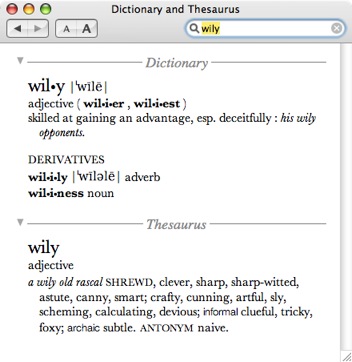
In Matt 19:25, many translations render ἐκπλήσσω with the word amazed or slightly better astonished. But I've never thought that these words quite capture the meaning of the original. Yet, see how the MLB translates the verse:
When the disciples heard this, they were utterly dumbfounded, and said, "Who then can be saved?" (Matt 19:25)
Some will find the overt legal terminology questionable, but the MBL's rendering of παράκλητος certainly brings out that aspect:
Dear children, I write you these things so you may not sin, and if anyone does sin, we have a counsel for our defense in the Father's presence, Jesus Christ the Righteous One. (1 John 2:1)
While other translations were still translating ἱλασμός as propitiation or expiation, Verkuyl used something more simpler, perhaps even influencing later translations such as the NIV:
He is Himself an atoning sacrifice for our sins, and not for ours only, but also for the whole world. (1 John 2:2)
No "broken pieces" in Mark 8:8. Rather something that is immediately understandable:
So they ate and were satisfied; and they picked up the leftovers, seven baskets full. (Mark 8:8)
The camaraderie that was surely present between Jesus and the disciples is reflected in a verse like this:
Then Jesus said to them, "Boys, have you caught anything?" They answered Him, "No." (John 21:5)
But perhaps at times, the rendering is a bit too modern:
Another unique rendering that demonstrates Verkuyl's sensitivity to the original languages is found in his translation of μέγας in Matt 18:4. I'm not sure what lexicons Verkuyl consulted for his work, but obviously it was not the newest edition of the BDAG. Nevertheless, in my copy (which is the 2000 third edition), μέγας in Matt 4:18 is listed with the meaning "pertaining to be relatively superior in intensity, great." The problem is that this relative aspect is somewhat lost when most translations simply use the word, greatest. Note how the MLB renders the verse remaining true to the relative use of μέγας in this verse:The disciple whom Jesus loved then said to Peter, "It is the Lord!" So Simon Peter, hearing "It is the Lord," wrapped his work jacket around him (for he was stripped) and flung himself into the sea. (John 21:7)
Whoever then humbles himself like this little child, he excels in the kingdom of heaven. (Matt 18:4)
Although the MLB was in many ways a reaction against the dominance of the KJV, and although Verkuyl did not tie himself to Tyndale-tradition renderings, nevertheless, he was still sensitive to the fact that most of his readers would still be very well acquainted with the KJV. According to Kubo and Specht, Verkuyl based the original Berkeley NT on the 8th edition of Tichendorf's Greek text in consultation with the Nestle text of his day. Knowing that his translation would be read by those more familiar with the KJV, he often included Textus Receptus readings in brackets within the text. So with the Lord's Prayer in Matthew six, Verkuyl adds the phrase "For Thine is the kingdom and the power and the glory forever. Amen," but does so bracketed. He included such phrases in the actual text because he knew that these were readings that would be made in the church. The MLB was not merely meant to be read alongside the KJV, but to supplant it for as many people willing to do so. In explanation to the verse mentioned above, a footnote appears:
The words enclosed in brackets are not found in the majority of the most reliable ancient manuscripts. They have been added to the text here to make the prayer more appropriate for public worship. Certainly the last sentence is compatible with Scripture. Cf I Chron. 29:11. In Luke's account of the Lord's Prayer, Lk. 11:2-4, this sentence is omitted.
One very nice feature of the MLB is the abundance of footnotes to the text. Verkuyl believed that footnotes to the text could and should be used as frequently as necessary to help the reader bridge that gap between the languages and contexts of the original authors. Some footnotes are textual in nature such as the one quoted above. But many have to do with backgrounds/historical issues or even explanations of Greek or Hebrew words. A few tend to be more applicatory. On the same page as as the footnote quoted above, one finds these explanations:
- For robe and tunic in Matt 5:40-- "A tunic reached to the knees; a robe was a long outside garment which reached almost to the ankles."
- For Matt 5:43, cross-references are offered: "Lev. 19:18; Deut 23:3-6."
- A note of application is given for Matt 5:45-- "We show that we are God's sons by living His principles."
- For Matt 5:48, the word perfect is explained: "'Perfect' is from the Greek teleios meaning complete, mature."
- For 6:12, an interpretive explanation: "Debts [the word Verkuyl uses here in his translation], or trespasses in the sense of falling short of God's requirements."
Another modern aspect of the MLB was the desire by Verkuyl and the OT translators to give strictly modern equivalents to weights, measures and even currency. Consider these verses from the MLB compared with the most recent of the contemporary translations, the TNIV:
GENESIS 6:15 |
|
MLB |
TNIV |
| Construct it after this fashion: The length of the ark 450 feet; its width 75 feet and its depth 45 feet. | This is how you are to build it: The ark is to be three hundred cubits long, fifty cubits wide and thirty cubits high.* *That is, about 450 feet long, 75 feet wide and 45 feet high or about 135 meters long, 22.5 meters wide and 13.5 meters high. |
|
EXODUS 29:40 |
|
MLB |
TNIV |
| With the first lamb you shall offer an ample six pints of fine flour mixed with 3 pints of pressed olive oil; and a libation of 3 pints of wine. | With the first lamb offer a tenth of an ephah* of the finest flour mixed with a quarter of a hin** of oil from pressed olives, and a quarter of a hin of wine as a drink offering. *That is, probably about 3 1/2 pounds or about 1 1/2 kilograms |
EXODUS 38:26 |
|
MLB |
TNIV |
was about 12,000 pounds* around 65 cents per man for everyone registered from 20 years up, 603,550** men. *$201,000. |
one beka per person, that is, half a shekel,* according to the sanctuary shekel, from everyone who had crossed over to those counted, twenty years old or more, a total of 603,550 men. *That is, about 1/5 ounce or about 5.7 grams. |
|
MATTHEW 25:15 |
|
MLB |
TNIV |
To one he gave ten thousand dollars;* to another, four thousand; and to a third, two thousand--each according to his own ability; then he went away. *In vss. 15-28 the direct translation from the Greek text reads "five talents [pente talanta]," "two talents" and "one talent," and in vs. 29 "ten talents." A silver talent wouldbe equivalent to about $2000 in mid-twentieth century U.S. currency, so that the figures given in this edition are approximately accurate. |
To one he gave five bags of gold, to another two bags, and to another one bag, each according to his ability. Then he went on his journey. *Greek five talents . . . two talents . . . one talent; also throughout this parable; a talent was worth about 20 years of a day laborer’s wage. |
The desire to make measures and weights into modern equivalents is admirable. In recent translations, the NLT is probably best at this. Note that in Gen 6:16 quoted above, the original NIV had feet instead of cubits, but this was changed in the TNIV--further evidence of my contention that overall the TNIV is more literal than the NIV. Nevertheless, while an admirable goal for the MLB, surely the greatest challenge would have to do with currency. The TNIV demonstrates contemporary wrestling with this issue in the questionable use of "bags of gold" in Matt 25 (obviously this was done because the average reader confuses monetary talents with "special ability" talents). The MLB's use of "cents" in the OT somehow seems out of place. But the greater problem lies in rising inflation rates. Maybe inflation was not a great issue in the fifties and sixties, but such use today would quickly date a translation. At our current rate of language change, English translations of the Bible only seem to have about a 20 to 25 year life span in my estimation. But adding in current monetary values--especially oddly placed United States monetary values--would date a translation very quickly. Perhaps only the NET Bible with its promised five years for a fixed translation between editions could pull this off, but because of the other factors mentioned here, I would certainly not recommend it.
Like many translations of its day, the MLB uses more formal pronouns (thee, thy, thou) for addressing God in the Old Testament. In earlier editions this practice was continued in the New Testament as well referring to Christ, but only in certain contexts. In the 1969 revision, this practice was removed altogether from the NT, but retained in the OT. The MLB also used capital letters for pronouns referring to deity throughout both testaments. However, like the RSV, the MLB did not follow the KJV's practice of formatting words added for understanding in italics.
A rather odd feature of the original Berkeley Version was the non-use of quotation marks for any words spoken by God or Jesus. The rationale was that all of the Bible is God's Word and Jesus is the Word of God, so why use quotation marks? This practice was done away with in the NT for the 1969 revision, but retained in the OT which received less attention from the revisers. In spite of F. F. Bruce's enthusiasm for the MLB OT in the 1959 edition, I would suggest that in the final product of the 1969 edition, the NT is much more consistent and polished.
The MLB Old Testament is significant because it was one of the first English translations to take advantage of the newly discovered Dead Sea Scrolls. This version used the DSS to "fix" known problems in the Masoretic text. Nearly all modern translations do the same, today. But if I may be so bold as to disagree with "the Bruce," the MLB OT needed at least one more revisers' pass to make it thoroughly ready for widespread use. Part of the problem stemmed from a lack of editorial committees, a practice common in translations today. The OT scholars responsible for translating the OT were primarily left to themselves, having been given the instruction to follow the same "modern language" principles utilized by Verkuyl in his original NT. Then Verkuyl himself acted as a final editor for the OT, a very large task for one man, and one who was aging at that.
The most glaring inconsistency has to do with the use of the divine name, the Tetragrammaton. The MLB generally follows the principle used in most English translations by simply using the word LORD, spelled in all caps to represent God's name. However, like some modern translations, including the HCSB, there are some texts when reference is made to the name that the actual name itself would make more sense. But this name has been spelled differently over the centuries, and oddly enough, two different spellings show up in the MLB:
"Jehovah"
God said further to Moses, You tell the Israelites: Jehovah, the God of your fathers, the God of Abraham, of Isaac and of Jacob has sent me to you. This is My name forever and by this I am to be remembered through all generations. (Ex 3:15)
O Jehovah, our LORD, how glorious is Thy name in all the earth! (Psalm 8:1/9)
"Yahweh"
the LORD, the God of hosts, YAHWEH His name. (Hos 12:5)
And then one text where the reader might expect to see the name spelled out, it is not:
Seek Him who makes the Pleiades and Orion, who turns blackness to morning and darkens day to night; Him who calls the waters of the sea and pours them out on the face of the earth--the LORD is His name. (Amos 5:8)
Well, this is sloppy for more than just the inconsistency regarding the divine name. There are other problems in these texts. In Psalm 8:1/9 above, if Jehovah is used, LORD should not be in all caps because the second occurrence is adonai, not YHWH. And Hos 12:5 above is not a typo on my part. The text would read better with a verb added: "YAHWEH is His name."
One doesn't really wonder why the 1959 edition was passed over as a suitable translation to be used in evangelical and evangelistic purposes. The translation, especially the OT, was still a bit rough. But these very errors mentioned immediately above were noted by F. F. Bruce, so it's surprising they weren't corrected in the 1969 revision because other issues certainly were changed. Nevertheless, the MLB retains a significant place in 20th century translations, but was eclipsed by later translations, especially the NIV.
What's Available and Concluding Thoughts.I picked up my first copy of the MLB sometime in the late eighties--a green paperback Zondervan edition with California grapes on the cover. Technically, this translation was past its prime by the time I came to the party, but for whatever reason I clicked with it. Many nights at church, since I wasn't teaching, I left my NASB at home and carried my MLB. In fact, in many ways, in those pre-computer days, it was one of my most used secondary Bibles.
When I first put together this list of top ten Bibles, I tried to make clear that although some of them really were translations I used a good bit, others were not--but were primarily "best of" a certain category of Bible. To me, the MLB--specifically the NT--stands as one of the best (and most consistent) single-translator Bible versions ever produced in the 20th century. These days, committees produce most of our English translations. But we should be careful to remember that individuals have been responsible for quite a few translations that are worthy of our attention. This includes Bible versions such as those produced by Tyndale, Moffatt, Goodspeed, Beck, Phillips, Taylor, certainly Verkuyl, and a host of others.
To be honest, I don't use the MLB all that much anymore. Frankly, I'd use it more if I had an electronic edition in Accordance, but I can't find electronic editions anywhere except one made for PDA's. That means it is available in an electronic edition, just not a practical one (for my purposes). However, to its credit, the MLB has not yet gone out of print in its 60 years of publication. In 1990, after a near-exclusive history with Zondervan, the rights were transferred to Hendirickson Publishers. When Hendrickson took over, they released a nice hardback edition which I promptly bought and gave away my green Zondervan paperback to a minister friend. Currently, that hardback edition is no longer in print, but Hendrickson does make available a copy of the MLB in paperback (ISBN 1565639316). If you consider yourself an enthusiast of Bible translations, your collection is nowhere near complete without the MLB.
Whether or not the MLB (or the earlier Berkeley Version) was ever published in leather, I have no idea. Every copy I've ever seen, even of the original editions were hardback. If someone knows differently, let us know in the comments.
The MLB is definitely past its prime. I don't see the MLB getting any attention on the copyright pages of Christian books anymore. But it certainly did for a while. It was widely used in evangelical publishing--usually as a secondary translation, but there were also a handful of books based primarily on it. Billy Graham even gave away copies of the NT at his crusades, I've been told as recently as the early nineties. Certainly more than a footnote in Bible history, the MLB at least was an important chapter as English-speaking Christians gradually began to move away from the KJV. If the MLB was a "conservative RSV," it was eventually replaced by others translations which were even more so, including the NASB and the NIV which ultimately eclipsed it. But it almost was the NIV. Would history have turned out differently if the equivalent of the 1969 edition had already been released when the search was on for a modern English translation to use for evangelistic purposes?
The MLB seems to be a translation that could have been much more. In truth, it needed one more revision that never came. Within less than ten years of its final edition, its publisher Zondervan began marketing the first edition of a new translation, the New International Version--which finally did unseat the KJV as the most used English translation. While the NIV really was a better translation overall, the MLB had a bit of personality that I'm not sure was present in the NIV. I mean, you don't see clever renderings like wiliest in Gen 3:15 in the NIV (although check out NIV Job 5:18). There may be a word of warning here, too. Even a good translation can fall into disuse if neglected in favor of another by a publisher simply because one will bring in more money. I would like to continue to encourage Zondervan to transition itself away from the NIV as a base translation to its successor the TNIV, something that has been slow to take place. I'd hate to see the TNIV sitting beside the MLB one day as another victim of the NIV's success.
Sources used:
F. F. Bruce, The History of the Bible in English
David Dewey, A User's Guide to Bible Translations
Sakae Kubo and Walter F. Specht, So Many Versions? 20th Century English Versions of the Bible (out of print, but used copies are still available)
James E. Ruark, The House of Zondervan
Gerrit Verkuyl, "The Berkeley Version of the New Testament" (this article was written before the final editions, so some references have been changed, but it provides a good introduction and insight into Verkuyl's vision and goals).
Up Next: The Honorable Mentions: The KJV, the NET Bible, the Cotton Patch Version...and one more that I've added since I made the original list...
Review: Writing of St. Paul, 2nd edition by Meeks & Fitzgerald
Below is a guest review from This Lamp reader and occasional contributor, Larry.
Writings of St. Paul, 2nd ed., Edited by Wayne Meeks and John Fitzgerald, (Norton 2007) (Amazon price $14.50
[Note: because of the recent appearance of this work, I’ve decided to change my order of presentation of academic study Bible reviews. Previous reviews discussed the (Oxford) Jewish Study Bible and the New Oxford Annotated Study Bible, 3rd Augmented Edition. See my introductory remarks in my first review.]
There are many ways to read the Bible. One way is to attempt to understand the “original authorial intent” of the Bible – often called a historical-critical reading. A related, but distinct way is to attempt to chart the way that various readers have understood the Bible. Both of these methods have value, but in the complex portions of Scripture, we may never have a clear consensus of the meaning of Scripture, so the most we can hope for is to understand how different groups have read it. The Writings of St. Paul (2nd edition) (WSP) is an excellent introduction to reading the writings of Paul through the eyes of groups varying from his contemporaries to our contemporaries.
The Pauline Epistles form a genre unto themselves – aside from Jesus (who is the subject of the Christian Scriptures but not the direct author or any book in it), Paul is the leading character in the Greek writings of the Bible. Seven letters are clearly written by him, another six letters are attributed to him, there is an extensive New Testament apocryphal literature attributed to Paul, and a good portion of Acts is devoted to him. Paul may the single greatest contributor to Christian theology and the meaning of his works form the most virulent disputes in Christendom. The secondary literature on Paul – even in English – is so extensive that no single person can hope to read it all. But understanding the different ways in which Paul is interpreted is important, not only for the Christian faithful, but for anyone who wishes to understand this religious genius of Western culture.
Paul is difficult to read – his reasoning often appears inconsistent and his writing was to specific audiences who were familiar with Second Temple period Judaism or contemporary Hellenistic culture – under Roman political rule. Since most of us are not fluent in cultural references from this period, it is easy to misunderstand Paul.
Norton publishes a series of relatively inexpensive paperbacks featuring annotated texts and assorted essays with critical readings, called the Norton Critical Editions series. These are the “Criterion Editions” of the literary world – stuffed with notes and extra material. The selection of titles does not attempt to be a comprehensive survey of literature, but rather includes a variety of texts that are of interest in the undergraduate classroom. (Among the texts of interest to those in religious studies are St. Thomas Aquinas on Politics and Ethics, Newman’s Apologia Pro Vita Sua, The Epic of Giglamesh, and Dante’s Inferno.)
The Writings of St. Paul, 2nd edition (WSP) is a revision of a 1972 classic by Wayne Meeks (which is still available
The philosophy behind this work is to present the broadest possible set of views. Thus we hear from Paul’s opponents (e.g., the Jewish Christians often criticized by Paul, the Pagans) and those with radically different views of Paul (e.g., the Jews, the Gnostics). Thus this book has full representation of the opinions of heretics – and even for the faithful, this is useful; since it allows us to understand the nature of some of the disputes over Paul, both classical and modern.
The switch to the TNIV
The biggest surprise in this new edition is the textual basis – the first edition used the 1946 RSV translation (note that the first edition predated the appearance of the NIV and NRSV, although it postdated the appearance of the NEB and the NASB.) In the first edition, the editor writes (p. xi)
"The text is from the Revised Standard Version. It was chosen from the several excellent contemporary English versions now available because its relatively conservative mode of translation enables the reader to recognize certain distinctive features of Paul’s style."
The second edition uses the TNIV instead, a surprising choice since the TNIV is most closely associated with Evangelical circles. The editors write (p. xi)
“The text of the Pauline letters is from Today’s New International Version (TNIV). It was chosen from the several excellent modern versions now available ecause its relatively conservative mode of translation enables the reader to recognize certain distinctive features of Paul’s style, while still taking account of current discussions in biblical scholarship and aiming for both inclusiveness and accuracy in the representation of gender.”
Clearly issues of gender played a large role in the editors’ decision to use the TNIV. This inclusive approach forms a core desideratum of the authors, who are at pains to point out (p. 589) “whereas the first edition had no excerpts from female scholars, the second edition features contributions by seven women.” The second edition also features many more contributions by Jewish scholars and contemporary Roman Catholic scholars.
Overall, the TNIV works better than I expected as a textual basis. The Epistles are difficult reading, and the TNIV certainly reads more smoothly than the RSV and NRSV. Furthermore, Paul requires careful attention, but his writing is rarely characterized as elegant. Paul writes in a rough, sometimes crude, Koine style, and thus is robust enough to retain its character in a translation that sometimes uses paraphrase (in contrast to more formal passages in Scripture, such as the Psalms.)
The editors do not always agree with the text of the TNIV. In some cases, they use their footnotes to assert an alternative translation. (For example, they prefer the RSV’s rendering of Romans 9:5. This verse can be punctuated in several ways; the TNIV, RSV, and NRSV all punctuate this verse differently although each translation gives the other two alternatives in footnotes.)
One might wonder why the editors did not choose the NRSV. Although there is no explicit explanation, hints are given that the editors are often critical of the NRSV’s rendering. For example, the NRSV renders Acts 22:3 as
I am a Jew, born in Tarsus in Cicilia, but brought up in this city [Jerusalem] at the feet of Gamaliel, educated strictly according to our ancestral law.
while the NIV has
The implications here are quite different – the NRSV seems to suggest that Paul only was “brought up” in Jerusalem when he entered Gamaliel’s yeshiva, while the NIV implies a much closer connection with the center of mainstream Jewish thought. The editors discuss the pros and cons of either translation, slightly favoring the NIV’s rendition (which remains largely similar in the TNIV.) (Interestingly, neither the NRSV nor the TNIV include a textual note discussing the alternative reading.) The editors include a variety of apocryphal legends, including one from Paul’s Jewish-Christian critics (paraphrased by Epiphanius, Bishop of Salmis,) that Paul was a convert who was spurned in marriage and thus became radically anti-Jewish – although the editors unambiguously reject this legend asserting that Paul was a “a Hebrew [born] of Hebrews.”I am a Jew, born in Tarsus of Cilicia, but brought up in this city. Under Gamaliel I was thoroughly trained in the law of our fathers.
For me, an interesting effect of this edition was that more academic “framing” of the TNIV caused me to see the TNIV in a more neutral light. With more academic footnotes (that in some cases make textual emendations to the TNIV’s translation) the TNIV seemed less like a doctrinaire Evangelical translation and more like a neutral translation. Of course, this is a double-edged sword, and those who want a strictly Evangelical presentation of Paul may not care for the WSP. But for those who wish to understand in a more academic framework the ways in which Paul has been read – both by supporters and by critics –this more neutral framing is essential.
Parts 1&2: Paul’s Letters and Pauline School Letters
The work begins with an introduction that surveys sources and Paul’s biography, and then follows with Part 1, Paul’s letters sorted by likely date of composition: 1 Thessalonians, Galatians, 1 & 2 Corinthians, Romans, Philippians, and Philemon. These works are accompanied by lengthy introductions and generous annotations that often discuss Hellenistic or Jewish references or matters of language style. However, given the unusual ordering of the books and formatting that makes chapter and verse symbols similar, it can be hard to quickly look up a specific passage. Then follows Part 2, six letters traditionally attributed to Paul, with introductions explaining why Pauline authorship is controversial, again organized in terms of date of likely composition: 2 Thessalonians, Colossians, Ephesians, 1&2 Timothy, and Titus.
Part 3 Pseudo-Pauline Works
These pseudepigrapha are identified as clear forgeries. The Correspondence of Paul and the Corinthians appears in the Acts of Paul and is an “orthodox forgery” to combat heresy. The Laodicean Epistle is a cento of Pauline epigrams primarily drawn from Philippians. The Correspondence of Paul and Seneca builds on the similarity between to two great classical figures and lead to Jerome’s inclusion of “our Seneca” in his On Illustrious Men. (Seneca chides Paul for his rhetorical style, while Paul exhorts Seneca to be a “herald of Jesus Christ” to the imperial household.) Two apocalypses follow, based on the famous passage 2 Corinthians 1-4 when Paul ascends to the third heaven. The Apocalypse of Paul (excerpted) is, according to Syriac legend, the written record of this revelation (this was one of the inspirations for Dante’s Inferno.) The Gnostic Apocalypse of Paul is a Nag Hammadi codex which recounts Paul’s travels to the fourth through tenth century. Note that the Prayer of the Apostle Paul from the Nag Hammadi library is not included (since it is not attributed to Paul but a petition that invokes him as an authority.)
Part 4 Views of Paul in the Ancient Church
This section begins with excerpts from the sections of Acts dealing with Paul (in the TNIV translation) and analyses of the Lukan account by Irenaeus (2nd century Bishop of Lyons) and by separate pair of differing scholars: Daniel Schwartz (Hebrew University) and Jacob Jervell (University of Oslo). The analysis of Acts concludes with a very interesting (and engagingly written) discussion of the Bar Jesus episode (Acts 13) by Susan Garrett (Louisville Presbyterian Theological Seminary).
Next the text presents apocryphal accounts: Jerome’s discussion of Paul, Tertullian’s claim that Jacob foresaw Paul’s life, an account of the risen Christ predicting Paul from the apocryphal Epistle of the Apostles, a physical description of Paul from the apocryphal Acts of Paul and Thecla, a description from Clement of Alexandra which interprets Phil. 4:3 as a reference to Paul’s spouse and gives an account of it, a description of Paul’s daily schedule from Ambrosiaster, a story of the of baptized lion (I remember hearing this as a child) from the apocryphal Acts of Paul, another extract of Clement of Alexandria where he quotes an apocryphal account of Paul consulting pagan oracles, a lengthy extract of a panegyric from Chrysostom on Paul as the Paragon of Virtue, and an extract from the apocryphal Acts of Peter of Paul’s missionary journey to Spain.
Apocryphal accounts of a martyr’s death for Paul appear from an extract of Clement of Rome’s work in the Apostolic Fathers and from the apocryphal Acts of Paul.
Jewish-Christian opponents to Paul are represented in extracts of paraphrases of their comments from Abrosiaster and Epiphanius. Direct attacks appear from a long extract from the Preachings of Peter [depicting Paul as the “messenger of Satan”] and the pseudo-Clementine Recognitions of Clementine. J. Louis Martyn (Union Theological Seminary) analyzes Paul’s Galatian opponent, Martin Hengel (Tubingen) analyzes the Lettter of James as an anti-Pauline polemic, and David Flusser (Hebrew University) discussing Jewish-Christianity enmity in the Didache.
Pagan opponents to Paul are represented by extracts from Emperor Julian’s Against the Galileans, and an anonymous Hellene’s attack on Paul quoted by Macarius Magnes in Monogenes. But then follows a fascinating discussion of how the Gnostic Valentinus and his school interpreted Paul favorably – with an extract of Theodotus arguing that Paul was the Gnostic Paraclete, an extract from Elaine Pagel’s (Princeton University) Gnostic Paul, and a discussion from Irenaeus.
Marcion’s dualistic interpretation of Paul is represented by extracts from Irenaeus’s Treatise of Irenaeus of Lugdunum against the Heresies and Tertullian’s Against Marcion, followed by Marcion’s epigrammatic Antitheses as reconstructed by Adolf von Harnack and von Harnack’s analysis itself.
There then follows a discussion of Paul’s celibacy and asceticism with extracts from the apocryphal Acts of Paul and Thecla and a detailed technical analysis by Dennis MacDonald (Claremont Graduate University) of the Pastoral Epistles with a discussion of the role of women and asceticism.
There is a brief extract from the apocryphal Acts of Phileas in which Phileas’s execution is described and in which he defends Paul.
We then have extracts from the Orthodox fathers interpreting Paul from Origen, Irenaeus, Victorinus, Theodore of Mopsuestia, Theodoret of Cyrus, and Ambosiaster. Bernadette Brooten (Brandeis) analyzes the Patristic interpretations of Romans 1:26.
Part 4 concludes with an extract from David Rensberger’s Yale Ph.D. dissertation analyzing the use of Paul’s letters in Second Century Christianity.
Part 5: Law versus Grace and the Problem of Ethics
The role of grace versus law is explored in extracts by Origen, Abrosiaster, Pelagius, Augustine, Theodoret of Cyrus, Martin Luther (from his lectures on Galatians), and Karl Barth (from his own summary of his book Christ and Adam). While the outlines of this debate is likely to be familiar to most readers of Rick’s blog, it is still a pleasure to read the careful exegesis directly from the “horses’ mouths” of these profound interpreters.
Part 6: “The Second Founder of Christianity”
This section revolves around the 19th century German debate on Paul. The question was: did Paul cause Greek philosophical theology to replace that of Jesus? The original provocateur was F. C. Baur – the founder of the Tubingen school – and an extract from his Church History of the First Three Centuries is given. Baur argued that Paul had changed Jesus’s message from a Jewish one to a Greek one. Nietzsche, in an extracts from his Dawn of the Day and from his Antichrist, argues to the contrary Paul was a Judaizer – locking the universal message of Jesus into the straightjacket of “rabbinic” myth. George Bernard Shaw, in an extract from his Preface on the Prospects of Christianity (from his Androcles and the Lion) argues similarly, only with humor and without the dark metaphysics and racial trappings of anti-Paulism. Adolf von Harnack, in an extract from What is Christianity? partly agrees Baur that Paul removed the Jewish “husk” from Jesus’s message, but presents the transition as direct and linear rather than dialectical. Wilhelm Heitmuller in an extract (translated) from Zum Problem Paulus und Jesus argues convincingly that the Hellinization of Christianity had already taken place before Paul and that Paul was converted to a Hellenistic form of Christianity (with sacraments, cultus, and atonement doctrine). This work was quite influential, and particularly influenced Rudolf Bultmann.
Part 7: Pauline Christianity and Judaism
Paul’s writings established a tension between Christianity and Judaism that was perhaps only dissolved in light of a full understanding of the horrors of the Holocaust. These four articles by Jewish scholars present a range of responses to Paul, in works by David Daube (UC Berkeley), Burton Visotzky (Jewish Theological Seminary), Daniel Boyarin (UC Berkeley), Alan Segal (Columbia), and Paula Fredriksen (Boston University). I found these essays very interesting – they explore the Jewish foundations of Pauline’s writing; especially interesting to me was Segal contrast of Paul’s mysticism with Jewish mysticism of the period. Segal argues convincingly for him as a type of Jewish mystic.
Part 8: Reading Romans
It is not hard to see why the Letters to the Romans is influential – it is the closest in form to a theological treatise. This part considers two passage from Romans, one passage being 7:1-25 where the pain of self-contradiction and the human plight form an essential part of the road to conversion. The second passage is Romans 13:1-7 which has influenced Christian forms of government.
A school of thought popularized by E. P. Sanders, James Dunn, and N. T. Wright called “the new perspective on Paul” has attracted wide attention in the Evangelical community as a contrast to Calvinistic thought; the theory proposes that when Paul speaks of justification he is not criticizing Judaism’s legalism as much as arguing for the status of gentiles in the Church. While this line of thinking has certainly penetrated public consciousness, I am not fully convinced that it is a first-line issue for New Testament scholars. (My own opinion is that the advocates of the “new perspective” are rather sloppy in their handling of rabbinic sources and don’t have a clear understanding of Second Temple Judaism.) First, it seems to me that many of the ideas underlying the “new perspective” were already present in criticism; I question the novelty of their work.
Sanders, Dunn, and Wright are not present in this anthology; books by Sanders and Dunn are listed in the bibliography (Wright does not even merit mention in any of the essays.) But to some degree, ideas from the “new perspective” are present in this part and in the next part. (For someone interested in a detailed anthology of views on Romans, including the “new perspective,” I can recommend another anthology, The Romans Debate
The section dealing with Romans 7 has extracts from Theodoret of Cyrus, Krister Stendahl (Bishop of Stockholm and Harvard), Paul Meyer (Princeton), and Stanley Stower (Brown). The section dealing with Romans 13 has extracts from Origen, Schelkle (Tubingen), Wilfrid Parsons (Georgetown and Catholic University), Martin Luther; Jonathan Mayhe,; and Ernst Kasemann (who was arrested by Gestapo – and then held by the Soviet troops, later of Tubingen).
Part 9: Sampler of Modern Approaches to Paul and His Letters
This section is among the most interesting, giving a wide sample of highly diverse modern approaches to Paul, including a discussion by Rudolf Bultmann of his mythologizing and demythologizing theories (extracted from Kerygma and Myth); Nils Dahl contrasting Paul’s treatment of Jesus with the story of the Akedah, the binding of Isaac; Gerd Theissen’s (Heidelberg) The Strong and the Weak in Corinth, a pioneering sociological analysis; two feminist pieces: an extract from Elisabeth Fiorenza’s (Harvard) classic In Memory of Her and an extract from Jouette Bassler’s (SMU) The Widow’s Tale; a trio of articles continuing the mythologizing approach from Bultmann by Abraham Malherbe (Yale), Hans-Josef Klauck (Chicago), and Margaret Mitchell (Chicago), the archaeological approach of Peter Lampe (Heidelberg); and an essay by Dale Martin (Yale) arguing that Paul rejected marriage as the appropriate context for the expression of sexual desire – that in contrast Paul’s real goal was the extirpation of desire. The book concludes with a shortened version of Wayne Meeks’s The Christian Proteus.
Missing from the second edition
The contents of the first and second editions are available online, so one can quickly see which essays are new and which are old. It is worth noting that the besides the TNIV translation, most of the apocryphal works are taken from J. K. Elliott’s new (1993) translation The Apocryphal New Testament
A number of works that appeared in the first edition are omitted in the second, these include pieces Karl Barth, Leo Baeck, Martin Buber, Adolf Deissmann, Soren Kierkegaard, Hans Schoeps, Albert Schweitzer, Hans von Sorden, Philipp Vielhauer, and Maurice Wiles. While it is understandable that some essays had to be removed to make room for new material, it is less forgivable that there are still references to the pieces in the first edition in the introductory section essays – much like an amputee feeling phantom pain from his missing limb.
Conclusions
Despite these minor quibbles, this work still remains an excellent academic introduction to Paul and the way various groups have read Paul. It surprised me with its choice of the TNIV as a textual base, but it implicitly suggests that the simpler renderings of the TNIV are more appropriate for the college classroom. The book is hardly a comprehensive survey (such a survey is probably impossible within the confines of a single volume) but it has the merit of allowing students to directly read extracts from classic works (rather than a pre-digested summary of them in a typical textbook presentation) and of showing how diverse reaction has been to Paul. There is enough in this book to anger any reader passionate about religion – regardless of her beliefs – but for the reader interested in the history of our understanding of Paul, the work is compelling – a page turner.
Feel free to react to Larry's review and interact with him in the comments section for this post.
TNIV Truth: TNIV Bookshelf
Review: NLT Premium Slimline Reference (Large Print)
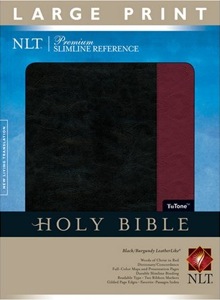
When it comes to natural flow of the English language, it's hard to beat the New Living Translation. In 2004, Tyndale quietly introduced a radical (in my assessment) revision of the NLT, known as the "second edition" (see my review of the NLT for more information). Almost three years had gone by, and I didn't have what I considered to be a decent "public use" copy of the NLT second edition (or NLTse).
Going back to the original NLT first edition (or NLT1) of 1996, I had a nice burgundy bonded leather TouchPoint Bible and later a bonded leather Notemaker's Bible, which as I've said before happens to be one of the nicest wide-margin Bibles I've ever seen. But there's been nothing equivalent to these for the NLTse. The Bible publishing world seems obsessed with thinline/slimline/ultrathin Bibles or study Bibles. It seems that it's getting harder and harder to find a simple text or reference edition of the Bible, in leather, that has not only a readable text size, but also one that's not slimmed down to 3/4 of an inch. And no publisher besides Crossway seems to recognize the value of a wide-margin edition, but unfortunately, they don't publish my translations of choice. So with the NLTse, the only edition I had besides my electronic copy in Accordance, was a blue hardback/pew Bible.
Now, about the actual Bible. I don't consider myself all that picky, but after three years of the NLTse's existence, I still couldn't find a decent copy for public use. However, just last month Tyndale released an edition that, while not perfectly matching my wants/needs, is certainly an attractive edition and will do for now. I've picked up the NLT Premium Slimline Reference (Large Print) in "TuTone" colors of black with a vertical burgundy stripe on the front cover. The binding is called "LeatherLike," and I'll come back to that shortly. You'll find an Amazon.com link to this Bible below, but I cannot find it on Tyndale's site as of this writing. I'll refer to the Bible simply as PSR from this point forward.
Slimline. My main compromise with this Bible is the Slimline factor. I don't care for thin Bibles because the pages tend to be too thin, and will not only wrinkle and wear too quickly, but also have a tendency for bleed through of the Bible's own text and any annotations that a user makes in the margins. The Amazon.com page for this Bible claims that it is 1.1" thick, but I would presume this to be in error; it seems thinner than that. I would have also preferred a single column of text, but the only single-column NLT I know of is the Life Application Study Bible, and that's not what I wanted in a public use Bible.
Text on the page. The box says that the PSR is "large print." Technically, the print size is 9.84 pt. according to a similar offering on Tyndale's site. The type is quite readable and very clear on the page. There is a certain amount of bleed through, but it's not as bad as some other popular Bibles out there. One nice thing about this edition is that even though it's large print, it doesn't say "Large Print" on the binding which is often code for "old person's Bible." Actually, I've preferred larger type in public use Bibles since I was 20 and long before I needed glasses. I've found that when I'm reading in front of an audience, in order to maintain eye contact, I'll need to regularly look away from the page and look at my audience. I found early on that if I used a Bible with small type, it was very easy to lose my place. Therefore, there's always benefit from a large type size (I'd prefer 10 pt. or larger) when teaching or preaching before a group. I suppose another compromise for me personally, is that this Bible contains red letter text for the words of Christ. I'd prefer Bibles not have red letters, but it's hard to find them without it in popular editions. At least the red isn't a glaring bright red; however, I'd have preferred the darker brick-like shade in the sample on the box than the actual pinkish dark red found on the page.
My main complaint about this Bible has to do with how close the inside column of text rests near the binding. It's way too close, and this may be an example of a something that seemed fine in the original proofs but doesn't work in the actual product. The inside margin should be at least 3 or 4 centimeters wider for readability's sake. I'm not exaggerating here when I say that to read from the inner columns of text in this Bible, whether aloud or to yourself, it will take holding it with one hand while the other hand presses the center open. I'm not sure what the continued strain on the binding will do to the spine over a long period of time. And considering the fact that this is not a saddle-stitched Bible, I wonder how well this edition will hold up.
What makes a reference edition a reference edition? To be honest, I'm always on the fence when it comes to cross-references. Extremely large numbers of cross-references don't impress me. I'm not opposed to a cross-reference system, but generally all I need in terms of references are those that point me to intertextual quotations and allusions and those that refer to parallel passages. Many cross-references tend to be thematic in nature and that's not so big of a selling point with me. Since this Bible is called a "Reference" BIble, I was expecting a full cross-reference system. However, that's not the case. Rather, in some verses, there is a † symbol (what is this symbol called?) and a corresponding reference is placed at the end of the paragraph. That's not a bad system in my opinion, but I imagine it would be limited by the space left available at the end of each paragraph. To see the kind of references that are in place in the PSR, I turned to the Gospel of Matthew. There was a † at the end of v. 17: "...and fourteen from the Babylonian exile to the Messiah." This corresponded to a reference to Luke 3:23-38, which is Luke's somewhat different genealogy. Turning the page, I saw another † at the end of Matt 1:24 following, "And Joseph named him Jesus." This led to a reference to Luke 2:1-7, which is part of Luke's account of the birth of Christ.
Then, however, I happened to look up at v. 23:
Look! The virgin will conceive a child!
She will give birth to a son,
and they will call him Immanuel,
which means "God is with us."
There was an asterisk after Immanuel pointing to the textual notes at the bottom of the page which referred to Isa 7:14 the source of the quotation in Mtt. 1:23. Therefore, it looks like the parenthetical references distinguish themselves from the cross references in the textual notes as being more thematic in nature. Turning a couple of pages over, I noticed that in Jesus' Sermon on the Mount, many of the notes cross reference to Luke's so-called "Sermon on the Plain" and other passages with parallel themes. In my opinion between these references and those in the textual notes, this is all someone like myself would really need. Others however may still wish for a more traditional columnar cross-reference system.
The PSR also includes a 52-page dictionary/concordance in the back with entries from abandon to zeal. So Aaron is not included, but Abraham is. In actuality, there aren't many individuals listed here. But an entry such as Abraham takes on more of the "dictionary" aspect to this section as it includes topical information with references to particular passages. A few other helps are included in the Bible such as "Great Chapters of the Bible," "Great Verses of the Bible to Memorize" (three pages' worth), a 365-Day Reading Plan (all Bibles should come with one or more reading plans) and eight full-color Bible maps. And although this isn't a wide-margin Bible, so one can't take notes in the text, I counted 18(!) blank pages between the reading plan and the maps which would be perfect for adding one's own notes.
Is it leather if it doesn't "Moo"? I said above that I prefer leather Bibles for public use. Well, technically, this isn't leather--it's something that Tyndale calls "LeatherLike" and I assume is very similar to the materials in Zondervan's "Italian DuoTone" and Crossway's "TruTone" Bibles. A good leather Bible gets softer over time with continued use. This is caused by the natural oils of your hands which soften a Bible's leather over time (and that's also why putting a Bible in a Bible cover or leaving it on a dashboard where it dries out in the heat is the worst thing you can do for a Bible). Well, this LeatherLook looks and feels like a Bible that's well worn in (first we have pre-faded jeans, and now...). It's soft to the touch and even has a slight leather smell (I wonder if that was artificially added at the factory?). I have no idea how these covers hold up over time, and what they'll look like in a couple of decades or more, but I have to say that they are so nice, I wouldn't mind it if I never bought actual leather again. The cover on this Bible is black with a wide vertical burgundy strip going down the front. It' looks very elegant and makes the Bible look like it cost much more than it did. Using these kinds of artificial materials accomplish a couple of things: (1) no cow has to die for your Bible [I'm not overly opposed to leather, but if you had Bossie right there in front of me and said "Leather or no leather..."] and (2) offers an elegant looking Bible at greatly reduced price. Who knows, if fine wines can move away from actual corks, maybe Bibles can move away from real leather.
TNIV Truth: Habakkuk 1:12 Revisited: The TNIV Angle
Hands On with the HCSB Minister's Bible
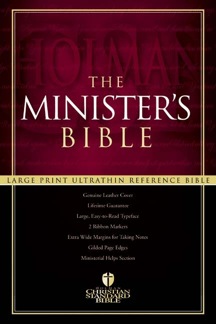
The box cover pictured here describes The Minister's Bible as a single-column/wide margin Bible. I'll go through some of the other features listed on the box and offer a few comments:
Genuine Leather Cover. I'm not certain of the exact grade of genuine leather for this Bible, but it certainly feels like good quality to me. It's a muted black and is quite flexible allowing this Bible to balance nicely, Billy-Graham-style, in one hand. Considering the HCSB Minister's Bible (HMB from this point forward) has a lifetime guarantee, the publisher obviously considers this to be a quality product. I've no doubt that the leather will hold up to the test of time, but I'm not so sure about the actual pages. More on that below.
Large, Easy-to-Read Typeface. Technically the main text uses a 9.8 point typeface. This isn't exactly large print, but it's clear and legible and I can use this Bible in public without my reading glasses, which is always helpful. Also, there's strictly black letters in this Bible. None of that red-letter nonsense.
Two Ribbon Markers. Why doesn't every Bible include two markers? This is quite handy. One is black; the other is red.
Single-Column Format. Any regular reader of this blog knows that a single-column of text is my preferred format in a Bible. The layout here is clean and open and there's no indication of "rushing" the text as in some Bibles to make for fewer pages. There are no cross references to clutter the page and get in the way of note-taking. Textual notes are laid out at the bottom in a smaller typeface.
Extra Wide Margins for Taking Notes. In my opinion, this description is a bit misleading. I imagine the marketing folks simply meant that this Bible's margins are wider than other Bibles. But when I think of a wide margin Bible, I generally see that as a designation of at least an inch of space for note-taking. Therefore, an extra wide margin should be considerably wider--one and a half to two inches perhaps. The one inch margin in this Bible is adequate in most places. There's even much more room for annotations in poetic sections, but longer prose passages, especially in the NT epistles, will leave the person who likes to add notations wishing for more space.
Gilded Page Edges. I liked the shade of gold that was on this Bible when I first bought it. It was a less bright gold color, a bit muted perhaps. However, now after one year's use--and I don't even use it all that regularly--the gold has faded quite a bit. Of course if you want a new Bible that doesn't look new, I suppose this would be a good thing.
Ministerial Helps Section. Perhaps this is one of the HMB's strongest points. In the back of the Bible comes the "minister's manual" with quite a few resources, some of which are actually quite helpful. Here is a list of the features with an occasional comment from myself:
- Pastoral Care: Where to Turn. This is a standard, "When you feel _________, turn to this Bible passage" supposedly for use when counseling those with problems. I suppose this kind of resource is helpful at some level, but really, I hope that most ministers can reference this kind of information off the top of their head.
- "21 Essentials of Authentic Ministry" by James T. Draper. These are helpful reminders from a seasoned pastor and denominational leader. "Never make a decision when you are discouraged or depressed." "Always return your phone calls and answer your mail." "Always be prepared to preach." "Don't flirt with temptation." "Give credit to other people." "When you are wrong, admit it." As the title suggests, there are 21 of these admonitions with explanations. This is probably the kind of wisdom the average pastor should read once a year. I've known some who should read it once a month.
- "Weddings: Guidelines for Premarital Counseling" by Jim Henry. A lot of the wedding/marriage information in the HMB comes from Jim Henry's The Pastor's Wedding Manual (ISBN 0805423133), including these guidelines. Although this information is produced elsewhere, it is still a valuable set of guidelines for what could actually be multiple sessions of premarital counseling with engaged couples.
- Guidelines for Planning Wedding Ceremonies.
- Couples Commitment Form
- "The Kingdom Family Commitment" by Tom Elliff.
- A Classical Wedding Ceremony
- A Contemporary Wedding Ceremony
- "Funerals: When the Death Bell Rings" by Jim Henry. This is handy little resource, primarily for the inexperienced minister on responsibilities and what to do from the beginning of a death notification to the funeral services. It is excerpted from A Minister's Treasury of Funeral and Memorial Messages(ISBN 0805425756) also by Henry.
- Funeral Sermon: "The Teacher Called Death" by Jim Henry. This is the only funeral sermon in the HMB. I suppose it might be handy for extremely short notice.
- "The Invitation or Altar Call" by Roger Willmore
- Commitment Counseling. Topics covered: salvation, baptism, church membership, assurance of salvation, rededication to grow toward spiritual maturity, and commitment to vocational Christian Ministry.
- "The Pastor's Concern for Children" by W. A. Criswell.
- "Reaching Students with the Gospel" by Lynn H. Pryor.
- How to Lean an Effective Parent-Child Dedication Service
- How to Conduct a Worker Commitment Service
- How to Dedicate a Building
- The Christian Year and Church Calendar. I find this interesting because it includes the more traditional calendar dates such as those for the Lenten Season like Ash Wednesday and Maundy Thursday. Obviously, it's primary market for the HMB is Baptist and most Baptist churches do not celebrate the traditional church calendar days--although some do. Intermixed with these dates are specific Southern Baptist dates that are promoted yearly such as Sanctity of Human Life Sunday, Racial Reconciliation Sunday, Citizenship and Religious Liberty Sunday, and World Hunger Sunday among others.
- The Apostles and their History. In my opinion, this is really an odd choice to include with these other items. I really don't know how often in pastoral ministry, a minister will need quick access to a table of facts about the 12 apostles of the Gospels.
- Principles of an Orderly Business Meeting. Unfortunately, this particular guide is only one page long whereas entire books have been written on the subject. I don't know how helpful it will be to have this brief treatment at one's fingertips.
So what are the strengths and weaknesses of the HCSB Minister's Bible? Well, copy on Holman's product page for the HMB describes it as "like having a fine 'preaching Bible' and practical 'minister's manual' in one." And that, of course, is the goal of it. Ministers manuals abound with specific manuals on weddings, funerals, and the like. But anytime I've had to officiate a formal occasion like a wedding or a funeral, I've usually taken my text and affixed to the center of a nice-looking, black leather Bible. I'm sure that lots of folks who don't know better assume that there's some chapter in the middle of the Bible that contains wedding vows. Obviously, this is not the case. The HMB would theoretically allow a person to use one Bible for teaching, preaching, and administering the great services of life. It's a great idea, but it falls short in some areas.
For teaching and preaching. As far as having a nice looking black leather Bible, with a single-column format with clear and readable text, the HMB can't be beat. However, my greatest complaint in this category is its thin pages. While not exactly a thinline Bible, the HMB has well over 1800 pages and yet is only 1.55" thick! To create a Bible with so much content and yet to keep it so thin, Holman had to use incredibly thin paper. In fact, this has to be some of the thinnest paper I've yet to see in a Bible (and I've seen lots of Bibles!). Bleed through is a problem not only with the text, but also with any notes written in the margins. Even ink from Pigma Micron pens which are generally perfect for writing in Bibles shows through the page. Even worse, the pages are so thin that they have a tendency to curl when written upon or even when laid open to a passage for long enough time. If the Bible is closed long enough this curling will eventually go away, but it can be very distracting while trying to stay focused on a particular passage. Further, it makes it very easy to accidently fold the corners of pages, and afterwards, even if they are straightened out, any passages where you've spent a good amount of time will have a slightly worn look to them. Thicker paper would have gone quite a way to making this an excellent note-taking Bible. As an aside, for HCSB aficionados, this is the ONLY wide-margin Bible available in this version as of this writing.
For funerals, weddings, and other services. In regard to funerals, a minister will be better served by obtaining one or two good funeral manuals. It's no secret that ministers don't always create funeral messages from scratch. Often there's very little advance notice for such an occasion. However, a skillful minister can take a generic funeral message and personalize it based on his knowledge of the deceased. And therefore, having access to a variety of these kinds of messages is helpful as a minister might officiate a number of services in any year's time based on a church's population. Therefore, the inclusion of simply one message (although it is a very good message) in the HMB is not going to be all that helpful in the long run.
I used the HMB when I officiated my friend Andrew's funeral last year. But I did not use the sermon included in the Bible. And because of the nature of the accommodations of the funeral home, I was able to take the text of my message in a binder, and the HMB made a very nice Bible with readable type for use in that kind of setting (although in hindsight, Andrew was traditional enough in some areas that he might've preferred the KJV). However, when it came to the graveside service, I found myself using the old trick of paperclipping my text into the middle of the Bible.
So perhaps here is where the HMB could be improved. Graveside services tend to be very short and basic. Why not include a handful of different graveside services in a resource like this? I believe that would be more helpful than one token sermon.
On the other hand, the two wedding services included in the HMB are very good selections. The classical service has the very traditional "I plight thee my troth" and "With this ring I thee wed, and with all my worldly goods I thee endow." But at the same time, the contemporary service has more up-to-date language: "I promise to honor you, to love you, and to cherish you until death do us part." Although it would still be beneficial to have a full wedding manual with a variety of services to choose from, the two included in the HMB would probably serve the majority of services in which the minister would be engaged (no pun intended).
On Saturday, I performed a wedding service for a former student of mine, and I used the HMB and the contemporary wedding service found in it. Overall, the experience was good, and the contemporary service served the needs of the day well. I didn't stick to the outline in the HMB 100%, but I did stay pretty close to it so as not to add any unnecessary bloopers to the wedding video. In that regard, the HMB was very helpful.
At the same time, after utilizing the HMB in actual use during a wedding, I would offer some suggestions for improvement, and in fact, I wonder how well this product was field tested. First, one of my biggest complaints of this Bible from the beginning is that all of these minister's helps are placed in the back. Think about that for a minute. This is an 1800+ page resource, and all of the primary resources are in the last 10% or so of it. What that means is that for public use, the minister will be turned to the very back of the Bible for the entire time. Not only would it look better to an audience to work from somewhere more in the middle, but there's also a practical issue regarding the way the Bible is weighted. If you've ever been in a wedding in any role, you know that standing in front of the church, having to remain perfectly still for possibly an hour or more can be grueling. Now think about the minister for a moment. When I teach or preach, I can move around and pace and stay reasonably active. However, in a wedding service like the one on Saturday, I had to remain perfectly still for well over 40 minutes with my Bible held out before me in my bent arms--no podium. You might think it's not big deal to hold a Bible out in front of yourself, but try it for 40 minutes, and be sure to keep your feet perfectly planted in one position since you've already been informed by the videographer that if you move your left foot off the tape on the floor, you won't be seen in the video. This can be extremely tiring. As we got further along in the service, the fact that I had my Bible opened to around p. 1690 and following gave me a real concern that in a moment of inattention, it could simply fall out of my hand because the weight was so lopsided.
The very simple solution here would be to simply move all the ministerial helps to a section between the Old and New Testaments. Obviously, that's not going to be the direct center of the Bible, but it would help balance the Bible a bit better when using it, especially in formal settings. This seems like a no-brainer after actually using the HMB as it was intended, and this is why I wonder how well it was field tested. I certainly can't imagine anyone suggesting that such placement might confuse some into thinking this material is actually scripture.
Another issue I had during the service was the placement of text on the page. This wasn't an issue when I sat at my desk the day before and read through everything out loud. However, holding the Bible in front of myself, reading from the text, while at the same time attempting to keep good eye contact became a challenge with the text that was at the bottom of the page. Part of the vows and the dedication of marriage itself was right at the bottom which created more of a strain as I tried to look all the way down to the bottom of the page and maintain frequent eye contact. A better solution might be to keep the bottom third to half blank with the service itself in the top portion of the page. This would allow for any post-it notes for reminders or penciled-in information. As it was, I had a tiny order of service for the entire wedding posted to the page facing the first part of the contemporary service. And I had frequent notes throughout in pencil. A spot at the bottom of the page to write some of this would certainly be helpful.
Final thoughts. Ultimately the HMB may suffer from trying to be too many things at once. It's not the greatest Bible for teaching and preaching for the person who wants to write notes because of the thinness of it's paper. And the ministerial helps ultimately seem more representative of a minister's manual than a final solution. These resources are not going to replace the need for one or more good pastoral manuals.
Nevertheless, the idea itself is a good one. Perhaps rather than trying to include all the information found in the HMB, the publishers could concentrate on specific services such as weddings, funerals and dedications. Yesterday, at our church we had a baby dedication. I noticed that our pastor read the charge to the parents and the church from a single sheet of paper. Now, there's certainly nothing wrong with that, and our service went fine. But I thought to myself that there's an almost exact same service and words included in the HMB. Maybe it's just me, but there seems to be something authoritative about holding a Bible--or at least a black leather book--when conducting formal services such as these. To me, this would be the ideal use of a Bible such as this. And it wouldn't hurt to have it in other translations as well. Note: Hendrickson publishes a number of Minister's Bibles in the KJV, NKJV, and NASB, but I don't believe they cover quite the same content. I've heard rumors that Holman might release the Minister's Bible in another translation, perhaps the NKJV. I ran a search on Zondervan's website and found a similar minister's Bible in Spanish, but not English!?
Another idea might be to have a 1000+ page minister's manual covered in black leather with multiple wedding and funeral sermons, dedication services, and other ministerial helps such as the ones found in the HMB. Such a resource might even have room for the New Testament and Psalms to be included as well.
I'll continue to use my HMB now and then, but it's not the primary Bible that I thought it would be when I got it 15 months ago. Nevertheless, it's a useful, although flawed resource. Now if I could just get something like this in the TNIV...
Habakkuk 1:12--You or We?
I've seen you talk about both the NASB and the TNIV, both of which Ihave and I like both of them a lot. In my dialogues with Jewishpeople, they have asked me about Habakkuk 1:12 and I know that it istranslated differently depending on which translation you read from.I was wondering why certain translations use the Masoretic textversion and others don't.
This is a good question, and frankly, a difference in versions that I'd never noticed. To demonstrate the difference, consider the two translations mentioned above:
NASB |
TNIV |
Are You not from everlasting, [no note] |
LORD, are you not from everlasting? *An ancient Hebrew scribal tradition; Masoretic Text we. |
The TNIV makes a break with the Masoretic Text ([MT] the Hebrew clearly says we as does the Septuagint [LXX]!). The question is, Who or what is this ancient scribal tradition? At the time I received this email, I was away from the library, and didn't have the resources to look at the issue in depth. Of course I always have Accordance with me, but I've purposefully chosen at this point not to purchase commentary modules, so I was strictly dependent upon whatever reference resources I could find. Regarding the issue in Hab 1:12, I found two mentions.
First, I found a reference to the you/we issue in Hab 1:12 in the Anchor Bible Dictionary, in the context of an article on "Euphemism and Dysphemism in the Bible" by Marvin H. Pope. Pope makes no reservation in regard to his feelings on the correct reading: "In Hab 1:12, the assurance to God “You will not die” was changed to the patently absurd “We will not die,” to avoid even the thought that God could die."
Another resource I had in Accordance was the NET Bible, which is quickly becoming a first stop resource in regard to textual issues. The note in the NET for this verse states,
The MT reads, “we will not die,” but an ancient scribal tradition has “you [i.e., God] will not die.” This is preferred as a more difficult reading that can explain the rise of the other variant. Later scribes who copied the manuscripts did not want to associate the idea of death with God in any way, so they softened the statement to refer to humanity.
Okay, so the reason behind the change begins to make sense. This becomes a similar issue to "curse" being changed to "bless" in Job 2:9 (the Hebrew of the MT says "bless" (barekh), but nearly all translations render the word "cursed" based on context and the assumption that the original reading was changed by scribes who didn't want to associate cursing with God in the scriptures).
But the question remained: Who is this ancient scribal source?
I consulted a handful of commentaries today, and the most succinct explanation comes from Ralph Smith in the Word Biblical Commentary:
lo’ namut "we shall not die" is one of eighteen passages in the OT called tiqqune soferim "corrections of the Scribes" by the Masoretes. The scribes were supposedly to have corrected the original reading. The original reading of this passage was probably lo’ tamut "you shall not die" referring to God. Even though there is no manuscript or version support for tamut it is probably the best reading.
A number of commentaries with discussions on this issue recommended these sources for further study:
- J. Weingreen, Introduction to Critical Study of the Hebrew Bible, 25-29
- E. Wurthwein, The Text of the Old Testament, 18-19
- C. D. Ginsburg, Introduction to the Massoretico-Critical Edition of the Hebrew Bible, 358
- E. R. Brotzman, Old Testament Textual Criticism, 117-118
There's another question here, though, isn't there? It's a canonical question. What exactly should be considered the final form? How significant is it that both the MT and the LXX agrees on the alteration to "we"? There are no manuscripts with "you" in the text for Hab 1:12. So, what forms the basis of the canon? Our English Old Testaments are primarily based on the MT, in spite of the fact that the NT writers quoted primarily from the LXX. Is the Canon based on the MT? Is it to be based on the LXX (the Orthodox Church takes this position). Is it the MT checked by the LXX and the Dead Sea Scrolls (DSS) and perhaps even other sources?
I believe it's the last option. And in defense of that, we should remember that modern New Testaments are based on what's called an eclectic text, that is a source that attempts to reproduce the oldest and best (i.e. original) readings, based on manuscript evidence and the methods of textual criticism, and in spite of the fact that no Greek manuscript will completely reproduce the exact same wording entirely. Nevertheless, our English Old Testaments tend to be based on the Masoretic Text, an AD 11th Century document (that's AD, not BC). I've said it before and I will say again: we need an eclectic Old Testament text to form the basis of our English translations.
Recent translations such as the NRSV, NLT, NET, HCSB, ESV, TNIV and others use the LXX and DSS to "correct" the MT in places. How long will it be before we see a true critical edition that incorporates these alternatives into the text?
For point of reference, here are how some other translations treat Hab 1:12:
“Are you not from everlasting,
O LORD my God, my Holy One?
We shall not die.
O LORD, you have ordained them as a judgment,
and you, O Rock, have established them for reproof.”
[no note] (ESV)
“Are You not from eternity, Yahweh my God?
My Holy One, You* will not die.
LORD, You appointed them to execute judgment;
my Rock, You destined them to punish us.”
*Alt Hb tradition reads we (HCSB)
“GOD, you’re from eternity, aren’t you?
Holy God, we aren’t going to die, are we?
GOD, you chose Babylonians for your judgment work?
Rock-Solid God, you gave them the job of discipline?”
[no note} (The Message)
“LORD, you have been active from ancient times;
my sovereign God, you are immortal.
LORD, you have made them your instrument of judgment.
Protector, you have appointed them as your instrument of punishment.”
[note already quoted] (NET)
“O LORD, are you not from everlasting?
My God, my Holy One, we will not die.
O LORD, you have appointed them to execute judgment;
O Rock, you have ordained them to punish.”
[no note] (NIV)
O LORD my God, my Holy One, you who are eternal—
surely you do not plan to wipe us out?
O LORD, our Rock, you have sent these Babylonians to correct us,
to punish us for our many sins.
[no note, but is this an attempt to incorporate both traditions?] (NLTse)
Are you not from of old,
O LORD my God, my Holy One?
You* shall not die.
O LORD, you have marked them for judgment;
and you, O Rock, have established them for punishment.
[*You — Ancient Heb tradition: MT We] (NRSV)
Lord, are you not from ancient times my God and Holy One, who is immortal?*
Lord, you have appointed them to execute judgement;
my Rock, you have commissioned them to punish.
[prob. original rdg; altered in Heb. to we shall not die. (REB)
New Living Translation in Spanish (Nueva Traducción Viviente) Coming in 2009

Tyndale Español, the Spanish publishing division of Tyndale House Publishers, announces the launch of a new Spanish translation of the Bible—the Nueva Traducción Viviente (NTV). This Spanish counterpart to the New Living Translation (NLT) is being developed by Tyndale Español in partnership with the Luis Palau Association and the Spanish publishing house Editorial Unilit. The Spanish language is considered to be the third most spoken language in the world, and the intent is for the NTV to have the same ministry impact in the Spanish-speaking world that the NLT has in the English-speaking world.
The Nueva Traducción Viviente (NTV) is an entirely new translation of the Bible with roots in the original Hebrew and Greek texts and the style and dynamic approach of the NLT. Phase One of the NTV project was the creation of a Spanish translation from the English NLT and the original Hebrew and Greek texts. The translation went through a rigorous theological, grammatical, and stylistic review under the supervision of Jaime Mirón, Bible Project Director, from the Luis Palau Association in Portland, Oregon. In Phase Two, now in process, the NTV is undergoing an additional theological, linguistic, and stylistic review with emphasis on the original Hebrew and Greek texts. The NTV development is being overseen by Andres Schwartz, Publishing Director of Tyndale Español, and Dan Elliott, Editorial Director of Tyndale House Publishers. Tyndale Español is also working with Melvin Rivera, president of Intermaná, on various projects supporting the release of the NTV. Intermaná is a consulting organization headquartered in Pembroke Pines, Florida, providing global services to reach the Latin world.
See also Tyndale Español.
TNIV Truth: New TNIV.com Preview
Review: ESV Single Column Reference Bible
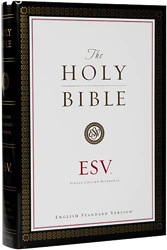
The SCR is one of a number of new editions of the ESV from Crossway that incorporates a text with minor updating from the original 2001 edition. The first text to incorporate the updated text was the ESV Reverse Interlinear released late in 2006. An updated text including the Old Testament was released earlier this year. Disappointingly, the publishers (or perhaps the translation committee) have chosen not to release a list of changes between the two editions. Of course that doesn't stop one from hunting or the changes the old fashioned way, simply by comparing texts. Last year, I released a short list of changes in the New Testament I had discovered between the 2001 and 2006 editions. As a student of translations and translation history, this kind of issue interests me very much. In the upcoming days or weeks, look for a post with any additional changes in the ESV OT that I may find.
Frequent visitors to This Lamp know that I have a fondness for wide-margin Bibles. I have a NASB wide-margin Bible in which I still add notes and reflections even to this day. And it used to be helpful as a teaching Bible--having my notes so handy--until I became convicted that the NASB was no longer the best Bible from which to teach. Nevertheless, I recommend to my own students and to friends and church members who ask that they buy a wide-margin Bible so that they might truly interact with God's Word in a physical way, a literally tangible way.
Unfortunately, of all the major 21st century Bible versions (ESV, The Message, NET, NLTse, HCSB, TNIV), only the ESV offers a truly usable wide-margin Bible--and they actually offer more than one. In addition to the SCR discussed here, Crossway also offers an edition called "The Wide Margin Refefence Bible," as well as their Journaling Bibles and Deluxe Reference Bibles, all of which have a wider marging to some degree for note-taking. [Yes, Holman publishes an HCSB Ministers Bible with wide-margins, but the pages are so thin that they curl, and bleed-through is a problem, regardless of what kind of pens are used. The TNIV is available in a "squared" edition, but not only is it a thinline (not ideal for note-taking), but it is in two columns of text, and the wide margin only gives the note-taker access to the outer column of text; so this too is unusable for serious note-taking. For a brief time, Tyndale offered what was one of the best wide-margin Bible formats I've ever seen in its Notemakers Bible, but this is not only out of print, but was only available in the NLT1. There are no wide-margin offerings at all in the NLTse--not even poor ones.]
Nevertheless, Crossway really seems to get wide-margin Bibles unlike any other publisher I've seen. I've heard from three different Bible publishers that wide-margin Bibles simply do not sell well. That may be, but it's your teachers, preachers, and serious students of the Bible who will most likely use and benefit from a wide-margin Bible. And these are the folks that often influence what Bibles--especially Bible translations--that other believers use. And while it may be anecdotal evidence, my survey of wide-margin Bibles that I posted last year remains my #1 referenced webpage on This Lamp, receiving google hits everyday. Look for this survey to be updated in the near-future.
Crossway not only seems to understand the above particular value of a wide-margin Bible (as evidenced by their varied editions of wide-margin Bibles), they also understand how a note-taker can use available space to the best advantage when taking notes. This is certainly made clear in the Single-Column Reference Bible.
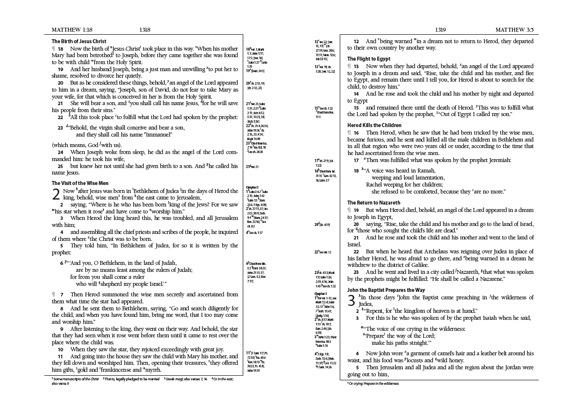
Click on the above image to access Crossway's PDF sample of the ESV Single Column Reference Bible.
First, although made obvious by the title, this Bible has a single-column, which in my opinion is the best format for not only reading, but also note-taking. Serious note-takers love to see white space because we don't merely see an area without text, we see potential space for our notes. And with a single-column, we get bonus space in poetic and narrative passages (especially those with dialogue). According to the cardboard sleeve that came with the Bible, the SCR comes with 1 1/4" (the website says 1 1/8" but I don't have a ruler handy to know which is correct) of space in the outer margins for notes. While this isn't the widest amount of space available across the spectrum of all wide-margins out there, it is indeed a reasonable amount, and more space than some (such as the HCSB Minister's Bible).
What may seem at first to be an odd choice in modern Bibles, the SCR forgoes paragraph format for an older style of verse-by-verse layout. I've even seen this aspect of the SCR criticized elsewhere, but I have to think that this choice was purposeful. Yes, in general, I'd say that paragraphed formatting is better so that one reads any particular verse in a greater context. Verses taken by themselves often have a potential to be exegetically misused. However, for anyone with the intelligence to pay attention to the paragraph marks included with the text, this shouldn't be a problem. And as I said, I believe that such a formatting decision must have been purposeful because anyone who has ever taken notes in a Bible such as the classic NASB single-column reference Bibles knows that a verse-by-verse format allows for even more room to write, and it allows the brief note or two (as space allows) to be nestled in the absolute closest proximity to the text.
The SCR includes cross references (thus it's designation as a reference Bible). In my opinion a Bible for note-taking doesn't necessarily have to have a cross-reference system, but in the SCR, the publishers did something with the cross references that I've suggested for years--they moved them to the inside of the text rather than placing them at the outer margins. In my NASB that I use to take notes, one distracting aspect is the gulf between the text and my notes created by the cross reference system placed outside the text. The ESV SCR eliminates this problem by moving the cross reference system entirely to the inside margin. Again, this is evidence that the creators of this edition seriously thought through the note-taking process. Further, on those pages where the cross references are sparse, the reader gains even more space for notes!
My nitpicks with this edition are extremely minor. The typesize (10 pt.) could be slightly larger in my opinion, although obviously that would mean enlarging the dimensions of the page size (6.5" x 9.25") a bit. Of course, maybe this is just me as I've had to resort to reading glasses in the last couple of years for which I blame too many books and too many hours at computer screens. Nevertheless with the typesize at 10 pt., this is certainly not a small print Bible, and does not receive the criticism I gave the ESV Journaling Bible a while back. Also, the thin lines in place primarily for aesthetic reasons on the top, bottom and inner margins might bother some who want to take notes even in these places, especially if that person has a tendency to draw lines from notes to certain words or phrases like I do.
The ESV Single Column Reference Bible also comes with the standard brief book introductions, concordance and full-color maps that one would expect. At almost 1800 pages, the text is not rushed, but thankfully at 1.7" thick, it's not a thinline either. In reality, this is a serious note-taker's Bible. For the ESV aficionado who wants to directly interact with the text, this is surely the Bible of choice.
Herod's Tomb Discovered at Herodium
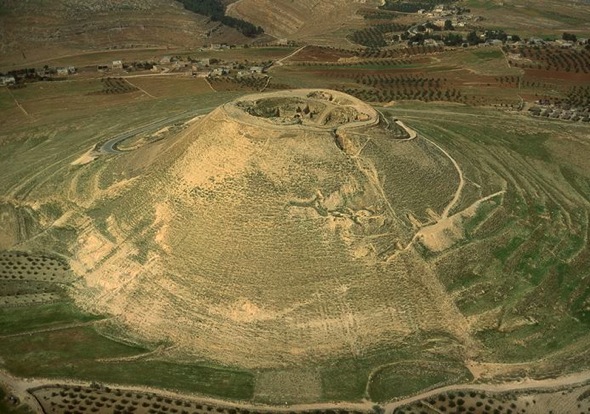
Image above from the Accordance Bible Lands PhotoGuide 2.0. The Fortress at Herodium was built atop a hill and surrounded with huge quantities of earth, creating an artificial cone-shaped mountain.
Most of you who are interested in these kinds of things have probably already seen this. But in case you missed it, here's the nutshell from Ynetnews.com:
King Herod's tomb discovered, Israeli university says
Hebrew University announces discovery of Roman king's tomb at Herodium near Jerusalem
Reuters
Published: 05.08.07, 00:50 / Israel News
The Hebrew University of Jerusalem announced on Monday the discovery of the grave and tomb of Herod the Great, the Roman empire's "King of the Jews" in ancient Judea.
The University said in a brief statement the discovery was made at Herodium, where Herod's hilltop fortress palace once stood some 7 miles from Jerusalem.
The university said it would give further details at a news conference on Tuesday.
The Roman Senate appointed Herod "King of the Jews" in approximately 40 BCE. He was also well-known for the magnificent structures built at his behest. In addition to the Herodium fortress, he was responsible for the building of Masada and the expansion of the Second Temple in Jerusalem.
He also created new cities such as Caesaria and Herodion. According to the ancient Jewish historian Falavius Josephus, Herod died in 4 BCE.
Herod is mentioned in Christian tradition, as well as Jewish tradition: The Gospel of Matthew says heordered the "Massacre of the Innocents", the killing of all young male children in Jesus' birthplace of Bethlehem out of fear he would lose his throne to a new "King of the Jews", whose birth had been related to him by the Magi.
According to Matthew, Joseph and Mary fled with baby Jesus to Egypt to escape the slaughter.
Lilach Shoval contributed to this article.
Another image from the Bible Lands PhotoGuide:
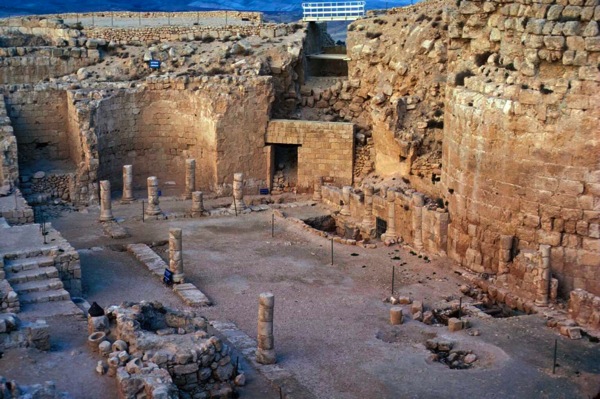
The entrance to the mountain fortress at Herodium. The mountain fortress at Herodium was approached by an imposing series of steps leading up the northeast slope. These gave access to the gate seen here.
TNIV Truth: Two New Scholarly Endorsements
Industry Insider: Bible Translation Rankings Are Faulty
Well despite the fact that we don't get the full picture, the reality of the system in place for CBA stores is even worse.
This morning, I received an email from an industry insider who asked to remain anonymous, but agreed to let me summarize/paraphrase the content of the email.
According to this person--who has been tracking Bible sales for four years--ECPA/STATS figures, which are reported by the CBA, has been having problems with their Bible market share numbers for quite some time. A number of publishers, including the "market leader," have complained for a while now that the numbers simply don't add up to their own calculations--something my emailer confirmed since this person has been tracking these numbers for some time, too.
And my emailer also told me that even if the numbers were correct, the rankings would still be deceptive because two of the Bible market's bestsellers, the Nelson Million Bible Challenge [$1] and the ESV Outreach NT [50¢] are sold primarily based on price and not translation choice. Bibles such as these serve to skew the rankings based on the way the current system works. Evidently, if these two products were eliminated from the stats OR if rankings were based in pure dollar sells, the top ten list would look quite different.
This same person told me that a better system of ranking is coming soon. Stay tuned because I'll let you know more about it as soon as I'm able.
Bible Translation Awareness Survey Results

This was actually the third week I'd carried the survey with me as I was waiting for an ideal representation of our roll to respond. Yesterday we had 35 class members in attendance, no visitors, and about 10 of our regular attenders were absent. I handed out 35 surveys, but only got back 26. We are in a Southern Baptist church, and our class uses Southern Baptist curriculum.
Here is how I introduced the survey on the form I handed out to everyone:
Augustine said that it was profitable to study the Bible with parallel translations. On any given Sunday morning, there are multiple translations of the Bible represented in our Quest Bible Study—and that’s a good thing! This survey will help your teacher in his preparation by knowing what translations are in use in the class by what percentages of learners. Also, it will help him gauge your awareness of translations. Please answer the questions as honestly as possible.
Here are the results of the survey:
Q1. What translation of the Bible are you using this morning? [I had a list of translations to choose from including an option for other and an option for the Sunday School quarterly instead of a Bible]
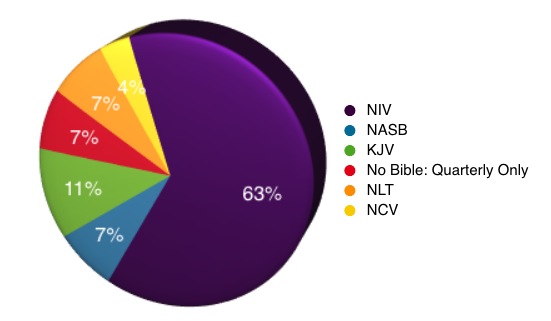
- 2 said they didn't bring a Bible, but were using a quarterly. This means they had access to the HCSB and KJV.
- 17 members were using the NIV. Our pastor preaches from the NIV, and of course, the NIV is the most popular translation in the US, so it no surprise that almost 2/3 of the class were using this version.
- 3 were using the KJV.
- 2 were using the NASB.
- 2 were using the NLT (I didn't specify which edition in the survey).
- We had one person respond saying he was using the NCV. I know of one other person in the class who uses the NCV, but he wasn't there today.
Q2. Did you know what translation you were using, or did you have to look at your Bible to double-check? [This was my awareness test. Assuming they answered truthfully, more folks are aware of their translation than what I would have imagined.]
Twenty-two answered "I knew"; three answered "I had to double-check."
Q3. What translation of the Bible does your teacher use? Don't guess. If you don't know, write, "I don't know."
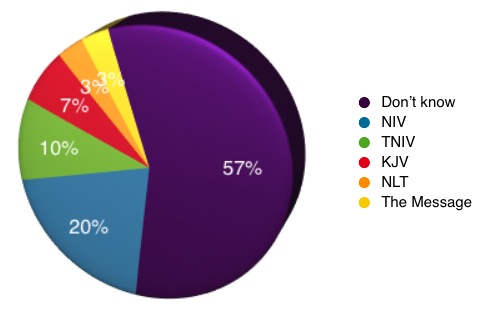
- 15 respondents said they didn't know what translation I was using.
- 6 said that I was using the NIV.
- 3 said I was using the TNIV.
- 2 guessed I was using the KJV!
- 1 suggested the NLT
- 1 thought I was using the Message.
The correct answer is that I use the TNIV. When we started the class last March with less than a dozen members, I was teaching from the HCSB because it is the primary translation in the Sunday School quarterly. However, last fall while teaching through Hebrews, I switched to the TNIV, so I've been using that for about six months. I did use the Message one time a few weeks ago to read through an extended passage in Esther. I mentioned that I was reading from that version, and that name must've stuck with someone. I have never and would never use the KJV to teach a regular Sunday School class. I've used the KJV occasionally in other venues, especially when speaking to senior adults.
I mention now and then that I am reading from the TNIV, but I don't make a big deal out of it.
Q4. When you study your Bible at home, do you ever use another translation? If so, list what you would consider your primary translation, and what you would consider any secondary translation(s). If you never study your Bible at home, simply write, “I never study my Bible at home” (this survey IS anonymous!).
One person admitted that no Bible study ever takes place at home. Here are the rest of the results:
Primary translations:
- NIV: 17
- NLT: 2
- KJV: 2
- NASB: 1
Secondary translations:
- KJV: 6
- NIV: 2
- NASB: 2
- HCSB 1
- NCV: 1
- NKJV: 1
- Amplified: 1
- Phillips NT: 1
Q5. If you lost your main Bible and had to buy a new one this week, would you buy the same translation you checked in question #1 or would you get a different one? If you would get a different one, what would it be?
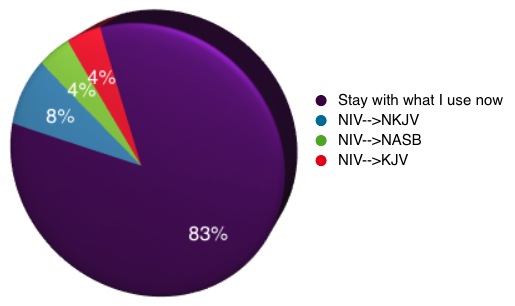
- 20 of those surveyed said that if they had to replace their Bibles, they would stick with the translation they currently use.
- Two said they would switch from the NIV to the NKJV.
- One indicated a switch from the NIV to the NASB.
- One said a switch from the NIV to KJV would take place.
Again, for anyone else, these results are simply anecdotal. But the majority of my class using the NIV reflects national trends. Further, if there're any broader implications to be drawn, question #5 would indicate that people don't change translations very often or very easily. Most importantly, my choice to teach from the TNIV is a good one with most of the class' members reading from the NIV. They can follow easily enough when I read from the TNIV as there is much continuity from their version, but at the same time the TNIV offers a more accurate and up-to-date option over the NIV.
One last thought... to my knowledge, there's been no recent class at our church about the history of English translations and the differences between them. I wonder if any of the questions would be answered differently if such a discussion took place prior to such a survey?
Link: Bible Translation Awareness Survey
May CBA Top Selling Bible Translation Lists Posted
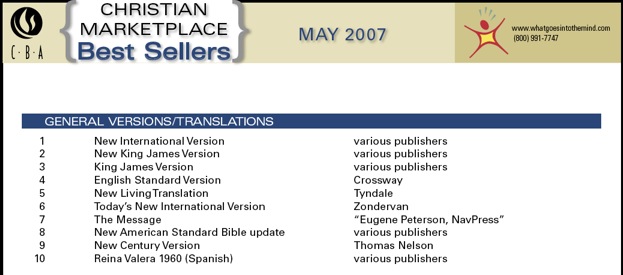
Of note: the NIV is back on top after a 3rd place showing below the KJV and NKJV last month. The ESV is now at #4, pushing the NLT down to #5. The TNIV is up to #6 from #10 last month. The HCSB remains nowhere to be seen for yet another month.
GUEST REVIEW: The New Oxford Annotated Study Bible (3rd Edition)
Below is a guest review from This Lamp reader, "Larry."
The Benchmark: the New Oxford Annotated Study Bible (3rd Augmented Edition)
A recent post by Rick described the debate in Muscogee County, Georgia over which translation to use in a public high school Bible class. The superintendent of the school was described as leaning towards the New King James Version – an odd choice for a secular setting, an odd choice for a setting desiring the latest scholarship, an odd choice for a high school class. But imagine that you were designing a college course to be taught in a secular school on the Bible. Which version would you use?
The New Oxford Annotated Study Bible (NOAB) aims to fulfill this role by being (as declared on the cover) an “ecumenical study Bible.” (An unfortunately ambiguous phrase – the Bible does not advocate ecumenicism, but rather is meant to be used equally by the various Protestant, Catholic, other Christian, and even in Hebrew Scriptures, by Jewish readers.) It includes not only annotations and book introductions, but a variety of helps (brief essays, maps, and glossary) appropriate to an academic audience. Although it is printed on bible paper and has rather better binding than a typical textbook, this book otherwise screams I am a college textbook in one’s hand. And as such, it was wildly successful, quickly becoming the standard text for academic Bible classes. And it became something of a standard reference for those interested in academic-style self study.
But does the NOAB deserve this praise? This pioneer has come under attack from all directions: there are a variety of new, more heavily annotated study Bibles available; it has been attacked for a leftward turn in its most recent editions; and it no longer seem as ubiquitous as it once was. What has happened to the NOAB? This review will explore the most recent edition, the Third Augmented, of the New Oxford Annotated Bible.
Acronyms
This is the second of my reviews of academic (and a few faith-oriented) study Bibles. Here is a brief list of versions I plan to cover together with acronyms I use.
JSB: Jewish Study Bible (Oxford 2004) [NJPS]
NOAB: New Oxford Annotated Study Bible (3rd Augmented Edition) (Oxford 2007) [NRSV]
NISB: New Interpreter’s Study Bible (Abingdon 2003) [NRSV]
HSB: HarperCollins Study Bible (2nd edition) (Harper San Francisco 2006) [NRSV]
CSB: Catholic Study Bible (2nd edition) (Oxford 2006) [NAB]
OSB: Oxford Study Bible (Oxford 1992) [REB]
WSP: Writings of St. Paul (2nd edition) (Norton 2007) [TNIV]
ECR: Early Christian Reader (Hendrickson 2004) [NRSV]
TSB: TNIV Study Bible (Zondervan 2006) [TNIV]
OSBNT: Orthodox Study Bible: New Testament and Psalms (Conciliar Press Edition) (Conciliar Press 1997) [NKJV]
Readers may want to look back at my first review in which I discussed the framework for analysis and specifically mentioned that I find the terms “liberal” and “conservative” unhelpful and ambiguous when evaluating study Bibles.
An overview of the NOAB
The New Oxford Annotated Study Bible, 3rd Augmented Edition
Michael Coogan, editor
Marc Z. Brettler, Carol A. Newsom, Pheme Perkins, Associate Editors
Translation: New Revised Standard Version
Hebrew Scriptures: yes
Deuterocanon: yes
Christian Scriptures: yes
Current Amazon price: $28.35
xxvii + 1375 Hebrew Bible + 383 Apocrypha +640 New Testament & extras + 2181 + 32 map pages
Extras:
Medium length introduction to books and major sections
60 black and white diagrams and maps
32 page color map section, with 14 large color maps.
Listing of biblical canons
Index and map index
Hebrew calendar discussion
Timeline (Egypt/Israel/Syria-Palestine/Mesopotamia)
Chronology of rulers in Egypt/Assyria/Syria/Babylonia/Persia/Roman Empire/Israel
Table of weights and measures
Listing of parallel texts (synoptic passages) in the Hebrew Scriptures, Apocrypha, and New Testament
Glossary of terms (15 pages)
Bibliography of translations of primary sources
Concordance (66 pages)
72 pages of additional essays
The editors of the volume are
- Michael Coogan (Stonehill Coll.) a former faculty member at Harvard, Michael Coogan for many years served as the director of the Semitic Museum’s publication program. He still maintains a relationship with Harvard Museum. He is well known as a biblical archaeologist. He was involved as a critical reviewer of both the 1991 and 1999 editions of the Catholic New American Bible (whose translation team includes some Protestant scholars.)
- Marc Zvi Brettler (Brandeis) who holds a named chair and chairs the Department of Near Eastern and Judaic Studies. He was co-editor of the JSB, the author of a major textbook on Biblical Hebrew, and is well known for his teaching, which is reflected in a very nice volume he wrote called How to Read the Bible. He is a strong advocate of what he calls “Jewish sensitive” readings of the Bible.
- Carol Newsom (Emory) a faculty member at the Candler School of Theology, the author of several commentaries on Job, and co-editor of the Women’s Bible Commentary. She also actively participates in the Episcopalian Church USA.
- Pheme Perkins (Boston Coll.) is best known for her work in early Christianity. She is a former president of the Catholic Bible Association and is also active in the Society for Biblical Literature.
Notes on the NRSV translation
The NOAB, like many leading academic study Bibles (HSB, NISB, ECR) uses the NRSV translation – a translation that is probably familiar to most of the readers of this blog. The NRSV is popular because it is a moderately formal translation, has the widest degree of acceptability among different denominations, is derived from the dominant strand of English Bible translations (the Tyndale/KJV tradition), and includes the Catholic and Orthodox deuterocanon/apocrypha. The translation is strikingly different in how it treats the Hebrew and Christian Scriptures – the Hebrew Scriptures are translated into more formal language than the Christian Scriptures, reflecting their different source material. The translators explain,
The NRSV also attempts, particularly in the Christian portions, to use inclusive language when context dictates that was the original meaning in the Greek. The translators explain,“Another aspect of style will be detected by readers who compare the more stately English rendering of the Old Testament with the less formal rendering adopted for the New Testament. For example, the traditional distinction between shall and will in English has been retained in the Old Testament as appropriate in rendering a document that embodies what may be termed the classic form of Hebrew, while in the New Testament the abandonment of such distinctions in the usage of the future tense in English reflects the more colloquial nature of the koine Greek used by most New Testament authors except when they are quoting the Old Testament.”
“Paraphrastic renderings have been adopted only sparingly, and then chiefly to compensate for a deficiency in the English language—the lack of a common gender third person singular pronoun. . . . The mandates from the Division [of Education and Ministry of the sponsoring organization, the National Council of Churches] specified that, in references to men and women, masculine-oriented language should be eliminated as far as this can be done without altering passages that reflect the historical situation of ancient patriarchal culture. As can be appreciated, more than once the Committee found that the several mandates stood in tension and even in conflict. The various concerns had to be balanced case by case in order to provide a faithful and acceptable rendering without using contrived English. Only very occasionally has the pronoun “he” or “him” been retained in passages where the reference may have been to a woman as well as to a man; for example, in several legal texts in Leviticus and Deuteronomy. In such instances of formal, legal language, the options of either putting the passage in the plural or of introducing additional nouns to avoid masculine pronouns in English seemed to the Committee to obscure the historic structure and literary character of the original. In the vast majority of cases, however, inclusiveness has been attained by simple rephrasing or by introducing plural forms when this does not distort the meaning of the passage. Of course, in narrative and in parable no attempt was made to generalize the sex of individual persons.”
In part because of this practice, a number of traditionalists prefer the use of the NRSV’s predecessor, the RSV – and Oxford has accordingly kept older editions of the New Oxford Annotated Bible based on the RSV in print.
Publication History of the NOAB
The NOAB is the latest in a long line of editions:
- 1962: The original Oxford Annotated Bible. Editors: Herbert May (Oberlin/Vanderbilt) and Bruce Metzger (Princeton). The version had the flavor of an “official annotated” version of the RSV – May and Metzger were the Chair and Vice-Chair of the RSV contributions were received from the chair of the RSV committee (Luther Weigle, Yale). Metzger was a leading Evangelical figure of his time.
- 1965: Revised edition of The Oxford Annotated Bible with Apocrypha. Editors: May and Metzger. This edition – not just the translation – but the annotated edition – received the imprimatur from Richard Cardinal Cushing of Boston.
- 1973: A major revision – (first edition of) The New Oxford Annotated Bible [editions appeared with and without Apocrypha.] Editors: May and Metzger. The contributors stayed the same as in the 1965 edition.
- 1977: The New Oxford Annotated Bible with Apocrypha, Augmented Edition. Editors: May and Metzger. This version included the newly translated 3 and 4 Maccabees and Psalm 151. This version received the approval of approval of Athenagoras (Greek Orthdox Archbishop of Thyateira and Great Britain, and a well-known supporter of the ecumenical movement). For many traditionalists, this was the high point of this series.
- 1991: The New Oxford Annotated Bible, Second Edition [editions appeared with and without Apocrypha.] Editors: Metzger and Roland Murphy (Duke). Roland Murphy, a Catholic priest, was well known for a variety of contributions to Biblical Studies. This edition featured a major change – it was based on the NRSV. The notes were moderately revised from the 1977 edition. A concordance was added. More controversially, the traditional two-column translation/one-column note format was abandoned for a two-column translation/two-column note format. And unfortunately, the various accents and pronunciation guides found for proper nouns in the earlier edition were abandoned, a feature that was not reappear in later editions.
- 2001: The New Oxford Annotated Bible, Third Edition [editions appeared with and without Apocrypha]. Editors: Coogan, Brettler, Newsom, Perkins. This was far beyond an ordinary revision of the Second Edition – it was a largely new rewrite. Almost every sentence was changed (except the underlying NRSV translation). A concordance was added, and the volume was larger than previous editions in every dimension. The typesetting was improved (and the format reverted to the older two-column translation/one-column note format was used). By this point, the edition was facing serious competition in the college market from the first edition of the HSB; and Oxford production team made a serious effort to fight back, and made the most easily readable version in the series to date (striking at the one of the HSB’s main weakness – its terrible physical design). Book introductions were much longer; annotations were longer (and featured more complete sentences); and far more contributors participated in the notes.
- 2007: The New Oxford Annotated Bible, Third Augmented Edition [so far only the edition with Apocrypha has appeared, although an edition without Apocrypha is promised.] Editors: Coogan, Brettler, Newsom, Perkins. This was a very minor update to the Third Edition; a few new black and white maps, charts and diagrams were included (put in at the end of books so the pagination remains the same), the book and section introductions had minor rewritings, and a useful glossary was added (which drew heavily on the glossary that had previously appeared in the JSB). Amusingly, the Oxford production team forgot to update the copyright page correctly (at least in the first printing.)
Review of the NOAB
As I begin to review the NOAB’s annotations think an academic study Bible is likely to see three major uses:
- As a classroom text (here my advice is least meaningful, since a student is likely to have to choose the study Bible chosen by the class instructor)
- For self-study As a reference source.
Now, I will reveal my punchline in advance: in this review and my next two reviews, I will rank the three NRSV study Bibles as follows
- Best for classroom use: NOAB
- Best for self-study: NISB
- Best for reference: HSB
Where did the annotations come from? The NOAB involves a much broader group of people involving much wider range of opinions than previous editions. The diversity can be seen from the range of different annotators – who reflect participants from a variety of theological backgrounds (Jewish, Mormon, Evangelical, Episcopalian, Mainline Protestant, Catholic, Orthodox) and a variety of different cultural backgrounds. This sort of diversity is in line with contemporary academic trends, and reflects the widely held belief that the academy – even in theological studies, should mirror society at large.
- Theodore Bergren (U. of Richmond): 2 Edras
- Mark Biddle (Baptist Th. Sem.): Jeremiah, Letter of Jeremiah, Baruch
- Joseph Blenkinsopp (Notre Dame): Isaiah
- M. Eugene Boring (Texas Christian U.): 1 Peter
- Sheila Briggs (USC): Galatians
- Mary Chilton Callaway (Fordham): 1 & 2 Maccabees
- David Carr (Union Th. Sem.): Genesis
- John Collins (Yale): 3 Maccabees
- Stephen Cook (Virginia Th. Sem.): Ezekiel
- Linda Day (editor, Catholic Biblical Quarterly): Judith
- F. W. Dobbs-Allsopp (Princeton): Lamentations, Song of Solomon
- Neil Elliott (adjunct faculty at United Th. Sem., Twin Cities, acquisition editor at Fortress Press): Romans
- Tamara Cohn Eskenazi (Hebrew Union Coll./Jewish Inst. Religion, Los Angeles): Ezra-Nehemiah, 1 Esdras
- Cain Hope Felder (Howard U.): James
- Obery Hendricks (New York Th. Sem.): John
- Richard Horsley (U. Mass., Boston): Mark, 1 Corinthians
- Cynthia Briggs Kittredge (Episcopal Th. Sem. Southwest): Hebrews
- Gary Knoppers (Penn. State): 1 & 2 Chronicles
- John Kselman (St. Patrick’s Sem.): Psalms, Psalm 151, Prayer of Manasseh
- Mary Joan Winn Leith (Stonehill Coll.): Ruth, Esther, Greek Esther, Jonah
- Amy-Jill Levine (Vanderbilt): Tobit, Daniel, Additions to Daniel
- Bernard Levinson (U. Minnesota): Deuteronomy
- Jennifer Maclean (Roanoke Coll.): Ephesians, Colossians
- Christopher Matthews (Weston Jesuit Sch. Th.): Acts
- Steven McKenzie (Rhodes Coll.): 1 & 2 Samuel
- Margaret Mitchell (U. Chicago): 1 & 2 Timothy, Titus, Philemon
- Gregory Mobley (Andover Newton Th. Sch.): Book of the Twelve (except Jonah)
- Carolyn Osiek (Texas Christian U.): Philippians
- Andrew Overman (Macalester Coll.): Matthew
- Pheme Perkins (Boston Coll.): 1, 2, 3 John
- Iain Provan (Regent Coll.): 1 & 2 King
- Jean-Pierre Ruiz (St. John’s U.): Revelation
- Judith Sanderson (Seattle U.): Exodus
- Leong Seow (Princeton): Job, Ecclesiastes
- Abraham Smith (): 1 & 2 Thessalonians
- Marion Soards (Louisville Presbyterian Th. Sem.): Luke
- Patrick Tiller (unaffiliated): 2 Peter, Jude
- Sze-kar Wan (Andover Newton Th. Sem.): 2 Corinthians
- Harold Washington (St. Paul Sch. Th.): Proverbs, Sirach
- Walter Wilson (Emory): Wisdom of Solomon, 4 Maccabees
- David Wright (Brandeis): Leviticus, Numbers
- Lawson Younger (Trinity Int’l U.): Joshua, Judges
While this list certainly contains many distinguished names, one cannot help but notice that the list of participants is not quite as distinguished on average as the participants in earlier editions. However, the annotations are far more detailed. As an example, consider the annotations in the NOAB of the first chapter Ezekiel (more exactly, Ezekiel 1:1-28a.) First, I’ll compare these with the first edition of the New Oxford, and then with some other study Bibles.
NRSV: [1] In the thirtieth year, in the fourth month, on the fifth day of the month, as I was among the exiles by the river Chebar, the heavens were opened, and I saw visions of God. [2] On the fifth day of the month (it was the fifth year of the exile of King Jehoiachin), [3] word of the Lord came to the priest Ezekiel son of Buzi, in the land of the Chaldeans by the river Chebar; and the hand of the Lord was on him there.
[4]As I looked, a stormy wind came out of the north: a great cloud with brightness around it and fire flashing forth continually, and in the middle of the fire, something like gleaming amber. [5] In the middle of it was something like four living creatures. This was their appearance: they were of human form. [6] Each had four faces, and each of them had four wings. [7] Their legs were straight, and the soles of their feet were like the sole of a calf’s foot; and they sparkled like burnished bronze. [8] Under their wings on their four sides they had human hands. And the four had their faces and their wings thus: [9] their wings touched one another; each of them moved straight ahead, without turning as they moved. [10] As for the appearance of their faces: the four had the face of a human being, the face of a lion on the right side, the face of an ox on the left side, and the face of an eagle; [11] such were their faces. Their wings were spread out above; each creature had two wings, each of which touched the wing of another, while two covered their bodies. [12] Each moved straight ahead; wherever the spirit would go, they went, without turning as they went. [13] In the middle of the living creatures there was something that looked like burning coals of fire, like torches moving to and fro among the living creatures; the fire was bright, and lightning issued from the fire. [14] The living creatures darted to and fro, like a flash of lightning.
[15] As I looked at the living creatures, I saw a wheel on the earth beside the living creatures, one for each of the four of them. [16] As for the appearance of the wheels and their construction: their appearance was like the gleaming of beryl; and the four had the same form, their construction being something like a wheel within a wheel. [17] When they moved, they moved in any of the four directions without veering as they moved. [18] Their rims were tall and awesome, for the rims of all four were full of eyes all around. [19] When the living creatures moved, the wheels moved beside them; and when the living creatures rose from the earth, the wheels rose. [20] Wherever the spirit would go, they went, and the wheels rose along with them; for the spirit of the living creatures was in the wheels. [21] When they moved, the others moved; when they stopped, the others stopped; and when they rose from the earth, the wheels rose along with them; for the spirit of the living creatures was in the wheels.
[22] Over the heads of the living creatures there was something like a dome, shining like crystal, spread out above their heads. [23] Under the dome their wings were stretched out straight, one toward another; and each of the creatures had two wings covering its body. [24] When they moved, I heard the sound of their wings like the sound of mighty waters, like the thunder of the Almighty, a sound of tumult like the sound of an army; when they stopped, they let down their wings. [25] And there came a voice from above the dome over their heads; when they stopped, they let down their wings.
[26] And above the dome over their heads there was something like a throne, in appearance like sapphire; and seated above the likeness of a throne was something that seemed like a human form. [27] Upward from what appeared like the loins I saw something like gleaming amber, something that looked like fire enclosed all around; and downward from what looked like the loins I saw something that looked like fire, and there was a splendor all around. [28] Like the bow in a cloud on a rainy day, such was the appearance of the splendor all around. This was the appearance of the likeness of the glory of the Lord.
New Oxford, 1st ed.: 1:1-3:27: The call of Ezekiel. 1:1-3: Superscription. The thirtieth year, perhaps the thirtieth year after Ezekiel’s call, and if so, the date of the initial composition of the book, 563 B.C. (compare Jer. 36:1-2). Fifth day of the fourth month . . . , fifth year of the exile would be July 31, 593 B.C. This is reckoned from a lunar calendar, with the year beginning in the spring. The name Ezekiel means “God strengthens.” Chebar, a canal which is mentioned also in the Babylonian records, flowing southeast from its fork above Babylon, through Nippur, and rejoining the Euphrates near Erech. Hand of the Lord expresses Ezekiel’s sense of divine compulsion (3:14,22; 8:1; 33:22; 37:1; 40.1). 1:4-28a The throne chariot vision. Compare the imagery in 1 Kg. 22:19-22; Is. 6:1-9. 4: Out of the north, a literary figure drawn from Canaanite mythology, according to which the gods lived in the north. Stormy wind (1 Kg. 19:11), cloud (Ex. 19:16), and fire (1 Kg. 19:11-12) are all elements in the theophany (manifestation) of God. 5: The living creatures (Rev. 4:7) are cherubim, guardians of God’s throne (see Ex. 25:10-22; 1 Kg. 6:23-28), namely winged human-headed lions or oxen, symbolizing mobility, intelligence, and strength. 15-21: The four wheels (compare the four faces of the creatures) symbolize omni-direction mobility. 22: In ancient cosmology, the firmament separated the waters above the earth from the earth (Gen. 1:6-8). 26-28: Thus the Lord was enthroned above his creatures; compare the Lord enthroned above the cherubim in Ex. 37:9 (on the ark); 1 Sam. 4:4.
NOAB: 1:1-3:27: Part 1: The call of Ezekiel. 1:1-3: Superscription. Ezekiel was a Zadokite priest (v. 3, 44:15-31n.), steeped in the traditions of Jerusalemite royal theology (Zion theology; see Introduction). Despite his exile, he never loses his priestly role (cf. 43:12n.). The thirtieth year, probably Ezekiel’s own age. At the age for assuming his duties at the Jerusalem Temple (Num. 4:3), Ezekiel sought solitude outside his settlement (see 3:14-15) to reflect on what course his life might instead take in exile. Fifth day of the fourth month . . . fifth year of the exile would be July 31, 593 BCE. Chebar, a canal, flowing near Nippur, which is mentioned also in Babylonian documents. 3: The name Ezekiel means “God strengthens.” Hand of the LORD (3:14,22; 8:1; 33:22; 37:1; 40:1), Ezekiel undergoes the same sort of divine compulsions and ecstatic trances experienced by Israel’s early prophets, such as Elijah and Elisha (1 Kings 18:46; 2 Kings 3:15). Chaldeans, Babylonians. 1:4-28a: The throne-chariot vision. Cf. the imagery in 1 Kings 22:19-22; Isa 6:1-9. The first two-thirds of Ezekiel’s vision of God merely describes the creatures and wheels below the platform supporting God’s throne. In Ezekiel’s theology of God’s transcendence, God is clearly far removed from earthly perception. 4: Stormy wind . . . cloud . . . and fire are phenomena often associated with appearance of God in the Hebrew Bible (see Ps 18:8-12). Out of the north, because the shape of the Fertile Crescent meant that anything coming from Jerusalem arrived in Babylonia from the north. Something like, Ezekiel uses the word like to suggest the difference between his description and the transcendent reality itself. 5-14: The living creatures are identified as cherubim in a later vision (10:15,20), guardians of God’s throne (see Ex 25:18-22; 1 Kings 6:23-28), namely winged, human-headed lions or bulls. Uncharacteristically, the creatures Ezekiel sees have four faces (v. 10; cf. Rev 4:7). 13: Torches, cf. Gen 15:17. 15-21: The four . . . wheels (compare the four faces of the creatures) to God’s throne are a crucial element in Ezekiel’s reckoning of his central priestly belief that God had elected and now dwelled in Zion with the early Zion’s coming destruction by the Babylonians (see Introduction). Its wheels mean that the real, cosmic Zion-throne has omnidirectional mobility and is not tied down to earthly Jerusalem. See further 1:26-28n. 18: Full of eyes, symbolic of omniscience (10:12, Zech 4:10; cf. Rev 4:6,8) 22-25: A dome, referring to the cosmic firmament of Gen. 1:6-8, which separates earth and heaven. Jerusalem and its Temple mount symbolize the cosmic mountain where heaven and earth intersect at the dome. 26-28: Thus the Lord was still really enthroned atop the cosmos, even though Jerusalem, the symbol of God’s cosmic dwelling (Ps 26:8, 63:2, 102:16), was to be destroyed by the Babylonians. On the glory of the Lord, see 10:1-22n. Appearance of the likeness, the qualified language again emphasizes God’s transcendence and cosmic power (see 1:4n.). God’s self is three levels removed from Ezekiel’s description of God.
As we compare these two versions, we note several things. The later edition contains all the information in the former, but often explained somewhat more leisurely and simply. A few strange notes have been cleaned up (look at the notes to verse 4 – the “from the North” refers to Jerusalem, not to some Canaanite belief – the more recent version is actually the more respectful to the text. And words unlikely to be known by the average undergraduate, such as “theophany” are omitted (on the other hand, were the undergraduate using the earlier edition, she’d learn a new word.) The NOAB is much more effective at verses 26-28 at explaining some of the reasoning behind the vision of the chariot – the idea of a heavenly temple and heavenly Jerusalem. Thus rather than the earlier edition’s brief: “Thus the Lord was enthroned above his creatures,” the NOAB has a more meaningful discussion: “Thus the Lord was still really enthroned atop the cosmos, even though Jerusalem, the symbol of God’s cosmic dwelling was to be destroyed by the Babylonians.”
Recall my three evaluation criteria for academic study Bibles – as a classroom text, as a self-study guide, and as a reference. Here, I would argue that the newer edition, with its clearer explanations, was superior to the older editions as a classroom text and for self-study. But as a reference, perhaps it is a tie – the newer edition contains more material and is easier to understand, but the earlier edition included terse notes especially appropriate for someone who needs to extract information quickly and non-systematically.
Classroom value is further enhanced by the essays were written by the editors (those items in italics were section introductions)
- Brettler: Pentateuch, Historical Books, Poetical & Wisdom Books, Canons of the Bible (w/Perkins), Hebrew Bible’s Interpretation of Itself, Jewish Interpretation in the Premodern Era
- Coogan: Textual Criticism (w/Perkins), Interpretation of the Bible: From the Nineteenth to the Mid-twentieth Centuries, Geography of the Bible, Ancient Near East
- Newsom: Prophetic Books, Apocryphal/Deuterocanonical Books, Christian Interpretation in the Premodern Era, Contemporary Methods in Biblical Study, Persian & Hellenistic Periods
- Perkins: Gospels, Letters/Epistles, Translation of the Bible into English, New Testament Interprets the Jewish Scriptures, Roman Period
An instructor can simply assign these essays, as well as the introductions to individual books, to a class – while I am not certain they would be sufficient reading for a challenging class, they certainly form a starting point. The essays are clear enough, albeit not particularly inspired.
Now, for the sake of discussion, let’s compare the NOAB’s annotations with those of the leading competitors, starting with HarperCollins Study Bible (HSB):
HSB: 1:1-3:15 Ezekiel’s inaugural vision, which may be compared with shorter, though similar, accounts in Isa 6; Jer 1. God calls Ezekiel to act as a prophet and provides him with instructions about fulfilling this task. Other vision reports are in 8:1-11:25; 37:1-14; 40:1-48:35. 1:1-3 The book’s introduction places the prophet in Babylonia and dates his activity by reference to a Judahite king, Jehoiachin, now in exile. 1:1 Thirtieth year, probably Ezekiel’s age when he experienced this vision. The river Chebar, a canal, not a natural river, near Nippur. 1:2 Jehoiachin, Ezekiel, and others were exiled to Babylon in 597 BCE. The fifth year of the exile would have been 593. This is the first of thirteen such chronological notices (1:2; 8:1; 20:1; 24:1; 26:1; 29:1; 29:17; 30:20; 31:1; 32:1; 32:17; 33:21; 40:1). 1:3 The priest, either Ezekiel or Buzi, though most probably Ezekiel. Ezekiel is defined as a priest because of his lineage, whereas he becomes a prophet because of this visionary experience. The land of the Chaldeans, the plains of southern Mesopotamia, associated with an Aramean-speaking people who had entered this area earlier in the first millennium BCE. The hand of the Lord, a phrase indicative of a spirit possession; cf. 3:14-21; 8:1; 3:22; 37:1; 40:1. This phrase is present at the beginning of each of Ezekiel’s four vision reports. 1:4-28 Ezekiel encounters God. The combination of cloud, fire, creatures, the spirit, and wheels makes it impossible to reduce this vision to some readily understandable phenomenon. 1:4-14 Ezekiel perceives strange creatures. 1:4 Fire and cloud are often associated with the appearance of the deity (e.g., Ps 18). Something like gleaming amber, also in 8:2. 1:5 The author uses like (see also vv. 22, 26, 27) to emphasize the vision is proximate. The prophet does not actually see the deity and his accoutrements. The living creatures are part animal, part human, with the latter dominant, i.e., they have two legs and stand upright. Such winged creatures with animal features are related to the seraphim in Isa 6, another “prophetic call” narrative. Ancient Near Eastern mythology knows such creatures, often minor deities, some of which support the divine or royal throne. Cf. 10:15, 20, where similar creatures are labeled cherubim. 1:7 Bronze, also in the description of a man in 40:3. 1:10 Four faces (human, lion, ox, eagle) on one head is otherwise unattested. The imagery may emphasize alertness: as the wheels turn, the creature will be able to look in any direction. 1:12 The spirit, not the deity, but the spirit of the living creatures in v. 21 (see also v. 20; 3:12.) 1:13-14 The creatures are associated fire or lightning; cf. Gen 3:24 for an analogous creature who brandishes a flaming sword; Gen 15:17, where torches symbolize the presence of the deity. 1:15-21 Crystalline wheels associated with the creatures. Although the writer mentions a wheel (v.15), there are apparently four wheels, one for each creature. Either a chariot with four wheels on one axle (two wheels on each side of the carriage) or a ceremonial cart with two axles (and two wheels per axle) may be presumed in this description. The imagery of wheels emphasizes that the glory of the Lord (v. 28) was capable of movement. The motif of wheels symbolizes the mobility of the deity who will later leave the temple (10:18-19). 1:18 Full of eyes implies the ability see everything (cf. 10:12; Zech 4:10). 1:22-25 Below the dome. 1:22 Dome, the heavenly vault (see Gen 1:7-8). 1:24 Auditory imagery (e.g., like the thunder) rather than visual imagery, fire and light, prevails. Both sound and visual imagery attend the appearance of the deity (e.g. Ex 19:16-19). The sound of mighty waters. Cf. 43:2. In Rev 14:2, the sound is further defined in association with thunder. 1:25 A voice, or “a sound,” from above the dome indicates that even the deafening roar created by the creatures’ wings under the dome is not the ultimate sound. 1:26-28 Above the dome. The throne above the heavenly vault signifies the throne or council room of the deity. The deity enthroned in the heavens truly transcends the temple. Like, used ten times in three verses to emphasize that Ezekiel does not actually see the deity. Sapphire. Cf. Ex 24:10. Like a human form begins the description of the deity above the loins (waist) like amber, below the loins like fire. 1:28 Rather than proceed with a more detailed and hence dangerous description, the author moves to an analogy, the splendor of a rainbow, and the summation This was the appearance of the likeness of the glory of the Lord, which again emphasizes that the prophet did not see God directly (see note on 1:5).
This excerpt makes clear why the HSB was such a threat to the dominance of the NOAB – it contains substantially more detail and explanation. Still, the explanation is better at the verse level than at the passage level: it is highly repetitive (the annotator mentions repeatedly that Ezekiel did not actually see God) and still misses the main point of the vision (as explained in the NOAB) – namely the enthronement of God above the dome while Jerusalem falls. For these and other reasons which I will detail in my next installment, this study Bible is perhaps not quite as well suited for classroom use; although it is certainly a highly useful reference. (I should also mention that there were two typographical errors in the HSB annotations that I corrected in my extended quotation above – it is not a particularly carefully proofread edition.)
Next, I turn to the version in yet another competitor to the NOAB, the New Interpreter’s Study Bible (NISB), not to be confused with the well-known multi-volume set. Let’s see how it handles this passage. However, because of the great length of the NISB, I only quote here from the sections dealing up to verse 3:
NISB: 1:1-3:27 Ezekiel’s prophetic call stands boldly at the beginning of the book, declaring the Lord as the agent of history and Ezekiel as the responsive steward of the divine word. After a short introduction that sets Ezekiel firmly in time and space (1:1-3), the first chapter offers glimpses of Ezekiel’s enigmatic vision (1:4-28a). Ezekiel’s response (1:28b) leads to his commissioning, which unfolds in several divinely scripted scenes: commissioning (1:28b-3:11), preparation (3:12-15), instructions (3:16-21), and inauguration (3:22-27). 1:1-3 The double introduction (vv. 1, 2-3) answers several implied questions: Where are we? What is wrong? What is the remedy? The Lord provides a vision and speaks a word to a refugee community in the enemy’s land that challenges their cherished theological assumptions and empowers them to re-imagine their identity and mission. In the NT, 1 Pet 1:1, 2:11 reinterprets exile as a disengagement from dominant culture. 1:1 This autobiographical narrative reports on visions of God (only in Ezekiel; see also 8:3; 40:2). The divine perspective is opened as Ezekiel sees behind the scenes to glimpse the mystery of divine presence and absence. The thirtieth year refers either to Ezekiel’s birth (see also the induction of priests in their thirtieth year, Num 4:30) or to Josiah’s discovery of the scroll in the temple (2 Kgs 22). 1:2-3 A third-person narrator now identifies Ezekiel as a priest controlled by God’s hand. In 593 BCE, Ezekiel is commissioned to mediate the divine word that comes to him in a land considered unclean and, through him, to those who have lost everything.
This passage illustrates well the strengths and weaknesses of the NISB. On the one hand, the annotations are written in a much more conversational style than those of the NOAB or the HSB. On the positive side, one can simply read this study Bible as if it were the transcript of a lecture of a friendly instructor. But on the other hand, it speaks throughout (especially in this passage) in the language of social justice, which may be somewhat disconcerting to many readers; and it sounds more than a little like an excerpt from a sermon (e.g., the gratuitous reference to 1 Peter.) In fact, this particular passage is not representative of the annotations of the NISB – the politics are somewhat more dilute in the full text, although they are there. But the overall effect is somewhat anachronistic – and surprisingly applied – this is clearly a Christian reading of the Bible – seeking to answer the question “what is the relevance of this passage to us today?” If one is comfortable with the framework in which these annotations teach, then this is an ideal study Bible for self-study, since it considers simultaneously thematic issues as well as issues at the verse level.
One thing which surprises me about all of the above study Bibles is that they interpret this highly mystical of passages in terms of allegory – or, in the case of the NISB, in terms of societal needs. This surprises me, since a mystical experience is by definition that of an individual – here, as much as any place in the Bible, we have the experience of mysticism from the viewpoint of a prophet himself. The NISB’s reading here is most dissonant with this mystical aspect – it reads what is ultimately an individual (psychological) experience in sociological terms. However, the NISB also reflects the better angels of the Christian tradition, in refusing to miss a chance to learn a moral lesson from a Biblical verse, and ultimately showing the selflessness of the pure Christian worldview.
I will mention here briefly one additional study Bible: Oxford’s Jewish Study Bible (JSB) – see my previous review. This version has such extensive annotations that the annotations for this passage exceed in length the annotations for the NOAB, HSB, and NISB combined, so I will not quote from it here. Instead, I will simply mention that it discusses, alone among these study Bibles, the mystical aspects of Ezekiel’s vision, and also relates it to non-canonical works such as 3 Enoch, as well as covering both the connections with Ancient Near Eastern traditions as well as its allegorical meaning.
Layout and physical design: Oxford University Press produces excellent Bibles – perhaps among major publishers only Cambridge University Press produces nicer Bibles. One of my old editions in this series stayed with me for years, suffering daily abuse, and it stood up surprisingly well to such regular use. The newer NOAB is larger, and has a glossy hardcover (it is also available in bonded leather edition) but the binding is excellent. The typography and print has never been clearer than it is in the third edition – the print is relatively large – larger than any of its NRSV competitors and the spacing in the notes is wide enough to make them easily readable. The paper is slightly translucent, but bleed through is limited and does not cause a problem (unlike the HSB).
A Leftward Turn?
There is something about Bibles that causes a certain sort of person to mutter about heresy. The NOAB has been criticized for being different than the Second Edition, and these charges rose to such a degree that Oxford University Press was forced to make a response :
What criticism in particular has been made against the NOAB? Well, a summary of the criticism can be found an article published by a conservative group. While the tone of the article speaks for itself, we can examine the claims it puts forwards:“This third edition of the classic New Oxford Annotated Bible represents not only a revision of a classic textbook and biblical reference work for the general reader, but nearly an entirely new book. . . . More Catholic scholars, a new group of Jewish scholars, more women, and scholars from a wider diversity of backgrounds (African-American, Latino, and Asian-American), joined the distinguished roster of contributors. The variety of interpretations, liberal and conservative, was increased. . . .
“There has been a focus in certain circles of Christian comment on these changes from traditional understanding. It is important to recognize that Oxford University Press is not aiming at influencing any current social or political trends, whether within secular society or within any church or denomination. The annotators and authors of the essays were given general instructions to guide them in writing their study materials, but except for specific indications of the length of their submissions, and the format in which they were to be submitted, they were left free to determine what they would comment on and how those comments would be shaped. The editorial board and Oxford staff reviewed every submission, and suggested numerous changes, but every revised version went back to the original author for acceptance or adjustment of the changes. No contributor was made to say anything with which he or she disagreed. It would have been impossible for one editor to impose a personal view or agenda on this process, and no editor attempted to do so. The views expressed in any of the annotations are the scholar's own, as that scholar understands the research of colleagues on the particular book of the Bible being commented on.”
- Claim: The NOAB is soft on homosexuality. I have found no passage in the notes that suggests that Bible permits homosexuality; indeed, the cited annotations make clear that homosexual behavior is unacceptable [Genesis 19:5 “disapproval of male homosexual rape is assumed here”; Romans 1:26-27 “Torah forbids a male ‘lying with a male as with a woman'"]. The comment on 1 Corinthians 6:9-11 appears to be making the same point (in a fashion appropriate for a textbook) that Rick made in this post.
- Claim: The NOAB denies Christ’s divinity. Given that belief in the divinity of Jesus is a central belief of Christianity, it would be quite surprising if this claim found support. Here, a single annotation in the book of John is quoted out of context, ignoring many other annotations which indicate that Jesus is divine in the book of John (e.g., the Introduction “It demonstrates that faith in Jesus is equivalent to faith in God . . . .”; 14:20 “their relationship with the risen Jesus will reflect the union of the Son with the Father.”
- Claim: The NOAB is soft on abortion. The claim is made that Psalms 139:13 is a prooftext for anti-abortion – I am frankly unconvinced of this reading; in any case, Jeremiah 1:5 is a much stronger notion (that God knew and selected the prophet before he was formed in the womb) and the annotation here is quite strong: “Knew, connotes a profound and intimate knowledge.”
- Claim: One NOAB editor has previously worked with member of a Christian outreach group to homosexuals. A claim is made that one of the editors worked on a project with a leader of a ministry group that reaches out to homosexuals. In an academic setting, I don’t feel it is appropriate to engage in such ad hominem attacks.
- Claim: The NOAB is infecting the Christian Mainstream. The claim is made that since the NOAB is the official text of the United Methodist Church’s Disciple Bible Study program. Of course, since this essay was published, the UMC’s publishing house, Abingdon, has produced its own study Bible, the NISB. As my quotation above showed, the NISB sometimes rather explicitly reflects a political agenda. In contrast, the NOAB is a much more neutral annotated text.
A claim is also made in the article that Bruce Metzger wrote “I have read your perceptive comments about the two editions of the Oxford Annotated Bible and am in full agreement with your evaluations.” Unfortunately, we don’t know exactly what evaluations Metzger is in agreement with; this comment appears to me to be taken out of context.
The disconcerting aspect for me is that in some ways the NOAB is a more traditional understanding of the Bible than earlier editions. The passage I analyzed above has in an early edition a reduction of Ezekiel’s experience of a wind from the North to Canaanite myth; in the current edition this is clearly explained as being from Jerusalem. While earlier editions a certain detached skepticism in earlier editions, the newer edition treats the philosophy of biblical inerrancy with much greater respect.
Nonetheless, the approach of this study Bible is historical-critical and it is not designed for devotional purposes. The NOAB’s contributors do reflect a diversity of views, including traditional views. Since the NOAB no longer has a “lock” on the study Bible market, if readers feel that it offends they have many other places to go. But to return to the question I started with, I know of no other study Bible as appropriate for a (secular) college classroom.
Final thoughts
The NOAB no longer looks as special as it once did: the contributors are in some cases less distinguished than their predecessors; and there is a wealth of different study Bibles to choose among. Still, the NOAB remains the most widely used study Bible in college classrooms and with good reason: the annotations are brief and insightful. One way in which it can be measured is that it serves as a benchmark: in marketing literature, publishers measure other academic study Bibles against the NOAB. While for many readers there might be a better alternative, one can certainly do worse than the NOAB. A person who reads it will have an excellent foundation in Biblical studies.
Coming up next: “The contender” – the HarperCollins Study Bible, 2nd edition.
TNIV Truth: 1 Peter 4:12
Bible Version Cage Match Round 3 Posted at Lingamish
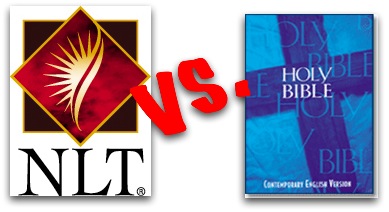
If you are just now tuning into the series, be sure to read Round 1 (also written by David) and Round 2 (written by yours truly).
READ THIS NEXT SENTENCE VERY FAST TO GET THE SENSE OF HOW I INTEND IT TO BE HEARD: And of course, there's still the post out there that was almost Round 3, in which David called his method and motives a scam, but I thought he was referring to the whole series as a scam, and I took great offense because the work on my part was certainly 100% scam-free, but David
Stay tuned because at some point in the near future, Round 4 will be posted here. I haven't selected a passage yet, but if you have suggestions, feel free to post them as long as your motives aren't "scam-motivated."
Quest Bible Study Class Gets Mention from KBC
See "Sunday School New Birth Stories, part 3."
And if you're not in the class already, but if you're ever in the area, come join us at 10:30 a.m. on Sunday mornings.
TNIV Truth: Hebrews 11:11
In my newest entry, on TNIV Truth, I examine the differences between the NIV and TNIV in Hebrews 11:11. See my post, "NIV vs. TNIV: Hebrews 11:11."
Bible Translation Awareness (or lack thereof)
I'm not overly concerned with which particular translation a person uses as long as the interaction between the person and the version is meaningful. When occasionally asked what translation I recommend, my overarching recommendation is that a person reads a modern translation for a primary Bible. I never recommend the King James Version because in my two decades of teaching experience, the language and vocabulary--as beautiful as they are--is mostly not understandable by the person reading this Bible. I'm not opposed to the KJV, per se, and suggest it is fine to be read in parallel with a modern translation, but I believe it is past its use for the large majority of people in today's culture. Nevertheless, according to the April CBA bestsellers list, the KJV is ranked at #2 (under the NKJV), so a lot of folks are still buying it. Obviously, they haven't asked my opinion!
When I say a modern translation, I'm not trying to proclaim bias against the very beautiful and useful translations of the past. But the reality is that our language is changing, perhaps moreso right now than in the last hundred or more years. Further, and more importantly, I believe that modern translations have the benefit of textual criticism and ongoing linguistic research to create translations in English that more accurately reflect the message and intentions of the original biblical writers. I'm especially interested in how well 21st century versions (ESV [2001], The Message [2002], HCSB [2004], NLTse [2004], NET Bible [2005], and TNIV [2005]) render the biblical texts. Future posts will focus on these translations, and I'll probably include a couple of late 20th century versions which I believe still hold significant voices in the discussion, namely NRSV (1989) and the NASB update (1995).
Of course, while my main recommendation is for a modern translation, it's no secret to any reader of this blog that I have certain translations I favor. And when asked for particular recommendations in the last year or so, I've primarily recommended the NLT, TNIV, and HCSB. After elaborating on the differences between them, I've suggested that a person go to a local bookstore and read passages in all three. Of course, such a suggestion always opens the door to a sales clerk intruding into the process to push a favorite translation and dissuade the purchase of one that I may have recommended. If you don't believe this happens, go to a Christian bookstore and hang out in the Bible section for awhile. Play dumb about translations when the sales clerk comes over, and you'll often see an agenda in place for pushing a particular version.
All this leads me to bring up an article I received this morning in a Google News Alert of which I have a number of subscriptions pertaining to various Bible translations. This is yet another article in which the writer seems to be surprised that the Bible is still such a bestseller, outselling even Harry Potter (who would've thought it?!). But the context of this particular article is different because it relates to a vote that the Muscogee County (Georgia) Schoolboard will make on April 23 as to which translation of the Bible will be used in their new Bible-as-literature elective. Care to guess which translation the superintendent is recommending? The New KIng James Version (which happens to be #1 on the April CBA list). I've wondered over and over who is buying the New King James, a translation in general that I would only recommend to a diehard KJV-only adherent as a compromising alternative. Such a suggestion by the superintendent and much of the other information in the article itself suggest to me that I'm very much correct about the state of unawareness when it comes to Bible translations. Consider the following:
- In attempt to update the reader on other translations besides the KJV, the writer Allison Kennedy offers brief publication background on three "newer" translations: the NIV, NASB, and NKJV. Such a list would have been understandable if this article had been written in say, 1985, but there has been much significant progress made since these three translations. Of note, Kennedy doesn't even mention the 1995 update to the NASB which makes me wonder if she was using an older source for her information.
- From the article: "Joy Ahlman is a student of the Bible who takes her translations seriously. For years, the Christ Community Church member used the New International Version and the New Living Translation because both have clear language, but now she's recently switched to the New American Standard. 'I prefer to take time to study and it has cross-references and translations of different words at the bottom.'" Well, it will certainly take Joy more time to plow through the NASB than the NIV and NLT, but I'm more stunned at her reason for switching regarding "cross-references and translations of different words at the bottom." Such features are readily available in editions of the NIV and NLT, too. But such a statement demonstrates a common confusion between text and features in the minds of many Bible readers. Many times I've had to explain the difference to a church member between the text itself as the actual scripture as opposed to study notes and other features. And I've also had to explain that two editions of Bibles don't mean two different translations.
- And of course, KJV-only adherents weigh in for Kennedy's article: "'I teach and preach from the King James,' said Vann, pastor of The Rock Baptist Church in Cataula, Ga. 'The reason I do that is because newer translations leave out certain words or phrases. It's not that I'm a King-James-only guy, but it makes the people dive in deeper.' Last year, Vann led the church through a study comparing some of the translations. 'It blew their socks off,' he said of his members, many of whom weren't aware of the differences." Yeah, I bet. They're so concerned about things being taken out of their Bible, they don't realize they're buying into a textual tradition in which things have been added that the biblical writers never wrote. You'd think that there would be concern that goes both ways. A little bit of text critical knowledge would go a long way in such situations.
- Granted, this is a nitpick, but at one point Kennedy calls the New Living Translation the "New Living Bible" and says that it comes in many versions, although what she means is that it comes in many editions.
- Interestingly, in the entire article, there was no mention of the ESV or TNIV, which may say more for the awareness of these particular translations than anything about the writer of the article.
When I taught Bible at a private Christian school for five years, I allowed students to use any translation they wanted with the exception of the King James Version. Although I've mainly used the TNIV over the past year while teaching, I haven't pushed it as a translation. In over twenty years of teaching the Bible in various venues, I've always encouraged a variety of translation use, and I've only said anything to something about their translation on a very small handful of occasions. I've made a point not to put down any particular translation. And any concern has usually been in regard to use of the KJV in which I felt they consistently misunderstood what what they were reading. Sometimes, I merely offer a Bible as a gift without making a big deal about their use of the KJV such as recently when I gave a copy of the NLT to a member of the class I teach on Sunday mornings. He now carries it every Sunday and has told me that he feels like he can understand the Bible for the first time in his life.
My overriding concern is that people have a life-changing experience with God's Word. I never want a particular translation to get in the way of that possibility. What's translation awareness like in your circles? Is it is a big deal? Should it be addressed occasionally or should it be ignored? Feel free to post your thoughts in the comments.
The Wycliffe New Testament [1388] (Top Ten Bible Versions #9)
And shepherds were in the same country, waking and keeping the watches of the night on their flock. And lo, the angel of the Lord stood beside them, and the clearness of God shined about them, and they dreaded with a great dread. And the angel said to them, Nil ye dread, for lo, I preach to you a great joy that shall be to all people. For a Saviour is born today to you that is Christ the Lord in the city of David. And this is a token to you, ye shall find a young child lapped in cloths and laid in a creche. And suddenly there was made with the angel a multitude of heavenly knighthood, herying God and saying, Glory be in the highest things to God, and in earth peace to men of good will.
From the Gospel of Luke, chapter II
I've said before that my "Top Ten" list of Bibles is somewhat categorical in nature. One of the categories that I wanted to see represented in this series when first thinking about it was translation of a historical nature, a non-contemporary translation. I could have easily and logically picked the KJV, but it is so familiar, I doubt I could have added anything to the conversation. I came close to selecting the Geneva Bible or William Tyndale's translation, but I remembered that the era surrounding John Wycliffe had always captured my imagination.
I first discovered John Wycliffe (1320-1384) and his Lollard followers in college when I took a class devoted to Chaucer's writings. I felt immediate theological attraction to this individual often called "the morning star of the Reformation" and his conviction that all believers have a copy of the scriptures in their own native language. Later in seminary, while taking a church history class, I focused my attention on Wycliffe again as the subject of my term paper for that semester.
Then a couple of years ago, I was sitting in a seminar and I noticed one of the church history majors was reading from a very interesting Bible. Always interested in what version of the Scriptures people are reading, I looked closer to see The Wycliffe New Testament 1388 on the spine. Very much intrigued by this point, I asked him if I could look at it. He cautioned, "Yeah, but you should know that it's in Old English." Remembering my Chaucer class from years before, in which we were only allowed to read the texts in their original form in class (no modern translations or paraphrases allowed), I did my best not to sound too much like a know-it-all as I said, "Technically, that would be written in Middle-English." He looked at me with a blank stare and then said, "No, I think this is Old English." I saw him a few weeks later, and he said, "Hey, you were right--the Wycliffe Bible is written in Middle-English."
Thanks. It's probably a good thing that I didn't bring up the fact that it's very doubtful that Wycliffe had much direct influence on the translation that bears his name. Rather, most agree that the Wycliffe Bible (there were actually two different versions by that name) was produced by the Lollard community which was heavily influenced by John Wycliffe's teachings. The translation itself, while not the very first translation of the Scriptures into English, were the first product of Wycliffe's conviction that all believers, regardless of education or status had the right to access the Scriptures in their own language. The basis of the Wycliffe New Testament was the Latin Vulgate, which was ironically itself once a translation with the same goal but became a Bible for the privileged as fewer people spoke Latin.
Original copies of the Wycliffe NT were written and copied by hand. Since ownership of these texts was illegal, having a copy was a great risk. They were also very valuable, often with wheelbarrows of hay being traded for a few pages from the "pistle" of James or some other NT book. According to the introduction found in the printed copy I own, these handwritten pages of Scripture were highly treasured even long after the age of the printing press and the explosion of English translations in the sixteenth century. They only fell out of use after dramatic shifts in the English language.
The Wycliffe NT is somewhat unique because it contains the epistle to the Laodiceans, which is evidently in the Vulgate, but is no longer extant in the Greek. Although the Lollards recognized that the Catholic Church did not consider this book to be canon, they nevertheless did, assuming that it was the letter referred to in Col 4:16.
I picked up the same edition of the Wycliffe NT that the student mentioned above had. It's a very solid hand-sized hardback binding with a nice blue ribbon, published by the The British Library in association with the Tyndale Society. The pages are made from "normal" paper as opposed to Bible thin paper, and I would guess that they may be acid free. This New Testament uses a stitched binding so no doubt, it will hold together for quite a long time. If one might be prone to take notes, there are ample one inch margins interrupted only occasionally with a definition of an overly-archaic word in the text. Spelling has been modernized, and (unfortunately, in my opinion) so have many of the words. This is not really a difficult read--nothing like my Chaucer class--but it will slow down the average reader (which is often a good thing). Why some archaic words were updated and others were left alone, I have no idea. Like the original Wycliffe NT, this edition does not have verse divisions, but does contain chapter numbers.
The order of books is different from our Bibles with Acts (or "Deeds" in this version) coming after Paul's "pistles" which not only include the aforementioned letter to the Laodiceans, but also includes the letter to the Hebrews, assumed by most in the Middle Ages to have been written by Paul. For some odd reason, there's no table of contents which would have been very helpful because of the non-standard arrangement of books.
Some passages of interest:
And Jesus, seeing the people, went up into an high hill, and when He was sat, His disciples came to Him. And He opened His mouth and taught them, and said, Blessed are poor men in spirit, for the kingdom of heavens is theirs. Blessed are mild men, for they shall wield the earth. Blessed are they that mourn, for they shall be comforted. Blessed are they that hunger and thirst rightwiseness. for they shall be fulfilled. Blessed are merciful men, for they shall get mercy. Blessed are peaceable men, for they shall be called God's children. Blessed are they that suffer persecution for rightfulness, for the kingdom of heavens is theirs.
...
Ye have heard that it was said to old men, Thous shall do no lechery. But I say to you that every man that sees a woman for to covet her, has now done lechery by her in his heart. That if thy right eye sclaunder thee, pull him out and cast from thee, for it speeds to thee that one of thy members perish than that all thy body go into hell. And if thy right hand sclaunder thee, cut him away and cast from thee, for it speeds to thee that one of thy members perish than that all the body goe into hell. And it has been said, Whoever leaves his wife, give he to her a libel of forsaking. But I say to you that every man that leaves his wife, out-taken cause of fornication, makes her to do lechery. And he that weds the forsaken wife, does advowtry.
from the Book of Matthew, chapter V
And I comment to you Phoebe, our sister, which is in the service of the church at Cenchrea, that ye receive her in the Lord worthily to the saints, and that ye help her in whatever cause she shall need of you
....
Greet well Andronicus and Junia, my cousins and mine even prisoners, which are noble among the apostle and which were before me in Christ.
from the pistle of Paul to the Romans, chapter XVI
Paul, apostle, not of men nor by man, but by Jesius Christ, to the brethren that are at Laodicea, grace to you and peace, of God the Father and of the Lord Jesus Christ. I do thankings to my God by all my prayer that ye are dwelling and lasting in Him, abiding the behest in the day of doom. For neither the fain speaking of some unwise men has letted you, the which would turn you from the truth of the gospel that is preached of me. And now them that are of me to the profit of truth of the gospel, God shall make deserving and doing benignity of works and health of everlasting life. And now my bonds are open which I suffer in Christ Jesus, in which I glad and joy. And that is to me to everlasting health that this same thing be done by your prayers and ministering of the Holy Ghost, either by life, either by death. Forsooth, to me it is life to live in Christ, and to die joy. And His mercy shall do in you the same thing, that you moun have the same love and that ye are of one will. Therefore, ye well beloved brethren, hold ye and do ye in the dread of God, as ye heard [in] the presence of me, and life shall be to you without end. Soothly, it is God that works in you. And, my well beloved brethren, do ye without any withdrawing whatever things ye do. Joy ye in Christ, and eschew ye men defouled in lucre, either foul winning. Be all your askings open anents God, and be ye steadfast in the wit of Christ. And do ye those things that are holy and true, and chaste and just, and able to be loved. And keep ye in heart those things ye have heard and taken, and peace shall be to you. All holy men greet you well. The grace of our Lord Jesus Christ be weith your spirit, and do ye that pistle of Colossians to be read to you
The Pistle to Laodiceans [in its entirety]
But Saul, yet a blower of menaces and of beatings against the disciples of the Lord, came to the prince of priests and asked of him letters into Damascus, to the synagogues, that if he found any men and women of this life, he should lead them bound to Jerusalem. And when he made his journey, it befell that he came nigh to Damascus. And suddenly, a light from heaven shone about him. And he fell to the earth, and heard a voice saying to him Saul, Saul, what pursues thou Me? And he said, Who art Thou, Lord? And He said, I am Jesus of Nazareth whom thou pursues. It is hard to thee to kick against the prick. And he trembled and wondered, and said, Lord, what will Thou that I do? And the Lord said to him, Rise up, and enter into the city, and it shall be said to thee what it behoves thee to do.
from the Deeds of the Apostles, chapter IX
My little sons, I write to you these things that ye sin not. But if any man sins, we have an Advocate anents the Father, Jesus Christ, and He is the forgiveness for our sins. And not only for our sins, but also for the sins of all the world. And in this thing we wit that we know Him, if we keep His commandments. He that says that he knows God and keeps not His commandments, is a liar, and truth is not in Him. But the charity of God is parfit verily in him that keeps His word. In this thing we wit that we are in Him, if we are parfit in Him. He that says that he dwells in Him, he owes for to walk as He walked.
from the first epistle of John, chapter II
And they had on them a king, the angel of deepness, to whom the name by Hebrew is Abaddon,, but by Greek, Apollyon. And by Latin he has the name Exterminians, that is, a destroyer. One woe is passed, and lo, yet come two woes.
from the Apocalypse, chapter IX
In case anyone misunderstands, I'm certainly not recommending the Wycliffe NT (or any other historical translation) as a primary study Bible. But there is great value in having older translations around for comparison and understanding the development of our English translations. Further, a historical translation can connect the reader to the generations who used it hundreds of years ago. Finally, there is great spiritual benefit when reading something like the Wycliffe NT for devotional purposes. I challenge you to give it a try, and don't be surprised if God speaks to you--even from the Middle English!
Next in series (and coming soon): The Modern Language Bible (New Berkeley Version)
Jesus Tomb Film Scholars: "Well, um...that's not what I meant..."

From yesterday's Jerusalem Post:
Several prominent scholars who were interviewed in a bitterly contested documentary that suggests that Jesus and his family members were buried in a nondescript ancient Jerusalem burial cave have now revised their conclusions, including the statistician who claimed that the odds were 600:1 in favor of the tomb being the family burial cave of Jesus of Nazareth, a new study on the fallout from the popular documentary shows.
The dramatic clarifications, compiled by epigrapher Stephen Pfann of the University of the Holy Land in Jerusalem in a paper titled "Cracks in the Foundation: How the Lost Tomb of Jesus story is losing its scholarly support," come two months after the screening of The Lost Tomb of Christ that attracted widespread public interest, despite the concomitant scholarly ridicule.
Read the full post, "Jesus Tomb Film Scholars Backtrack."
Although I initially thought the Jesus tomb "scandal" would have become a much bigger deal than it turned out, it looks like it may not even garner a footnote in the events of 2007. This is primarily because of the immediate dismissals and rebuttals that came from just about every spectrum of the academic community.
Is anyone surprised? James Cameron and Simcha Jacobovici should immediately donate the money they made from this project (and I'm sure there was money to be made) to the church of their choice as penance.
TNIV Truth: Former ESV Advocate Now Champions TNIV, NLTse
For the full post, see my latest entry at TNIV Truth.
The Grantham Bible Study Method
A Guest Post by Chuck Grantham
Rick has asked me to expand a bit on how I prepare for Sunday School for those who may not read the comments section.
The first thing I should say is that I do not teach a Sunday School class. I do this primarily for myself. On the other hand, I think any group of believers studying the Bible deserve good answers when they have questions, and the Learner Guide in the Lifeway Explore the Bible series, the Southern Baptist Convention’s Sunday School quarterly, cannot possibly address all the questions that can come up in your average class.
It is also a help to the actual teacher when someone can give a quick answer to those odd, even off-topic questions that come up, so the teacher can get back on topic. You culprits know who you are….
I should also add that this is a new routine for me, and is slowly evolving as I use it. It also varies a bit depending on the genre of the biblical book we are studying. For Old Testament history I do more historical study and less textual work because my Hebrew and my resources aren’t up to it. For the Gospels I do more synoptic comparison and non-canonicals research, because that‘s a scholarly trend right now and I am fascinated by the agrapha, even if Craig Evans dismisses it.
So as they say, this is where I am at right now, in regard to Sunday School preparation. Here are the steps as I can best outline them:
1. Read the lesson passage in the Learner book.
Of course, you’ve got to read the text first. This can involve different amounts of material. The lesson starts off with a title and then two sets of verses:
A) Background passage: the length of material assumed necessary to grasp the context of the lesson.
B) Lesson passages: those verses actually studied and commented upon in the Learner book.
Sometimes the background passage and the lesson passages are the same. Sometimes the background is several chapters and the lesson passages are the highlight verses within the background passage. My strong suspicion is most folk only read the lesson passages, and even that only in the translations provided in the Sunday School book.
Yes, I said translations. The Explore The Bible Learner Guide provides the lesson passages in side by side renderings from the Holman Christian Standard Bible and of course, the King James Version. This selection leads us to my next step.
2. Check HCSB and KJV for obvious differences.
I love parallel Bibles. But they can confuse someone who does not understand the background of translations. Not only do different Bibles read differently because of different translation philosophies (mirroring the original text versus mirroring contemporary speech of the translation‘s day, to grossly simplify) but also because translations are based upon different “original” texts. Speaking strictly of the New Testament, Older Roman Catholic Bibles were based upon the Latin Vulgate, which varied in places from the King James Bible, based upon Erasmus’ Greek New Testament. And both vary again from Bibles published in the last 130 years, when discoveries of massive numbers of Greek, Latin, Coptic, Syriac and many more language new testament manuscripts have led scholars to create several “standard” Greek New Testaments, which has further led to each new translation’s translator(s) being forced to decide in numerous places which Greek wording seems more original to them.
All of which is to say that the HCSB and the KJV do not always agree, and not only because centuries separate the vocabularies of the two. The venerable old KJV is based on Greek manuscripts from the Middle Ages, which tend to be more verbose in fear of leaving something good out. The HCSB is based on the current scholarly Greek New Testament, which tends to follow the earliest well-produced manuscripts, whose scribes had not yet added wordings to make things clearer or more reverent, and thus tends to be shorter.
So, after reading the HCSB and the KJV, I do a comparison of their wording, and I take a pen and circle the differences I see, either in vocabulary or in text. That gives me a series of verses which I can then use as a guide for the next step.
3. Check NET diglot for textual notes.
This is the first step where level of education rears its head. I personally have what might be described as “word study Greek.” I can read Greek letters and I know a lot of root words in the vocabulary. Thus I can use certain tools an English-only reader cannot. There are tools for the Greek-impaired to do these sort of things, too, though.
For those with Greek or without, the NET Bible First Edition is a great help, if you don’t let yourself be intimidated. With over 60,000 notes (compared to many study Bibles’ 20,000 notes) the NET is either a study Bible on steroids or an emaciated commentary. Besides the inevitable complaints about its translation philosophy, the NET’s chief strength is its greatest weakness: it has notes for every level of user. Simple definitions of terms sit alongside lengthy discussions of textual critical issues using manuscript numbers and Greek wording. Transliterations are provided as well as notes with “literal” translations of phrases, though.
My preferred edition of the NET when dealing with the New Testament (and we Christians usually are) is the NET Diglot. That is, a parallel Bible with the Nestle-Aland 27th (NA27) edition of the Greek New Testament combined with the NET English translation and notes. Why? Because I am a hopeless New Testament textual criticism geek. Reading the New Testament in Greek for most will simply confirm how careful most translations are to get things as right as they can. And because inevitably translators use
the same reference books and read each other’s translations, a good parallel English New Testament will reveal strong similarity in most Bible passages. But when they do differ, there is no better one stop resource than the NET diglot, which combines the mini-encyclopedia of the NET with the second mini-encyclopedia of the NA27, which endlessly footnotes even minor variations in the wording of NA27’s Greek text by citing which important manuscripts differ from the NA27, then which ones agree with NA27, then which important previous editions of the Greek New Testament agree or disagree with NA27. All of this together with an appendix citing the approximate age of the important manuscripts and what text of which New Testament books they contain.
All this can make for information overload, and the chief complaint against NA27 is that it requires one to learn practically another language in the form of NA27’s symbols and abbreviations to truly use it well. There are two solutions to this:
a) NET Diglot comes with a little foldout containing the witnesses, signs and abbreviations used in the NA27 that will be constantly in readers’ hand.
b) NET footnotes on the opposite page contain English sentences stating as simply as possible much the same information as abbreviated in the NA27 footnotes.
So, having found out what the NET Diglot says about the differences between HCSB and KJV, I will usually circle or underline the variation in the Learner book, draw a line out to the margin of the page, and write out a transliteration of the Greek, together with the earliest manuscript or two supporting each variation with rough date.
At this point I will also be mulling over other things I have learned from the footnotes on the NET side of the diglot, which I will have noticed mentions literal translations, other text critical issues, or even translation issues. But now it is time to go back to the Learner Guide for the next step.
4. Read the passage overview in lesson book, noting where the author keys on words, provides definitions or parallel verses.
In other words, grill the author on the assertions he makes. If he defines a word, I’ll circle it, find the Greek term in the diglot, see how NET translates it, and if I’m at all suspicious of the English term, walk over to my book case and pull out my copy of The New International Dictionary of New Testament Theology: Abridged Edition
Key words and parallel verses require more work and more tools. I will cross check the English against the Greek so I get one term, then for the key words simply see how often they are repeated in the Greek text. I do this with E-sword, the excellent FREE (mostly) Bible software. By simply highlighting the Greek word and clicking, I can run a search on the word in the current book or the New Testament. With a copy, a switch to the LXX, and a paste, I can further search for the word in the Old Testament. Even with my poor Greek, I can flip through English versions in E-sword and get a sense of the range of meaning for the word, and very often discover parallels to my New Testament text.
If this doesn’t satisfy me (and by now you realize I’m not easily satisfied) I can hit the books again. Specifically Goodrick, Kohlenberger and Swanson’s The Exhaustive Concordance to the Greek New Testament
This is the point scratch paper comes in handy. Among these many verses I will make note of the parallels quoted in the Learner book and my search I find significant. That leads me to the next step.
5. Significant parallels I paste together and print out in Greek and English, particularly where outright quotes from LXX or a usage determining a discussed word meaning occurs.
Simply put, I’ll cross check my scratch list, pick the most important, then make a file of the New Testament and Old Testament parallels in Greek and English which I resize as small as readable, then print up double-sided to be folded up and stuffed in my now bulging Leaner Guide, along with that possible article from NIDNTT.
6. I print out Robertson's Word Pictures in the New Testament
Because I need all the Greek help I can get, and because, to borrow from Rick Brannan, A.T. Robertson was a stud. Or to be more technical, because Robertson wrote a still highly regarded Greek grammar and he published Word Pictures after the papyri boom of the 1900s which changed forever our understanding of New Testament Greek.
7. I read Barclay's Daily Study Bible
Yes, it is only here I get to the commentaries proper. Unless I am cheating a bit. Which lately I am. I bought a copy of Thomas Schreiner’s 1 Peter, 2 Peter, and Jude in the NAC series)
Anyway, by this time I know enough about the lesson passage that I can run through the commentaries pretty quickly. Mostly I am looking for different material: cultural background, classical references, historical information. Besides the cultural, most of this will not likely come up in Sunday School. I make notes on my scratch paper, which is at least two sides of paper or two sheets by now.
8. I run off the appropriate page(s) from Bruce Metzger’s Textual Commentary on the Greek New Testament
Because I’m a textual criticism geek, but also because Metzger sometimes has odd little sidelines and Omanson discusses how segmentation can affect translation. And of course, Metzger is still THE Man.
9. I sit down with all these pages and put short notes in my Learner book.
Basically, I select what I find important, interesting, and/or easy to write briefly and write it up in the book where I will easily remember it. That usually includes Greek transliteration of key words or confusing terms in KJV along with definitions, notations of words not in the Greek supplied for English clarity, parallel verse notations, occasional flow charts of the author’s argument, and almost always questions about multiple interpretations of a phrase or verse. That’s a fair amount of black ink
scribbled in the book, along with that now sizeable sheaf of printouts in the center of the Learner Guide.
10. After a break of a day or two, I go back and review what I've compiled.
Like preparing for a test, I check to see what I remember and what I need to review. I will also likely scratch out some notes and add some new ones, because I see things more clearly after a break.
11. I go to Sunday School and never use ninety percent of what I've learned.
Because I’m not the teacher, and because I want to help my fellow members learn, not confuse them.
12. I come home from Church and after lunch start the process over again for the next week's Sunday School lesson.
Because I really enjoy all this study.
Thanks Chuck for sharing all this. I've heard it said (and I agree) that sincere study of the scriptures is just as valid of a style of worship as any other. I know many of This Lamp readers will relate to Chuck's enthusiasm for understanding the scriptures even if they have slightly different steps of their own. I can relate to Chuck because I've always said that I feel most alive when learning, and I feel most in God's will when I am teaching what I've learned.
Chuck Grantham can be reached at chuckgrantham@cableone.net, and I know he would appreciate your feedback in the comments.
Review: Jewish Study Bible
Introduction
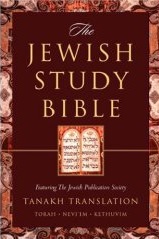
This is the first of a series of reviews on major study Bibles. My initial reviews focus on study Bibles used in academic settings. These Bibles tend to feature critical approaches to Bible reading – a style that is well suited to secular academic studies, but only one of many ways of reading scripture. Even in secular settings of the Bible, other approaches to Scripture are studying the literary features of the Bible, studying the history of interpretation and use of the Bible, and so forth. These study Bibles do not take for granted that the readers will necessarily be reading from a religious perspective; and a person who seeks a devotional reading of the Bible may find the treatment in these works cold or alien to a religious perspective. Nonetheless, the study Bibles I will consider have a wide variety of uses:
- they often serve as textbooks (typically at the college level, although they are not uncommonly used in some seminaries);
- they can serve as a self-study resource for a person who seeks to learn the Bible on his or her own;
- they are convenient reference sources;
- they can be used in certain religious settings (for example, I understand that the New Interpreter’s Study Bible is used in some mainline denominations such as the United Methodist Church and the Episcopalian Church USA for discipleship classes); or
- they often serve to document “semi-official” insights into translations, since they are edited by individuals associated with major translations or individuals associated with prestigious academic study societies (such as the Society for Biblical Literature.)
The genre of study Bible was largely pioneered by the influential 1965 Oxford Annotated Bible edited by Herbert May and Bruce Metzger (note that the Wikipedia attribution to Metzger and Murphy is mistaken). This 1965 volume was a relatively simple annotation of the Revised Standard Version (with Apocrypha) for college courses; its direct 2007 successor (the 3rd Augmented Edition of the New Oxford Annotated Bible) has more than twice the number of pages (and those pages are substantially larger). A typical study Bible will feature book introductions, extensive annotations, additional essays and materials, glossaries, indices, diagrams and maps.The success of the genre can be seen not only by the large variety of editions available, but by the fact that the genre is now popular in circles that stretch far beyond traditional secular audiences: there are study Bibles today for Evangelicals, Traditional Catholics, Eastern Orthodox, Jewish Orthodox, and other faith-based communities. In this series, I hope to consider the following study Bibles:
• JSB: Jewish Study Bible (Oxford 2004) [NJPS]
• NOAB: New Oxford Annotated Study Bible (3rd Augmented Edition) (Oxford 2007) [NRSV]
• NISB: New Interpreter’s Study Bible (Abingdon 2003) [NRSV]
• HSB: HarperCollins Study Bible (2nd edition) (HarperSan Francisco 2006) [NRSV]
• CSB: Catholic Study Bible (2nd edition) (Oxford 2006) [NAB]
• OSB: Oxford Study Bible (Oxford 1992) [REB]
• WSP: Writings of St. Paul (2nd edition) (Norton 2007) [TNIV]
• ECR: Early Christian Reader (Hendrickson 2004) [NRSV]
I also hope to consider two especially interesting study Bibles primarily directed at specific faith communities
• TSB: TNIV Study Bible (Zondervan 2006) [TNIV]
• OSBNT: Orthodox Study Bible: New Testament and Psalms (Conciliar Press Edition) (Conciliar Press 1997)
It is tempting to categorize Bibles with terms such as “conservative” or “liberal”, but these terms are too ambiguous to capture subtle distinctions. The terms are ambiguous because they there are so many issues which are captured here, a sampling includes issues of gender, issues of Jewish-Christian relations, issues of sectarian and denominational divisions, issues of formal translation versus paraphrase, issues of varying trends in scholarship, issues of contemporary politics, and issues of historical politics. I believe that use of these terms tends to reflect sloppy thinking – we all have ranked ourselves somewhere on the liberal-conservative scale, and if someone tells us that a particular book is liberal or conservative, we have a tendency to judge the book on that simple scale alone, rather than dealing with the multi-faceted issues that arise in reading texts. Once again, Wikipedia provides an example of this sort of sloppy thinking: its article on the Oxford Annotated Bible states: “The third edition . . . is considered to be much more liberal and ecumenical in approach. For example, it calls the Old Testament the `Hebrew Bible’ out of consideration to Jewish readers.” This quote is not only an example of bad writing (one only wonders who is doing the “considering”, why the unnecessary "in approach") ; it is hopelessly confused on numerous issues (the NRSV itself entitles the section “The Hebrew Scriptures Commonly Called the Old Testament”; and early editions the Oxford Annotated Bible has had the words “An Ecumenical Study Bible” on the cover) and its use of “liberal” and “conservative” is at best unclear. It doesn’t seem that this use of terminology is an issue of liberalism or conservatism, but even if it were, a Jewish reader would probably consider “Hebrew Scriptures” the conservative choice.
An overview of the Jewish Study Bible
The Jewish Study Bible
Adele Berlin and Marc Zvi Brettler, editors
Michael Fishbane, consulting editor
Translation: New Jewish Publication Society Translation
Hebrew Scriptures: yes
Deuterocanon: no
Christian Scriptures: no
Current Amazon price: $29.70
xxvi + 2181 + 16 map pages
Extras:
- Lengthy introduction to books and major sections
- 37 black and white diagrams and maps
- 16 page color map section, with 9 large color maps.
- Listing of traditional sources with mini-glossary
- 21 page glossary
- Index and map index
- Table of verse differences between standard English numbering and Hebrew numbering
- Table of Jewish lectionary
- Hebrew calendar discussion
- Timeline (Egypt/Israel/Mesopotamia)
- Chronology of rulers in Egypt/Syria/Assyria/Babylonia/Persia/Roman Empire/Israel
- Table of weights and measures
- Bibliography of translations of primary sources
- 278 pages of additional essays
The editors of the volume are
- Adele Berlin (University of Maryland), who holds a named chair in Biblical studies, was head of the Meyerhoff Center, was former associate Provost. She was also a former president of the Society for Biblical Literature. She has written three biblical commentary volumes (for the Anchor Bible, Westminster Old Testament Library, and the JPS Bible Commentary series), a number of additional books.
- Marc Zvi Brettler (Brandeis University) who holds a named chair and chairs the Department of Near Eastern and Judaic Studies. He was co-editor of the NOAB, the author of a major textbook on Biblical Hebrew, and is well known for his teaching, which is reflected in a very nice volume he wrote called How to Read the Bible.
- Michael Fishbane (University of Chicago) who holds a named chair in the Divinity School. Fishbane is a particularly influential biblical scholar, and arguably the most famous of three editors associated with this project.
Notes on the NJPS translation
My primary focus in these reviews is on the added value of the study Bible extras; however, the translation used in this volume has not been extensively discussed on Rick’s blog, so I’ll make some comments here on the New Jewish Publication Society translation. I’ll begin by putting that translation in context.
In contrast to Protestantism, contemporary Judaism has not on translation. Most traditional philological and theological discussions of the Bible took place in Hebrew. However, even for those Jews who have high competency in Hebrew, the Hebrew Scriptures are difficult to read, and so an ancient tradition requires study of the Hebrew together with the main Aramaic translation, Targum Onkelos. In English, early translations were primarily done by Protestants, with the KJV serving as the main resource. While the KJV showed no Jewish participation (since Jews had been expelled from England several centuries before) the translators relied heavily on Jewish philological studies, principally by David Kimhi (Radak). The KJV followed the Hebrew original in cadence, structure, and overall vocabulary, and despite its Christological interpretation of messianic passages in the Hebrew Scriptures, was perhaps the closest experience an English-only reader to get to reading the Hebrew until the translation of Everett Fox.
As a result, when the Jewish Publication Society (JPS) began its first translation of the Hebrew Scriptures (which I call the Old JPS [OJPS] translation) at the start of the 20th century, it made a decision to begin from the Revised Version, a revision of the KJV. A non-English speaker, the biblical scholar Max Margolis (from UC Berkeley and at Dropsie College, now part of the University of Pennsylvania) was put in charge of the OJPS. The other translators were not noted as biblical scholars. The result hews closely to the Revised Version, and was stylistically dated even when it was published.
Thus, when the JPS decided on a new translation, it began from scratch rather than revising the OJPS translation. (For this reason, the JPS has begun promoting the use of the term Tanakh for its new translation, to avoid any suggestions that the NJPS is a revision of the OJPS. However, this term is not appropriate, because Tanakh is the Hebrew acronym for the Bible, so it is a little like a translation committee calling its translation “The Bible.” Moreover, even JPS publications as recent as 2005, Michael Caraski’s excellent Commentators’ Bible: The JPS Miqrao’t Geolot Exodus refer to the translation as the NJPS on almost every page.)
The NJPS translation is divided according to the traditional division of the Hebrew Bible – The Law (or Pentateuch or Five Books of Moses) (Torah), the Prophets (Neviim), and Writings (Kethuvim) and the books follow the Hebrew ordering. Some English readers of the Bible may not realize that the traditional Christian orderings of the Bible do not follow the Hebrew text, and that even the verse numbering has been changed in most English translations. The NJPS follows the ordering and verse numbering of the Hebrew text. (There is a convenient table in the JPS with all the verse numbers that have changed – very useful for anyone who attempts to correlate the Hebrew text with the English text.)
Harry Orlinsky, who served on both the RSV and NRSV translation committees) was chosen as the head of the translation of the Pentateuch. Orlinsky was influenced heavily by his close contact with the mainly Protestant American Bible Society and co-authored a book with Robert Brachter (who is well-known for his work on the Good News Bible, among other works.) Orlinsky and his committee’s decisions on the translation of the Pentateuch are well documented in his book on the translation: Notes on the New Translation of the Torah. Separate committees translated the Prophets and Writings. As a result, the translations of the three parts vary quite a bit in style. (The compete translation appeared in 1985, and a subsequent revision in 1999.) The style of the translation is generally what would later be called “dynamic equivalence” (mild paraphrase). Here are some examples:
Genesis 1:1-2
OJPS: In the beginning God created the heaven and the earth. . . . And the spirit of God hovered over the face of the waters
NJPS: When God began to create heaven and earth . . . . And a wind from God sweeping over the water
Several points are notable here. I quote from a Leonard Greenspoon essay on Bible translations (conveniently found in Oxford’s JSB):
“The 1917 [OJPS] version retains the wording of the KJV; it parts company with the Protestant text by replacing the upper case ‘s’ of Spirit, a reference to the Trinity, with a lower case ‘s.’ In addition to rendering the Hebrew “ruach” with “wind” rather than with a form of “spirit,” Orlinsky (in the 1985 [NJPS] version), in keeping with one line of Jewish exegesis, renders the notoriously difficult wording of Genesis’ (and the Bible’s) beginning as ‘When God began to create.’ In doing so, he excludes the theological doctrine of creation ex nihilo, to the extent that this belief is dependent on the traditional English text. Moreover, it reflects the opening of the Babylonian creation story Enuma Elish, which also begins with a ‘when’ clause. It is also characteristic of Orlinsky’s approach that the literal ‘face of the waters’ yields to the simpler, more modern-sounding ‘the water.’”
In more than a few places, the NJPS loses valuable wordings. In the OJPS, Proverbs 31:10 translated eshet chayil as “a woman of valour” – a significant coining of a new phrase that follows the Hebrew closely. The NJPS translates this same phrase as “a capable wife” – a possible translation, to be sure, but one which seems to be a backwards step.
The NJPS varies in its treatment of gender issues. For example, ben adam is translated in Ezekiel as “O mortal” rather than “son of man.” Deuteronomy 24:16 changes “fathers” to “parents” – however, in general, singular references are not turned into plural references as in the NRSV, and the generic man/he/his is used in the text. The translation is only mildly gender sensitive. (The original 1985 translation made a few changes from singulars to plurals –but these were rolled back in the 1999 revision.)
The NJPS generally ignores stylistic issues particular to the Hebrew – it does not translate many initial vavs.
The NJPS is almost translated from the Hebrew Masoretic text – it does not make textual emendations in the translation proper, although it does note emendations in the textual footnotes (particularly in the Prophets). Alternative texts, such as the Septugint, Targums, Dead Sea Scrolls, and Vulgate are frequently noted in the footnotes. Perhaps the most common footnote is the painfully honest “Meaning of Hebrew uncertain” – a refreshing change from many translations that simply present the text with an unjustified certainty.
Christian readers who are comfortable with “dynamic equivalence” are likely to be mostly comfortable with the NJPS except perhaps in certain passages that have had Christological interpretations (such as Isaiah 7:14 or Isaiah 9:5 [English numbering: Isaiah9:6]) – here the translation generally follows the “plain meaning” of the Hebrew (although the JSB is careful in its annotations to note the alternative Christian interpretations of these verses.) Christian readers may appreciate the following features of the translation:
- Unlike many Christian translations, the NJPS focuses entirely on the Hebrew text, and thus doesn’t make it play “second fiddle” to the Christian scriptures. The Hebrew text receives more careful attention than it does in many Christian translations (see the discussion in Rick’s and my recent comparison of the NASB and NRSV.) In particular, the translation of difficult passages in books such as Leviticus and Numbers, which do not always receive wide attention from Christian audiences, is often more careful.
- The textual notes included in the NJPS tend to be rather more complete than in many Christian translations. Many idioms are noted (for example, in 2 Samuel 4:1, “his hand weakened” is noted in a footnote while “he lost heart” is used in the translation proper.) The textual notes comment on the original Hebrew words (in Roman character transliteration) and are far more numerous than in the NRSV, for example.
- The text is an easy-reading text, with a style not incomparable to translations such as the NIV.
- As previously mentioned the translation follows the order and verse numbering of the original Hebrew text.
- The translation focuses on the Hebrew Scriptures as they were understood by pre-Christian readers – and thus gives perhaps a better sense of how they were understood before later Christian interpretation.
The JSB has a significant advantage over most other study Bibles – it only focuses on the Hebrew Scriptures, and thus it has room for longer notes, chapter introductions, and essays than a typical study Bible that attempts to also cover the Christian Scriptures and the Deuterocanon. For example, in a recent NRSV edition, the Hebrew Scriptures take 947 pages (62% of the total) while the Deuterocanon and Christian Scriptures take 287 pages (19%) and 282 pages (19%). Since the Hebrew Scriptures only take about three-fifths of the total pages of a typical Bible with Deuterocanons, a study Bible that only features the Hebrew Scriptures can include two-thirds more material while still staying within the same page boundaries. This extended coverage has lead to the JSB being widely adopted as a text in college settings and mainline seminaries in courses that focus on the Hebrew Scriptures.
Annotations and introductions: As is typical in study Bibles, individual books are introduced and annotated by different editors. In the case of the JSB, all of the editors are Jewish Bible scholars although most teach at public universities (such as Michael Fox/University of Wisconsin), primarily secular private institutions (such Jon Levenson/Harvard University), or Christian seminaries (such as Marvin Sweeney/Claremont School of Theology). A number are from Israeli universities. Book introductions tend to be several pages long and more detailed than in most study Bibles. The introductions are quite good – much better than the NOAB. There are also section introductions to the Torah, Neviim, and Kethuvim, which are modified from introductions to the Pentateuch, Historical Books, Poetical and Wisdom Books, and Prophetic Books in the NOAB.
Annotations are generous, with many versus receiving paragraph long treatments. I have not attempted to count words, and it is not always easy to estimate the relative word count because of differing font size, but I estimate that the annotations have more words than the actual text. Christian readers may find these annotations especially interesting – some books that receive short-shrift in Christian treatments receive especially extensive treatments in the JSB. For example, Leviticus is the most heavily annotated of all the books in the Bibles, and reading the annotations opens new insights into this book, a book which often receives limited attention from other studies.
Here is are some examples of comparison notes from the JSB, NISB, and NOAB, and HSB to show the difference in annotation. (Annotations in the study Bible are often at the passage level and the verse level – in the first example I include both; I have also revised verse numbers in the NISB, NOAB, and HSB to correspond to the Hebrew):
Leviticus 14:12 [NJPS]: The priest shall take one of the male lambs and offer it with the log of oil as a guilt offering, and he shall elevate them as an elevation offering before the LORD.
JSB: 14:1-32 Resuming 13:46, these vv. prescribe the steps required of the person cured to dispose of the impurity he has created. Anthropologically and sociologically these rituals have been seen as rites of passage, marking the return of the outcast to normal life in human society and in God’s presence. Rabbinic interpretation, which tended to view the person afflicted under divine sanction for wrongdoing, generally explained these rituals as acts of contrition, penance, and thanksgiving. In fact, however, they are for ridding the person and the environment of the impurity that has been generated, and the environment of the impurity that has been generated, and the afflicted person is under no disapprobation unless he or she fails to carry them out. 14:3-20 The purification of the metzora‘ and the expiation, in three stages. 14:10-20 In stage three, on the eight day, the “metzora‘ makes his offerings. 14:12 Guilt offering: The presence of an ’asham sacrifice (see 5:14-26), it prominence evidenced among other things by the elevation ritual, is a mystery, since being afflicted with the tzara‘at is not an obvious trespass against the sacred. One theory is that the metzora‘ is under the strong presumption of having committed sacrilege; otherwise why would he have been stricken (see 2. Chron. 26:16-19)? Another possibility is that the inherent sanctity of the Israelite individual (see 19:2) has been compromised, although this would be unexpected in this portion of the book. Perhaps the ’asham is brought simply to provide blood for the final removal of residual impurity a week after the initial decontamination.
NISB: 14:2-32 Once the unclean person was healed, it was reported to the priest (not the NRSV’s should be brought to the priest), who went out and inspected the person. Three ritual steps were required to return the person to health on the first (vv. 2-8), seventh (v. 9), and eight days (vv. 10-20). 14:10-20 Rituals on the eight day reintegrated the individual into full social and religious standing. 14:12-13 A lamb was offered as a reparation offering, since it was assumed that the person had trespassed on some holy space or object (otherwise why this unexplainable illness?).
NOAB: 14:1-32 Purifying after recovery. The rites here do not heal, only purify after recovery by other means (contrast 2 Kings 5:10-14). 14:10-20 While the individual’s person is apparently pure, his or her impurity has affected the sanctuary, so it must be purged with sacrifices (see 4:1-35 n.) 14:12 Elevation offering, see Num 18:11n.
HSB: 14:1-32 Three separate purificatory ceremonies are required for a healed scale-diseased person: for the first day (vv. 2-8; also invoked for houses, vv. 48-53), for the seventh day (v. 9), and for the eighth day (vv. 10-32). The constitute a rite of passage whereby the person is successively reintegrated into the community. 14:10-20 The final stage of his purification takes place the following day when he brings a reparation offering for having possibly desecrated a sacred object or space (see 5:17-19), the blood of which together with sanctified oil is smeared on his extremities to purify him (see 8:30) a purification offering (not properly sin offering) for having contaminated the sanctuary by his impurity (see esp. v. 19) and a burnt offering and a grain offering to expiate for neglected performative commandments or sinful thoughts (see 1:4)
Comments: As you can see, in this example, the JSB has the most extensive annotations (with reference to the Hebrew), the NISB is second and easiest to read, the NOAB is painfully short, and the HSB describes the section but has no annotation on the verse proper.
Psalm 89:18-19 [NJPS]:
For You are their strength in which they glory; our horn is exalted through Your righteousness. Truly our shield is of the LORD, our king, of the Holy One of Israel
JSB: 89:18-19 Horn, a metaphor for strength (see also v.25). Horn and shield, the king protects his people and leads them to victory. Depending on the interpretation, v. 19 is the climax of the expression of the kingship of God, or it is a transition to the idea of David as king. The first interpretation take the Heb letter “lamed” – rendered as of in of the LORD and of the Holy One – to be an emphatic particle “our shield is indeed the LORD . . . our king is indeed the Holy One.” The second interpretation yields “our shield belongs to the LORD, our king to the Holy One” (so NRSV).
NISB: 89:18 Our horn is exalted The horn is a metaphor for strength and vigor. Here, both horn and shield are terms for the king.
NOAB: 89:18 Horn, a metaphor for strength (also v. 25).
HISB: 89:18 Horn, an image for the king.
Comments: once again the JSB has the most detailed information, correlating it carefully with the Hebrew text; the NISB is highly readable and still moderately detailed, and the NOAB and HISB are terse.
Jeremiah 7:18 [NJPS]: The children gather sticks, the fathers build the fire, and the mothers knead dough, to make cakes for the Queen of Heaven, and they pour libations to other gods, to vex Me.
JSB: 7:18 The Queen of Heaven is most likely some form of the Mesopotamian goddess Ishtar, symbolized by the Morning Star of Venus, who represented both war and fertility (see also Jer. 44:15-30).
NISB: 7:18 Whole families worship the queen of heaven, an astral deity (cf. Jer. 44).
NOAB: Queen of heaven, the title of a goddess; see 44:15-28 n.
HSB: 7:18 Queen of heaven (see 44:15-30), The Assyro-Babylonian goddess Ishtar, an astral deity associated with Venus. She was a goddess of both war and fertility.
Comments: it is a small example, but one sees that the HSB and JSB are substantially more detailed, explicitly mentioning Ishtar and Venus. The NISB is the most readable.
Annotation authorship is as follows:
- Yairah Amit (U. Chicago/Tel Aviv U.): Judges
- Shimon Bar-Efrat (Hebrew U.): Samuel
- Adele Berlin (U. Maryland): Esther, Psalms
- Marc Zvi Brettler (Brandeis): Psalms
- Ehud Ben Zvi (U. Alberta): Twelve Minor Prophets
- Michael Fox (U. Wisconsin, Madison): Proverbs
- Nili Fox (Hebrew Union College): Numbers
- Daniel Grossberg (U. Albany): Lamentations
- Mayer Gruber (Ben-Gurion U.): Job
- John Levenson (Harvard): Genesis
- Bernard Levinson (U. Minnesota): Deuteronomy
- Peter Machinist (Harvard): Ecclesiastes
- Carol Meyers (Duke): Joshua
- Hindy Najman (Notre Dame): Ezra-Nehemiah
- Adele Reinhartz (Wilfrid Laurier U.): Ruth
- David Rothstein (Unaffiliated): Chronicles
- Barch Schwartz (Hebrew University): Leviticus
- Benjamin Somner (Northwestern): Isaiah
- Elsie Stern (Fordham): Song of Songs
- Marvin Sweeney (Claremont): Ezekiel, Jeremiah
- Jeffrey Tigay (U. Pennsylania): Exodus
- Lawrence Wills (Episcopal Divinity School): Daniel
- Ziony Zevit (U. Judaism): Kings
The annotations will not discomfort Christian readers – they tend to be historical-critical in nature and only rarely stray into theological territory. Passages that are Christologically interpreted usually have a note explaining that interpretation; invariably with a respectful tone, and usually commenting on the Jewish distinctions. There are a few, but not frequent, discussions of Rabbinic, medieval Jewish, and Christian interpretations, these most often discuss philological questions. I read some reviews on Amazon that claimed that this book used annotations with words such as “chutzpah”, but I cannot find the cited quotes in my volume. Perhaps the author of the review confused this edition with another edition.
Layout and physical design: The layout of the volume is different from the traditional standard Bibles – a typical study Bible will feature the translation on top of the page with annotations on the bottom. In the case of the JSB, the text appears in a single column on the left of the page with the annotations being on the right-hand side. (If the annotations are particularly numerous, as they sometimes are, they spill over to the bottom of the page as well, in a triple column format.) This makes for easy reading – the translation column is not so wide that it makes reading difficult; and since the annotations are generally directly to the right of the text, the eye can find them without having to search through notes on the bottom. Another consequence of this layout is that Bible tends to have considerably more white space than most study Bibles. I know Rick likes to make notes, and with the single column format, heavy use of poetry in the Hebrew Scriptures, and the note layout, there is often white space on every page. While side margins are only about a half-inch wide, but there are larger top and bottom margins.
Given the recent interest in paragraph justification on this blog, I will mention that the prose text is fully justified, poetry text is formatted as poetry, and annotation text is left-justified. Unfortunately, there is mild bleed through the pages, although this is not as pronounced as it is other study Bibles such as the NOAB or HSB (although the NISB is superior in this regard.) I especially appreciated the font used in this volume – I found it especially easy to read. The text is nice and large, textual notes are almost entirely in italics (unlike in the NOAB, where textual notes are visually similar to annotations and the text), and the annotations are in a small but readable font. Introductions are printed with slightly wider spacing (left-justified) and here was one of the places where I found bleed through especially annoying.
You can see samples of the page layout here.
In contrast, the essays at the end of the book are in traditional double column fully-justified format.
The binding is high quality cloth and well sewn and reinforced (as is typical of Oxford Bibles) and the book comes with a dust jacket.
Essays: The essays in the volume are extensive – more extensive than the NOAB. Given their length (278 pages of essays – perhaps equivalent to 400 pages of essays in a more traditionally formatted book) the essays comprise a book on their own. Several of the essays are adapted from the NOAB – as indicated below. While these essays are primarily written from a Jewish perspective, eleven of the twenty-four essays might be particularly interesting to a Christian audience – those that are of particular interest to a Christian audience are marked with an asterisk
- *Inner-biblical Interpretation (Benjamin Sommer, Northwestern)
- Early Nonrabbinic Interpretation (Hindy Najman, Notre Dame)
- Classical Rabbinic Interpretation (Yaakov Elman, Yeshiva U.)
- Midrash and Jewish Interpretation (David Stern, U. Pennsylvania)
- Medieval Jewish Interpretation (Barry Walfish, U. of Toronto)
- Post-medieval Jewish Interpretation (Edward Breuer, Loyola U., Chicago)
- Modern Jewish Interpretation (S. David Sperling, Hebrew Union College)
- *The Bible in the Dead Sea Scrolls (Esther Eshel, Bar-Ilan U.)
- The Bible in the Synagogue (Avigdor Shinan, Hebrew U. )
- The Bible in the Liturgy (Stefan Reif, Cambridge U.)
- The Bible in the Jewish Philosophical Tradition (Hava Tirosh-Samuelson, Arizona State U.)
- The Bible in the Jewish Mystical Tradition (editors)
- *The Glorious Name and the Incarnate Torah, (Elliot Wolfson, NYU)
- The Bible in Israeli Life, (Uriel Simon, Bar-Ilan U.)
- Jewish Women’s Scholarly Writings on the Bible (Adele Reinhartz, Wilfrid Laurier U.)
- Jewish Translations of the Bible (Leonard Greenspoon, Creighton U.)
- *Religion of the Bible (Stephen Geller, Jewish Theological Seminary of America)
- *Concepts of Purity in the Bible (Jonathan Clawans, Boston U.)
- *Historical and Geographic Background to the Bible (Michael Coogan, Stonehill College; Carol Newsom, Emory) [partly adapted from NOAB by editors]
- *Languages of the Bible (Steven Fassberg, Hebrew U.)
- *Textual Criticism of the Bible (Michael Coogan, Stonehill College; Pheme Perkins, Boston College) [adapted from NOAB by editors]
- *Canonization of the Bible (Marc Brettler, Brandeis; Pheme Perkins, Boston College) [adapted from NOAB by the first author]
- *Development of the Masoretic Bible (Jordan Penkower, Bar-Ilan U.)
- *Modern Study of the Bible (Michael Coogan, Stonehill College; Carol Newsom, Emory) [adapted from NOAB by the editors]
The essays may also be interested to a non-Jewish reader who was interested in what characteristics, in any define Jewish exegesis as opposed to general scholarly exegesis or Christian exegesis. I found no remark that would be viewed as hostile to a non-Jewish audience, except perhaps in the introduction to the volume, where the editors It is clear that the selection of the essays was chosen to maximize the books relevance for a broad variety of classes, ranging from a first or second year of college survey to a more advanced audience. I learned quite a bit from the essays, and if the essays were not included in this volume but published separately in a book, I would have purchased it.
While the essays are written in an even-handed fashion, the same cannot be said of the four page introduction. It adopts a bit of a triumphalist tone that goes out of its way to distinguish this as a Jewish study Bible, rather than an ecumenical Bible. I was put off by the introduction, which is not representative of the entire volume, and would recommend that readers simply skip it. The volume includes a rich set of extras, but of special note is a rather good index (to the annotations and essays – I find this more useful than a concordance) and an extensive glossary. In fact, the glossary is so good that I would recommend starting with it – it covers a variety of Near Eastern terminology, biblical terms, and technical terms. Also of note is an annotated list of terms (pp. xix - xx) and a useful bibliography of sources in translation (although the editors tend to steer readers away from Orthodox Jewish translations, such as those from Artscroll.)
The volume has a set of color maps typical in many study Bibles, and also has a number of diagrams and maps in black and white.
A Christian audience for the JSB?
The JSB clearly is designed to have value for Jews from the Reformed, Conservative, and “new school of interpretation” Modern Orthodox movements for Judaism. Indeed, those who seek to admission to the five year rabbinical program at the Conservative movement’s Jewish Theological Seminary of America are advised to master this book to pass the Bible examination required on admission. It is not likely to Jewish audiences who prefer more traditional approaches to the Bible. But what about non-Jewish audiences? Will a Christian reader find value in the JSB?
In secular academic and mainline seminary settings, the answer is clearly yes. The JSB has been adopted by a number of secular and mainline Christian seminaries as a text – if only because its annotations and introductions are longer than those of competing study Bibles such as the NOAB, HSB, and NISB. What of an individual Christian reader? I think a reader may enjoy this study Bible for the following reasons:
- The annotations are careful to distinguish Christian interpretations of certain messianic passages. This has special value for readers who might otherwise tend to view the Hebrew Scriptures as primarily an extended preface to the Christian Scriptures. For example, some Christian commentators treat the book of Isaiah as a fifth gospel – that is certainly a way of reading Isaiah, but it is hardly the only way of reading Isaiah. Perhaps in reading this work, one can see alternatives – and even if a Christian reader finally decides to stay with a traditional Christian reading, he or she will have learned alternative ways of understanding the material.
- The annotations, introductions, and especially essays contain extensive material on Near Eastern culture, which can inform the reader hoping to understand the culture of Jesus and the gospels. The extensive annotations to the Pentateuch can help inform the reader of the role that the Torah played for Jesus and the Apostles.
- To a large degree, contemporary academic analysis of the Bible (as represented by organizations such as the Society for Biblical Literature.) Especially when one is reading from a historical-critical perspective, the distinction of sectarian divisions is largely erased. To the extent that the reader is in sympathy with this perspective, why not read from this book.
- As discussed above, the NJPS translation may appeal to the reader. If it does, there are several editions, two of which offer special features – the JSB and a bilingual Hebrew-English edition. The JSB is a relatively inexpensive way to acquire the NJPS translation, and has the benefit of the additional notes and essays.
Final thoughts
The JSB is one of my favorite study Bibles – it is one of two study Bibles (the other is the NISB) that I would recommend to a wide audience – especially an audience interested in the Hebrew Scriptures. The extended annotations make it especially valuable, and I find myself frequently consulting it, even though I have been reading the Bible for many years. While clearly intended for a Jewish audience, it will also serve well for Christian and other non-Jewish audiences..
Coming up next: “The benchmark” – the New Oxford Annotated Bible, 3rd Augmented Edition.
He Has Risen, Just As He Said
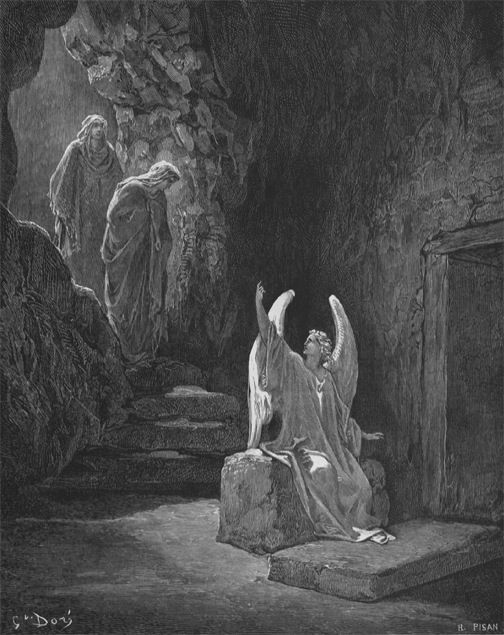
After the Sabbath, at dawn on the first day of the week, Mary Magdalene and the other Mary went to look at the tomb.
There was a violent earthquake, for an angel of the Lord came down from heaven and, going to the tomb, rolled back the stone and sat on it. His appearance was like lightning, and his clothes were white as snow. The guards were so afraid of him that they shook and became like dead men.
The angel said to the women, “Do not be afraid, for I know that you are looking for Jesus, who was crucified. He is not here; he has risen, just as he said. Come and see the place where he lay. Then go quickly and tell his disciples: ‘He has risen from the dead and is going ahead of you into Galilee. There you will see him.’ Now I have told you.”
So the women hurried away from the tomb, afraid yet filled with joy, and ran to tell his disciples. (Matt 28:1-8 TNIV)
Illustration: The Resurrection of Jesus by Gustave Doré (1832–1883). Source: Accordance Gallery of Bible Art. Edited and Written by David Lang. Copyright © 2006 OakTree Software, Inc.
Review: NRSV Standard Edition with Apocrypha [updated]

My experience with the NRSV has been primarily over a decade ago. When I went to seminary in the early nineties, it was the translation in vogue at SBTS. I picked up a hardback/pew copy in the campus bookstore (published by Holman no less!), and often used it in my papers. After taking some introductory language courses, I always found that it was more impressive to create my own translation in papers for biblical studies classes. However, in all other classes, that was practically looked down upon, so I always quoted the NRSV for those papers. I learned early on that since many of my teachers and graders were using the NRSV, my use of it often seemed in general to improve my final grade. I guess I had just enough psychology classes in my undergraduate studies to tweak the system to my own advantage.
Initially, the NRSV gained quite a wide acceptance with Evangelicals. Holman Bibles (the Southern Baptist Convention's Bible publisher) was a launch company along with Zondervan, Thomas Nelson and quite a few others. I even have a purple Life Application Bible in the NRSV! But at some point, the NRSV fell out of favor with Evangelicals. Perhaps disfavor came from it's enthusiastic adoption by non-Evangelical groups and denominations that often tend to lean a bit toward the left theologically, and especially its sponsor, the National Council of Churches. Or perhaps even more likely, the boom in evangelical translations in the last few years (NLT, ESV, TNIV, etc.) simply cut into the now almost two-decade old NRSV market.
Back in the days when I was using the NRSV academically in papers, I was not using it personally that much. This was a time when the NASB remained my top choice, and I viewed it as a superior translation. But I never thought poorly of the NRSV as I often hear in some conservative circles. Granted, some of its translational decisions are not near as conservative as a NASB, ESV, or T/NIV, but I was certainly never one to label it a "liberal" Bible like I sometimes hear. Bruce Metzger was at the head of the translation committee, and he's an individual I respected very much.
Lately, with my studies, I've been doing a lot of work in second-temple period Jewish literature, including what is commonly known as the Apocrypha. Although 90% of this kind of work can be done using Accordance modules (original language texts and translations) as my working source texts, I still sometimes need a physical source in front of me. Frustrated a couple of times because I didn't have an English copy of the Apocrypha in my office (my Parallel Apocrypha is more conveniently kept at home), I decided to pick up one of the new printings of the NRSV with the Apocrypha from Harper Bibles strictly to keep at school. Below is a review of the new edition, but not so much a review of the NRSV.
From Out of Nowhere, the NRSV Makes a Comeback
Surprisingly after ongoing declining sales of the NRSV, Harper Bibles has published three new editions of the of what it is calling "Standard Bibles." All three are hardbacks, although I have to admit this is one of the best looking hardback Bibles I've ever seen. The first Standard Bible contains the regular 66 books of the Bible recognized by most Protestant denominations. A second edition, called "Standard Catholic Edition, Anglicized" (which I can't seem to find on Amazon) includes the standard set of Deuterocanonical/Apocryphal books recognized by the Cathoilic church. However, the thrid edition is the one I bought: the "Standard Bible with Apocrypha." The NRSV itself is known for having the widest reach in the Christian church for books that are recognized as canonical in some form or another. This Bible contains the widest possible selection of books recognized by the church at large. Where else can you get a contemporary translation of 3 & 4 Maccabees and Psalm 151?! Esther is translated in its entirety from both the Hebrew and Greek texts as there are some differences textually besides just the additional passages.
As I mentioned, this Bible boasts a great looking cover. The Harper Bibles page for these editions calls it "leather-like" and that's exactly right. Each Bible is two toned with a material that at first glance at least looks like a kind of leather and is soft to the touch but not padded. Stitching follows the borders of the material. There's also a ribbon marker, something that doesn't always appear in hardback Bibles.
Text is set in a large typeface, probably around 10 or 11 pt. but the website doesn't specify for certain. Although descriptions on the website boast one column text, this is primarily reserved for books that are mostly prose. Poetic books, such as the Psalms are laid out in two columns. As a fan of single-column text, I find the two-column layout in the poetic books to be a detractor. I understand why they did this as the shorter lines of poetic passages leave quite a bit of blank space and no doubt making this Bible one-column throughout would have dramatically increased the number of pages used. But what about books of the Bible that contain both poetry and prose? Well, it's a mixed bag, based, I suppose on which style is in the majority. For instance, Job which begins and ends in prose text, but is poetic in the middle is entirely in two columns. Oddly, Ecclesiastes is in single-column. Isaiah which contains both poetry and prose is in two columns, but Jeremiah is in single-column! Although this Bible is not a thinline, the pages are thin nonetheless allowing for quite a bit of bleedthrough of text from other pages. Page numbering begins fresh with each section. The Old Testament contains 1129 pages; the Apocrypha, 335; and the New Testament, 351. The concordance runs from p. 352 to p. 383 thus making the entire volume almost 1850 pages.
[This paragraph added based on comments.] Another intriguing feature of the NRSV Standard Edition is a lack of full justification for its single-column text which is a rarity in Bibles that use paragraphed text. This helps the reader because non-uniform line lengths help the eyes go down the page when reading, especially when reading aloud. Prose sections in pages that employ two columns of text still use standard full justification.
These are basic text edition without introductions or cross references, but some visual variety is arrived at through graphic symbols at the beginning of each book. Acts, for instance, begins with the symbol of a dove breathing fire, obviously representative of the coming of the Holy Spirit in the second chapter. There's also a concordance in the back, but it's too condensed in my opinion to be overly useful. There are no maps, and there's no room in the margins to include meaningful self-study notes.
These Standard Bibles are very nice hardback editions of the NRSV if you don't already have a copy. And if you don't have a complete copy of the Apocryphal books, the Standard Edition with Apocrypha is the most "complete" collection you can get. Historically, it was common for Protestant Bibles to contain a section for the Apocryphal books, often in a section between the Testaments as this Bible does. This was common practice among Bible printings up until about the end of the 19th century. Luther maintained that while he didn't consider these extra books to be canon, they were good for purposes of edification. Further, I feel one of their greatest contributions is for bridging the 400 year gap between the testaments, both historically and theologically. It's near impossible to fully understand the cultural and political context of Jesus' day without the Apocrypha as well.
Patristic Personality Quiz

|
You’re St. Justin Martyr! You have a positive and hopeful attitude toward the world. You think that nature, history, and even the pagan philosophers were often guided by God in preparation for the Advent of the Christ. You find “seeds of the Word” in unexpected places. You’re patient and willing to explain the faith to unbelievers. Find out which Church Father you are at The Way of the Fathers! |
Take the quiz yourself and post your results in the comments.
TNIV Truth: Do Modern Translations Dilute Biblical Pronouncements Against Homosexuality?
The answers to all this and more can be found in my newest post at TNIV Truth.










